|

|
|
AGENDA
Ordinary Council meeting
Monday, 11 December 2023
|
|
I hereby give notice that an Ordinary meeting of
Council will be held on:
|
|
Date:
|
Monday, 11 December 2023
|
|
Time:
|
8.30am
|
|
Location:
|
Bay of Plenty Regional Council Chambers
Regional House
1 Elizabeth Street
Tauranga
|
|
Please note that this
meeting will be livestreamed and the recording will be publicly available on
Tauranga City Council's website: www.tauranga.govt.nz.
|
|
Marty Grenfell
Chief Executive
|
Membership
|
Chairperson
|
Commission
Chair Anne Tolley
|
|
Members
|
|
|
Quorum
|
Half of the members
physically present, where the number of members (including vacancies) is even;
and a majority of the members physically present, where the number of
members (including vacancies) is odd.
|
|
Meeting frequency
|
As required
|
Role
·
To ensure the effective and efficient governance
of the City.
·
To enable leadership of the City including
advocacy and facilitation on behalf of the community.
Scope
·
Oversee the work of all committees and
subcommittees.
·
Exercise all non-delegable and non-delegated
functions and powers of the Council.
·
The powers Council is legally prohibited from
delegating include:
○
Power to make a rate.
○
Power to make a bylaw.
○
Power to borrow money, or purchase or dispose of
assets, other than in accordance with the long-term plan.
○
Power to adopt a long-term plan, annual plan, or
annual report
○
Power to appoint a chief executive.
○
Power to adopt policies required to be adopted
and consulted on under the Local Government Act 2002 in association with the
long-term plan or developed for the purpose of the local governance statement.
○
All final decisions required to be made by
resolution of the territorial authority/Council pursuant to relevant
legislation (for example: the approval of the City Plan or City Plan changes as
per section 34A Resource Management Act 1991).
·
Council has chosen not to delegate the
following:
○
Power to compulsorily acquire land under the
Public Works Act 1981.
·
Make those decisions which are required by
legislation to be made by resolution of the local authority.
·
Authorise all expenditure not delegated to
officers, Committees or other subordinate decision-making bodies of Council.
·
Make appointments of members to the CCO Boards
of Directors/Trustees and representatives of Council to external organisations.
·
Consider any matters referred from any of the
Standing or Special Committees, Joint Committees, Chief Executive or General
Managers.
Procedural matters
·
Delegation of Council powers to Council’s
committees and other subordinate decision-making bodies.
·
Adoption of Standing Orders.
·
Receipt of Joint Committee minutes.
·
Approval of Special Orders.
·
Employment of Chief Executive.
·
Other Delegations of Council’s powers,
duties and responsibilities.
Regulatory matters
Administration, monitoring and
enforcement of all regulatory matters that have not otherwise been delegated or
that are referred to Council for determination (by a committee, subordinate
decision-making body, Chief Executive or relevant General Manager).
|
Ordinary
Council meeting Agenda
|
11
December 2023
|
7 Confirmation
of minutes
7.1 Minutes
of the Extraordinary Council meeting held on 13 November 2023
File
Number: A15335185
Author: Shaleen
Narayan, Team Leader: Governance Services
Authoriser: Shaleen
Narayan, Team Leader: Governance Services
|
Recommendations
That the Minutes of the
Extraordinary Council meeting held on 13 November 2023 be confirmed as a true
and correct record.
|
Attachments
1. Minutes
of the Extraordinary Council meeting held on 13 November 2023
|
 Extraordinary Council meeting minutes Extraordinary Council meeting minutes
|
13 November 2023
|
|

|
|
MINUTES
Extraordinary Council meeting
Monday, 13 November 2023
|
Order of Business
Appoinment of
Chairperson. 3
1 Opening karaka. 3
2 Apologies. 3
3 Acceptance of
late items. 3
4 Confidential
business to be transferred into the open. 4
5 Change to the
order of business. 4
6 Declaration of
conflicts of interest 4
7 Business. 4
7.1 2024-34
Long Term Plan – Adoption of consultation document 4
8 Discussion of
late items. 7
9 Closing karakia. 7
MINUTES
OF Tauranga City Council
Extraordinary Council meeting
HELD
AT THE Bay of Plenty Regional Council
Chambers, Regional House,
1 Elizabeth Street, Tauranga
ON
Monday, 13 November 2023 AT 1pm
PRESENT: Commissioner
Bill Wasley (Chairperson), Commission Chair Anne Tolley (online/virtual), Commissioner
Shadrach Rolleston, Commissioner Stephen Selwood (online/virtual)
IN ATTENDANCE: Marty
Grenfell (Chief Executive) (online/virtual), Paul Davidson (Chief Financial
Officer) (online/virtual), , Christine Jones (General Manager: Strategy, Growth
& Governance) (online/virtual), Kathryn Sharplin (Manager Finance), Tracey
Hughes (Financial Insights and Reporting Manager), Josh Logan (Team Leader:
Corporate Planning), Coral Hair (Manager: Democracy & Governance Services),
Sarah Drummond (Governance Advisor), Shaleen Narayan (Team Leader: Governance
Services)
EXTERNAL: Leon
Pieterse (Audit New Zealand)
At 1.10pm the meeting adjourned due to technical
difficulties with the livestreaming and recording of the meeting.
At 1.25pm the meeting reconvened.
|
Appoinment
of Chairperson
|
|
Resolution CO21/23/1
Moved: Commission
Chair Anne Tolley
Seconded: Commissioner Shadrach Rolleston
That the Council:
(a)
Appoints Commissioner Bill Wasley as the Chairperson for this meeting
as the Commission Chair was attending the meeting remotely.
Carried
|
1 Opening
karaka
Commissioner Shadrach Rolleston opened the meeting with a
karakia.
2 Apologies
Nil
3 Acceptance
of late items
Nil
4 Confidential
business to be transferred into the open
Nil
5 Change
to the order of business
Nil
6 Declaration
of conflicts of interest
Nil
7 Business
|
7.1 2024-34
Long Term Plan – Adoption of consultation document
|
|
Staff Marty
Grenfell, Chief Executive
Paul Davidson, Chief Financial
Officer
Christine Jones, General Manager:
Strategy, Growth & Governance
Josh Logan, Team Leader: Corporate Planning
Kathryn Sharplin, Manager: Finance
Tracey Hughes, Financial Insights and Reporting Manager
External Leon
Pieterse, Audit New Zealand
Key points
·
At the Council meeting on 6 November 2023, the supporting information
for the proposed Long Term Plan (LTP) 2024-34 had been adopted, noting any
additional or amended. disclosures to be required by Audit New Zealand to be
tabled at the 13 November Council meeting. The Chief Executive was authorised
to make minor amendments to the documentation to ensure accuracy and correct
minor drafting errors.
·
During the final stages of the audit staff had been correcting
the LTP documents with some minor changes and including what the
Commissioners had asked for at the Council meeting on 6 November 2023.
·
There had been a few changes to the financial statements from 6
November 2023 Council meeting. A new version of the Draft
Underlying Financial Statements was set out in Attachment 3 and a
revised version was tabled. .Resolution (b) re-adopts the updated Financial
Statements with additional changes.
·
Tabled updated pages in the consultation document since the
publication of the version on the 13 November agenda.
·
Tabled new resolution (c) (i) which set out all the changes
that include the additional or amended disclosures in the consultation
document required by Audit New Zealand and as identified by staff review
since the version considered by Council on 6 November 2023 and the version of
the Consultation Document on the agenda, and Tabled (c) (ii) which set out
the tabled changes with additional or amended disclosures in the consultation
document as identified by staff between the version on the agenda and the
final version tabled.
·
Consultation opens on 15 November 2023 and closes 15 December
2023 at 5pm.
In response to questions
·
None
|
|
Resolution CO21/23/2
Moved: Commissioner
Bill Wasley
Seconded: Commissioner Shadrach Rolleston
That the Council:
(a) Receives the report
"2024-34 Long Term Plan – Adoption of consultation document".
(b) Adopts
the updated Draft Underlying Financial Statements (Attachment 3) as
supporting documentation for the proposed Long-term Plan 2024-34.
(c) (i)
Approves the following additional or amended
disclosures in the consultation document required by Audit New Zealand and as
identified by staff review since the version considered by Council on 6
November 2023:
·
Page 2 – reordered list of consultation items
·
Page 3 – significant reduction in water services reform
text and direction of the reader to page 84 for more details
·
Page 6 – correction of time and dates of consultation
events
·
Page 7 – index updated
·
Page 15 – updated city centre text to confirm covers more
than just Te Manawataki o Te Papa
·
Page 17 – include Memorial Pool disclosure previously on
page 20
·
Page 18 – additional disclosure required by Audit New
Zealand relating to Plan Change 33 and the National Policy Statement on Urban
Development
·
Page 20 – additional disclosure required by Audit New
Zealand relating to uncertainty on external funding
·
Page 20 – move Memorial Pool disclosure to page 17
·
Pages 28-53 – reordered the list of consultation items to
align with the summary document
·
Pages 50-52 – added disclosures on estimated operating
costs for the proposed stadium under each option
·
Pages 56-58 – added additional text, and removed
duplicate benefit bullet points, relating to the SmartTrip proposal
·
Page 66 – amendments to opening two paragraphs required
by Audit New Zealand to clarify message around projects that are not included
in the ten years of the Long-term Plan
·
Pages 71-72 – additional disclosure required by Audit New
Zealand relating to capital delivery
·
Page 72 – added a new graph showing capital investment
·
Pages 84-85 – additional disclosures required by Audit
New Zealand relating to water services reform
·
Pages 89-97 – order of consultation questions changed
·
Te reo headings reintroduced to pages 8, 10, 12, 14, 16, 18,
20, 22, 24, 26, 28, 33, 34, 37, 41, 45, 49, 54, 56, 62, 66, 68, 70, and 86
·
Minor changes to improve spelling, grammar, or formatting on
pages 1, 2, 6, 11, 16, 18, 20, 22, 25, 26, 27, 45, 46, 47, 49, 50, 51, 52,
58, 59, 69, 70, 71, 72, 73, 76, 79, 80, and 81.
(ii) Approves
the following tabled additional or amended disclosures in the consultation
document as identified by staff since the publication of the version on the
13 November agenda:
· Page
73 – updated debt disclosure to $1.6bn to ensure consistent with graph
on page 74
·
Page 79 – revised graph to ensure colours consistent with
page 73 graph
·
Pages 86-99 – re-ordered to place audit opinion before
submission form
·
Page 88 – removed the ‘preferred method of
contact’ tick-box for submitters
·
Page 89 – added Omanawa as a residential option
·
Pages 90-99 – re-ordered questions to match the
consultation document order and to make minor typographical improvements to
match changes made earlier in the document.
Carried
|
|
Auditor’s
Opinion
·
Tauranga City was the first council to have adopted the
”waters out” consultation document.
·
Mr Pieterse tabled his auditor’s opinion and advised that
he was comfortable that the consultation document provided an effective basis
for public participation and fairly represented the matters proposed for
inclusion in the LTP and the information and assumptions underlying the
information in the consultation document were reasonable.
·
Three emphasis of matters were drawn to the Council’s
attention in the audit opinion, the uncertainty over the water services
reforms with the change in government, external funding of capital
expenditure and uncertainty over the delivery of the capital programme.
·
Staff were acknowledged by Audit New Zealand for their hard
work and effort.
In response
to questions
None
Discussion points raised
·
Staff and Audit New Zealand teams were acknowledged by the
Commissioners for the level of commitment and they acknowledged the
additional workload created by Tauranga City being the first council to have
adopted the ”waters out” consultation document.
|
|
Resolution CO21/23/3
Moved: Commission
Chair Anne Tolley
Seconded: Commissioner Stephen Selwood
That the Council:
(d) Receives the audit opinion
on the consultation document for the proposed 2024-34 Long-term Plan,
pursuant to s93C (4) of the Local Government Act 2002.
Carried
|
|
Resolution CO21/23/4
Moved: Commission
Chair Anne Tolley
Seconded: Commissioner Stephen Selwood
That the Council
(e) Adopts
the audited Consultation Document (Attachment 4) for public consultation, using
the special consultative procedure pursuant to s93 and s93A of the Local
Government Act 2002.
(f) Authorises the Chief Executive to make any necessary
minor drafting or presentation amendments to the consultation document or
supporting documentation.
Carried
|
|
Attachments
1 CD
Adoption Attachment 3
2 Audit
New Zealand Report
3 Amended
recommended resolutions
4 Draft
Underlying Financial Statements
|
8 Discussion
of late items
Nil
9 Closing
karakia
Commissioner Shadrach Rolleston closed the meeting with a
karakia
The meeting closed at 1.45pm.
The minutes of this meeting were confirmed at the
Ordinary meeting of the Tauranga City Council held on 11
December 2023.
...................................................
CHAIRPERSON
|
Ordinary
Council meeting Agenda
|
11
December 2023
|
7.2 Minutes
of the Council meeting held on 27 November 2023
File
Number: A15370324
Author: Shaleen
Narayan, Team Leader: Governance Services
Authoriser: Shaleen
Narayan, Team Leader: Governance Services
|
Recommendations
That the Minutes of the
Council meeting held on 27 November 2023 be confirmed as a true and correct
record.
|
Attachments
1. Council
2023-11-27 [4551] Minutes.DOCX - A15333539 ⇩ 
|
Ordinary
Council meeting Agenda
|
11
December 2023
|





















|
Ordinary
Council meeting Agenda
|
11
December 2023
|
10 Recommendations
from other committees
10.1 Appointment
of Chairperson for Wastewater Management Review Committee
File
Number: A15371094
Author: Anahera
Dinsdale, Governance Advisor
Authoriser: Shaleen
Narayan, Team Leader: Governance Services
Purpose of the Report
1. The purpose of this
report is to bring a recommendation from the Wastewater Management Review
Committee to Council for consideration. At its meeting on 22 November 2023, the
Committee passed the following resolution which includes a recommendation to
Council.
2. Item 9.1 –
Appointment of Chairperson of Wastewater Management Review Committee
Committee Resolution WW3/23/1
Moved: Commissioner
Bill Wasley
Seconded: Mr
Whitiora McLeod
That the Wastewater
Management Review Committee:
(a) Receives the report
"Appointment of Chairperson of Wastewater Management Review
Committee".
(b) Recommends to Council that
Spencer Webster (Ngā Potiki) is appointed as the Chairperson of the
Wastewater Management Review Committee.
(c) Thanks Lara Burkhardt for her
services as Chairperson of the Wastewater Management Review Committee.
Carried
3. In accordance with
the Committee recommendation WW3/23/3 (b) Council are now asked to appoint Mr
Spencer Webster as the Chairperson to Wastewater Management Review Committee.
|
Recommendations
That the Council:
(a) Receives the report
"Appointment of Chairperson for Wastewater Management Review
Committee".
(b) Appoint Spencer Webster (Nga
Potiki) as the Chairperson of Wastewater Management Review Committee.
|
Attachments
Nil
|
Ordinary
Council meeting Agenda
|
11
December 2023
|
11 Business
11.1 Approval
of Private Plan Change 35 (Tauriko Business Estate (Stage 4)) for Notification
File
Number: A15296800
Author: Phillip
Martelli, Project Leader: Urban Planning
Authoriser: Christine
Jones, General Manager: Strategy, Growth & Governance
Purpose of the Report
1. The purpose of this
report is to seek a recommendation from Council to accept, for the purposes of
notification, proposed Private Plan Change 35 Tauriko Business Estate (Stage
4), as requested by Element IMF.
|
Recommendations
That the Council:
(a) Receives the report
"Approval of Private Plan Change 35 (Tauriko Business Estate (Stage 4))
for Notification".
(b) Accepts, in accordance with
RMA Schedule 1 cl 25, Private Plan Change 35 Tauriko Business Estate (Stage
4) to the operative Tauranga City Plan for public notification.
(c) Authorises the General
Manager: Strategy, Growth & Governance to arrange the public notification
process in accordance with the provisions of the First Schedule to the
Resource Management Act 1991.
(d) Delegates authority to the
General Manager: Strategy, Growth & Governance to approve any minor and
technical changes to the Proposed Private Plan Change 35 documentation and
Technical Reports as required prior to public notification, and that any such
changes to be within the confines of the s92 Request for Further Information.
(e) Requires adherence to the
Council’s policy of full recovery of costs associated Private Plan
Change 35.
|
Executive Summary
2. Element IMF are the
developers of the Tauriko Business Estate and have prepared a private plan
change to allow development of Stage 4 of the Business Estate. The plan change
will rezone the land from Rural to Tauriko Industrial, plus related zones.
3. Private Plan Change
35 Tauriko Business Estate (Stage 4) has been prepared to the point of
notification.
4. The acceptance of
Private Plan Change 35 (PPC35) is sought by Council for public notification for
submissions under Schedule 1 of the Resource Management Act 1991.
Background
5. The existing Tauriko
Industry Zone land is close to reaching capacity and the developers of the
Business Estate are seeking to extend the Zone. The land in question (along
with other land) was transferred from Western Bay of Plenty District to
Tauranga City in 2021.
6. The area subject to
the Proposed Plan Change covers some 133ha of which 110ha is proposed to be
industrial. Approximately 80% is owned by Element IMF with the remainder being
in the ownership of private parties.
7. Development of the
Zone is proposed to be staged, with triggers relating to State Highway 29
upgrades and wastewater capacity.
8. A section 32
analysis is a detailed assessment required by the RMA to establish whether the
proposed Private Plan Change content is the most appropriate course of action.
This has been prepared by the proponents of the PPC and is included
as Attachment 1.
Strategic / Statutory Context
9. The National Policy
Statement – Urban Development requires Tauranga City Council to ensure that
it has sufficient capacity to meet the expected demand for business land. The
“Business Capacity Assessment” of Tauranga City and Western Bay of
Plenty was completed by M.E Consulting in December 2022. This revealed that the
land subject to the Proposed Plan Change is identified as being required to
help the City meet its short to medium term target.
STATUTORY CONTEXT / Options
Analysis
10. Private plan changes are
provided for in Schedule1 of the Resource Management Act.
11. The Proposed Plan Change was
lodged with Council on 18 October 2023. It was assessed by staff and has been
subject to a RMA Section 92 Further Information Request which was sent on 15
November 2023. The s92 initial response from the applicant was received on 17
November 2023 and meetings held over the subsequent week. There has been
no further request for information from staff and the Proposed Plan Change must
now be considered by Council as to how it should be processed.
12. Clause 25 of Schedule 1
requires the Council to consider the request and make a decision on one of the
options available. The options are:
· Adopt
the plan change as if it were its own plan change(25(2)(a)). This means the
Council supports the plan change (subject to the hearings process), including
providing all the necessary technical support for the hearing. All costs
associated with the plan change rest with Council. Although the Proposed Plan
Change addresses a strategic planning issue being a projected shortfall in
industrial land, it is primarily to benefit a single landowner who is the
applicant.
· Accept
the plan change in which case it remains a private plan change (25(2)(b)).
Council proceeds to process it and all costs associated with the request
(including notification and any hearing) are recoverable from the applicant.
Following from the bullet point above, as the applicant is the prime benefit of
the plan change, it is appropriate that they cover the costs. This includes all
necessary technical support, and Council’s policy is to also recoup all
processing costs including staff time. This includes engaging an independent
contractor to be the reporting planner as Council will have insufficient
resources through this period.
· Reject
the plan change based on limited grounds (25(4)) as follows:
a. The request or part of the request is
frivolous or vexatious; or
b. Within the last two years, the substance of the request
or part of the request
i. has been considered and given effect to, or rejected
by, the local authority or the Environment Court; or
ii. has been given effect to by regulations made under
Section 360A; or
c. The request or part of the request is not in accordance
with sound resource management practice; or
d. The request or part of the request would make the policy
statement or plan inconsistent with Part 5; or
e. In the case of a proposed change to a policy statement
or plan, the policy statement or plan has been operative for less than two
years.
None of the above five rejection options apply.
· Process
the PPC as if it were a resource consent in accordance with Part 6 of the RMA.
The PPC is primarily about zoning land along with some specific rule changes to
the City Plan. It still relies heavily on the existing rules in the City Plan,
and this points to a resource consent being inappropriate as all the relevant
rules would need to be included as conditions in the resource consent decision.
13. Accepting the proposed plan
change as a private plan change is the preferred option. It also recognises
there are some competing issues with the application and thus
‘accepting’ allows Council to maintain a neutral position. It will
be the hearings panel that will make the final recommendations to Council.
14. The Private Plan Change has
been subject of a s92 Request for Further Information request. A response has
been received from the applicant and staff are currently assessing whether
further or additional information is required (RMA Sch1 cl 23 (3)). There are
several matters that are still outstanding that will need to be addressed by
the applicant. Approval is sought from Council to delegate to the General
Manager Strategy, Growth and Governance to approve any changes as a result of
that process. Any changes will be confined to those matters raised in the s92
report.
Financial Considerations
15. Council policy is to recover
costs associated with private plan changes as provided for in the legislation
(as discussed in 12 above, bullet point 2.)
16. The applicant has raised the
issue of cost recovery for the processing of the Private Plan Change. Their
view is that it is a plan change that should have been undertaken by Council to
provide more industrial land for the City, and therefore Council should at
least cover its own costs. They have provided the following response:
“The
Stage 4 extension to TBE was included in the Smartgrowth Settlement Pattern
Review in 2016 with decisions that structure planning and RMA processes be
commenced. (see attached SGIC Agenda and Papers from 2016*) Council did not
action this and Element IMF commenced these processes in 2021 in the form of a
Private Plan Change. The reasons Council had not commenced those processes was
explained to be primarily a lack of resource and capacity due to focus being
applied to Tauriko West and Te Tumu Growth Areas.
Our
costs to date associated with the Private Plan Change are in excess of $800,000
and we expect these will exceed $1,000,000 once the process is complete. The
majority of these costs would have fallen to TCC (ratepayers) had Council
progressed the Plan Change itself.
We
have been told that resourcing is still an issue and even the processing of our
plan change is to be performed by external consultants on Councils behalf. We
are also told that these processing costs will be passed on to us as the
applicant.
This
is extraordinarily inequitable given the significant costs in preparing the
plan change have been borne by ourselves. We consider the disproportionately
smaller processing costs should remain with TCC as its contribution to a
process that it was to undertake as directed by Smartgrowth.”
*The
wording is as follows: “Agree to structure planning/RMA processes for the
extension of the Tauriko Business Estate (lower Belk Road) starting in 2016/17,
likely to be required in the next 5-10 years.”
17. Options for Council are
discussed in the table below.
|
Option
|
Advantages
|
Disadvantages
|
|
Cost recovery
|
Council fully recovers
all expenditure associated with the PPC
|
Additional expense to
the applicant
|
|
Partial cost recovery:
don’t charge for staff time, hearings commissioners. Charge for
consultant planner for reporting to the Hearing.
|
Staff costs can be
considered to be a given as their role is to input to such proposals. Staff
costs are covered by existing budgets.
The Hearings and
commissioners can be considered to be a cost of democracy.
The Consultant planner
is necessary to compliment staff resources.
|
The PPC is diverting
staff from other projects that are part of the adopted work programme.
|
|
Waiver all costs
|
Cost saving to the
applicant
|
Consultant planner is
not budgeted for.
|
18. If Council were to undertake
the plan change it would still be several years away because circumstances have
changed since 2016, including other higher priority plan changes. Hence the
decision by the applicant to not wait for Council but go down the private plan
change path. As stated in paragraph 6 above, the plan change primarily benefits
the applicant who owns 80% of the land involved, and therefore it is considered
appropriate that they fund the plan change.
19. On that basis, there are no
financial considerations associated with this report. The cost associated with
processing Private Plan Change 35 is recoverable from the applicant. Any
related administration costs are within existing LTP budgets.
Legal Implications / Risks
20. The risks associated with the
PPC lie with the applicant. Council’s risk is related to the actual
processing which is covered by the RMA and Council’s own Procedure and
Process Manual. Council’s risk is considered low.
Consultation / Engagement
21. Consultation and engagement is
required by the RMA. This has been undertaken by the applicant as part of
preparing their s32 report as required by Schedule 1 of the Act. The RMA also
requires the Proposed Plan Change to be publicly notified for submissions and
further submissions. This gives interested parties the opportunity to have
additional input into the process.
22. The RMA Schedule 1 clause 4A
requires pre-notification with iwi authorities. This is required to occur
between the Council decision on acceptance of the Private Plan Change and
notification.
Significance
23. Under the TCC Significance and Engagement
Policy, this decision is
of medium significance in terms of the consequences for the City in the
provision of additional industrial land.
24. Proposed Private Plan Change 35
will be publicly notified for submissions and further submissions as required
under Schedule 1 of the RMA.
Next Steps
25. Pre-notification is to occur
with iwi.
26. The final proposed Private Plan
Change and the accompanying section 32 analysis will be publicly notified in
accordance with the requirements of Schedule 1 of the RMA.
27. Following the submission and
further submission process, the Proposed Plan Change will proceed to a hearing
and associated decision process.
28. During the submissions and
further submissions process, approval will be sought from Council for the
appointment of a Hearings Panel or an Independent Hearings Commissioner(s) to
hear and make recommendations on the Plan Change to Council. This will
include whether there is elected member involvement as part of a Hearings
Panel.
29. The decision to adopt the
Hearing’s recommendations will rest with Council following the hearing of
submissions and receipt of the Hearing Panel or Independent Hearings
Commissioner(s) recommendation report.
Attachments
1. S32
Report Private Plan Change 35 - A15362593 (Separate Attachments 2) 
2. S92
Request for Further Information Table - A15371105 (Separate Attachments 2) 
3. Full Application
and all Technical Documents - A15370856 (Separate Attachments 2) 
|
Ordinary
Council meeting Agenda
|
11
December 2023
|
11.2 Te
Tumu Urban Growth Areas
File
Number: A15360557
Author: Andy
Mead, Manager: City Planning & Growth
Brad Bellamy,
Project Leader: Urban Planning
Authoriser: Christine
Jones, General Manager: Strategy, Growth & Governance
Purpose of the Report
1. To reconfirm Te Tumu as a
priority urban growth area including Council’s commitment to progressing
a Plan Change to enable urban development, and to update progress on the
project.
|
Recommendations
That the Council:
(a) Receives the report "Te
Tumu Urban Growth Areas" and notes the update on key matters.
(b) Reconfirms Te Tumu as a priority
urban growth area.
(c) Reconfirms prioritising work
on the Te Tumu structure planning and rezoning project to prepare for
notification of a Plan Change to rezone Te Tumu concurrent with process with
Tumu Kaituna 14.
(d) Notes that regular updates will
be reported to Council through 2024 as various workstreams, including
infrastructure corridor and Kaituna Overflow workstreams are further
advanced.
|
Executive Summary
2. Te Tumu is a
long-standing component of Tauranga and the Western Bay subregion’s urban
development strategy and remains a priority to unlock for urban development.
3. This report provides
a further update of key workstreams associated with the Te Tumu urban growth
area plan change.
4. Efforts to plan and
rezone Te Tumu for urban development began in 2017 with an initial goal of
housing development by 2021. However, challenges such as divergent aspirations
among Māori landowners, differing opinions from iwi, and changes in
national policy, especially freshwater management, have led to delays. The
planning process remains lengthy and uncertain, with notification of a plan
change possibly not be able to occur until 2026, subject to further assessment
of any options to accelerate this. Nonetheless staff are actively
progressing the project to prepare for notification concurrent with TK14
workstreams.
5. The new government
has signalled changes to the RMA and associated national direction that may
alleviate some of the challenges and risks associated with the project.
Background
6. The last report that
is relevant to these matters was considered by Council on 11 September 2023.
Pursuant to that report, Council noted the range of strategic issues relevant
to progressing construction of infrastructure. To manage these risks
Council resolved to consult on a targeted rate through the draft 2024-34
LTP. The proposed targeted rate is based on:
· 50%
of the Te Tumu portion of the transport projects which have most of their
expenditure in the first 3 years of the Long-Term Plan.
· A
flat charge per ratepayer across the city with a higher charge (double) in the
wider benefit area in Papamoa East and (triple) for those in the full benefit
area in Papamoa East.
· A
20-year repayment period starting in Year 1 of the 2024-34 Long Term Plan
period.
7. Given the overall
fiscal challenges that Council is facing, the draft 2024 – 2034 LTP
provides for the following with respect of Te Tumu:
· Continuation
of land use planning and rezoning.
· Infrastructure
planning (including design).
· Securing
land required for infrastructure or public amenity purposes; and
· The
Kaituna Overflow, which is critical to development commencing, not being
completed until after the 2024-34 LTP period[1].
8. The implication of
this is that housing supply is unlikely to be delivered in Te Tumu until around
2040 once land development and civil works timeframes are considered.
9. A number of
submissions are expected on the draft LTP in relation to Te Tumu timing and the
proposed targeted rate, and these matters will be further considered through
the deliberations process in early 2024.
PLANNING AND ZONING MATTERS
10. Te Tumu is a long-standing
component of Tauranga and the Western Bay subregion’s urban development
strategy and remains a priority to unlock for urban development.
11. The planning and rezoning
efforts for Te Tumu have been in progress since 2017, initially with the goal
of initiating housing development by 2021. However, the project has encountered
various challenges and delays, notably:
(a) Legal proceedings taken by some
Māori landowners against TK14 Trust, impacting on the ability to progress
discussions on securing land rights to enable infrastructure delivery through
Māori land.
(b) Māori Trustees needing to
undertake an engagement process with beneficial owners to seek a mandate to
progress conversations with Council on land access.
(c) Differing opinions from iwi and
hapu regarding the suitability of urban development within Te Tumu.
12. The changes in national
direction under the Resource Management Act (RMA), particularly
concerning freshwater management, including wetlands, have further impeded
progress.
13. While
there has been some advancement, ongoing challenges persist, particularly as we
seek to implement national directives that impact existing technical work and
crucial elements of the project. In May this year, Council sought to recommence
engagement with iwi and hapu on this project. This followed a substantial
pause in engagement requested by iwi and hapu to allow time for issues between
the Tumu Kaituna 14 Trust (TK14) and its landowners to be resolved.
Discussions held with iwi and hapu to date have revealed some strong opposition
to progressing urban development in Te Tumu, despite TK14 having secured a
majority mandate for infrastructure negotiations to commence with TCC.
14. Despite recent adjustments to
the government's freshwater policy, not all of our suggested changes were
adopted. Staff are carefully considering these outcomes, especially concerning
the Kaituna Stormwater Overflow, which is essential for managing stormwater
runoff in Te Tumu and protecting existing development in the wider Wairakei
Stream catchment.
15. Additionally, judicial review
proceedings against the Minister for the Environment, seeking a return to more
stringent freshwater protection as per the NPS-FM, pose potential impacts on Te
Tumu's urban growth area planning.
16. The recent enactment of the
National Policy Statement for Indigenous Biodiversity, coupled with the new
freshwater policy, adds complexity to key projects associated with urban
development in Te Tumu. Compliance with the stringent requirements of the new
policy, especially in ecological and wetland areas, present significant
challenges.
17. Considering
these challenges, the planning process for rezoning Te Tumu for urban
development remains lengthy, intricate, and uncertain with notification of a
plan change currently assessed as possibly not able to occur until 2026,
subject to further investigations of options to accelerate this. In
addition, the level of staff and consultant resourcing for the project will be
increased.
18. A Plan Change of this scale
could be expected to take two years from notification before decisions (to
2028) and may be subject to appeals which would extend timeframes further.
Staff have prepared a draft timeline of the various workstreams associated with
the project and will continue to refine this as further work is done. This
timeline reflects the complexities and uncertainty around updates required to
many of these workstreams given current national policy
direction.
19. The new government has
signalled changes to the RMA and associated national direction which may
alleviate some of the challenges and risks associated with this project.
The exact nature and timing of these changes remains uncertain.
20. There remains a risk that urban
development may not proceed in Te Tumu, potentially necessitating ratepayer
funding for capex costs related to this area. Continued monitoring and
mitigation strategies are crucial to navigate these challenges effectively.
STRATEGIC / STATUTORY CONTEXT
21. Te Tumu is a core component of
SmartGrowth’s strategic growth strategy as agreed through the SmartGrowth
Urban Form and Transport Initiative.
22. The SmartGrowth Strategy,
including the Future Development Strategy requirements of the NPS-UD are
currently under review and development. The TCC position on the timing of
development in Te Tumu as per this report will flow into that process which, in
summary, is that development in Te Tumu is likely to take quite some time to
commence but with Council and landowner aspirations for infrastructure funding
challenges to be overcome so development can commence earlier than currently
anticipated by the draft LTP.
Financial Considerations
Broader Te Tumu financial consideration
23. Over $600m of Council
infrastructure investment is required to enable development of Te Tumu, of
which over $300m is allocated to Te Tumu funding with the rest coming from
other funding sources eg other growth areas, rates etc. These costs
largely need to be incurred before development in Te Tumu commences and the
compounding impacts of interest mean that Te Tumu’s $300m+ share is
projected to become around $750m if development is delayed until 2040.
24. These matters were addressed in
the previous September Council report, and they resulted in a proposed targeted
rate to fund 50% of Te Tumu related transport costs being included in the draft
LTP. These matters will be further addressed through LTP submissions,
hearings, and deliberations.
25. A large amount of expenditure
is in three waters infrastructure. These matters were left to lie on the
table given uncertainty with waters reform and the statutory ability at this
time for TCC to only include waters expenditure and revenues in its upcoming
LTP for Years 1 and 2.
26. There may be some ability to
rescope trunk water and wastewater projects, so they are delivered in stages,
with Te Tumu capacity coming at a later point. This continues to be
investigated.
27. Financial considerations will continue
to be monitored and reported back to Council as required. This will
include an overall update of the financial feasibility of the development area
to take account of significant cost escalation in recent years that will affect
key development costs such as internal and external infrastructure and
earthworks.
Legal Implications / Risks
28. There are a range of risks
associated with the Te Tumu project as set out in this report. Staff are
taking legal advice on these matters as appropriate.
Consultation / Engagement
29. Further engagement has occurred
with the Te Tumu landowner group ahead of this report being drafted and
engagement will continue moving forward.
30. TCC continues to inform its
SmartGrowth Partners on progress with the Te Tumu urban growth area including
impacts on work such as the Housing & Business Assessment, the SmartGrowth
Strategy Review & the Future Development Strategy.
Significance
31. The Local Government Act 2002
requires an assessment of the significance of matters, issues, proposals and
decisions in this report against Council’s Significance and Engagement
Policy. Council acknowledges that in some instances a matter, issue,
proposal or decision may have a high degree of importance to individuals,
groups, or agencies affected by the report.
32. In making this assessment,
consideration has been given to the likely impact, and likely consequences for:
(a) the current
and future social, economic, environmental, or cultural well-being of the
district or region
(b) any persons who are likely to be
particularly affected by, or interested in, the matter.
(c) the capacity of the local authority to
perform its role, and the financial and other costs of doing so.
33. This report provides an update
on the Te Tumu urban growth area project. In accordance with the
considerations above, criteria and thresholds in the policy, it is considered
that the decision is of medium significance.
ENGAGEMENT
34. Taking into consideration the
above assessment, that the matter is of medium significance, officers are of
the opinion that no further engagement is required prior to Council making a
decision.
Next Steps
35. The next steps involve
progressing key workstreams related to the Te Tumu plan change and reporting
progress through 2024.
Attachments
1. Te
Tumu Plan Change Timeline - A15371180 ⇩ 
|
Ordinary
Council meeting Agenda
|
11
December 2023
|

|
Ordinary
Council meeting Agenda
|
11
December 2023
|
11.3 Hull
Road Intersection increased unbudgeted expenditure.
File
Number: A15356949
Author: Rebecca
Rimmer, Senior Project Manager
Jenny Hill, Senior
Project Manager
Authoriser: Nic
Johansson, General Manager: Infrastructure
Purpose of the Report
1. The purpose of this
report is to approve an updated project budget of $765,250 for the Hull Road
level crossing upgrade.
|
Recommendations
That the Council:
(a) Receives the report
"Hull Road Intersection increased unbudgeted expenditure."
(b) Approves an updated project
budget for the construction of $765,250 (the current budget is $400,000).
|
Executive Summary
2. On the 21st
July 2023, the Chief Executive approved a request for an unbudgeted expenditure
of $400,000 to design and implement safety upgrades to the Hull Road level
crossing to enable the safe opening of the adjacent Destination Skate Park in
Autumn 2024.
3. The $400,000
requested was based on estimated costs. Now that the design has progressed and
provisional costings have been received for both the design and construction
works; the total required at completion is expected to be $765,250, including
contingency. This is an additional $365,250 on the previously approved
unbudgeted expenditure of $400,000.
4. It is proposed that
the additional $365,250 required to complete the project is approved from the
Transportation budget.
Background
5. Construction has commenced
on the Destination Skate Park at 1 Hull Road and is expected to be completed by
May 2024.
6. The original
$400,000 request was a rough order of cost as the extent of works were unknown.
As the design has progressed we are now in a position where the physical works
estimates are more detailed. There have also been additional design costs for
track improvements which are required to complete the project. We are
still waiting for costings for the physical track works and have therefore put
a 15% contingency in place to cover this work.
7. It is expected that
the works will most likely be able to be completed in line with a May 2024
opening of the Skate Park. Due to various design and approval iterations
required and the need for the works to be completed by specialist contractors
and line closures to be in place it is expected that the implementation of the
interim measures will likely form or be very close to forming the critical path
for the opening of the Skate Park.
8. Immediately adjacent
to the skate park on Hull Road is an existing level crossing. A Level
Crossing Safety Impact Assessment (LCSIA) was commissioned and completed by
Aurecon which highlighted a series of improvements that should be made to the
crossing to improve its safety.
9. In conjunction with
KiwiRail a series of interim measures have been identified that would allow the
Skate Park to be opened safely (see detailed design below). These include a
wider shared path, maze gates, fencing, tactile paving signage and track
improvements. These will need to be followed by the signalisation of the
pedestrian/cycle gates.

10. It is currently proposed to
design the full scope of upgrade works as noted in the LCSIA and implement only
those that are required to allow the safe opening of the Skate Park.
11. Based on initial estimates it
was expected that the design effort and interim measures would cost in the
order of $400,000.
12. To date $150,000 has been spent
on these works.
13. As the design has developed in
conjunction with KiwiRail, it has highlighted the need for track improvements
and initial costings have now been refined in line with the detailed design
which has shown the expected cost to complete the project will be in the region
of $765,250.
14. The costs associated with track
works are to enable safe access to the skate park across the crossing.
This is a TCC cost due to current available KiwiRail funding. While
KiwiRail would ordinarily pay for this, at this time, KiwiRail have advised
that this needs to be at TCC cost due to the current schedule for delivery of
this project. The Skatepark and Mount programme requires this work
to be completed for the opening of the Skate Park, currently forecast for
Spring 2024. The project team are continuing to negotiate these costs with
KiwiRail.
A
breakdown of the $685,000 (excludes 15% contingency) is as follows:
Design
$141,000
KiwiRail
(track work) $246,000
Safety
audit $10,000
Construction
$260,000
Internal
costs $28,000
Total:
$685,000
Strategic / Statutory Context
15. The destination skatepark
project is a key initiative that will enable us to meet our community outcomes
of a city that is, “well-planned with a variety of successful and
thriving compact centres, resilient infrastructure, and community
amenities” and one that, “values our natural environment and
outdoor lifestyle, and actively works to protect and enhance it.
16. Due to the nature of the
Destination Skate Park it is expected that there will be significant trip
generation into the area, this is highly likely to increase pedestrian
movements across the Hull Road Level Crossing with the current state of this
crossing providing minimal safety controls for pedestrians. Encouraging this
increased pedestrian movement without increasing safety controls would present
a significant risk to user safety.
Options Analysis
17. The LCSIA report has clearly
identified the improvements required to the level crossing to make it safer for
the public. These measures are being implemented in a staged approach.
Financial Considerations
18. It is expected that the interim
measures will cost approximately $685,000 to design and implement. Of this
approximately $150,000 has been spent to date. Although cost forecasts have
been reviewed, given the remaining uncertainty relating to the Kiwirail costs
it is believed to be prudent to allow a contingency of 15% on the remaining
costs. Contingency value = ($685,000 - $150,000) x 15% = $80,250
19. Therefore the total required at
completion is expected to be $765,250. This is an additional $365,250 on the
previously approved unbudgeted expenditure of $400,000.
20. Consideration of costs
associated with the remaining improvements noted in the LCSIA would be
additional to this and funding is yet to be confirmed. These costs are not
included in this request.
Legal Implications / Risks
21. A Funding Agreement is required
to be put in place between KiwiRail and TCC to cover the track upgrade work as
KiwiRail undertake this work. TCC’s Legal team is working with
KiwiRail’s Legal team to agree the final format of this document.
Consultation / Engagement
22. No formal public consultation
has been undertaken to date. Once the design is finalised it will be circulated
to interested parties including being displayed at the Mount Hub.
Significance
23. The Local Government Act 2002
requires an assessment of the significance of matters, issues, proposals and
decisions in this report against Council’s Significance and Engagement
Policy. Council acknowledges that in some instances a matter, issue,
proposal or decision may have a high degree of importance to individuals,
groups, or agencies affected by the report.
24. In making this assessment,
consideration has been given to the likely impact, and likely consequences for:
(a) the current
and future social, economic, environmental, or cultural well-being of the
district or region
(b) any persons who are likely to be
particularly affected by, or interested in, the decision.
(c) the capacity of the local authority to
perform its role, and the financial and other costs of doing so.
25. In accordance with the
considerations above, criteria and thresholds in the policy, it is considered
that the decision is of low significance.
ENGAGEMENT
26. Taking into consideration the
above assessment, that the decision is of low significance, officers are of the
opinion that no further engagement is required prior to Council making a
decision.
Next Steps
27. Once the updated project budget
has been confirmed, the project team will continue preparation for construction
of the level crossing upgrade commencing in March/April 2024.
Attachments
Nil
|
Ordinary
Council meeting Agenda
|
11
December 2023
|
11.4 Cameron
Road Stage 2 Detailed Business Case
File
Number: A15275818
Author: Richard
O Kane, Senior Project Manager
Authoriser: Nic
Johansson, General Manager: Infrastructure
Purpose of the Report
1. To provide an overview of
the Cameron Road Stage 2 Detailed Business Case and to seek Council endorsement
for its submission to Waka Kotahi for their approval.
|
Recommendations
That the Council:
(a) Receives the report
"Cameron Road Stage 2 Detailed Business Case".
(b) Endorses the Detailed
Business Case for submission to Waka Kotahi Board for approval.
|
Executive Summary
2. The
purpose of the Cameron Road Stage 2 Detailed Business Case (CRS2 DBC) is to
outline the need for investment in a long-term transport solution, within the
Te Papa Peninsula of Tauranga. The study area for the CRS2 DBC is along Cameron
Road between 17th Avenue
and Cheyne Road.
3. Tauranga and Cameron
Road are on the cusp of significant changes in land use. The long-term ambition
is to accommodate future growth, manage congestion and enable the urban
transformation of the Te Papa Peninsula through providing:
(a) Greater housing choices;
(b) Safe and efficient transport
options;
(c) Local amenities; and
(d) The infrastructure needed to
support healthy and connected communities now and in the future.
4. In response, the
SmartGrowth endorsed Urban Form + Transport Initiative (UFTI) Connected Centres
Programme was developed in 2020. The UFTI Connected Centres Programme is based
on intensifying existing and enabling new growth areas, and having a transport
system that supports safe, frequent, and reliable multimodal access for people
and goods. The improvements investigated in this business case are a critical
step in achieving the UFTI Connected Centres Programme.
5. CRS2 is included and
aligns with the Western Bay of Plenty Transport Spatial Plan (TSP) endorsed by
the region by promoting alternative travel modes, increasing bus usage, and
reducing car congestion, supporting the plan's goals and enhancing freight
reliability. Integrated with increased housing density, the project offers
diverse transportation and living options, providing residents with improved
access to amenities, employment and links into vital public spaces with the aim
to foster vibrant and connected communities.
6. This DBC is a result
of collaborative efforts between Tauranga City Council, tangata whenua, Bay of
Plenty Regional Council, Waka Kotahi New Zealand Transport Agency (Waka
Kotahi), and stakeholders.
7. This Business Case
identifies a preferred way forward for investment with project partners and
stakeholders. This includes the provision of peak hour bus lanes, a two-way
cycleway and places that recognise the cultural significance of parts of the
corridor.
8. The investment is
proposed to be implemented from 2024 to 2027/28 and financed from a range of
funding sources including Crown Funding, the National Land Transport Fund and
local share from rates and developer contributions. The total project is
estimated to be $164M (P50 rounded) in investment, with a discounted
construction cost estimate of $143M, yielding an expected benefit of $103M (Net
Present Value), and overall BCR of 0.81 or 1.05 with wider economic benefits
included.
Background
9. The Te Papa
Peninsula and Cameron Road corridor constitute a vital hub for residential,
employment, and amenity growth in Tauranga, serving as a primary arterial
connection from the southern suburbs to the city centre. This area, home to
schools, businesses, public spaces, and the hospital, is undergoing a
transformative process outlined in strategic documents such as the Te Papa
Spatial Plan, UFTI, Plan Change 33, and the Tauranga Moana Cultural Framework.
10. The Business Case started in
2022 and aims to build upon Stage One, scheduled for completion in early 2024.
11. Cameron Road is identified as a
strategic public transport corridor and plays a key role in promoting increased
use of public transport and active modes within Te Papa, aligning with broader
urban growth plans. The significance of Cameron Road is further underscored by
its inclusion in the Public Transport Reference Case, connecting the CBD,
Greerton, and the Tauriko area, and its endorsement in the Tauriko Network
Connections DBC, emphasizing the need for upgrades to support high-quality
public transport services and accommodate urban growth in the Western Corridor.
12. A Lessons Learnt study has been
commissioned for the Stage One project, with findings being available in
advance of the next (detailed design) phase of the project. The ‘Lessons
Learnt’ will be considered as part of the detailed design process with
construction lessons learnt incorporated within the implementation phase of
CRS2.
13. A significant period of public
consultation on the Concept Design has been completed up to 12th
November ‘23, with valuable feedback now being assessed in advance of the
next, ‘detailed design’ stage of the project, which subject to
approval of the Detailed Business Case, will commence in January 2024.
14. A staged approach to detailed
design that integrates the associated Three Waters components, along with the
subsequent staged implementation process has been identified as part of the
concept design phase, thus avoiding the simultaneous construction across the
entire route as the city experienced during Stage 1 of the project.
Strategic / Statutory Context
15. The Business Case aligns with
the Urban Form and Transport Initiative (UFTI) and Te Papa Spatial Plan,
focusing on pedestrian and cyclist safety, bus priority measures, and key land
transport priorities, including climate change mitigation and safety. It
supports the Vision Zero principle and aims to reduce private vehicle trips in
line with the Climate Change Commission's advice.
16. Additionally, the project
aligns with the Western Bay of Plenty Transport Spatial Plan (TSP) by promoting
alternative travel modes, increasing public transport usage, and reducing car
congestion, supporting the plan's goals and enhancing freight reliability.
Integrated with increased housing density, the project offers diverse
transportation and living options, providing residents with improved access to
amenities and employment.
Options Analysis
17. An Investment Logic Mapping
(ILM) workshop was held in May 2022 with various stakeholders with the purpose
of understanding issues faced by users of Cameron Road and to justify the need
for improvements.The ILM workshop identified the benefits and an Opportunity
Statement centred on strengthening cultural identity, restoring the mauri of
land and water and ultimately managing and realising the anticipated benefits.
18. The long list options analysis
considered various methods to address the transport problem, providing
confidence to decision makers that suitable solutions were being explored.
19. Four options were identified
for progression: Do Minimum, and three Hybrid options with different focuses
(Safety and Active Modes, Public Transport, and People and Place) all
incorporating environmental enhancements.
20. Following assessments and
stakeholder consultation, none of the shortlisted options were deemed fully
satisfactory on their own. Therefore, a hybrid option is proposed, combining
high-value features of the shortlisted options to optimise project benefits
while minimising potential drawbacks.
21. The emerging Preferred Option
for the corridor development proposes integrating the history and cultural
identity of Cameron Road and the peninsula into the design, emphasising
placemaking opportunities, including a two-way cycleway, 3.5m wide peak-hour
bus lanes, and a minimum 2.5m wide footpath on both sides. The plan features
signalised mid-block crossings, one lane for general traffic in each direction,
measures for speed reductions, and strategically positioned bus stops, along
with the use of raingardens for water quality treatment in appropriate areas,
all subject to further detailed design considerations.

22. The Business Case also covers a
range of other areas which includes:
(a) The Strategic Case which
outlines the options assessed, the outcomes and objectives of the project. The
primary outcome is to:
(i) Offer a safe, culturally
integrated, and vibrant environment that aligns with the Te Papa Spatial Plan's
vision for the next 30 years. The investment objectives include improving
safety for all users, supporting spatial plan goals through infrastructure
development, reducing reliance on private vehicles, and acknowledging the
historical significance of the area.
(b) The Management Case which
outlines the strategic approach to the next phases of the project, leveraging
past successes and lessons learned from Stage 1 to enhance future stages. The
focus is on effective governance, milestone planning, stakeholder engagement,
risk management, and ultimately realising the anticipated benefits.
(c) The Commercial Case which
outlines a phased implementation strategy, with construction services
procurement planned for 2024, incorporating a flexible approach that includes
negotiating the inclusion of the Detailed Design phase based on performance,
while noting the absence of significant consenting risks during the
Design-Build-Construct phase of the multi-modal improvements on Cameron Road.
(d) The Financial Case for
the Preferred Option underscores a diverse funding approach, with contributions
from Crown Funding, the National Land Transport Fund, and local sources. It
assures the project's affordability, emphasises ongoing alignment with broader
investments, and highlights the need for cost refinement during the detailed
design phase to ensure effective implementation.
(e) The Economic Case for
the project is considered economically feasible with a BCR of 0.81 (without
wider economic benefits) and 1.05 with wider economic benefits. The key benefits
associated with Business Case are:
(i) Integrate sustainable
urban planning and promote remote work to reduce emissions growth.
(ii) Facilitate
public-private partnerships and involve local communities to enable the
development of Stage 3.
(iii) Establish innovation hubs and
mixed-use zoning to grow access to goods and services.
(iv) Support business
diversification and develop an emergency preparedness plan to increase business
resilience.
Financial Considerations
23. The
forecasted delivery costs for the project are expected to cost between $164M
(P50) to $198M (P95).
24. The proposed cost sharing
arrangement between Tauranga City Council, the Crown and Waka Kotahi is
tabulated below:

25. The cost and cashflow for the
implementation phase will be assessed through the detailed design phase and the
total project cost is considered to be affordable and within existing budget
forecasts. Ongoing alignment with broader transport and Three Waters investments
will be required to maximise the expected benefits, reduce disruption and to
provide cost efficiencies through the pre-implementation phase.
26. The project has been accounted
for in the draft LTP which is due to be adopted next year. We have budgeted for
the full cost of the project as part of the draft LTP which is based on current
cost estimates.
Legal Implications / Risks
27. Funding availability within the
National Land Transport Plan is a key uncertainty. This will be confirmed
through the Waka Kotahi decision-making process and assessed alongside other
projects nationally for funding assistance. To mitigate this uncertainty the
focus has been on supporting the development of a strong investment case which
tells a compelling story for investment and the benefits that would flow from
this.
28. Increasing costs over time
(pre-implementation and implementation phase) have been raised as occurring
across most transport projects in New Zealand. Contingencies have been added to
the physical woks, ongoing maintenance and operational costs.
29. Funding of parallel projects in
the vicinity or within Cameron Road including bus priority measures proposed by
BoPRC, the proposed grade separation of the SH29a intersection as noted in the
Tauriko Connections business case and water upgrades along, across and adjacent
to the corridor has noted financial risks. Mitigations include ongoing
coordination through the pre-implementation/detailed design to align with
parallel investments, reduce disruption and maximise the expected benefits.
30. There are a range of
project-level delivery risks for TCC to manage including maintaining the
relationship with BoPRC, potential financial challenges without Waka Kotahi
funding, political support changes due to the recent general election,
uncertainties in ground conditions, economic appraisal concerns, and the need
to maximise Stage 1 benefits. Mitigation strategies involve transparent
communication, early engagement with funders, demonstrating a strong case for
investment, detailed site investigations, careful economic appraisal, and
incorporating lessons learned from Stage 1 into subsequent phases. The risk
management approach adheres to Tauranga City Council guidelines, with the TCC
Project Manager responsible for maintaining a risk register and reporting
significant changes to the Project Control Group.
31. The project also relies upon
Waka Kotahi investing in the Tauriko Network Connections DBC, in particular
Barkes Corner. Whilst that business case is endorsed, funding is yet to be
confirmed.
Consultation / Engagement
32. There has been considerable
consultation and engagement over the 1.5-year development of the Business case.
GHD has led this consultation and engagement and in a number of situations this
has been supported by and with involvement of TCC staff.
33. Engagement involves a
comprehensive and multi-layered approach, including interactive workshops,
public exercises, and targeted engagement with various groups, employing a
robust and rigorous process that takes stakeholders and the community through a
phased journey, with messaging cantered on the importance of infrastructure
investment to support future land use, and providing technical overviews to
foster a strong sense of ownership and understanding of decision rationale.
The
development of this project prioritised community engagement, following a
four-stage process, guided by principles such as putting the community first,
maintaining consistent and transparent communication, using clear language, and
emphasizing the broader strategic benefits for the people of Tauranga.

34. Engagement with Mana Whenua was
a key objective of the business case and focused on establishing robust
partnerships with mana whenua, including recognising cultural relationships,
engaging with local Māori communities, incorporating Māori
aspirations through co-design, participating in consultations, facilitating
learning sessions, developing cultural narratives, ensuring transparency, and
carefully managing project risks in alignment with Māori values and the
Treaty of Waitangi. Additionally, the use of Tauranga Moana Design Principles
is highlighted to inform the assessment of interventions for the project. These
principles aim to guide culturally appropriate design processes and responses
that enhance appreciation of the natural, landscape, and built environment in
the Tauranga Moana area.
35. Initial Discovery Phase
community and stakeholder engagement took place between May- July 2022 with the
objective to understand the community’s sense of place and determine how
it can be incorporated into the Business Case. Overall, 225 respondents engaged
with TCC, a Vision Workshop was held on the 25 May 2022, over 90 business were
visited along the corridor and three walking tours with Schools were held.
Key
themes that emerged from the consultation included:
(a) The importance of connections
across the corridor;
(b) Recognition of the significant
cultural heritage;
(c) Future-proofing the corridor
for anticipated growth;
(d) Improving safety and amenity
within the corridor;
(e) Streetscape contributing to a
sense of place along the corridor;
(f) Supporting local
businesses;
Feedback
and technical study findings were taken into consideration to develop a
long-list of options for the corridor.
36. Long-list workshops to seek
feedback on the eight options were undertaken between August – September
2022 attended by key project partners, hapu, business and community
organisations with the aim to provide updates on key findings to date, present
and compare options against investment objectives and identify key features and
trade-offs. Discussion around the criteria for the Multi-Criteria Assessment
(MCA) was agreed with participants providing preliminary scores for each
option. The MCA criteria were Safety, Place, Access and Growth.

37. Following the long list MCA
assessment and stakeholder consultation, four short-list options were
identified for progression for the corridor:
(a) Do Minimum (included as a
comparator)
(b) Hybrid – Safety and
Active Modes focus with Street Greening (environmental enhancements)
(c) Hybrid – Public Transport
focus with Street Greening (environmental enhancements)
(d) Hybrid – People and Place
focus with Street Greening (environmental enhancements)
38. Short-list community and
stakeholder engagement took place between February – April 2023 and was
used to develop the preferred option. Over 400 respondents took part during
this time and activities included business drop-in sessions, open day stalls at
the Tauranga Farmers Market and Summer Market, three community drop-in
sessions, a virtual engagement room and online survey which saw 228 responses.
39. Key themes that emerged from
the short-list engagement were:
(a)
(a) Traffic
flow
(b) Parking availability
(c) The natural environment
(d) Cultural expression
(e) Attractive and vibrant spaces
(f) Public transport services
(g) Active transport
(h) Safety and security
(i) Economic impacts
(j) Supports infrastructure.
Taking all feedback into consideration a hybrid option was proposed, agreed and developed which
combines various high value features of the shortlisted options. This approach
aims to optimise the benefits of the project while minimising any potential
drawbacks.
40. Community engagement was
undertaken on the preferred option in November 2023 but this feedback has not
been incorporated in the Business Case and will be used for the Detailed Design
phase of the project.
Significance
41. The Local Government Act 2002
requires an assessment of the significance of matters, issues, proposals and
decisions in this report against Council’s Significance and Engagement
Policy. Council acknowledges that in some instances a matter, issue,
proposal or decision may have a high degree of importance to individuals,
groups, or agencies affected by the report.
42. In making this assessment,
consideration has been given to the likely impact, and likely consequences for:
(a) the current
and future social, economic, environmental, or cultural well-being of the
district or region
(b) any persons who are likely to be particularly
affected by, or interested in, the decision.
(c) the capacity of the local authority to
perform its role, and the financial and other costs of doing so.
(d) the impacts of construction on residents
and businesses and the staggered construction programme proposed along the
corridor.
43. In accordance with the
considerations above, criteria and thresholds in the policy, it is considered
that the decision is of high significance.
Next Steps
44. Subject to Council’s
decision to endorse the submission of the Business case to Waka Kotahi for
their decision-making the next steps for this project include:
(a) Waka Kotahi decision-making
including:
(i) Waka Kotahi full internal
investment decision-making review – programmed from January – March
2024. This will enable Waka Kotahi to finalise the current
‘Final-draft’ business case; and
(ii) Waka Kotahi Board
decision-making – programmed for March 2024
(b) The pre-implementation
activities including Detailed Design, Service Investigation and Pavement
reviews may commence prior to Waka Kotahi funding approval of the DBC. These
required works can utilise IFF funding until the DBC is approved by Waka Kotahi
however the Waka Kotahi funding contribution for sunk costs would be lost. This
will be considered as part of the Detailed Design commencement process.
(c) Co-ordinated integration of
Three Waters component into Detailed Design phase.
Attachments
1. Appendix
A. - Cameron Road Stage 2 Detailed Business Case - Final - A15282295 (Separate
Attachments 1) 
2. Appendix B -
Overall Programme - A15330117 (Separate Attachments 1) 
|
Ordinary
Council meeting Agenda
|
11
December 2023
|
11.5 Accessible
Streets Otumoetai Business Case Approval
File
Number: A14432476
Author: Karen
Hay, Team Leader: Cycle Plan Implementation
Authoriser: Nic
Johansson, General Manager: Infrastructure
Purpose of the Report
1. This report presents
the outcome of the consultation and engagement on the Accessible Streets
Ōtūmoetai project, notes where community consultation has led to
changes to the design, and the preferred option for inclusion within the
business case.
2. Seeks approval from
Council for the Accessible Streets for Ōtūmoetai business case.
|
Recommendations
That the Council:
(a) Receives the report
"Accessible Streets Otumoetai Business Case Approval".
(b) It recommends that the
Council approves:
(i) The business case for
Accessible Streets for Ōtūmoetai noting that any minor changes to
the business case be approved by the General Manager Infrastructure.
(ii) The revised design and
the associated design changes in response to community feedback as outlined
in Appendix A of this report.
(iii) In the event that Waka
Kotahi partnership funding and the business case is approved, the project
proceeds to final design and implementation, noting that any substantial
design changes will be consulted on with directly affected residents only.
|
Executive Summary
3. Tauranga’s
population is expected to grow by up to 78,000 people over the next 50 years,
dramatically affecting the way our city looks, feels, and operates. Transport
options will need to evolve to meet the needs of a growing population. There is
a clear community desire in Ōtūmoetai to improve transport options
and Council sees a clear case to proceed with work to improve the situation.
4. If we continue at
our current rate of car use, congestion across the transport network will only
increase. While we recognise people will continue to drive, rebalancing how
existing street space is used will provide people more options for how they get
around, encouraging changes in travel habits and enabling us to prepare our
city for the future. It will be vital that we enable more people to get
around safely in low-carbon ways, so we can support growing neighbourhoods,
keep traffic flowing for freight and people who need to drive, and a more
sustainable future for Tauranga.
5. The Accessible
Streets for Ōtūmoetai Peninsula project is in response to the growing
need for safe, sustainable, and convenient travel options in the area. With
easy access to schools, community hubs, shops, and the city centre, the
peninsula offers an ideal location to support alternative ways of getting
around such as walking, biking or using public transport.
6. The changes being
proposed in the area will be a combination of permanent changes, alongside
transitional or temporary. Whether walking, riding, or using public
transport, people will have more options for how they can get to and from work,
school, or tertiary study, local shops, or sports and recreation.
7. The temporary
changes enable testing of the design prior to making it permanent. This
recognises some of the concerns expressed when a project is only on paper can
often be resolved once interim installations are in place, providing valuable
community feedback in real time for any permanent upgrade. The temporary
changes will look a little different and they will take time to get used to,
however they will help to get the bike network and bus improvements in place
quickly at a lower cost, so more people can benefit sooner.
8. Community feedback
in October 2022 and subsequent consultation has driven the project's
development, with strong community support for the preferred options. The
project focuses on retrofitting multi-modal infrastructure into existing
streets, addressing challenges through a range of solutions and community
input.
9. The consultation
process involved various community engagement activities, with the majority of
respondents supporting the project's potential benefits. Feedback led to design
changes and improvements based on community input, ensuring a more inclusive
approach. Of the 589 responses received related to the design, 50% were
supportive or supportive with suggestions, while 32% disagreed with specific
design elements, 17% were opposed to the project, and 1% were neutral.
10. The project's significance is
marked by its critical role in the transport network and interdependencies with
related projects. Accessible Streets is highly dependent on delivering
cycleways, safety improvements, walking enhancements, and public transport
infrastructure to enable improved travel options. A failure to deliver could prevent
benefits from being fully realised and delay the realisation of interdependent
projects for more than three years.
11. Key stakeholders, including
Waka Kotahi Transport Agency, various Tauranga City Council (TCC) departments,
Bay of Plenty Regional Council, Mana Whenua, local schools, local businesses,
and advocacy groups, have contributed to the project's development.
12. Full project costs
(implementation and business case) total $81.8 M. The project benefit
cost ratio is 2.2.
13. A single stage business case
has now been completed (Attachment D) and requires approval by both Council and
Waka Kotahi
14. Next steps would involve the
approval of the project by the Waka Kotahi Board, anticipated in March/April
2024, with detailed design and implementation to follow.
Background
15. Ōtūmoetai Peninsula
is identified as one of the priority areas to deliver safe, convenient,
healthy, and environmentally friendly travel options due to its expected growth
and the high number of trips that can easily be taken by foot, bus, bike, or
scooter. Schools, community hubs, shops and reserves, as well as the city
centre, are all within a reasonable distance, which provide an opportunity to
enable active modes of transport.
16. The consultation and engagement
in October 2022 sought feedback on possible options on the primary routes
within the peninsula and received strong community support. The Council
endorsed the preferred options for consultation in November 2022. The report
can be accessed here.
17. The preferred option was
developed into an early design with consultation and engagement on those
proposals occurring in June/July 2023. The feedback has been valuable to help
inform the final proposed design.
18. Building multi-modal
infrastructure for bus and people walking, biking scootering while managing the
impacts on car travel has its challenges because of the need to retrofit them
into established streets.
19. A range of solutions have been
developed to address different requirements and circumstances. Wherever
possible, amendments have been made to the design in response to the feedback
received.
20. A hybrid approach to cycleways
is proposed. In some areas, we propose a transitional approach
(temporary) for the cycleway, in other areas, a transformational (permanent)
approach.
21. A transitional approach enables
the installation of temporary improvements that invite more people to walk,
bike or use public transport much sooner than if a permanent treatment was
applied immediately. As well as making it possible for people to start changing
the way they get around earlier, concerns can often be resolved easily once the
interim installations have settled in, and it is no longer just a plan on
paper. Using temporary materials will enable the Council to gather useful
community feedback, based on real-life experience of the change.
22. A transitional approach is
maintained between three and five years, after which a permanent solution is
developed.
Strategic / Statutory Context
23. With Tauranga's rapid
population growth over the last 30 years and predictions of further growth,
along with the increasing dependency on private vehicles (84% of trips),
investment in improving journey times for freight, improving access to key
growth areas, active modes and public transport becomes crucial.
24. The UFTI Connected Centres
Programme and the Transport System Plan paves the way for a future-focused land
use and transport program. Both the Council and Government agencies acknowledge
the substantial role, amongst other initiatives, that active modes and public
transport plays in managing congestion.
25. The Ōtūmoetai
Peninsula Spatial Plan underscores the importance of creating liveable,
healthy, connected, and unique neighbourhoods, a goal that has underpinned the
Accessible Streets project.
26. The Tauranga Accessible Streets
Programme, (endorsed as part of UFTI), has a key focus to increase active
travel mode share and improve safety. The programmes emphasis is to provide a
connected network to work and education and optimise existing infrastructure.
27. Collectively these plans
address the challenges posed by Tauranga's rapid growth, highlighting the
increasing difficulty of accessing economic and social opportunities through
the transportation system, especially during peak times.
Options Analysis
28. Option analysis was completed
as part of the business case process and consulted upon with the community in
late 2022. This was followed by the development of an early design.
Consultation on the proposed design was undertaken in June/July 2023. The
preferred option has been informed by both constraints within existing street
layout and community feedback.
29. The business case for
the Accessible Streets for Ōtūmoetai project also covers the range of
options considered, and is attached in Attachment D.
30. The key objectives of
the project are:
a) Improved
access to employment, education and social opportunities by active modes and
public transport.
b) Improved
cultural, environmental and health outcomes measured by reduction in CO2
emissions.
c) Improved
safety for people using active travel modes measured by a reduction in death
and serious injuries.
31. Key performance indicators are
attached in Attachment B.
Financial Considerations
32. The implementation P50 cost
estimate (including 30% risk allowance) of the project is $62.98M.
33. With the additional funding
risk allowance (95th percentile) the implementation cost is 78.8M.
The 95th percentile is an additional financial provision to provide
for uncertainty in relation to the estimate inputs and project related threats
and opportunities with a potential cost impact. These costs include:
(a) $52.1M associated with safety
improvements such as pedestrian crossings, intersection upgrades, landscaping,
cultural enhancements and cycle improvements.
(b) $3.8M for Neighbourhood Streets
and
(c) $22.9M Passenger transport
infrastructure improvements and bus priority.
34. This cost estimate is $24M less
than is estimated in the current draft LTP initially estimated at $103M. This
reduction in cost is attributable to utilising a transitional approach in some
areas of the project as well as changes to the design as a result of community
feedback.
35. Full project costs
(implementation and business case) total $81.8 M. The project benefit
cost ratio is 2.2.
Legal Implications / Risks
36. A summary of
key risks include:
(a) The cost of the recommended
option exceeding available funding (unknowns, construction cost, inflationary /
market pressures etc). This has been mitigated with a risk allowance of
30% over the base estimate.
(b) Cost increases associated with
geotechnical conditions or service relocations: Service identification
will be undertaken prior to construction commencing.
(c) The project does not meet the
expectation of the community and key stakeholders. This has been mitigated by
responding to community feedback with changes made to the design to the maximum
extent possible, while utilising a transitional approach in some areas.
Consultation / Engagement
Engagement and consultation approach
37. Feedback from
the Ōtūmoetai Spatial Plan underpinned and informed the Accessible
Streets project where there was strong support for providing active transport
options, connected neighbourhoods both within and to the city centre. The key
routes for the project were shared with the community.
38. In October
2022, we asked our community for their views on getting to, from and around the
Ōtūmoetai Peninsula and presented different options to make it safer
and easier for people to bike, scooter, catch a bus or walk within the
Ōtūmoetai Peninsula, as well as into the city centre. Engagement
methods included a public survey, workshops, webinars, meetings, and drop-in
sessions.
39. One option was
clearly preferred by the community, allowing Council to endorse an emerging
preferred option, and the project team prepared an early design of this option.
40. In June 2023,
we wanted to talk specifically with people who live, work, play and go to
school in the Ōtūmoetai Peninsula and talk through the early design
potential outcomes and benefits.
41. We let local
media know about the consultation. 11,000 letters were sent to residents
and businesses in the Ōtūmoetai Peninsula area. The letter had a QR
code people could scan with their phone to be taken to our website for more
information, see the early design in detail, fill in our survey and share their
thoughts.
42. Door knocks
and letter drops were undertaken to some 380 properties and business owners
inviting them to provide feedback.
43. Ōtūmoetai
is a large geographic area, and ensuring the project was well known and that
there were opportunities to provide feedback was critical. The survey was
designed so people could give as little or as much feedback as they liked on
the areas or the route that they were interested in. The summary engagement report
and associated feedback from the consultation and engagement can be found in
Attachment C.
Summary
of feedback
44. 534
people made submissions, of which:
(a) 153
people attended the drop-in sessions,
(b) 355
people completed the online survey, and
(c) 26
people provided feedback via email.
45. Of the
responses received online, 56% were from people living in Ōtūmoetai
and Matua. Most responses (52%) related to the early design between Harington
Street and the Ōtūmoetai roundabout, Maxwells Road and Bureta shops.

46. Of the 589 responses received
in relation to the design, 50% were supportive or supportive with suggestions
while 32% disagreed with specific design elements, 17% were opposed to the
project and 1% were neutral.
47. Those who supported the design
said it will be safer for people (particularly children) to walk and bike,
while also reducing vehicle speeds, and making it easier to cross the road at
intersections.
48. Those who opposed design elements,
noted that there may be an increase in congestion and frustration for
drivers. There was also some opposition to removal of parking and in-lane bus
stops.
49. Non design related opposition
was due to a variety of factors. The key themes that emerged were:
(a) A view that a low number of
people currently cycle in the area,
(b) roads should be prioritised
for cars,
(c) frustration with other
transport projects in the city, including the Cameron Road project.
(d) utilise alternative routes for
the project .
(e) that the project overall is not
a good use of money.
50. We have carefully listened to
the feedback provided and based on this; changes have been made to the
consulted design. A summary of changes and rationale are attached in Attachment
A.
51. Changes made to the design has
not compromised the objectives of the business case as outlined in item 15
above.
Public
Transport priority and in-lane bus stops.
52. There has been strong community
support to make it easier and more convenient to use public transport. Some
respondents raised concern about in-lane bus stops as it will cause congestion.
53. While the preference is to
provide greater bus priority, we understand the concern from the local
community regarding in-lane bus stops and potential for increased congestion.
In-lane bus stops have been carefully considered.
54. Constrained road space in some
locations means that indenting bus stops cannot be achieved without the
potential for property purchase from adjacent landowners.
55. Of the 34 bus stops, 8 are
in-lane where passing will not be possible, 20 are indented and a further 6 are
placed where drivers could pass using the adjacent lane and/or where there is
sufficient space to pass when safe to do so.
HIGH LEVEL SUMMARY OF KEY
CHANGES IN response to feedback.
56. Where possible, several changes have been made in response to
feedback from the community. These responses include either transitional or
permanent changes. More detailed responses to feedback are attached in Attachment
A.
|
Route section and key feedback points
|
High level response
|
|
Section 1 - Chapel Street (Harington St to Maxwells Rd)
The original proposal
suggested one-way cycleways and shared paths along both sides with the
removal of a traffic lane from SH2 across the Chapel Street bridge.
A lane is reallocated
for a bus priority lane from Vale Street heading towards Chapel Street
bridge.
Key Feedback Points
· While
there was support for changes proposed, there was also strong opposition to
removal of the lane from SH2 causing congestion.
· Signalisation
of Maxwells intersection causes congestion.
· Concern
around the safety of the current zebra crossing across Chapel Street in the
vicinity of Maxwells Road.
· In-lane
bus stops are of concern.
· Support
for bus priority measures.
|
· The traffic lane between SH2 and north of Bay Central signals is
reinstated.
· From the Chapel Street bridge to Maxwells Road, a transitional
approach is proposed. The traffic lane is allocated for a cycle path for
approximately 300m across Chapel Street bridge.
· The
transitional approach uses temporary materials such as hit sticks that
enables feedback and evaluation of the impacts of the change, prior to
implementation of any permanent solution.
· Maxwells
Road intersection signals are removed and replaced with a pedestrian
signalised crossing.
· As a
result of community concerns and the urgency around safety, the zebra
crossing is to be signalised in early 2024.
· All bus
stops along this section have the ability for people to pass with an adjacent
lane available. Limited space precludes further indentation.
|
|
Section 2 - Maxwells Road, Andrew Place and a section of
Pillans Point Road – Neighbourhood Streets
The original proposal
includes traffic calming with a number of speed humps, a 30km/h speed limit
and a shared path connecting to the estuary from Chapel Street. Pedestrian
crossings at Andrew Place.
Key Feedback Points
· Strong
support overall for the changes but lack of support for speed humps as they
create noise.
· Support
for 30km/h variable speed limit during school times only.
· Path
along estuary is supported.
· Investigate
safety issues with parking on Andrew Place.
· Concern
with location of crossings on the corner of Andrew Place being too close to
the intersection.
|
· Speed
humps removed and will no longer proceed.
· 30km/h
variable speed limit during school times only.
· Path
along estuary has been implemented.
· We will
investigate safety issues associated with parking on Andrew Place.
· Location
of crossings will be reviewed during the next phase of the project.
|
|
Section 3 - Ngatai Road between Maxwells Rd to
Ōtūmoetai roundabout.
The consulted design
included a two-way cycleway, in-lane bus stops, improvements to pedestrian
crossings and traffic lights at the Bureta intersection and
Ōtūmoetai roundabout.
Key Feedback Points
· Opposition
to signalising Ōtūmoetai roundabout.
· Support
for signals at Bureta Shops intersection although some prefer a roundabout.
· Overall
support for safety improvements.
· Concern
about in-lane bus stops because they create congestion.
· Parking
removal is of concern.
|
· A
transitional approach to the cycle way is proposed using a temporary
separator. Retains cycleway within kerb lines for most of the route
precluding the need to underground some overhead lines.
· Parking
is important and rather than have one-way cycleways on both sides of the
road, a two-way cycleway is proposed that retains most the parking on the
adjacent side of the road.
· The
roundabout at Ōtūmoetai Road is retained but additional dedicated
pedestrian crossings on raised safety tables are provided. This also
maintains the Kauri tree in the roundabout.
· The
renewal of the Ōtūmoetai rail bridge will enable additional options
for a crossing on the seaward side of Ōtūmoetai roundabout. Space
constraints preclude any options at the present time.
· In-lane
bus stops are challenging to avoid in this section due to space constraints.
· Between Ōtūmoetai Roundabout and Maxwells Road, there
are 8 existing bus stops. Ten bus stops are proposed in the design.
· Four of these are in- lane where there is insufficient space to
indent them, while four are indented. Two additional bus stops have been
added close to Maxwells Road intersection. One of which is in the bus
lane. People are able to pass this in the adjacent traffic lane while the
other can be passed using the adjacent flush median.
· Modelling has shown an average delay of 30 seconds with +- 10%
variability. This means an average of 2-minute additional travel time for
drivers.
|
|
Section 4 - Bureta shops and Bureta Road
The
consulted design includes a 2.5m shared path along Bureta Road connecting
Ngatai Road to Vale Street, signalising the Bureta and Ngatai Road
intersection, upgrading bus shelters and bus stops, and building new
pedestrian crossings on raised safety platforms.
Key Feedback Points
· Support
for improved safety, accessibility, and landscaping
·
Preference for separated cycleways as opposed to shared path.
· Parking
removal and in-lane bus stops were of concern.
|
· This area has a high placemaking function. This means that our
proposal includes landscaping, wider footpaths and overall, a more traffic
calmed space that improves the amenity, safety and accessibility of the area.
For this reason, cycle lanes are not able to be provided without significant
impact on parking.
· Of the 50 carparks, 8 are removed to enable the shared path and
crossing facilities.
· Safety of pedestrians are a high priority. The crossing provides
better access and safety for all ages and abilities.
· There are two bus stops, one is currently in-lane and the other
not. During the next stage of design, we will review one of the bus stops
with a view to indent the bus stop by considering potential underground
service risk and space available.
|
|
Section 5 Ōtūmoetai
Road from Ōtūmoetai roundabout to Norton Road
The
consulted design replaces the Ōtūmoetai roundabout with traffic
lights, creates cycle lanes along Ōtūmoetai Road from the existing
roundabout to Norton Road, and features new and existing pedestrian crossing
upgrades. As a result of these changes, 13 carparks would be reduced to
seven. No car parking changes are proposed on Cherrywood Drive within the
shopping area.
Key Feedback Points
· Opposition
to signalising Ōtūmoetai roundabout.
· The
cycle lanes should be protected from traffic and extend further along Ōtūmoetai road.
· Overall
support for safety and accessibility improvements
· Parking
removal is of concern.
· A
crossing opposite the stairs from Carlton Street is required to support
students crossing Ōtūmoetai Road.
· Concern that Ōtūmoetai Road has not been included for
students to access Ōtūmoetai Primary.
|
· The Ōtūmoetai roundabout and the kauri tree is retained.
Please refer Section 3 above.
· A crossing for students opposite the stairs is programmed for
delivery within the FY25 financial year.
· We will, through the next phase of the design investigate
opportunities for additional protection from traffic for cycling, without
impacting on access to parking.
· Parking needs have been carefully considered within the design,
but some trade-offs are needed to provide improved accessibility and
safety.
· We agree that accessibility improvements are needed to Ōtūmoetai
Primary. This will be programmed within our safety programme between 2025 and
2027.
|
|
Section 6 Windsor
Road from Ngatai Road, Charles Street to Bellevue Road
A two-way cycleway on
the school side of Windsor Road. To accommodate the two-way cycleway and
retain parking on both sides of the road, this option removes a general
traffic lane on Charles Street and Windsor Road between Ngatai Road and Anne
Road to introduce a one-way circulation system.
Key Feedback Points
· Opposition
to one way system extending to Anne Road. It should terminate at Princess
Road.
· Some
people say accessibility and pedestrian improvements have not been addressed
to support Bellevue Primary School. The footpaths are narrow and in poor
condition.
· Additional
crossing is needed at the pools and tennis court.
· Consider
opportunities for a kiss and ride to support drop off and pick up at Ōtūmoetai college.
|
· This section is permanent given the high volume of students
accessing the area.
· The one-way system now terminates at Princess Road. The resulting
impact within the design is removal of additional parking.
· The design will be reviewed to reduce the width of the shared
path at the bus stop and reinstate parking to the maximum extent possible.
Consultation with directly affected residents and the school to find a
balanced solution at this location.
· There is also potential to time restrict parking during school
drop off and pick up times to ensure that a kiss and ride can be implemented.
· Footpath upgrades and accessibility improvements will be
programmed for delivery in consultation with Bellevue Primary school.
· An additional crossing will be investigated as part of the next
stage of the project.
|
|
Section 7 Princess
Road, Queen Road, Anne Road and Margaret Road
The
consulted design creates a neighbourhood safer street area with speed bumps
to slow vehicles down and upgraded pedestrian crossings. Some street parking
will be removed, and changes made to support the one-way traffic system
proposed on Windsor Road
Key Feedback Points
· Opposition
to one way system extending to Anne Road.
· Concern
around speed humps, would prefer wider footpaths and increased tree planting
and landscaping.
· Support
for pedestrian crossing facilities but some need to be moved back from the
intersection.
· Access/footpath
improvements required to support Bellevue Primary School students.
|
· One way system terminates at Princess Road
· Speed humps are removed. Landscaping opportunities and footpath
renewals will be considered as part of the next stage of design.
· Review of location of crossings undertaken at next stage of
design.
· Access and footpath improvements investigations to be undertaken
in consultation with Bellevue Primary school.
|
|
Section
8 Bellevue Road - from Windsor Road to 15 Bellevue Road
The
consulted design includes two-way cycle facility on southern side of Bellevue
Road, changing to one-way facility south of the Brookfield roundabout. A
signalised crossing will be provided for cyclists to transition from one
facility type to another and for pedestrians to access bus stops.
Key Feedback Points
· Strong
support around improved safety and accessibility
· Concern
around the impact on trees.
· In-lane
bus stops are of concern.
· Removal
of parking is of concern for some.
· Lack of
support for shared paths with separated cycle facilities is preferred.
|
· A transitional approach is now proposed with temporary separators
for the cycleway.
· This means the removal of the flush median between Sharon Place
and Waihi Road Intersection and narrower, but safe lane widths.
· The flush median is retained for pedestrian refuges, at key
intersection and at access into New World carpark.
· This approach enables people to provide feedback on the changes
prior to it made permanent.
· A transitional approach now enables the trees to be retained.
· The exception is two trees close to Jefferson Place will need to
be removed. As a result of design changes, trees as Lees Park are also now retained.
· Where trees cannot be retained, additional planting of trees will
be planted in consultation with urban foresters.
· Shared paths are isolated to absolute minimum. Within a very
constrained environment, separated facilities cannot be achieved without
significant impact on other road users.
|
|
Section
9 - Waihi Road and 11th Avenue
Combination
of one-way cycleways / shared paths and bus priority measures. The removal of
a city bound traffic lane between the slip lane exit to Takitimu Drive and
Edgecumbe Road to provide space for a bus/transit lane. Conversion of
citybound parking between Edgecumbe Road and Cameron Road to an AM peak bus.
On-street parking would be removed here during the am peak travel
times.
Key Points
· Concerns
that the bus lane along 11th Ave will
create congestion.
· Request
this be part time only or a T3 transit lane.
· Impact
of changes to access for businesses
· Planting
of trees to improve the amenity of the area.
· In-lane
bus stops is of concern.
· Frequency
of bus services to be improved.
|
· We agree with the proposal that the bus lane only be operational
during the morning peak being 7am to 9am. This will be further evaluated
should the need arise. Unfortunately, a transit lane cannot be applied in
this instance due to the short distance of the bus lane.
· Staff have worked closely with business owners to discuss their
concerns and address these the design. This includes:
o Access is reinstated to McDonalds and 11th Avenue shops
off Waihi Road.
o Met with businesses in vicinity of Koromiko Street who helped
inform how the design could best accommodate their needs.
· We will seek opportunities to improve the amenity of the area
through the next stage of the project.
· All bus stops in this section can be passed or an adjacent traffic
lane is available.
· The Bay of Plenty Regional Council is developing a business case
to improve frequency of buses.
|
57. The Automobile Association and
Sustainable Bay of Plenty submission is attached in Appendix K and L.
Significance
58. The Local
Government Act 2002 requires an assessment of the significance of matters,
issues, proposals and decisions in this report against Council’s
Significance and Engagement Policy. Council acknowledges that in some
instances a matter, issue, proposal or decision may have a high degree of
importance to individuals, groups, or agencies affected by the report.
59. In making this
assessment, consideration has been given to the likely impact, and likely
consequences for:
a) the current and future
social, economic, environmental, or cultural well-being of the district or
region.
b) any persons who are likely
to be particularly affected by, or interested in, the matter.
c) the capacity of the local
authority to perform its role, and the financial and other costs of doing so.
d) In accordance with the
considerations above, criteria and thresholds in the policy, it is considered
that the matter is of medium significance the current and future social,
economic, environmental, or cultural well-being of the district or region.
e) any persons who are likely
to be particularly affected by, or interested in, the matter.
f) the capacity of the
local authority to perform its role, and the financial and other costs of doing
so.
60. In accordance
with the considerations above, criteria and thresholds in the policy, it is
considered that the matter is of medium significance.
ENGAGEMENT
61. Taking into consideration the
above assessment, that the matter is of medium significance, officers are of
the opinion that no further engagement is required prior to Council making a
decision.
Next Steps
62. The following are key
milestones for the project:
|
Milestone
|
Date
|
|
Single
Stage Business Case
|
May
2022 - Dec 2023
|
|
Waka Kotahi
Board Business Case and funding approval
|
Jan
2024 - Mar 2024
|
|
Detailed
Design, Consenting, Procurement
|
May
2024 - Jan 2026
|
|
Council
update report
|
Jul
2024 - Aug 2024
|
|
Construction
|
Oct
2024 - Jan 2027
|
Attachments
1. Attachment
A - Accessible Streets for Otumoetai summary of consultation feedback and
response - A15340017 (Separate Attachments 2) 
2. Attachment
B - Key Performance Indicators - A15343732 (Separate Attachments 2) 
3. Attachment
C - Consultation and engagement summary report - A15343728 (Separate
Attachments 2) 
4. Attachment
D -Draft Single Stage Business Case for the _t_moetai Peninsula - A15343729
(Separate Attachments 2) 
5. Attachment
E Concept Design Chapel Street between Harington and Maxwells Road - A15355383
(Separate Attachments 2) 
6. Attachment
F Concept Design Maxwells Road, Andrew Place and a section of Pillans
Point Road - A15343726 (Separate Attachments 2) 
7. Attachment
G Concept Design Ngatai Road between Vale Street and Crescent Road
including Bureta Shops - A15343725 (Separate Attachments 2) 
8. Attachment
H Concept Design Otumoetai Roundabout including Otumoetai Road - A15355419
(Separate Attachments 2) 
9. Attachment
I Concept Design Ngatai Road-Charles Street -Windsor Road-Belllevue Road-Waihi
Road-Eleventh Avenue - A15355428 (Separate Attachments 2) 
10. Attachment
J Concept Design Neighbourhood Streets Princess Road and Queen Road - A15355440
(Separate Attachments 2) 
11. Attachment
K BOP AA Submission on Accesssible Streets Otumoetai 2023-07 - A15359759
(Separate Attachments 2) 
12. Attachment L Sustainable BOP
Submission on Accesssible Streets Otumoetai 2023-07 - A15359758 (Separate
Attachments 2) 
|
Ordinary
Council meeting Agenda
|
11
December 2023
|
11.6 Traffic
& Parking Bylaw Amendment 48
File
Number: A15128655
Author: Will
Hyde, Senior Transportation Engineer
Authoriser: Nic
Johansson, General Manager: Infrastructure
Purpose of the Report
1. To obtain a resolution
from the Commission to introduce various traffic controls to the Traffic and
Parking Bylaw (2012) Attachments.
|
Recommendations
That the Council:
(a) Receives the report
"Traffic & Parking Bylaw Amendment 48".
(b) Resolves to adopt the
proposed traffic and parking controls as per Appendix A relating to minor
changes for general safety, operational or amenity purposes, to become
effective on or after 12 December 2023 subject to appropriate signs and road
markings being installed.
(c) Resolves to adopt the
proposed traffic and parking controls as per Appendix B relating to the
Cameron Road Multi-modal Project (Stage 1), to become effective on or after
12 December 2023 subject to appropriate signs and markings being installed
|
Executive Summary
2. The
Traffic and Parking Bylaw 2012 includes Attachments which list various traffic
and parking restrictions. Council can amend the Attachments by Council
Resolution.
3. This
report sets out amendments to the following Attachments:
(a) Attachment 3.1: Shared
Pedestrian / Cycle Paths & Cycle Paths (in Road Reserve)
(b) Attachment 4.1: Special
Vehicle Lanes – Passenger Service Vehicle Lanes (Including Bus Lanes)
(c) Attachment 4.3: Special
Vehicle Lanes – Cycle Lanes
(d) Attachment 7.1: No
Parking Behind Kerb
(e) Attachment 7.2: Prohibited Stopping
and Standing of Vehicles
(f) Attachment 7.7 Mobility
Parking
(g) Attachment 7.8: Motorcycle
Parking
(h) Attachment 7.9: Parking
Time Restrictions
(i) Attachment 7.12: Pay
Areas
(j) Attachment 7.15: Loading
Zones
(k) Attachment 7.21: Passenger
Service and Other Vehicle Stands (Stopping Places for Buses)
4. Appendix
A sets out proposed changes for general safety and operational reasons,
principally requests from the public or other stakeholders for numerous small
changes to parking controls which traffic engineering staff have deemed to be
appropriate.
5. Appendix B sets out
changes which are required in order to formalise and enable operation and
enforcement of the various changes on Cameron Road and its immediate side
roads, as part of the Cameron Road Multi-modal Project (Stage 1).
6. All proposed
amendments will become operational on 12 December 2023 or when the appropriate
signs and markings are put in place, except for the bus lanes on Cameron Road
which will become operational following a public awareness campaign, expected
to be in March 2024.
Background
7. The amendments set
out in Appendix A are changes proposed to reflect and support operational and
safety needs on the road network.
8. The proposed
amendments are minor changes to parking restrictions across the city which have
arisen through requests from the public, transportation staff or other
stakeholders; changes resulting from approved developments; plus other minor
changes deemed necessary by the Network Safety and Sustainability team.
9. The amendments set
out in Appendix B are required in order to formalise various sections of the
Cameron Road project which are recently completed or will be completed by the
end of December 2023.
Strategic / Statutory Context
10. The amendments achieve the
vision and strategic transport priorities to help make our network safer and
easier for people to get around the city.
Options Analysis
11. For proposed changes for
general operational reasons, the reasons for each proposal are described in
Appendix A. In each case the problem identified is expected to continue
if the proposed amendment is not adopted.
12. For proposed changes for the
Cameron Road project set out in Appendix B, numerous traffic controls which
form part of the project will not be able to be enforced if the proposed
amendment is not adopted.
Financial Considerations
13. Negligible – the signs
and markings costs associated with general operational changes can be
accommodated within existing project or operational budgets.
14. The signs and markings
associated with Cameron Rd have been implemented using approved project budget.
Legal Implications / Risks
15. The bylaw amendment is needed
to allow enforcement of changes deemed necessary for safety and amenity
purposes.
Consultation / Engagement
16. The amendments proposed in
Appendix A have been assessed as being of a minor nature.
17. Consultation is not required
for minor stopping and parking amendments, or other minor amendments required
to support operational or safety improvements.
18. The amendments proposed in
Appendix B have been widely consulted as part of the Cameron Road project.
Significance
19. The Local Government Act 2002
requires an assessment of the significance of matters, issues, proposals and
decisions in this report against Council’s Significance and Engagement
Policy. Council acknowledges that in some instances a matter, issue,
proposal or decision may have a high degree of importance to individuals,
groups, or agencies affected by the report.
20. In making this assessment,
consideration has been given to the likely impact, and likely consequences for:
(a) the current
and future social, economic, environmental, or cultural well-being of the
district or region
(b) any persons who are likely to be
particularly affected by, or interested in, the decision.
(c) the capacity of the local authority to
perform its role, and the financial and other costs of doing so.
In
accordance with the considerations above, criteria and thresholds in the
policy, it is considered that the decision is of low significance.
ENGAGEMENT
21. Taking into consideration the
above assessment, that the decision is of low significance, officers are of the
opinion that no further engagement is required prior to Council making a
decision.
Next Steps
22. Once approved, no immediate
action is required. The changes will allow officers to issue permits as
and when required.
Attachments
1. Appendix
A - T&P Bylaw Amendment 48 - A15371141 ⇩ 
2. Appendix B -
T&P Bylaw Amendment 48 - A15371142 ⇩ 
|
Ordinary
Council meeting Agenda
|
11
December 2023
|





|
Ordinary
Council meeting Agenda
|
11
December 2023
|












|
Ordinary
Council meeting Agenda
|
11
December 2023
|
11.7 Adopt
Reviewed Traffic and Parking Bylaw
File
Number: A15314994
Author: Vicky
Grant-Ussher, Policy Analyst
Authoriser: Nic
Johansson, General Manager: Infrastructure
Purpose of the Report
1. To formally adopt the
Traffic and Parking Bylaw 2023.
|
Recommendations
That the Council:
(a) Receives the report
"Adopt Reviewed Traffic and Parking Bylaw ".
(b) Approves the recommendation
of the Strategy, Finance and Risk Committee of 4 December 2023 and adopts the
draft Traffic and Parking Bylaw 2023 (Attachment One), pursuant to section
145 of the Local Government Act and section 22AB of the Land Transport Act to
be brought into force on 20 December 2023.
(c) Resolves that, in accordance
with section 155 of the Local Government Act 2002, the proposed draft Traffic
and Parking Bylaw is the most appropriate and proportionate way of addressing
the perceived problem and does not give rise to any implications under the
New Zealand Bill of Rights Act 1990.
(d) Delegates to the General
Manager Infrastructure, the authority to make any minor edits or presentation
amendments to the draft Traffic and Parking Bylaw 2023 to correct any
identified errors or typographical edits, before the bylaw comes into force.
(e) Notes that Council
resolutions made under the current Traffic and Parking Bylaw, as set out in
the Traffic and Parking Bylaw Attachment[2],
remain operative.
|
Discussion
2. On 4 December 2023
the Strategy, Finance and Risk Committee deliberated on the Traffic and Parking
Bylaw review which is due for statutory review and resolved the following:
Committee Resolution SFR9/23/1
Moved: Commissioner
Stephen Selwood
Seconded: Commissioner
Shadrach Rolleston
That
the Strategy, Finance and Risk Committee:
(a) Receives
the report "Deliberations Report for Traffic and Parking Bylaw".
(b) Notes
that work is underway to address mobility parking concerns in the city centre
(c) Agrees
to the following updates to the Traffic and Parking Bylaw 2012:
(i) clarifying
that secondary vehicle crossings require written council approval
(ii) introducing a registered
parking category to better monitor time-limited parking with implementation
subject to a further Council resolution
(iii) incorporating drafting
changes to the bylaw to clarify that council may issue approval through
electronic permits
(iv) removing redundant provisions
now covered under relevant legislation to reflect legislative updates since the
last review, correcting an omission and editorial changes to improve clarity.
(d) Recommends
to Council:
(i) the adoption of the draft
Traffic and Parking Bylaw 2023 (Attachment One), pursuant to section 145 of the
Local Government Act and section 22AB of the Land Transport Act to be bought
into force on 20 December 2023
(ii) to resolve that, in
accordance with section 155 of the Local Government Act 2002, the proposed
draft Traffic and Parking Bylaw is the most appropriate and proportionate way
of addressing the perceived problem and does not give rise to any implications
under the New Zealand Bill of Rights Act 1990
(iii) to delegate to the General
Manager Infrastructure, the authority to make any minor edits or presentation
amendments to the draft Traffic and Parking Bylaw 2023 to correct any
identified errors or typographical edits, before the bylaw comes into force.
CARRIED
3. A copy of the
deliberations report and section 155 analysis is provided as Attachment Two.
Next Steps
4. In accordance with
the Local Government Act 2002, Council will give public notice of the bylaw and
when it will take effect on the council website including through a public
notice in the newspaper on the 16 December 2023. In accordance with the Land
Transport Act 1998, we will provide a copy of the bylaw to the Minister of
Transport within a week of the approval of the bylaw.
Attachments
1. Traffic
and Parking Bylaw - A15348216 ⇩ 
2. Deliberations
report and section 155 analysis - A15348049 ⇩ 
|
Ordinary
Council meeting Agenda
|
11
December 2023
|

















|
Ordinary
Council meeting Agenda
|
11
December 2023
|








|
Ordinary
Council meeting Agenda
|
11
December 2023
|
11.8 Mount
Maunganui Beachside Holiday Park
File
Number: A15341723
Author: Sarah
Pearce, Organisational Design Lead
Authoriser: Barbara
Dempsey, General Manager: Community Services
Purpose of the Report
1. The purpose of this
report is to present Bay Venues Ltd’s proposal for the Mount Holiday Park
to Council, along with a discussion of the proposal, and to seek Council
direction regarding next steps.
|
Recommendations
That the Council:
(a) Receives the report
"Mount Maunganui Beachside Holiday Park".
(b) Decides to:
(i) Transfer the assets and
management of the Mount Maunganui Beachside Holiday Park to Bay Venues Ltd,
effective 1 July 2024, subject to financial due diligence and completing
engagement with tangata whenua, and noting that ownership of the land remains
with Council. Approves the inclusion of updated financials based on this
decision in the LTP deliberations process; or
(ii) Retain the ownership
and operations of Mount Maunganui Beachside Holiday Park
‘in-house’ (status quo)
|
Executive Summary
2. The Mount Maunganui
Beachside Holiday Park is a Council owned facility in Mt Maunganui. Bay Venues
Ltd has approached the Council to propose that the assets and management of the
Holiday Park are transferred to Bay Venues by 1 July 2024.
3. The Holiday Park is
a high-profile asset, located adjacent to the Mauao Historic Reserve, and Mount
Hot Pools.
4. There are benefits
and risks associated with a potential transfer of the assets and management of
the Holiday Park to Bay Venues. Council has also sought independent advice on
the matter, which is detailed in the report and attachment.
Background
Mt Maunganui Beachside Holiday Park
5. The Mount Maunganui
Beachside Holiday Park (The Holiday Park) is a Tauranga City Council (Council)
owned camping facility, located at 1 Adams Avenue, Mt Maunganui. The Holiday
Park has been operating continuously since its establishment in the 1930s. It provides
a range of camping facilities for holidaymakers and is one of the premier
campgrounds in New Zealand. The site is culturally, strategically and
commercially significant, due to its location next to the main Mount Maunganui
beach, Mauao and the Mount Hot Pools.
6. The Holiday Park is
situated on Reserve land and is classified under the Reserves Act 1977 as a
Coastal Reserve (p264-265 of Reserve Management Plan)[3]. It is not listed as a strategic
asset within Council’s Significance and Engagement Policy.
7. A range of
accommodation options are provided by the Holiday Park, from cabins through to
camping sites, and there are currently 13 employees responsible for its day to
day running, with 6 of these being permanent staff. There were 88,903 booked
nights of accommodation at the park in 2022/23, a 19% increase on the previous
year. The profits generated by the Holiday are commercially important for
Council, and are used for site improvements, both at the Holiday Park and on
surrounding areas, especially Mauao, as well as to pay down Council debt.
8. The Holiday Park is
currently managed entirely in-house by Council. Bay Venues Ltd have approached
Council with a proposal which seeks transfer of assets and management of the
Holiday Park to themselves (noting that the ownership of the land would remain
with Council).
Bay Venues Ltd.
9. Bay Venues Ltd (BVL)
is a Council Controlled Organisation that manages 24 community facilities on
behalf of Council. BVL has a strong relationship with Council and a
proven track record of successfully managing Council owned facilities for the
benefit of the community.
10. The current portfolio of
facilities managed by BVL is diverse, including large, purpose-built facilities
such as BayWave and Mercury Arena, through to small community centres across
the city. BVL own and operate the Mount Hot Pools, this facility is adjacent to
the Holiday Park.
Map of the Holiday Park and Mount Hot Pools

Proposal to transfer the Holiday
Park to Bay Venues Ltd
11. BVL approached Council in late
2022 expressing their interest in assuming the management of the Holiday Park
(and ownership of its assets). Their proposal does not include ownership of the
land, which would remain with Council.
12. Since that time, Council has
commissioned an independent report reviewing management and ownership options
for the Holiday Park and BVL has formalised their proposal. A summary of both
these documents is provided below.
The RSL Consultancy report
13. RSL are a specialist
consultancy for the recreation, sport and leisure sectors. They completed an
independent management review of the Holiday Park in August 2023 (see
Attachment 1). Whilst this report was commissioned by Council, both BVL and
Council were provided an opportunity to provide information to RSL, who
conducted an independent review.
14. As part of this work, RSL
reviewed the Holiday Park’s current operations, BVL’s proposal and
a range of potential management models. They also considered key learnings from
other councils.
15. The RSL report recommendation
was that Council should continue to operate the Holiday Park under current
arrangements. Whilst the report highlighted areas where synergy between the
Holiday Park and Mount Hot Pools could provide some benefits, the risks and
losses to the community outweighed these benefits and there was no pressing
need from a community standpoint to transfer the assets and management.
16. The report also recommended
that Council continue with already planned enhancements, including increasing
the number of cabins onsite, and that Council and BVL work together to explore
enhancements to improve the overall experience of both Holiday Park and Mount
Hot Pools users.
17. Some of the key observations
from the RSL report are as follows:
· Many
of the benefits proposed by BVL can be achieved by an ‘in-house’
model.
· There
is less reputational risk to Council if the Holiday Park is retained in-house.
· Any
change to the Holiday Park ownership and management will have implications for
the relationship Council has with the Mauao Trust, and iwi and hapū, and this would need to be carefully considered and managed.
· Retaining the Holiday Park in-house aligns with other recent Council
changes, such as bringing park maintenance operations back in-house.
The Bay Venues Ltd proposal
18. Council received an official
proposal from BVL to transfer the assets and management of the park in October
2023. The BVL report was completed following the RSL report, and it is the
belief of BVL that it responds to the issues raised by the RSL report. The
proposal recommends this transfer occurs on 1 July 2024 and is based on
achieving the following benefits:
(a) Increased development
opportunities, including better integration of the Holiday Park with the Mount
Hot Pools and resulting improvement in customer experience.
(b) Improved cultural opportunities
and partnership with mana whenua.
(c) Opportunities to grow revenue
through operating efficiencies, lower overheads, and a greater range of
facilities.
19. Revenue growth opportunities
referenced in the report included providing integrated pricing options between
the Holiday Park and the Mount Hot Pools, benchmarking pricing (and lifting as
appropriate), developing a food and beverage option (possibly as a modular
café) and providing retail on-site.
20. BVL have acknowledged the risks
raised in the RSL report and believe they have been addressed in the latest
version of their proposal.
21. Whilst cultural opportunities
were referenced, there has been no engagement with mana whenua.
22. The financial considerations of
the BVL proposal are discussed in more detail later in this report.
Tangata Whenua considerations
23. The Holiday Park is adjacent to
Mauao Historic Reserve. Council’s Reserve Management Plan states:
Mauao
is acknowledged as a taonga of immeasurable value which symbolises the
endurance, strength and identity of local iwi. For them, Mauao is a link between
both the metaphysical and physical worlds, and between the past, present and
the future.
24. Mauao historic reserve is owned
by Ngāi Te Rangi, Ngāti Ranginui and Ngāti Pūkenga in the
form of the Mauao Trust. The reserve is managed jointly by the Mauao Trust and
Tauranga City Council under the direction of the Ngā Poutiriao ō
Mauao (Mauao Joint Administration Board).
25. The relationship between
Council and the Mauao Trust is a significant and valued one. Council and the
Trust work together on achieving the goals and actions of the Mauao Historic
Reserve Management Plan 2018. Council are also represented on the Trust board
itself via the Commissioners, and work is resourced through a ranger employed
by Council. These staff relationships are an important mechanism for how
Council work with and respect the Mauao Trust, iwi and the sacred tupuna maunga
itself.
26. The Holiday Park pays $330,000
annually (from 1 July 2021) to the Council Spaces and Places team towards
ongoing restoration projects on Mauao and surrounding areas. BVL’s
proposal allows for this to continue.
27. The Holiday Park is not part of
the historic reserve but is adjacent to it. BVL’s proposal does not have
a direct impact on the historic reserve, but it is established practice to
engage with tangata whenua on any issue that may affect Mauao. Given its close
proximity to Mauao, Council regularly engages with tangata whenua regarding
Holiday Park works and improvements.
28. Tangata whenua have been
advised of the proposal. Due to short timeframes, there has not been an
opportunity to receive and consider feedback.
29. BVL state in their proposal
that they have a strong track record of working with mana whenua on previous
projects, including at the Mount Hot Pools.
30. There have also been
conversations with iwi and hapū about the Holiday Park and Mauao
initiatives. The site of the Holiday Park is within the rohe of hapu Ngāi
Tūkairangi (who have an MoU with Council regarding this area) and
Ngāti Kuku, and they have interests in this area which are additional to
those of the Mauao Trust.
31. Additionally, if there was to
be a change in the management of the Holiday Park it would necessitate changes
to the relationship between Council and the Mauao Trust.
Financial and economic considerations
32. The Holiday Park has a current
book value of 23.6m, with the land value component being $18.9m. At the end of
June 2023, there was debt of $3.7m associated with the Holiday Park assets
(excluding land). A transfer of assets and operations of the Holiday Park
should demonstrate value for money and provide benefits to ratepayers and the
wider community. If a transfer is to proceed, these details will be considered
and addressed in any deal agreed between Council and BVL.
Financial
33. The Holiday Park currently is a
revenue generating asset for Council. Although annual profits have fluctuated
in recent years, the Holiday Park is budgeted to generate a cash surplus of
$210k/annum on average over the first three years of the draft 2024-34 LTP.
Transfer of the Park’s assets and operation would form part of
BVL’s non-funded network, and any operating surplus would result in a
reduction of the operating grant paid by TCC to BVL. As this surplus currently
goes against debt reduction, this change would result in a direct rates saving
to TCC. It would however, be offset by an increase in rates funding required to
absorb TCC allocated overheads.
34. A significant proportion of the
holiday park tourists are domestic, particularly tourists from Auckland. The
Covid lockdowns, especially the prolonged lockdowns in Auckland during 2021
have had a significant impact on visitor numbers.
35. Operating expenditure at the
holiday park has increased by 66% between 2019 and 2023. The largest cost
increases have occurred due to:
· Depreciation
of 160%
· Repairs
and maintenance costs of 188%
· Other
operating expenses, such as rates, water, electricity of 86%
· Employee
expenses of 52% and internal allocations 54% (HR, finance etc)
36. Council has proposed increases
to user fees and charges at the Holiday Park as part of 2024/25 Draft Fees and
Charges. A strategic review of the costs associated was completed and resulted
in some increases above the rate of inflation to cover the operational expenses
and fund capital improvements. This is currently being consulted on as part of
the 2024-34 Long Term Plan.
37. BVL anticipate investing $2.8m
into the Holiday Park in the next five years. Any future investment
in infrastructure will require resource consent and iwi approval.
38. BVL’s proposal is based
on delivering a more commercial model to the Holiday Park, including improved
synergies with the Mount Hot Pools.
39. There is already a form of
integrated pricing, with holiday park visitors receiving discounted entrance to
the Mount Hot Pools (half price entry).
40. BVL have identified a range of
revenue growth opportunities as part of their proposal:
· Integrated
pricing options providing a better customer offering
· Benchmark
pricing against comparable facilities around the country
· Develop
a food and beverage offer
· Consider
providing a limited convenience/merchandise retail offer on-site.
· Provide
activation opportunities to create a more fun environment for children and
youth to enjoy.
· Continue
to add improved accommodation options.
· Phase
out long term, low yield site deals currently in place
· Leverage
current collaborative relationship with Tourism Bay of Plenty to investigate
branding the Holiday Park under a national brand (e.g., Top 10 Holiday Parks).
41. BVL have indicated that there
is an intention to continue to contribute $330k per year to Council’s
Spaces and Places team for ongoing improvements to Mauao should they take over
operation of the Holiday Park and have included this in financial assumptions.
However, there would need to be further consideration given to how this amount
may increase in future years and mechanisms to allow for increases and the
impact of grant funding.
42. Any capital investment required
will compete with other council capital investments.
Funding and Financing
Expectations
43. If the decision is made to
transfer the Holiday Park to BVL, budget adjustments will be made to the draft
2024-34 LTP as part of the deliberations process.
44. Council’s Revenue and
Financing Policy sets out the key funding principles, including accessibility,
affordability and benefit to the user. The rationale being that user fees and
charges are set at an appropriate level to promote the sustainable use of
facilities, as well as provide access to a diverse range of events and
recreational experiences for residents and economic benefits from visitors.
45. Funding and financing
arrangements between Council and BVL are outlined in the Enduring Statement of
Expectations for BayVenues. Currently, BVL receives the following funding from
Council:
· Operating
grant
· Renewals
funding
· New
capital funding
· Loan
interest funding
46. There are planned works at the
holiday park, and a current capital programme budget of $3.591m for the next
ten years in the draft 2024-34 Long-Term Plan. Transferring the assets to BVL
management would impact the funding BVL receives from Council.
· The
operating grant is likely to decrease (by the amount of surplus generated).
· Renewals
funding would increase to reflect the Holiday Park’s asset renewal
programme.
47. Currently,
Council does not have to pay tax on profits made at the Holiday Park as it is a
council owned and operated venue. This is not applicable to revenue generated
by a CCO. If assets and operations were transferred to BVL, this would no
longer apply and BVL would be responsible for tax. Any surplus is expected to
be able to be managed through grant amounts and tax losses.
48. A transfer of management of the
Holiday Park would see Council lose benefit of overhead allocations. BVL has
acknowledged this within the proposal and noted that overheads are lower for
BVL in comparison to Council. However, Council overheads would not
decrease following the transfer.
Economic
49. There are wider economic
considerations relating to a potential transfer of facilities and operations of
the Holiday Park to BVL. These are both quantifiable and non-quantifiable and
speak to the range of economic interests within the community.
50. The user experience at both the
Holiday Park and Mount Hot Pools is likely to change. These changes may deliver
a more customer-focused experience with a wider variety of options, but it will
also represent a change that not all visitors or Tauranga residents support.
The total benefit of these changes is not fully clear.
51. It is likely that fees and
charges will rise more highly for campground users, given BVL’s stated
intention to benchmark these to offset rising costs and greater ability to
raise prices. Benchmarking to similar facilities was one of the considerations
when assessing user fees and charges in 2023/24 by Council, so this work has
already been undertaken. Further fees and charges rises in the short-term
present reputational risks for both Council and BVL.
52. There are potential impacts on
the wider economic and commercial relationships with local retailers. A central
focus of BVL’s proposal is to increase food and beverage offerings. This
is likely to have an impact on surrounding businesses, although the extent is
unclear. The area surrounding the Holiday Park and Mount Hot Pools already has
many cafés and eateries, with this area arguably already being at
saturation point for these services. Council’s policy ‘Commercial Activities
in Council Facilities’ requires Council to consider competitive issues,
including whether a private sector provider in the marketplace able to deliver
the required service. Council policy does not apply to BVL activities.
53. Providing an on-site
café in competition to existing businesses presents a reputational risk
for both Council and BVL. This risk is acknowledged by BVL in their proposal
and is intended to be mitigated through ongoing relationship building by BVL
with local businesses.
54. The Holiday Park provides
indirect benefits to the community through economic activity generated in the
area. The impact of a change in operations at the Holiday Park on the wider
community has not been investigated, so should be considered both a risk and
opportunity. Until this analysis is completed, potential outcomes are unknown.
Other key matters
55. Mauao holds special
significance for many of the city’s residents and is highly valued for
its natural beauty and iconic status. The Holiday Park’s location,
directly at the base of Mauao, connects it to the maunga in a unique way. It is
unclear if further development or intensification of the Holiday Park is
supported by the wider community, and if increased commercial activation at the
base of Mauao is desired.
56. Given the historic and cultural
significance of Mauao and surrounding areas, it is possible that there will be
archaeological considerations as part of any significant redevelopments that
would occur as part of BVL’s planned redevelopment. It is unclear if this
is an issue that has been considered, and what impact it may have in terms of
feasibility, timings and costs of new projects on the site.
57. The transfer of assets and
management will require a suitable change management process for staff at the
Holiday Park.
58. Finally, the Holiday Park has
already been undertaking planned improvements over recent years, with more
scheduled to come. This has included work to transfer low value sites to higher
value propositions, including increasing the number of cabins onsite. There are
currently two cabins scheduled for the site, awaiting resource consent (which
has not been granted to-date). BVL’s proposal also states their intention
to improve accommodation options and phase out long-term low yield site deals.
However, as stated above, this work is already being undertaken by Council, and
can continue to be progressed regardless of which entity manages the Holiday
Park.
Options Analysis
59. The potential transfer of the
management of the Holiday Park from Council to BVL is a significant decision
and options must be carefully analysed.
60. The cost-effectiveness of each
potential option must be considered, especially in relation to the required
funding, governance and delivery of the service to best meet the needs of the community.
Decision makers must be satisfied that any potential change will result in a
positive outcome in these three areas.
61. There are two potential options
to be considered.
62. Option 1 – Transfer
the assets and management of the Mount Maunganui Beachside Holiday Park to Bay
Venues Ltd, effective 1 July 2024, subject to financial due diligence and
noting that ownership of the land remains with Council. Approves the inclusion
of updated financials based on this decision in the LTP deliberations process.
|
Positives
|
Negatives
|
|
· Potential
benefits of BVL operating both the Holiday Park and Mount Hot Pools can be
realised.
· May
provide rates savings for Council, as the Holiday Park’s operating
surplus would decrease the grant funding provided by Council to BVL.
· Commercial
Board oversight of operations
· An
enhanced ability to make commercial decisions with a separation from Council
|
· Current
risks and benefits are not fully understood and may only become apparent
after a transfer of assets and management.
· Does
not reflect the recommendations of the RSL report.
· Any
investment required to unlock return will compete with Council investment in
other areas.
· Rates
increases required to absorb Council allocated overheads (these would be
offset by potential rates savings, if achieved).
· The
view of tangata whenua on the proposal are unknown.
|
63. Option 2 –
Management of the Mt Maunganui Beachside Holiday Park to be undertaken directly
by Tauranga City Council (status quo):
|
Positives
|
Negatives
|
|
· Best
reflects the recommendations of the RSL review.
|
· Potential
missed opportunity to develop the Holiday Park as part of a combined facility
with the Mount Hot Pools.
|
Legal Implications / Risks
Section 17a, Local Government Act 2002
64. Local governments are required
to regularly review the effectiveness of their service delivery, as per section
17a of the Local Government Act 2002. A review must consider options for the
governance, funding and delivery of the service, including potential for
delivery by either the local authority, a council-controlled organisation or
another local authority, person or agency.
65. The RSL report considers these
factors and delivery options. Its recommendation was that Council retains the
ownership and management of the Holiday Park.
Section 77, Local Government Act
66. This section of the Local
Government Act sets out Council’s requirements in relation to
decision-making. Specifically, it states:
(1) A local authority must, in the course
of the decision-making process,—
(b) seek to identify all
reasonably practicable options for the achievement of the objective of a
decision; and
(c) assess the options in terms
of their advantages and disadvantages; and
(d) if any of the options
identified under paragraph (a) involves a significant decision in relation to
land or a body of water, take into account the relationship of Māori and
their culture and traditions with their ancestral land, water, sites, waahi
tapu, valued flora and fauna, and other taonga.
Iwi and hapū relationship protocols
67. Council has iwi and hapū
relationship protocols in place to guide its interactions with tangata whenua.
These protocols set out Council’s commitment to work with iwi and
hapū in accordance with the principles of the Treaty of Waitangi and
identify geographical areas of importance.
68. Ngāi Tūkairangi,
Ngāti Kuku and Ngāi Te Rangi all identify Mauao and Mount Maunganui
as sites of significance. Proceeding to make a decision on BVL’s proposal
without consulting with iwi and hapū risks compromising these agreed upon
relationship protocols.
Consultation / Engagement
69. No engagement has previously
been undertaken on this proposal. Public views are unclear.
70. Engagement with tangata whenua
has not occurred. Tangata whenua have been advised of the BVL proposal but have
not been provided with adequate time to provide their feedback.
71. Holiday Park staff have been
informed that Council has received a proposal but no formal engagement has been
undertaken. It is likely that any change from the status quo will cause unease
amongst staff who will have concerns about what impact it may have on their
employment. The BVL proposal states the existing staff will be retained.
Significance
72. The Local Government Act 2002
requires an assessment of the significance of matters, issues, proposals and
decisions in this report against Council’s Significance and Engagement
Policy. Council acknowledges that in some instances a matter, issue,
proposal or decision may have a high degree of importance to individuals,
groups, or agencies affected by the report.
73. In making this assessment,
consideration has been given to the likely impact, and likely consequences for:
(a) the current
and future social, economic, environmental, or cultural well-being of the district
or region
(b) any persons who are likely to be
particularly affected by, or interested in, the matter.
(c) the capacity of the local authority to
perform its role, and the financial and other costs of doing so.
74. In accordance with the
considerations above, criteria and thresholds in the policy, it is considered
that the matter is of medium significance.
ENGAGEMENT
75. The assessment of medium significance,
together with Council’s policies, legislation, iwi and hapū protocols and the significance of Mauao and its surrounds,
indicate that consultation should occur prior to a decision.
Next Steps
Option 1
76. If Option 1 is progressed, the
following next steps are required:
(a) Advise BVL of decision to
proceed with a transfer.
(b) Undertake required financial
due diligence.
(c) Engage in further discussions
with Ngāi Tūkairangi, Ngāti Kuku and Ngāi Te Rangi, and the
Mauao Trust.
(d) Report back to Council with the
results of the financial due diligence and engagement with Ngāi
Tūkairangi, Ngāti Kuku and Ngāi Te Rangi, and the Mauao Trust.
Option 2
77. If Option 2 is progressed, the
following next steps are required:
(a) Advise BVL of decision not to
proceed with a transfer
Attachments
1. RSL
Report - Mt Maunganui Beachside Holiday Park Review - A15361311 ⇩ 
|
Ordinary
Council meeting Agenda
|
11
December 2023
|


























|
Ordinary
Council meeting Agenda
|
11
December 2023
|
11.9 Executive
Report
File
Number: A15262211
Author: Nic
Johansson, General Manager: Infrastructure
Barbara Dempsey,
General Manager: Community Services
Paul Davidson, Chief
Financial Officer
Christine Jones,
General Manager: Strategy, Growth & Governance
Alastair McNeil,
General Manager: Corporate Services
Sarah Omundsen,
General Manager: Regulatory and Compliance
Gareth Wallis,
General Manager: City Development & Partnerships
Authoriser: Marty
Grenfell, Chief Executive
Purpose of the Report
1. To provide updates on key
projects and activities.
|
Recommendations
That the Council:
(a) Receives the "Executive
Report".
|
Infrastructure
Sustainability
& Waste
2. Te
Maunga Redevelopment Project
After
putting the Te Maunga Redevelopment Project on hold in August, TCC has
undertaken a Sub-regional Circular Economy Project to identify opportunities to
transition our city towards a circular economy; and a BOP Regional Waste
Infrastructure Analysis aimed at determining the waste infrastructure needs for
the greater sub-region.
3. These studies
highlight the need for a well-functioning waste infrastructure network to
support and enable population growth in the Bay of Plenty. Councils across the
region have invested in waste services such as kerbside collection, but
infrastructure requirements have largely been overlooked. The main findings of
the two studies were as follows:
a) Construction & Demolition Waste
Solutions – the studies highlighted the high risk associated with cheaper
disposal options, and competition for feedstock and end markets for sorted
C&D waste. There is a clear need to establish a location/facility where
reusable materials and items can be stored and resold.
b) Cleanfill – is a cheaper option for
disposal of C&D waste and the establishment of cleanfill alternatives in
the area is likely imminent.
c) The need for a Circular Resource Network -
There is an opportunity to create a Circular Resource Network that consists of
a Resource Recovery Park (RRP)/Circular Resource Network ‘Hub’.
This is a centrally-located ‘hub’ that includes drop-off, bulking,
storage, sorting, repairing, resale, some processing, and education with a
network of consolidation points feeding into the ‘Hub’. Te Maunga
has been identified as an ideal Circular Resource Network ‘Hub’.
d) Organic Waste Processing Facility - A local
(ideally regional) organic processing facility is essential for the processing
of food and garden waste.
e) Second Transfer Station – In order to
support growth within the sub-region, a second transfer station is essential,
to handle items that cannot be disposed of through kerbside services.
f) Material Recycling Facility - There
is potential for a regional Material Recycling Facility (MRF) that services the
broader region.
g) Regional Waste Strategy and Support - The
region requires a refreshed Regional Waste Strategy and the establishment of a
BOP Regional Strategic Waste role.
4. Based on the above,
it is evident that for TCC to meet the expectations of the local community and
meet the goals and actions in TCC’s Environment Strategy, Waste
Management and Minimisation Plan and Climate Action Investment Plan, the
following three significant issues need to be resolved.
a) The ideal use of and development at Te
Maunga Transfer Station – how Te Maunga can be transformed into a
Circular Resource Network ‘Hub’.
b) The location for a local organic waste
processing facility – whether a site at Te Maunga is suitable, given
legal and regulatory constraints, as opposed to identifying a different site.
c) A sub-regional transfer station to support
population growth will require an in-depth business case to determine location,
cost, and volumes of waste before funding can be made available through the
next LTP. This includes assessing options to upgrade Maleme Street, which
already has the necessary waste designation but has flooding issues and
requires a stormwater treatment system.
5. Work to resolve the
above matters is underway, along with the identification of potential funding
and co-investment opportunities. This includes potentially reallocating
approved capex from the 2023/24 Annual Plan and draft 2024-34 LTP into later
years. A paper setting-out preferred options will be presented to Council on 12
February.
6. Planning –
Te Maunga Construction and Development (C&D) business case
A workshop involving Bay of
Plenty councils took place on 20 October. The workshop discussed key findings
and opportunities from the Regional Waste Infrastructure Analysis designed to
inform the Te Maunga C&D business case.
7. Key discussion
points and findings included:
· A
private waste company’s plans to establish a C&D waste collection
service in Tauranga, including a C&D-specific transfer station and
processing plant near Ngaruawahia.
· A
second transfer station is needed in the west of the sub-region to cater for
the growing population and the disposal of large, non-kerbside items. It is
recommended that this be jointly-owned and operated by TCC and Western Bay of
Plenty District Council.
· A
regional organic processing facility is required for food and garden waste, potentially
near Te Puke or further east, due to land availability and cost
considerations.
· There
is potential for a jointly-owned and operated regional Material Recycling
Facility involving all BOP councils and, potentially, South Waikato
councils.
· A
Regional Circular Resource Network is proposed, with a primary Resource
Recovery Park at Te Maunga, complemented by smaller resource recovery centres
throughout the region.
· Immediate
maintenance and improvements at the Te Maunga Transfer Station are required.
· Engagement
to be prioritised with waste service providers regarding feasibility
assessments and collaboration opportunities.
Asset
Services
8. Underway –
Community engagement on slope hazard zones
In
early October, we sent 11,000 letters to property owners with slope hazard
zones on their properties. The slope hazard zone maps identify different zones
based on slope angle and height (2:1 failure zone, 3:1 regression zone and 4:1
runout zone). For most properties, this is an update of maps we have had since
2002. These zones are used in TCC’s building consent and planning
processes and the property information is included in LIMs. Four public drop-in
sessions were held in November, with more than 485 residents attending. More
than 100 follow-up inquiries were created at the drop-in sessions for various
teams across Council. The inquiry subjects varied, with about a quarter of the
requests seeking site-specific reassessments. Other themes included
inquiries on flood mapping, vegetation and retaining walls and why information
was shown on cross-leases and unit titles. Concerns raised also included
impacts on insurance and property values.

Transport
9. Planning –
Park and Ride Trial – Tara Road
Approval
to proceed with the implementation of a Park and Ride Trial at Tara Road was
provided at the Council meeting on 4 September. Based on this approval, we
planned to complete land purchase and design, to enable construction in the
2023/2024 summer, with the intent that the community would be able to use this
facility from mid-2024.
10. In conjunction with the above,
funding was sought from the Bay of Plenty Regional Council for an express bus
service, to enhance the outcomes for facility and potential commuters. However,
Regional Council funding was not committed for FY23/24 by, with a decision to
be subject to the outcome of a business case and LTP processes.
11. The Waka Kotahi Business Case for the
implementation of a Park and Ride trial at Tara Road is now progressing, with
LTP funding being sought by BoPRC for the express bus service.
12. Based on the revised timeline, if funding
is committed, we are forecasting a February 2025 opening date.
13. Planning – Cameron
Road – Stage 2
Engagement on the concept
design has been completed. We had 120 people attend in-person engagement
events, with 245 surveys completed. Virtual Room viewing figures (12
October – 16 November 2023) were 595 (563 new users). Website
statistics for 13 October to 12 November recorded 728 pageviews of the early
design page, with and average session duration of 4minutes 19 seconds.
621 visitors were referred from the CRS2 page and Korero Mai newsletter (489
users, 91 new users).
14. Key feedback concerns related
to disruption during construction and loss of parking for small businesses,
around schools and at the hospital. There was general acceptance that
there was a need for change, with diverse views on how this should be
achieved.
15. The business case is to be tabled at this meeting, with Waka
Kotahi approval sought in March 2024. The detailed design phase will take
into account community engagement, partner and stakeholder feedback.
16. Interim Speed Management Plan Progress
TCC is
developing an interim Speed Management Plan (SMP) to meet central Government
legislative requirements and contribute to a safer environment outside schools.
The goal of the Interim Speed Management Plan is to support safe speeds around
schools and other highly-used, active-mode areas.
17. The interim SMP will aim to
meet the target of implementing a speed zone at 40% of schools by 30 June 2024
and 100% of schools by 31 December 2027.
18. The proposed programme
involves:
· Engaging
with Schools and Marae on the proposed changes, prior to public engagement, in
the first quarter of 2024.
· Once
public engagement is complete, preparation of a report on the speed management
plan for Council consideration (expected in March 2024), prior to
implementation.
· Implementation
of currently-funded physical works is scheduled to occur in May/June 2024, to
ensure alignment with the Setting of Speed Limits Rule 2022.
19. While the Interim Speed
Management Plan aims to meet Government legislative requirements, we are
mindful that enforcement is unlikely and it is therefore essential that the
plan is accepted by the wider community. To achieve that, we are focusing on
areas most likely to be received positively, while minimising the impact for
motorists.
20. The key focus areas are:
· 30km/h
speed limits outside schools. This would involve variable 30km/h restrictions
on most roads outside schools, but some local streets may need to have a
permanent 30km/h zone, due to the likelihood that they will be used be used by
children outside of school hours, and the expense of variable signage
technology. Note that the Setting of Speed Limits Rule 2022 requires the
implementation of 30km/h speed zones at 40% of schools by 30 June 2024 and 100%
by 31 December 2027.
· 30km/h
speed zones outside Marae, either static or variable, depending on Marae
preference. Engagement with Marae will occur, with these speed restrictions
being implemented upon request.
· A
permanent 30km/h zone within the Tauranga City CBD. This would apply from
Second Avenue to Mission Street, east of Cameron Road.
· A
variable 30km/h restriction on Cameron Road, between Hamilton Street and Brown
Street, to be activated when Tauranga and Wharepai Domains are in use for
events.
21. Targeting schools and marae
would address areas where there are high numbers of particularly vulnerable
pedestrians. In addition, a number of other benefits would result from
targeting these areas first:
a) The last set of speed limit changes
showed that school limits are widely supported in the community and help with
our TravelSafe relationships.
b) We have a social license to roll
these out without significant education and engagement programmes.
c) School zones address the highest area
of focus for Government and one of the highest areas of risk for us.
d) By enabling safer active travel to
school, we support travel behaviour change from a young age, which aligns with
TSP/UFTI priorities for mode shift. Any behaviour change also helps to address
congestion pinch-points across the network.
22. Travel Safe
Sixty-one young people with
Learners or Restricted licences attended the TCC Travel Safe Young Driver
workshops at Pāpāmoa and Bethlehem over the recent school holidays.
The workshop key learning focuses are:
· Restraints, Impairment, Distraction and Speed (RIDS); Safe vehicles
on the road, and maintenance checks.
· Sharing the road with vulnerable road users and heavy vehicles.
· A practical driving lesson with an instructor.
· Understanding car safety ratings, and what to look for when buying a
car.
23. The workshops
were supported by Waka Kotahi, Fulton Hogan and local driving
instructors.
24. Feedback
received from parents of the October workshop:
· "My
son and I attended the workshop yesterday. Thank you so much for providing such
an informative day. We both got a lot from the day, and I agree, it is
very beneficial for the parents to attend with the teens. Invaluable to hear
the driving instructor’s feedback. Well done to you and the team for
arranging a wonderful day". 😊
- Liz
· “I would like to say how
impressed I was with the content and professionalism of all those involved
today! It was very educational and well delivered to the target audience! We
are extremely grateful for the opportunity to partake in this course. Subsequently…
Sam has checked our tyre pressures and is mindful of heavy vehicles and other
road users! A direct result from his learning today! Also of note, he now
understands the horrific statistics of young male drivers and doesn’t
want to be a part of the skids group or mentality! Once again, so many thanks
for allowing us to be part of this experience!”
25. Transport Contract and
Network Management team
A Cambridge Road slip occurred
in May 2023 during a heavy rain event, following a long-wet period. The slip
area was within both TCC Local Road and the TNL project site. Due to the slip's
nature and location, a wall is being built involving both TCC and Waka Kotahi
land parcels.
26. Works commenced on 26
September, with the aim of finishing in 10 weeks. The critical timing for
completing this project prior to Christmas 2023 is due to the upcoming closure
of Cambridge Road in January 2024 to allow the TNL project to construct a new
underpass under Cambridge Road. The scope of the works included construction of
a new retaining wall, kerb and channel, stormwater drainage improvements and
pavement reinstatement.
27. The project is on-track to be completed in
early-December.
28. The photos date from the start
of contract in September, with progress as at 20 November.


29. Transport Network Operations
has successfully tendered a new streetlight maintenance and renewals contract
for local roads and state highways in the Tauranga region. The TC275-23
contract was awarded to the incumbent contractor, Mckay Ltd, for $9,606,714.
The contract period is for five years (3 +1+1). The successful tender was below
the engineer’s estimate and the wide range of prices received shows a
healthy tendering market. The contract is expected to come into force on 1
February.
Waters
30. Te Maunga wastewater plant
– Marine Outfall – ROV awards
The project undertaken to clear
debris from the outfall pipeline using a remotely-operated vehicle received two
awards at the October 2023 Water NZ Conference, winning the Best Project Award
& Health and Safety Innovation categories.
31. Wastewater pipework on Birch
Ave
The renewal of an 80m length of wastewater
pipework on Birch Avenue in Judea is nearing completion. The works were carried
out via micro tunnelling in place, rather than the traditional open-cut method.
This meant a smaller site set-up, which allowed us to keep traffic flowing in
both directions throughout the works, reducing the disruption to the many
businesses in the area. It also meant reduced damage to the existing road and
likely a reduction in carbon emissions due to the reduced excavation
required.



Community Services
The items below are
listed under the most relevant community outcome, although many do contribute
to the other outcomes.
Tauranga
Mataraunui – An inclusive city
32. The Pasifika in the Bay
Festival is always a highlight of the year, with Tauranga City Libraries
attending the last four festivals. The festival is a great chance to engage
with our community and show all the resources available in our local libraries.
We also had an opportunity to show the plan for Te Manawataki o Te Papa
and get word out about these exciting new developments.


33. The libraries have restarted
regular visits to the Merivale Community Centre after-school programme,
providing the children with links to the library and fun enrichments sessions.
Our Kaikōkiri Kaupapa Māori are developing further sessions with the
centre to offer a regular kaupapa Māori-based programme.
34. Te Ao Mārama Tauranga City
Library ran three afterhours wellbeing workshops in November - A Family Journey
to Plant-Based Living; Conscious Connected Breathing; and Time is not Toxic.
These free sessions had good uptake.
35. Currently on display in He Puna
Manawa is Te Tohu Whakamaharatanga mō Te Tohu Whakatū Wāhine
1993 – 2023, a collection of 16 historically significant tukutuku
panels. The exhibition launched with an evening event, including a panel
discussion hosted by Amie Rolleston, Matanga Taonga Tuku Iho Maori.
The
tukutuku collection was crafted by the Matua branch of the Māori
Women’s Welfare League and was gifted to Tauranga Library in 1993 to
share cultural narratives with the community. Their initial
unveiling in July 1993 was timed to celebrate the Women’s Suffrage
Centennial in Aotearoa New Zealand.
This is
the first time in 27 years that the collection has been brought together in one
place. Read
more about the collection on Pae Koroki.


36. The Diversity and Culture
Advisor is starting work on refreshing our Welcoming Plan (currently 2018
– 2023) for next year. We will work closely with our Welcoming
Communities Steering Group, which includes membership from Priority One, Toi Kai
Rawa, the Ministry for Ethnic Communities, the Pacific Island Community Trust
BOP, NZ Police and Western Bay of Plenty District Council. Community engagement
will take place early next year, with the aim being to have the plan adopted in
mid-2024.
37. On 16 November, our Diversity
and Culture Advisor held a successful Multi-Ethnic Forum, with
migrant/multicultural communities attending. The focus of the forum was water
safety and community safety, with support provided by Emergency Management BOP,
NZ Police, Council’s City Safety Engagement Advisor and Global
Swim. The forum is held quarterly, with average attendance of 40-50
people from a range of cultural backgrounds. The goals of the forum are to
support a more connected sector, collaboration, connect communities with
resources and information, and have a stronger ethnic voice heard in the
Tauranga community.

38. Our Senior Advisor –
Emergency Management and Advisor – Community Resilience recently attended
a 3-day Geosciences Conference in Wellington, hosted by the Geoscience Society
of NZ. The conference covered a range of topics, including tsunami studies and
volcanology as well as several research presentations from NZ and international
students. They will look to incorporate some of the learnings from the
conference in their planning around hazard management and community engagement.
39. The Contact Centre has been
commended by ALGIM for being in the top 10 for Best Customer Experience
nationally. The team is very proud to have received this outstanding service
award.
40. The first graduation for the
Pike Ake Cadet programme for unemployed youth took place during November, with
three cadets successfully completing the 12-month programme. All three have
secured permanent jobs, either within Council or externally. Whanau and friends
came along to share in the celebration and talk about the significant impact
the programme had had on them and their whanau.
41. The installation of a set of
new cricket nets has been completed at Waipuna Reserve in time for the summer
season. Installation of the nets is part of an ongoing investment in sporting
facilities across Tauranga.
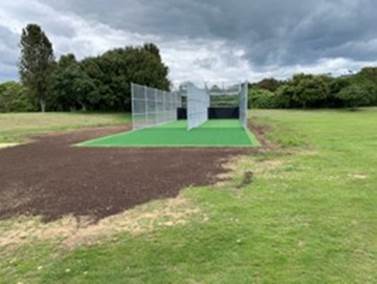

42. The design of a new netball
shelter at Gordon Spratt Reserve has been confirmed. This is a prefabricated
building which is being manufactured offsite for installation at the
reserve. Installation is anticipated late-January.

43. The Tauranga Heritage
Collection received more exposure during Pasifika in the Bay, via a stand
showcasing objects with connections to the Pacific.
44. We were fortunate to have two
kaumatua groups from Pirirakau and Ngai Te Rangi visit the museum collection.
Both groups provided strong support for the museum development, to showcase our
local history and cultural artifacts. Also conveyed was the importance of a
museum as a platform for community events, educational programmes and
exhibitions that celebrate the diverse heritage of the region.

45. Baycourt was a primary venue
for the biennial Tauranga Arts Festival, providing support to the Arts Festival
Trust. Over the 10-day festival period, Baycourt facilitated three mihi
whakatau to welcome performers, crew, and creatives to Tauranga. This endeavour
not only aligned with the festival Kaupapa, but also exemplified our commitment
to manaakitanga, a core value of Tauranga City Council.
46. The Event Facilitation team
successfully managed 66 events and bookings on public open space in the first
quarter of the 2023/24 year. This number is comparable with the 2022/23 first
quarter. We are seeing a continuing increase in filming activity, with seven
filming activities facilitated in our public open spaces, two more than in the
first quarter of 2022. The team is working on several inquiries from film
industry participants who are looking to do film projects in the coming year.
47. The Classic by HoopNation, a
premier basketball event in New Zealand since 2017, attracted 7,000 attendees
to Tauranga from New Zealand and Australia. Funded by Council and held at
various venues over the Labour Day weekend, the event was attended by 1,300
athletes from 191 teams. Also included was a visit by local Whai basketball
players to Merivale School. This outreach engaged Year 4-6 students in a
morning of basketball action, leaving students and players with lasting
memories.
48. The Historic Village hosted the
Diwali Festival of Lights on 28 October, drawing 2,500 community members to the
Village Green, which was near capacity. The event's vibrant atmosphere, coupled
with thematic decorations, highlighted The Historic Village as a unique venue
for organising local events in Tauranga Moana.
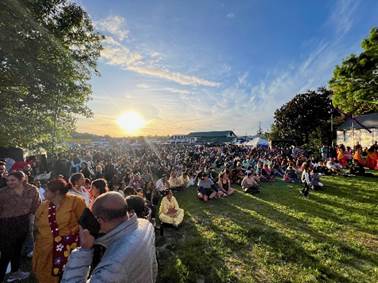
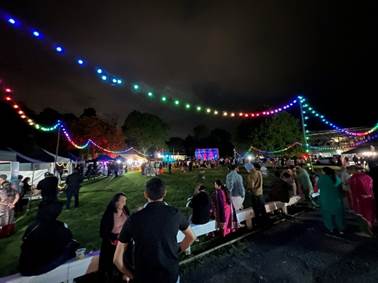
49. Over the summer months
(December to March), Council will facilitate 54 large events with expected
attendances of over 500, and an additional 44 City Centre Activations of
outdoor cinema, live music, yoga and pilates. There will also be markets and
private events which are not held on public open space.
50. A new map has been installed at
the entrance to the Village to help visitor wayfinding and tell the story of
The Historic Village. The features all Village buildings and features
watertight perspex boxes and poster lockers offering printed maps for visitors
to take.

51. International Day of
Disabled Persons on 3 December
The
incredible talents within our local disability community were highlighted at
this year's celebration of the International Day of Disabled Persons on 3
December. Taking place at Hopukiore (Mount Drury) Reserve, we showcased
Tauranga’s vibrant disability community at a free, fun-filled,
family-friendly day. Live performances included the main act, singer Sophie
Maude, as well as dancing by Mount Dance Co, kapa haka from Idea Services,
singer Hayley Little, and social circus act Circability.
We’re
proud to host this event in association with our partners Parafed BOP, CCS
Disability Action and Western Bay of Plenty District Council. Together,
we’re working hard to champion inclusion and make Tauranga a more
accessible city, where people are free to move around easily and safely,
without limitations.
The
Library also held a week-long series of events designed to support people
living with a disability and celebrate the International Day of Disabled
Persons. This included sharing all the inclusive resources we have available in
the library, accessible activity enrichments, and an evening panel talk with
members of the disabled community.
Tauranga
Taurikura – A city that values, protects and enhances our environment
52. It was great to see the public
enjoying the fresh sand slopes at Waikorire/Pilot Bay over the weekend. This
sand, repurposed from our routine deep water dredging operations, serves a dual
purpose: guaranteeing the safety of our shipping channels while contributing to
the rejuvenation of beaches citywide. Rigorous quality assessments precede the
deposition of this sand, ensuring its adherence to public health standards.
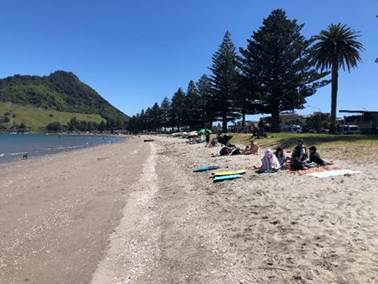
Tauranga
- Tātai Whenua – A well planned city
53. The Emergency Management team
is looking forward to welcoming two summer interns – from Auckland and
Otago Universities – to assist with our community engagement activities
over summer. The summer interns both have strong connections to Tauranga and
will be assisting with various task,s including community engagement, tsunami
zone audits and operational reviews.
54. Staff from across Council
participated in the annual Shake Out Earthquake drill on October 19. This
national exercise coordinated by The National Emergency Management Agency
(NEMA) reminds people of the right action to take during an earthquake - drop,
cover and hold. It was great to see so many people get involved across all
Council locations – even the Vessel Works and Pyes Pa Cemetery teams.


55. Fear Free, a company that
specialises in training to de-escalate aggressive situations, delivered an
engaging and thorough session for the Service Centre, Library and some
Regulatory staff in October.
56. Construction has commenced on a
new deck structure Mauao at Awaiti, on the northern face of Mauao, as part of
the placemaking programme of work. This work is progressing well and is
expected to be completed before the end of November. This project has received
a $150k funding grant from the Port of Tauranga. Visitors to Mauao this summer can
expect several other features to be completed by Christmas, including
sculptures, a feature seating area on the lower summit and the shaping of a
natural amphitheatre near the water tank.
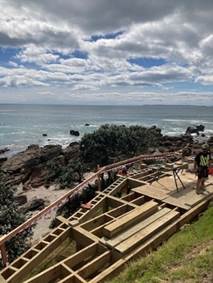
57. Good progress is being made on
the construction of the Destination Skate Park, with the project on track for
April 2024 completion. The project team has been successful in obtaining
additional external funding for construction zones 3 & 4 and completion of
the design scheme.


58. In the CBD, work has begun in
conjunction with the City Centre team on the first of several
placemaking/activation projects at Grey Street. Initial work involved the
removal of the Palms in this location. Work will follow on some streetscape
enhancements to give an impression of what the enhanced city centre will look
like in the future.

59. Building 62 at The Historic
Village, known as Colonel Greer’s Cottage, has undergone an interior
fitout, including new electrical circuits and lighting, completing the final
phase to bring this building into use. A designated Green Room workspace
features three workstations, a heat pump, Wi-Fi, radio charging stations, a wet
area for wet weather gear, and comfortable amenities for event organisers
hosting community festivals on the Village Green. The space is available for
hire as part of The Village Green, or as a separate space if The Village Green
is not in use.

Tauranga
Ara Rau – A city that we can move around easily
60. As part of the
Pāpāmoa Shared Path project, work has begun (in conjunction with the
Transportation team) on the installation of raised pedestrian crossing tables
to assist users to safely cross Domain Road.
61. Construction on the Marine
Parade Coastal Path is progressing, with the section from the Cenotaph to Hart
Street being completed prior to Christmas. Construction of the section from
Hart Street to Tweed Street will be completed in February.


Tauranga
a te kura – A city that supports business and education
62. November saw the start of the
outreach initiative to Whakatipuranga teen parent school. Library staff
will visit Whakatipuranga and the students will come into a library to take
part in a creativity-based learning programme that has links to the
New Zealand Curriculum. The activities will encourage participants to interact
with their pēpi (babies), with kōrero to support literacy
development.
63. For those who missed ART +
ARCHITECTURE: A TAURANGA ART GALLERY STORY, thanks to a collaboration between
Toi Tauranga Art Gallery and the Heritage & Research Team – Tauranga
City Libraries, anyone can now view the exhibition as an online timeline in Pae Korokī.
Art + Architecture maps key moments of Tauranga Art Gallery’s conception
and journey as a public art gallery.

64. Several years ago, in
collaboration with the Tauranga Arts Festival, we launched
‘Glimpses’, a publication that explores the Tauranga Heritage
Collection. At this year’s Arts Festival, we launched the third
Glimpses publication: ‘Collecting Connections’. Eleven rangatahi
were challenged to select one object that connected with them from more than
30,000 in the Heritage Collection. They were then invited to put forward an
object of their own choice to be added to the collection. What emerged were
individual and object-based connections that exceeded our expectations.
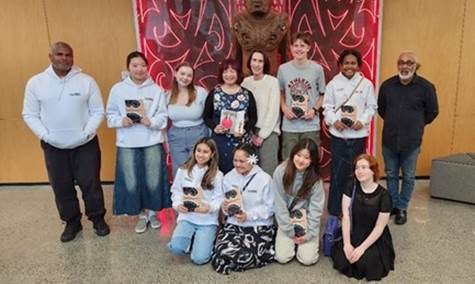
Museum staff with the young people who participated in
the Glimpses project and some proud parents.
65. Our Museum Educator ran a
professional development session for the Art Gallery and Library educators -
‘Aotearoa Histories 101 and Te Tiriti o Waitangi ki
Tauranga’. Some feedback we received from this session was:
“Another
big ngā mihi for your wonderful workshop. Was so great to get a refresh to
Aotearoa Histories and to be able to see what you are teaching in the
classroom. It’s also nice to be able to create lovely working connections
between our Tauranga Moana GLAM sector colleagues.”
66. As well as training Council
colleagues, the Hands-on Tauranga outreach programme delivered a variety of topics
to a record 1,198 students in Term 3. As we head towards the end of the school
year, the number of Tauranga City students that have or will experience a
Hands-on Tauranga Outreach session in Term 4 is sitting at 1,031 students. We
have had excellent feedback from these sessions this year, with many teachers
rebooking.
“Just
wanted to say thank you again for your visit yesterday. The children from
all 3 classes were just absolutely buzzing and so engaged. What an
awesome resource we have in Tauranga moana.” Bellevue Sep 2023.
Term 4
is generally quieter for borrowing Hands-on Tauranga objects, but we still
loaned 95 objects, with another 66 used for Outreach. Feedback from a teacher
that borrowed objects this term:
“My
class absolutely loved having them. They have had a wonderful time exploring
the old toys. Thank you. Such an amazing resource.” St Mary’s
School.
67. As part of our popular Outreach
sessions, our Museum Educator took the taxidermied kiwi to a group of Year 1
students at Pillans Point School recently. These students were particularly
moved by the plight of Paora the kiwi in the Miami Zoo earlier this year and
wrote some fabulous stories about Paora.
68. Our Museum Educator was invited
to take part in a segment on the Breeze Radio station recently, promoting
Hands-on Tauranga and the Museum project. Objects were brought in as part of
the segment and radio hosts Max and Jolene were very enthusiastic about seeing
the objects and finding out more about the Hands-on Tauranga service.
69. Our Director of Arts, Culture
and Heritage was the keynote speaker at the Priority One AGM on 8 November. His
speech focused on Te Manawataki o Te Papa and the role modern museums play in
liveable cities, their economic impact and the transformational role a museum
has, creating opportunities for visitors to learn about themselves and about
each other. His address was warmly received by the audience,with a lot of
positive comments about the new museum around the room.
70. On 6 November 2023, Baycourt
launched an exclusive ticketing partnership with Eventfinda New Zealand,
following a comprehensive RFP process. The transition from the existing
provider, Ticketek, will occur gradually over the next few months. This
partnership is rooted in a shared commitment to prioritise the customer,
ensuring a consistent, intuitive, innovative, and user-friendly ticketing
experience for patrons and venue hirers.
71. Baycourt was recently
approached by Massey University to participate in a new national research
project being funded by the Ministry for Culture & Heritage to measure and
articulating the value of the live performance sector in Aotearoa. The main
purpose of the research is to demonstrate the economic and social/wellbeing benefits
of the live performance sector, in a way that speaks the Government’s
language. A significant proportion of the project is dedicated to implementing
a nationwide survey of event attendees from June 2023 to June 2024. At the
conclusion of the research, the University will develop a free, publicly
available tool which the live event sector can use to articulate the value of
their events and operations to funders and Government.
Chief Financial Officer
Finance
72. In October, the Strategy,
Finance & Risk Committee approved an increase of $100m in Council’s
uncommitted facility, bringing the total facility cover to $200m. The
report indicated we would increase the uncommitted facility with our current
provider (ANZ). However, it is not possible to simply increase the
existing facility and we are instead looking at a separate product.
Therefore, staff will assess quotes from a number of banks, consistent with TCC
procurement guidelines.
Credit implications of
not separating water entities from Councils
73. Standard & Poor’s (S
& P) has reported on the implications for councils’ credit ratings
and debt of the decision not to move waters responsibilities to separate large
entities, as originally proposed in the waters reform. This report - New
Zealand Local Government Outlook 2024 – Bridge over Troubled Waters -
notes that while the alternative reform proposals remain unclear, if debts
(past and future) are merely shifted into entities that remain under the
control of councils, local government credit quality may continue to erode.
74. A graph in the S&P report
reinforces the submissions made by local government that while many of the
costs of infrastructure and regulation have been borne by local government, its
revenue from taxation has not increased as a proportion of GDP. Central
government taxation has instead taken the increase, even though councils’
investment in areas such as three waters, roading and development of new growth
areas has in large measure contributed to this GDP growth.
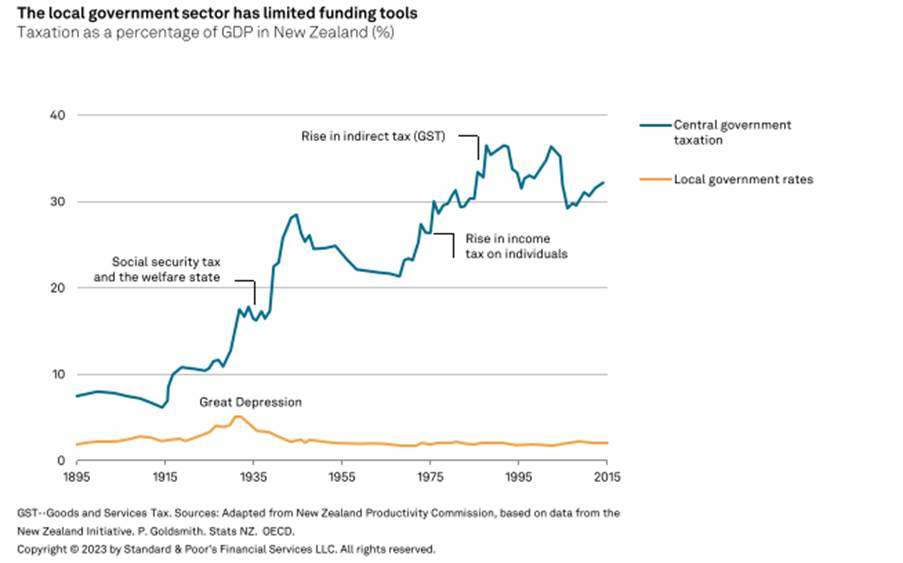
Council
borrowing milestone
75. Council gross borrowing in
November exceeded $1b for the first time. The 2023/24 Annual Plan
budgeted a gross debt level of $1.1b by June 2024.
IFF
and rates system implementation
76.
The first IFF levy for transportation projects commences in the 2024/25
financial year. Details of rateable properties and incorporation in
TCC’s new SAP rating platform is being undertaken at the moment.
(a) Negotiations on a potential
second IFF for Te Manawataki o Te Papa are still being worked through.
77. Rating revaluation has been
undertaken by Opteon, as part of moving to a new three-yearly cycle. From
the first draft revaluations, audit identified further work to be undertaken to
satisfy quality requirements. The second version was submitted to the
Office of the Valuer General (DIA) on 24 November, with feedback expected
within two weeks.
Tauranga Airport
Airport Operations
78. There were 926 flights operated
by Air New Zealand during October carrying 48,495 passengers, compared to
46,823 passengers and 886 flights in October 2022.
79. Air NZ is operating with circa
90% loadings at regional airports across the country, meaning many people
wishing to travel by air are either not being able to travel at a time that
suits, or are not able to travel by air at all.
80. Air NZ has two new turbo prop
ATR aircraft arriving in mid-2024, adding capacity to regional routes.
Unfortunately, they have been advised that the Pratt and Witney engines on
their Airbus fleet will require major off-wing maintenance. The total
maintenance period will be in the order of two years, with up to four of the
jets out of service at a time. On top of this, they have a maintenance issue
with some of their Boeing 787 fleet, causing the pausing of services to two
overseas destinations. For regional airports, this means no additional services
for the next two years, as the new turbo props will be partially covering the
Airbus routes. For Tauranga, there is a possibility that some of the 50-seat
aircraft services could be upgraded to 72-seat aircraft. Air NZ is working
hard to get hold of some lease aircraft, but there is a worldwide at present,
particularly for turboprop aircraft.
Airport
Development
81. Tauranga Airport takes over the
ownership of and responsibility for the operation and maintenance of the
Airport’s lighting, visual navigation aid and standby power systems on 1
December. We are the first of the regional airports to do so. This equipment is
very old, in poor condition and obsolete, in that there are no longer parts
available. We have commissioned ADB Safegate, a multinational provider and
maintainer of this type of equipment, to do a complete rebuild of the system,
which commenced two months ago. We anticipate a switchover to the new
system will be possible late-March.
82. We have taken this as an
opportunity to install state-of-the-art equipment, including only-LED lighting,
with the runway edge lighting being high intensity, as used at Auckland,
Queenstown and most overseas airports. This decision was made to minimise the
number of missed approaches and diversions due to poor visibility, as pilots
must be able to positively identify the runway environment before descending
below 600 feet when approaching from the west and 300 feet from the east. Gold
Coast Airport reduced diversions by 90% when it went down this track about
three years.
83. 
 The images below show what the runway lighting looks like now, from
an altitude of 1000m, and what it will look like when the new system is
operating. In addition to the edge lighting improvements, we will have high intensity
approach lighting and REIL’s (runway end indicator lights, or strobes)
which a pilot can request to be switched on. The lighting can be operated
at settings from 1% to 100%. All of this equipment will be operated
remotely from Christchurch or Auckland outside othe hours of service of our Air
Traffic Control team. The new system will take away any confusion with local
environment lighting, such as Hewletts Rd and the Port.
The images below show what the runway lighting looks like now, from
an altitude of 1000m, and what it will look like when the new system is
operating. In addition to the edge lighting improvements, we will have high intensity
approach lighting and REIL’s (runway end indicator lights, or strobes)
which a pilot can request to be switched on. The lighting can be operated
at settings from 1% to 100%. All of this equipment will be operated
remotely from Christchurch or Auckland outside othe hours of service of our Air
Traffic Control team. The new system will take away any confusion with local
environment lighting, such as Hewletts Rd and the Port.
84. The total cost of the upgrade
is $2.8m, which is budgeted for and will be paid for via user fees and charges.
The cost saving to Air NZ is significant, and business travellers will also
benefit from a reduction in diversion-related productivity impacts.
85. We will be asking kaumatua
Manea Ngatai from Whareroa Marae to flick the switch in March, firstly to bless
the new equipment and secondly as he was part of the team that installed the
current system back in 1967.
86. Internal lining of the new
fire and rescue building has started.
Strategy, Growth &
Governance
Te Pou Takawaenga
87. Te Ara Whānui Update: The
Te Ara Whānui app has now exceeded 2,000 downloads and is quickly gaining
popularity as a handy reference tool, both within Council and externally.
88. Takawaenga Field Trip updates:
In keeping with Working Beyond Tauranga as set out in Our Direction, Te Pou
Takawaenga has taken-up several invitations to visit other councils and iwi
entities in Wellington, Eastern Bay of Plenty and the Far North. In all cases,
we met with the local councils, local museums and iwi-led entities focused on
sharing history with their wider communities. We have shared policies and
processes around iwi and hapū engagement, support of te reo and tikanga,
partnership approaches to projects and maintaining integrity in interactions.
89. In return, we have received
insight into how other councils approach this and how these activities may
impact iwi and hapū entities. Regarding museums and history-sharing, the
key theme has been authenticity and simplicity. Each of these learnings will be
analysed for transferable learnings in the advice and guidance we provide.
Corporate Services
Community Relations
90. The Media Impact Score (MIS)
for October was 2.1, sitting above the local government average of 2.0. The
number of reports also rose to 244. Positive reporting focused on transport
developments - despite frustration about parking. This was a mostly positive
theme, with recognition of Council's decision to defer the parking plans. The
most positive theme of the month was TCC’s and Commission Chair
Tolley’s response to vandalism of te reo Māori on rubbish bins. Very
negative coverage was based around poor air quality in Mt Maunganui.
91. In October, many Community
Relations team members were involved in producing content and advertising
collateral for the draft Long-term Plan. The strategy has been to try and reach
people who might not ordinarily engage with council, both digitally and in
person. Most engagement events are in shopping centres and markets, going to
where people are rather than relying on residents coming to us. We have
minimised other advertising activity through the consultation period, 15
November – 15 January, so as not to detract from this important
engagement activity.
Digital Services
Association
of Local Government Information Managers (ALGIM) Awards
92. The Digital Services and
Customer Services teams had a very successful night at the Association of Local
Government Information Managers (ALGIM) Awards on 15 November. Tauranga City
Council won the following national awards:
· ICT
Professional of the Year Award - Cheryl Pome'e, Digital Security Lead
· Most
Improved Cybersecurity
· ICT
Project of the Year Award - City Beautification
· Top
10 for Best Customer Experience Award
93. These awards are the result of
a lot of hard work by our Digital teams and strong collaboration with the wider
organisation. The ICT Project of the Year award is a great example of a
one-team approach, working with the City Operations team to deliver an outcome
we can all be proud of.
Digital Capital
Programme – Enterprise Resource Planning (ERP) Programme
94. The programme has achieved
another significant milestone during this reporting period with the successful
go-live of a new Human Resources Information System (HRIS), SuccessFactors.
This required the migration of all our core employee data and the new core
system now allows staff and managers to manage employee data, request leave,
manage performance and goals and manage teams.
95. The go-live also includes
mobile capability for staff to manage timesheets, leave and their employee
information directly from their mobile phone. This is especially important for
our field staff who do not always have access to a laptop.
Cyber Smart Week
96. In late-October, we organised
the highly anticipated "Cyber Smart Week" event, one of the
cornerstones of our annual cybersecurity initiatives that delve into a myriad
of crucial cybersecurity topics. To enrich the experience, we integrated the
expertise of our Privacy and Business Continuity teams, offering valuable
insights to enhance the proficiency of other TCC functions.
97. This event saw a great response
from staff, creating numerous opportunities to address cybersecurity and
privacy concerns while elevating the awareness of users.
ExpenseMePro
98. ExpenseMePro, the latest
expense management solution for P-Cards, has been successfully implemented to
replace Fraedom for the Finance team and budget managers.
Civic Digital Infrastructure
99. Digital Services continues to
support technology required for Civic Precinct projects, including 90 Devonport
Rd, the Library and Community Hub, Museum, Civic Whare and public realm
spaces. Current focus areas include:
· 90
Devonport Rd – The contract was awarded to a selected Audio-Visual supplier.
We are currently working through and updating the anticipated technology
delivery programme.
· Community
Hub, Civic Whare and Museum – current focus across these spaces is
integrating technology briefs and concept drawings into design.
· Waterfront
and public realm spaces – Investigating opportunities to include
technology in the Waterfront and Public Realm projects, including digital
signage, wayfinding (from a technology perspective), digital placemaking
(projections, interactive opportunities), storytelling opportunities (from a
technology perspective), public wi-fi zones, and digital kiosks.
Legal,
Risk & Procurement
100. The Legal Team has been educating relevant
staff on the new Business Payment Practices Act 2023 and regulations and will be
supporting the business to prepare for Council’s first six-month
disclosure period (1 July to 31 December next year). This legislation
imposes significant new reporting obligations on large businesses (including
council) relating to payment practices - payments on invoices received/issued
and paid in a reporting period. The policy purpose behind this
legislation is to provide businesses (particularly small businesses) with
visibility of the payment practices of the larger businesses they deal with.
101. The Legal team has also signed up to the
NZLS Gender Equality Charter, to ensure the team and profession continue to
close the gender pay gap.
102. The Risk team, in conjunction with Digital
Services, has successfully completed User Acceptance Testing of the new risk
management software (Camms). A soft go-live has launched, with roll-out to the
wider organisation planned to commence in the first quarter of 2024.
Procurement Drop-in
Sessions
103. The procurement team recently held drop-in
sessions, giving local businesses an opportunity to meet with us to ask
questions, share their work and find out more about working with Council.
104. The team met with over 20 businesses, most
of which were locally based or had a presence in Tauranga. Feedback from
the sessions was positive with most attendees strongly agreeing they found the
drop-in session useful and indicting that they would recommend the sessions to
others. Likewise, the procurement team found meeting with these
businesses a valuable experience, providing an excellent opportunity to build
closer relationships with our supplier base.
105. As a result of these sessions, we have
already engaged two new suppliers and passed on details and referrals for
others. There will be further sessions available in the new year.
People,
Performance & Culture, Health and Safety
Health and Safety
106. Over the last six weeks, more than 130
staff have attended workshops on Contractor Management and Risk Management
processes.
107. There has been an increased level of
incident reporting, on the back of the newly-created Damstra training
module. More than 85% of staff have completed this training and are now
aware of how to load an incident/event, and what needs to be reported.
The drug and alcohol policy communication plan is being completed ahead of
people leader and staff information sessions.
90 Devonport Road
108. The transition team facilitated five
workshops for people leaders to help develop a transition plan to support staff
relocating to the new building.
Talent Acquisition
The team is working
through 62 vacancies. We have continued to be proactive in the market,
identifying excellent candidates and supporting our people leaders to fill a
range of complex and long-standing vacancies. This has resulted in over half of
our vacancies progressing to offer stage. Our continued drive to deliver a
positive and efficient recruitment process has been supported by the changing
employment market and reduced requests for resource, in conjunction with the
recruiting team utilising candidate search functions such as
LinkedIn.
Turnover
109. Unplanned turnover has fallen again, now
at 12.7%, down from 13% last quarter. This is the lowest we’ve seen in
the past three years, but is not unexpected given the current economic uncertainty.
Learning &
Development
110. The team has wrapped-up a big year of
learning delivery with the last two cohorts of Te Huringa Tai: Our Emerging
Leaders programme finishing shortly, providing capacity for the development of
new programmes for 2024, including Performance Management and People Leader
Induction.
Performance,
Monitoring & Assurance
111. GIS data has now been migrated to AWS
(Amazon Web Service). New internal and external viewers are being built in a
test environment, along with other apps. All dependencies with older virtual
desktops have been removed. The go-live trial for the field safety app for
parking staff has also been undertaken.
New aerial photography
for Tauranga City now available for all staff.
112. The BI team has focused on deploying a
Transport Insights Portal - giving an overview of transport related information
in one place, available to all staff on insider; and a dashboard giving an
overview of financial performance (presented at the 4 December Strategy Finance
and Risk Committee meeting). Both projects aim to increase our knowledge and
visibility of data.
113. The CPAD team has been focused on internal
audits of projects and facilitating workshops to identifying the significant
number of projects occurring within the city centre over the next five years.
Regulatory Compliance
Building
Consents
114. We received 206 Building Consent and
Amendment applications in October, for a total of 755 for the year to date.
This was a slight increase in volume compared with the past six months (an
average of 184 per month for the past six months), but 6% less than last year,
and 8-20% lower compared to the July-October periods for 2019 – 2022.
Anecdotally, the slight increase in October is driven by increases in the
requirements of Building Code Clause H1 – Energy Efficiency, which came
into force on 1 November.
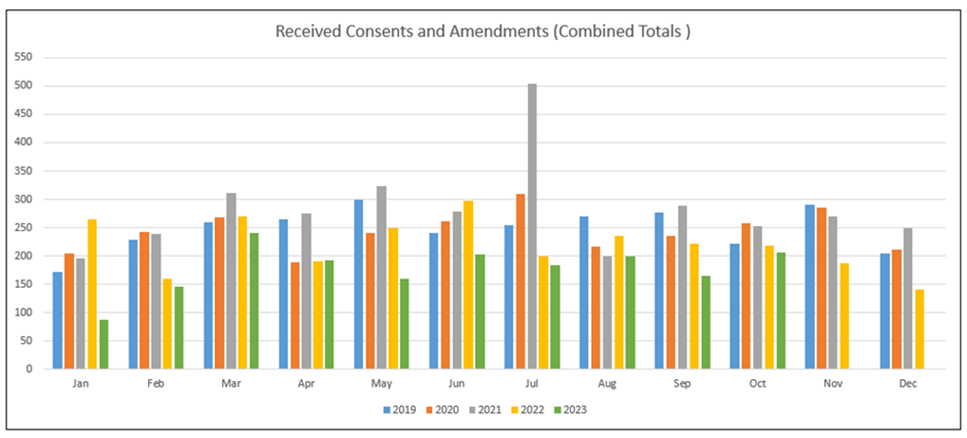
115. We granted 170 consents and amendments in
October, for a total of 755 YTD. The volume of consents granted is clearly also
down compared with previous years, reflecting the reduced number of
applications received. 13 applications were refused in October, which is higher
than for previous months. By way of example, we refused a total of 37
applications in the last financial year (an average of 3 per month). This is
due to a concerted effort to ensure that we only accept applications with
sufficient information.
116. The proportion of consents granted within
statutory timeframes has increased slightly, with 68% of consents and
amendments issued within 20 working days in October. At the time of preparing
this report, November’s figures are on track to improve by 10% or more.
We have implemented several small process changes, and are working on others,
to help improve this further. This includes daily reporting on applications
that are approaching 20 working days, seeking additional capacity from our
contractor and in-house workforce, as well as the increase in refused
applications referred to above.
117. As part of this concerted effort to get
applications out before day 20, we have also focused on addressing older
consents which can affect timeliness tracking. For example, if you look at the
consents granted in October that were received in the past three months, 85.5%
of these were granted within statutory timeframes. We had 94 applications in
progress that were already over day 20 at the start of October, but by
mid-November, that had reduced to 51 applications.

118. Inspection wait-times for standard
(45-minute) inspections have remained low, generally around 24 hours, whereas
for our most complex inspection types (for instance R3 Finals) the lead-time
has pushed out slightly to a maximum of five days. Inspection numbers remain
roughly 20% down on previous years, with around 400 inspections completed most
weeks. Because wait-times are low, there is reduced demand for our remote and
weekend inspections.
119. We issued 135 Code Compliance Certificates
(CCCs) in October, for a total of 603 YTD. In October, 42 of the CCCs issued
related to the construction of new dwellings and a further two consents related
to the construction of 41 independent units in aged care facilities. Our
compliance with statutory timeframes has remained consistently high, with 97%
being issued within 20 working days in October.
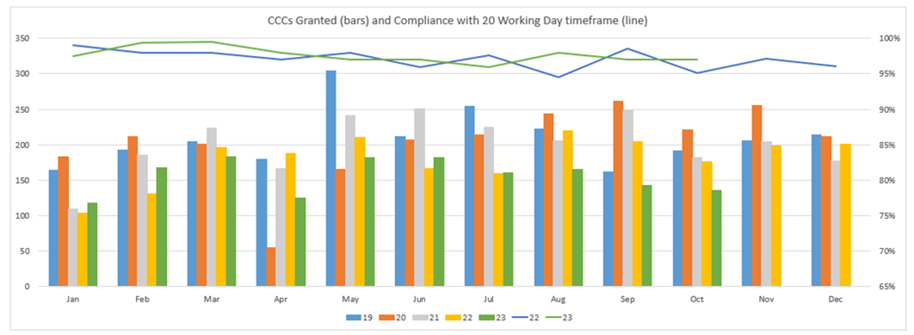
120. Our IANZ (on behalf of MBIE) assessment
took place over two weeks, from 25 September to 6 October. The outcome of this
assessment has been positive, with only eight ‘non-compliances’
identified. Action plans have now been approved for all the non-compliances and
implementation is well underway.
Environmental
Planning
121. 237 applications for resource consents and
other associated approvals have been received so far in the 2023/24 financial
year to date (Q1). October saw a decline in the number of applications received
per month, which is consistent with previous years’ trend of a slowdown
in the lead-up to the holiday break. Overall, numbers remain slightly higher
than at the same time for 2022/23.
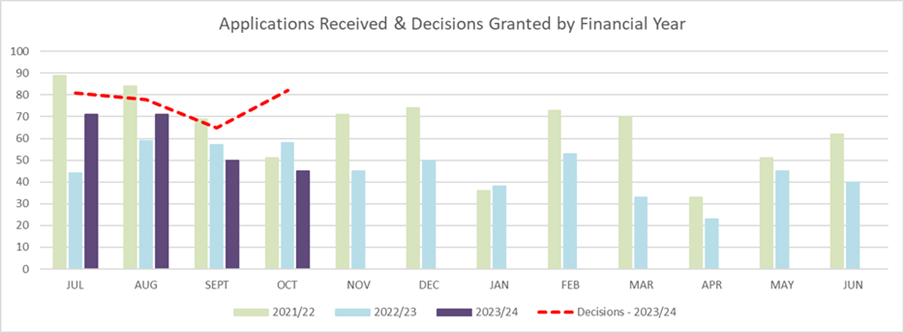
122. For the 2023/24 financial year to date,
Council has issued decisions in relation to 306 applications. Timeframe
compliance for new applications (i.e., applications received since 1 July 2023)
is currently 84%. This is a great improvement on previous periods, with 75%
reported in Q1 of this financial year and 72% in Q4 of last year. It also marks
the highest levels of compliance since 2019/20.
123. Implementing process improvements to
improve processing timeliness and efficiency remains a focus for staff. This
includes the decision to be more direct in returning applications that do not
meet the sufficiency tests in the RMA, rather than providing extra time for
applicants to resolve issues post-lodgement. This decision has had a noticeable
effect on timeframe compliance, with returns accounting for 27% of decisions on
new applications.
124. Further, staff are continuing a dedicated
project to work through historic applications, alongside those lodged in this
financial year. These have significant implications on timeliness over the
course of the year. Clearing this backlog will provide a much better platform
for managing workload and ensuring timeliness across all applications.
125. In the financial year to date, staff have
conducted development contribution assessments for 510 building consents,
totalling $ 7.4 million in contributions, and 146 resource consents totalling
$3 million in contributions.
126. Staff continue to receive a number of
requests for development contributions to be deferred, generally until a
Certificate of Code Compliance (CCC) is issued. The current value of deferred
DC’s is $6 milliion, with the majority of agreements including
requirements for interest to be payable on the deferred amount.
Environmental
monitoring
127. Staff have responded to 98 RMA incidents
and 119 noise incidents in the financial year to date, with a further 130 noise
complaints responded to by contractors. Council has monitored 331 resource
consents in the financial year to date. The majority of RMA incidents continue
to relate to over-height fencing, breaches of resource consent, or concerns
around density of housing.
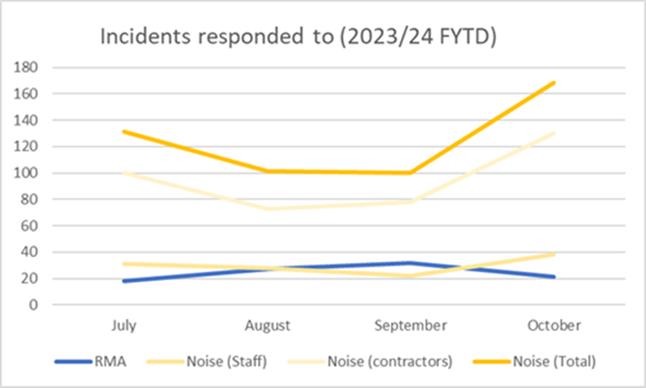
128. Noise complaints most frequently relate to
either noise from residential or commercial activities and construction
vibration. An increase in noise complaints is normal for the summer period.
Staff recently met with Police to discuss the need for assistance during noise
equipment seizures, to ensure staff and contractor safety following an increase
in anti-social behaviour.
129. With the scale of works both underway and
proposed to be carried out by (or on behalf of) Tauranga City Council, staff
are engaging with project teams to identify potential concerns and ensure noise
and vibration issues are identified and addressed appropriately.
Matters of Interest
130. A recent application by Wolfbrook for a
housing development on Ridge St, Otumoetai, has drawn significant interest from
local residents, with concerns being raised in relation to density and
character. Although a decision is yet to be made in relation to notification,
staff are now proactively engaging with the community, to keep them up-to-date
on the process.
131. A number of parties, including hapu and
representatives of several active community groups, have joined the Allied
Asphalt hearing process for regional and district council consents (to be heard
by the Environment Court via direct referral). The next step will be a judicial
conference where the Court will question the parties on their case, expert
evidence and availability. Following this, the Court will set a date for the
hearings.
132. Mediation was recently held in relation to
an appeal against a resource consent authorising the establishment of the THM
Limited basketball training and event facility in Judea. Staff are hopeful that
this matter can be resolved through settlement.
133. The EPA have outlined engagement protocols
and likely requirements from Council to assist them in their role of the
Consenting Panel for the Sanderson Group’s Pitau Road project, which has
been referred via the COVID-19 Recovery (Fast-track Consenting) Act 2020. Staff
are preparing to receive formal requests for comments in late November/early
December.
134. Staff are progressing investigations into
the use of motels for short-term/emergency social housing, following concerns
being raised by members of the community.
Environmental
Regulation
Alcohol Licensing
135. Between 1 October and 20 November 2023,
the Alcohol Licensing team has forwarded 219 various alcohol licensing
applications to the District Licensing Committee for consideration and
determination. A breakdown of the applications is provided in the table below.
|
Applications forward to the District
Licensing Committee
|
|
Application Type
|
Number
|
YTD
|
|
OFF Licence (New)
|
2
|
4
|
|
OFF Licence (Renewal)
|
4
|
16
|
|
ON Licence (New)
|
6
|
11
|
|
ON Licence (Renewal)
|
19
|
45
|
|
Club Licence (New)
|
|
|
|
Club Licence (Renewal)
|
1
|
8
|
|
Temporary Authorities (ON & OFF)
|
13
|
20
|
|
Manager (New)
|
36
|
147
|
|
Manager (Renewal)
|
29
|
99
|
|
Special Licence
|
109
|
210
|
|
Total:
|
219
|
560
|
136. The team also completed 35 premises
inspections within this period, ensuring that licensed premises were being
operated and managed as required under legislation. For the year-to-date, the
team has inspected 84 new and renewal licensed premises.
|
Enforcement
|
|
Number
|
YTD
|
|
Infringements
|
0
|
3
|
|
ARLA Suspensions
|
0
|
4
|
|
ARLA Cancellations
|
0
|
0
|
|
Total:
|
0
|
7
|
137. There have been no infringements or
applications for suspension of a licence or certificate made to the Alcohol
Regulatory Licensing Authority (ARLA) in this current reporting period.
|
District Licensing Committee Hearings
Held
|
|
Number
|
YTD
|
|
ON LICENCE
|
3
|
6
|
|
OFF LICENCE
|
|
2
|
|
CLUB LICENCE
|
|
|
|
MANAGER
|
|
7
|
|
TEMPORARY AUTHORITY
|
|
3
|
|
SPECIAL LICENCE
|
|
|
|
Total
|
3
|
18
|
138. Of the three applications referred to
hearing for determination by the District Licensing Committee (DLC), one was
granted and two were declined. The two declined were applications for a renewal
of an ON Licence (Mount Social Club in Mount Maunganui) and an application for
a new ON Licence (Greerton Social Club in Greerton). In relation to the
declined applications, although there are two separate companies involved, the
business owner is the same.
139. The DLC indicated in their decision for
the Mount Social Club that the amenity and good order of the area would
increase by more than a minor extent if the renewal was refused. It had become
evident during proceedings and during deliberations that the DLC believed that
the actions required to safely manage Mount Social Club was not being carried
out by the applicant. The DLC decided in this case to put public safety first
and subsequently found the applicant unsuitable to operate such a high-risk
tavern-style premises in the Mount Maunganui precinct.
140. The decision to refuse the Mount Social
Club application also reflected on the ability of the applicant to hold the
same type of licence at the proposed new premises known as Greerton Social
Club. As the business owners were the same, the DLC found them unsuitable to
hold a tavern-style ON Licence.
141. The applicant for both declined
applications has advised Council that they are likely to appeal the District
Licensing Committee decisions to the Alcohol Regulatory Licensing Authority
(ARLA).
Local Alcohol Policy
142. Recent changes to the Local Alcohol Policy
were decided on by the Strategy, Finance and Risk Committee at a deliberation
hearing on 30 October, with changes coming into force on 12 February 2024.
These changes include:
(a) Changing the opening sales time
for ALL off-licensed premises from 7 am to 10 am.
(b) No new bottle stores in areas
where the deprivation index is 9 or 10.
(c) A change to the closing time
for on-license premises in the city centre bars to 2 am, instead of the current
3 am closing time.
(d) A change to the one-way door
policy, which will start at 1 am, instead of the current 2 am closing time.
(e) A range of discretionary
conditions that can be applied to off-license premises.
143. Messaging has gone out to all those
licensed premises affected by the changes, with further messaging to the public
to be undertaken in the early new year. There are also plans to hold in-person
meetings with affected parties in the lead-up to the changes coming into
effect.
Environmental Health
144. 72 verifications of food businesses were
undertaken in October and November this year, and 252 so far this financial
year. Of the 252 verifications conducted year-to-date, eight received an
‘unacceptable outcome’.
145. An unacceptable outcome means that the
business had a number of non-compliances that need to be resolved, and the
business’s verification frequency will increase until compliance
improves. When a food business receives an unacceptable outcome, it must gain
two acceptable outcomes before its verification frequency can be decreased.
146. Registrations and service requests are set
out below.
|
Registrations
|
1 October to 20 November
|
YTD
|
|
|
Food Registrations - New
|
42
|
113
|
|
|
Food Registrations - Renew
|
89
|
334
|
|
|
Health Registrations – New
|
3
|
5
|
|
|
Health Registrations - Renew
|
4
|
149
|
These are generally renewed in August, September,
and October
|
|
Service Requests (complaints, queries
etc)
|
1 October to 20 November
|
YTD
|
|
|
Food safety and suitability enquiries, complaints,
investigations and enforcement
|
10
|
27
|
27 total investigations resulting in 8 enforcement
interventions
|
|
Customer queries
|
12
|
33
|
|
|
Health registration
|
1
|
5
|
|
|
Hairdressers
|
0
|
4
|
|
|
Housing
|
1
|
1
|
|
|
Health miscellaneous
|
4
|
7
|
|
|
Food registrations
|
32
|
87
|
|
|
Compliments (on service)
|
2
|
3
|
|
|
TOTAL:
|
|
167
|
|
Matters of Interest
147. The Environmental Health team hosted a
regional food meeting in November, with verifiers and food safety officers
attending from the Ministry for Primary Industries and Taupo, Rotorua, Western
Bay of Plenty, Whakatane and Opotiki District Councils. Agenda items included
an MPI compliance update; conducting verification of Kombucha manufacture and
critical control points; preparing for a food complaint investigation; our
tools of the trade (essential items for checking compliance); overview of the
recent nationwide Prime energy drink investigation and seizures; and a general
Q and A session.
Animal Services
148. Actions taken in relation to Animal
Services complaints received from 1 October to 23 November are listed below.
|
|
Warnings / Notice
|
Abatement Notices
|
Dangerous / Menacing Classifications
|
Infringements Issued
|
Prosecutions Commenced
|
|
Oct 23
|
Barking - 43
|
|
Dangerous - 1
|
|
|
|
Roaming - 16
|
2
|
Menacing - 2
|
164
|
0
|
|
Aggression - 3
|
|
Section 62 Muzzle - 2
|
|
|
|
Nov 23
|
Barking - 27
|
|
Dangerous - 0
|
|
|
|
Roaming - 8
|
2
|
Menacing - 2
|
130
|
1
|
|
Aggression - 1
|
|
Section 62 Muzzle - 0
|
|
|
|
YTD
|
Barking 178
|
|
Dangerous - 1
|
|
|
|
Roaming 63
|
15
|
Menacing - 6
|
492
|
2
|
|
Aggression 17
|
|
Section 62 Muzzle - 10
|
|
|
149. As of 24 November, 92.8% of known dogs
have been registered. This is an improvement on last year’s registration
rate and is certainly a big leap from late-July when only 74.1% of known dogs
had been registered.
Matters of Interest
150. One of the more unusual captures occurred
during November when an Animal Services Officer was driving down Welcome Bay Road
and came across a dog with a lamb happily trotting alongside it. He stopped his
van and gave the dog a call, it walked over to him and jumped into the back of
the van when he opened the door. The lamb then came over, and after walking
around the van stood by the back near the dog and was captured. Both were
claimed by their owner and reunited a few days later.
151. The dog control officers recently attended
a training course at TECT Park, learning how to respond if they be attacked by
an aggressive dog. The facilitator of this training was Guus Knopers, who
trains dogs for Kiwi Aversion, Customs and Border Control. In the past and
through Guss, Animal Services has rehomed two dogs from the pound for new-found
careers in drug and bomb detection. During the training, one of the
officers’ tasks was to escape to their vehicle with a Belgian Malinois
attached to their arm. This proved quite difficult, particularly if the vehicle
was locked as they didn’t have keyless entry (something to consider for
future vehicles).
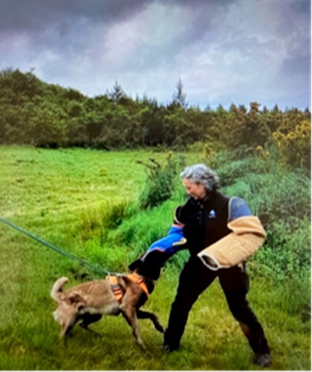
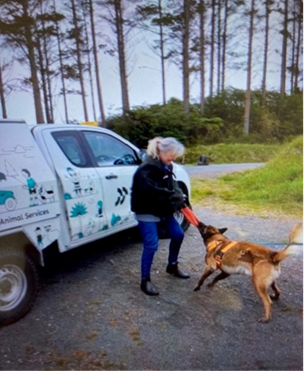
152. The job isn’t all about dogs and the
team ended up having to remove two pigs from a property in Gate Pa. Pigs are
not allowed to be kept within the city boundary and in addition, the
environment the pigs were being kept in was poor. After several complaints,
staff managed to convince the owner to hand the pigs over – failure to do
so would have led to infringements from the SPCA and we would have had to
execute a search warrant and seize the animals. Each pig weighed in
around 90 kg, and it was a full team effort to move them.

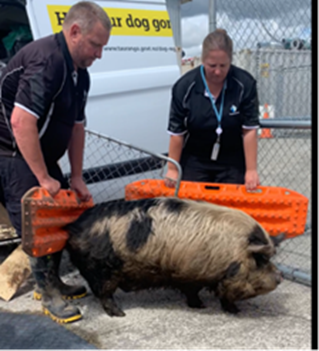
Parking and Bylaws
153. During October Council received 172
parking requests for service and 48 for Bylaw compliance matters.
154. Council’s application to MBIE for
the Freedom Camping Transition Fund has been approved. Funding of $25,000 for
additional educational patrols and a communications strategy is available to
council this summer season.
155. Infringements to date are set-out below.
|
|
1 – 31 October
|
YTD
|
|
Bus Lanes
|
719
|
5240
|
|
Parking
|
4789
|
18766
|
|
Freedom Camping
|
56
|
134
|
Key
Account Management
156. Our Key Account Management function
continues to support the delivery of excellent regulatory outcomes (primarily
operating across the Environmental Planning and Building Services teams, while
working closely with Infrastructure), providing a single point of contact for
engagement and communication with applicants and their teams.
157. Key projects/customers include the Civic
Precinct redevelopment, The Strand, Memorial Park, 2 Devonport Road, 90
Devonport Road, Haumoana private hospital, Northern Quarter, Ministry of
Education, Fosters Construction, Wolfbrook Residential Limited, Ministry of
Justice, Group Home Builders, Spaces and Places capital project delivery, Mike
Greer Homes, Pukaingaturu B18 Trust, Pitau Street project, Kainga Ora for
Fernciffe Farm, Barrett Homes, Northern Quarter and Classic Developments. We
continue to receive strong interest in this service and continue to grow our
portfolio of customers in this area.
City Development
City
Partnerships
158. The Trust Deed for the new Te Papa
Community Amenities Charitable Trust has been finalised and we’re close
to appointing trustees. This will be used as a vehicle to fundraise for Te
Manawataki o Te Papa - Civic Precinct development initially, and then move on
to fundraising for other important community amenity projects.
159. We have applied for $7.5 million of
funding for the Local Government Flood Resilience Co-Investment Fund for the
two landslides at Egret Avenue. A decision is due at the end of November.
160. A grant of $35,000 from The Lion
Foundation has been confirmed for the Destination Skatepark Zones 3 & 4
project. A total of $4,908,217 of external funding has been granted in the last
12 months to Spaces and Places projects – see below.
|
Project
|
Funder
|
Amount
|
|
Destination skatepark zones 1 & 2
|
TECT
|
$1,023,000
|
|
Destination skatepark zones 1 & 2
|
Lotteries
|
$528,847
|
|
Destination skatepark zones 1 & 2
|
NZCT
|
$459,370
|
|
Destination skatepark zones 1 & 2
|
Project Tauranga
|
$200k
|
|
Destination skatepark zones 3 & 4
|
Grassroots Trust
|
$250k
|
|
Destination skatepark zones 3 & 4
|
The Lion Foundation
|
$35k
|
|
Destination skatepark zones 3 & 4
|
NZCT
|
$200k
|
|
Marine Parade coastal pathway
|
MBIE Tourism Infrastructure Fund
|
$800k
|
|
Marine Parade coastal pathway
|
Port of Tauranga
|
$162k
|
|
Mauao viewing platform
|
Port of Tauranga
|
$150k
|
|
Merivale Community Centre (grant transfer)
|
TECT
|
$300k
|
|
Merivale Community Centre (grant transfer)
|
Lottery
|
$500k
|
|
Merivale Community Centre (grant
transfer)
|
BayTrust
|
$300k
|
161. Staff have undertaken a review of the
Enduring Statement of Expectations (ESE), the overarching governance document
which outlines the general governance principles and ongoing expectations of
our five substantive council-controlled organisation (CCO) boards, with a
revised ESE going to Council for approval on 27 November.
162. We hosted the six-monthly
Governance-to-Governance function with board members from four
council-controlled organisations and representatives from TCC and WBOPDC.
163. Te Manawataki o Te Papa Charitable Trust
held its Annual General Meeting, where trustees received copies of the Annual
Report and financial statements.
164. The City Partnership Specialist (Economic
Development) continues to work closely with Priority One and the University of
Waikato. The Tauranga campus has seen a 22% increase in 2024 domestic
applications, compared to the same date in 2023, with indicative growth across
Health, Engineering, Computing Management, Māori and Indigenous Studies,
and Law. Demand for student accommodation is also up, and seven additional
staff roles have been approved for 2024. With the support of TECT, the
University has secured additional properties in the precinct for future activation.
165. Education Tauranga reports that enquiries
and demand from international students in China, South Korea, India and Japan
are significantly higher, and the is translating to tangible study
applications.
166. The City Partnerships Specialist (Mainstreets)
is rolling out a summer activations programme, which includes Angus
Muir’s ‘Shapes of Summer’ lighting installations in the city
centre from late-December to late-January.
167. New Funding Agreements have gone out to
the four Mainstreet organisations for their signature, and all four Mainstreets
have recently held their AGMs.
168. The City Safety and Engagement Advisor has
been actively engaging with Mainstreets and their members on issues relating to
safety, as well as other projects. He has also been involved in internal
discussions relating to the civic response over the New Year period, providing
support, information and liaison between various parties. A profile on this new
role, and how well it has been received by the business community, was featured
in the Weekend Sun: https://www.theweekendsun.co.nz/the-weekend-sun.html.
Library
and Community Hub
169. Site enabling and demolition works have
commenced with construction scheduled to start in January.
170. The interior developed design package was
approved at the November Steering Group Meeting.
Civic
Whare / Exhibition Centre / Museum (CWEM)
171. The revised design programme is targeting
24 November to reach developed design, with 100% detailed design due by 30
May.
172. Facade value engineering has progressed,
with resulting design elements now being incorporated into the developed design
milestone package. Revised floor plans have been approved and floor layouts are
now frozen.
173. Early procurement and enabling works
packages are currently being developed for the project, to mitigate supply
chain risks.
Tauranga
Art Gallery
174. The seismic strengthening design has
concluded and is being integrated into the detailed design package, in
consultation with construction partners LT McGuinness.
175. The detailed designs, cost estimates, and
programme will be finalised with the Tauranga Art Gallery Trust (TAGT) prior to
signing the construction contract.
The
Strand Reserve
176. The Strand carpark is now fully closed to
the public. Construction materials, including 300 tonnes of rock armour, has
been delivered to site. The removal of street furniture and the dewatering tank
has been completed for the construction of the northern seawall. The
construction of the seawall, and installation of the living seawall pods, is
underway.
177. The Waterfront playground is currently in
the developed design phase, with 100% design due to be completed by the end of
January.
|
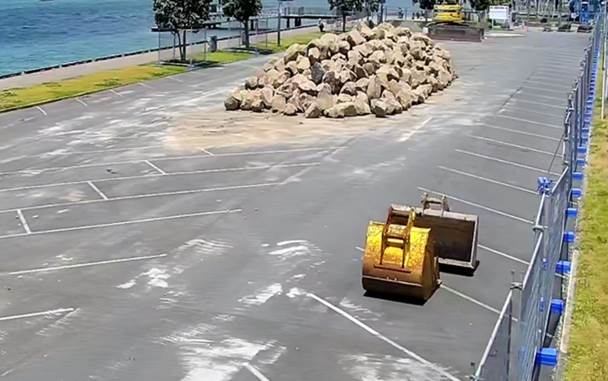
|

|
|
300T of rock armour delivered on site for
Northern Seawall Construction to commence.
|
Northern Seawall site cleared.
|
Te
Hononga ki Te Awanui (Harbour Link) Stage 1: Boardwalk and
Underpass
178. A Karakia was held on 10 November, with
site establishment commencing on 13 November.
179. Demolition of the existing boardwalk has
commenced, along with construction of the temporary causeway.
180. Building consent and Environmental
Construction Management Plan approval has been received. A revised programme
has been approved with a completion date in Quarter 3 2024.
|

|
|
Demolition of existing Boardwalk and
construction of a temporary causeway to enable demolition and construction.
|
Masonic
Park
181. Site works have now commenced and
engagement is ongoing to coordinate physical works with nearby hospitality
businesses and the Tauranga Art Gallery.
182. The initial PowerCo design for relocation
of the power transformer has been received. NorthPower will be engaged by
PowerCo to provide a programme of works.
183. Issued for Construction drawings have been
received and approved and all building consent RFI’s have now been closed
out.
|

|
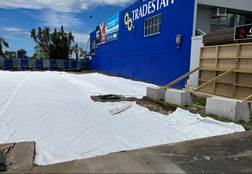
|
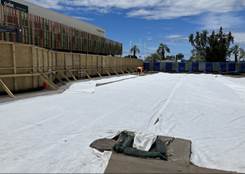
|
|
Masonic Park
construction site covered to reduce dust after excavation works.
|
Dive
Crescent Carpark
184. The stormwater infrastructure installation
and repaving along Dive Crescent has now been completed, as has the keystone
wall and security fencing along the railway corridor.
185. Project completion is still on schedule
for mid- to late-December.
|
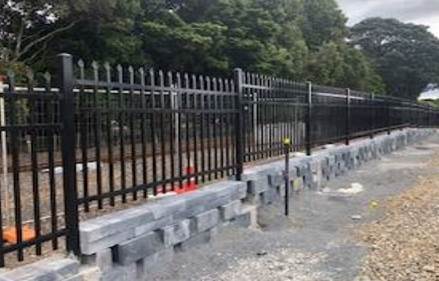
|
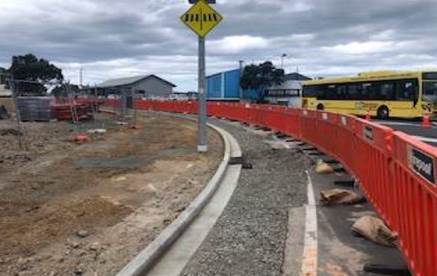
|
|
Keystone wall and railway corridor security
fencing.
|
Kerbing and footpath excavation.
|
Beacon
Wharf
186. 100% detailed design for the Beacon Wharf
seawall has been completed.
187. Blue sponge has been relocated in
preparation for the works, and rock armour for the seawall has been delivered
to site.
188. A contaminated land survey has been
completed, along with the sediment and erosion control plans.
|
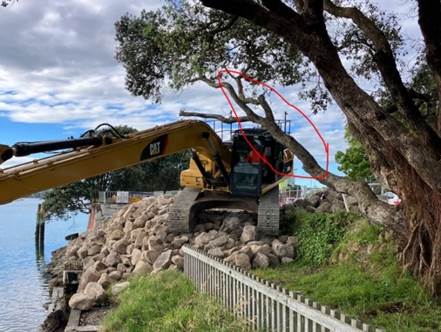
|
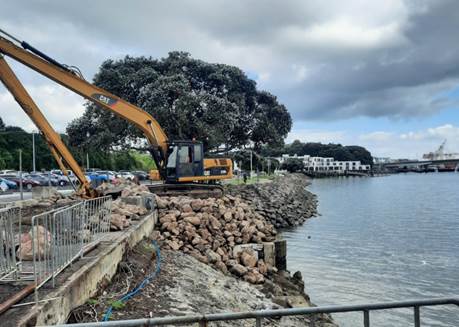
|
|
Long Reach digger manoeuvering to avoid
pohutukawa.
|
Seawall construction.
|
90
Devonport Road (Civic Administration Building Fit Out)
189. The Level 3 floor was completed in
early-November. Steel stud framing has been approved and ordered and the
fit-out consent has been lodged.
190. The first of the façade glazing and
cultural art panels have been installed.
|

|

|
|
Fabricated façade art panel.
|
Render showing façade art panels.
|
Elizabeth Street
East/Tunks Reserve
191. Construction of the new stairway has been
completed and the civil works and footpath construction is now 95%
complete.
192. Bush hammering works on the northern
footpaths has commenced and the drinking water fountain has been
installed.
193. Project completion is still on schedule
for late-December.
|
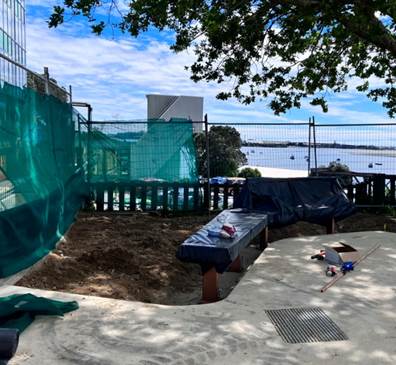
|
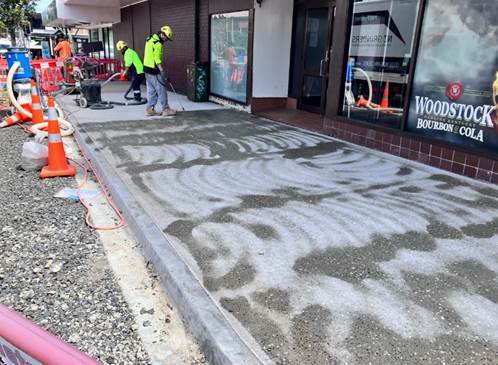
|
|
Furniture installed at one of the lookout
areas.
|
Bush hammering works progressing on the
footpath.
|
|
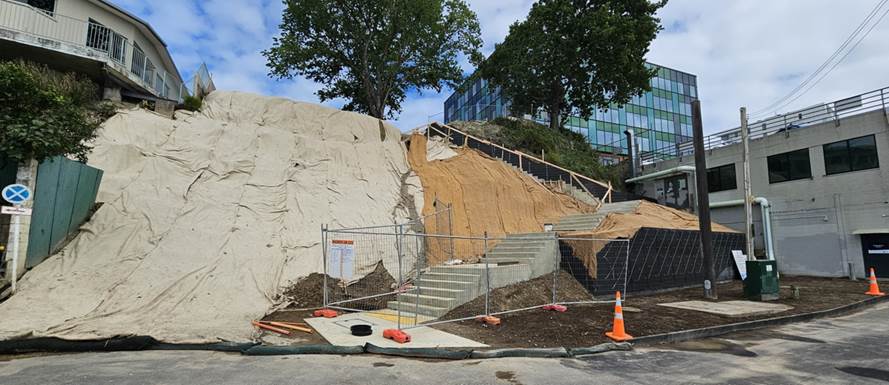
|
|
Banks prepared for planting.
|
Memorial Park Recreation Hub
194. Options for the design and delivery of a
new aquatics facility are scheduled to be presented to Council on 11
December.
195. The preliminary investigations for
locating the four indoor courts are currently in progress, with the preferred
option to be presented to Council on 11 December.
160-176
Devonport Road Carpark
196. Demolition is well underway and scheduled
for completion pre-Christmas.
197. A three-month Civil Works contract to
establish the car park is due to commence in January, including the relocation
of the Masonic Park bus shelter and Midnight Sun artwork.
City
Development
198. Work is currently underway to make small
improvements to the streetscape area on Grey Steet outside the entrance to He
Puna Manawa. The works include the replacement of the maintenance-intensive
Queen Palms, and removal of the cracked walls and raised planters. Works are
expected to be completed in the first week of December and will inform a future
extension of the streetscape improvements to Grey Street.
199. A masterplan of Red Square public realm
and art improvements is being prepared and an activation plan has been
announced for the Square over the summer months. Red Square will be a key
public space for the city centre while Te Manawataki o Te Papa, Masonic Park,
and the Waterfront are under development.
200. Council staff from across the organisation
came together recently to form the ‘city centre taskforce’, in an
effort to develop a coordinated approach to minimising disruption and
maximising efficiencies across the city centre. This place-based approach to
collaboration across the organisation, brought together capital delivery
activities with asset renewals, operational activities and commercial
developments, to ensure we build and retain social licence with our community
through this significant regeneration programme.
201. An accessibility audit has been completed
for the city centre and alongside the transportation team, we’re moving
to implement quick wins which will make immediate improvements to our city
centre streets and public spaces.
Brand
Tauranga
202. Work continues on the development of a
destination marketing brand for Tauranga and the sub-region. A newly formed
governance group has met twice and is working to deliver this new brand in the
first half of 2024. Further updates will be provided early in the New
Year.
City
Centre Parking Data
203. October city centre parking data is shown
below. The first two graphs outline occupancy rates in the Elizabeth Street and
Spring Street parking buildings per hour, showing that there is significant
parking availability in both buildings from late afternoon. The second table
also illustrates that the Spring Street parking building has lower occupancy
rates, as people get used to it being fully open again – increased
communications will help to raise awareness.
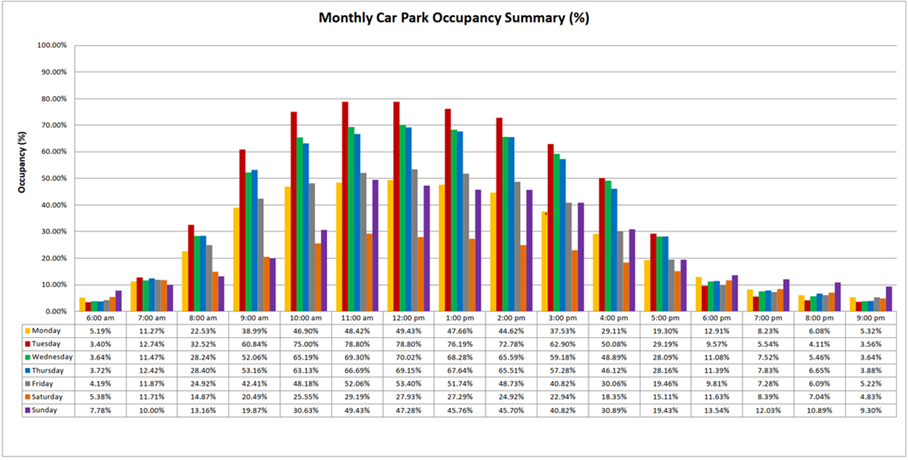
Elizabeth Street
parking building – October occupancy rates above
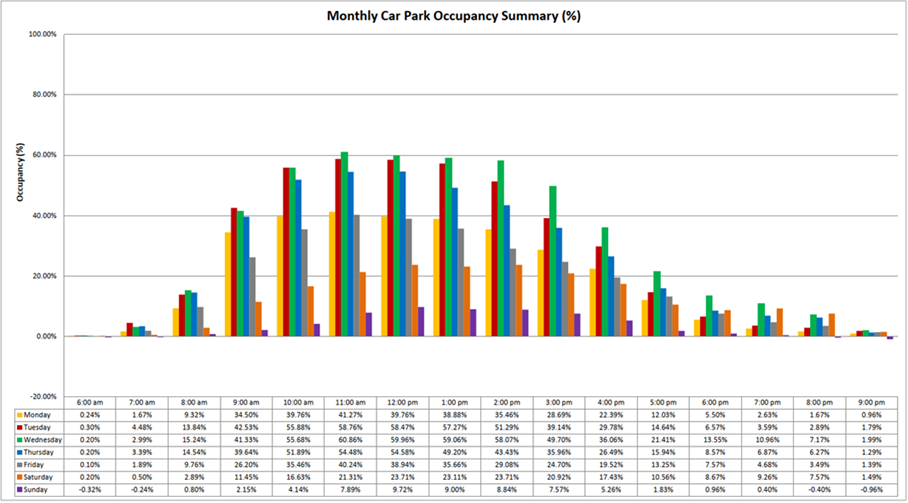 Spring Street parking building – October
occupancy rates above
Spring Street parking building – October
occupancy rates above
204. The table below shows how people paid for
on-street parking in October, with credit card at pay machines being the
preferred way to pay. App usage remains high with commuter parkers, so
encouraging lunch-time (short-term) parkers to use the app will help the ease
of parking.
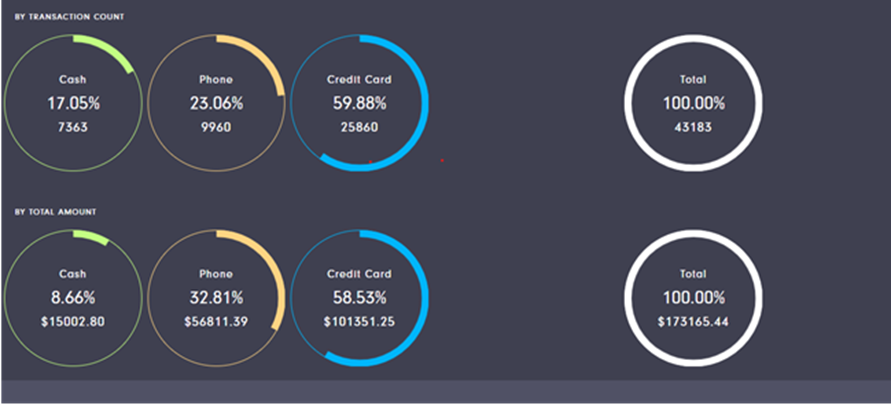
Communications
and Engagement
205. November saw the continuation of the
“It’s On” campaign to continue to raise awareness of
what’s happening in the city centre, help people understand the
‘why’ behind the disruption, and send people to our dedicated web
pages (www.tauranga.govt.nz/ourfuturecitycentre)
for more information. This communications activity included a media release, as well as radio and billboard advertising
(as below).
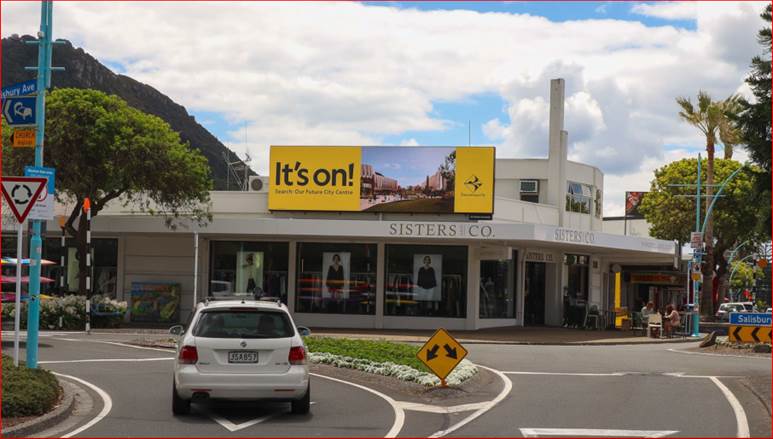
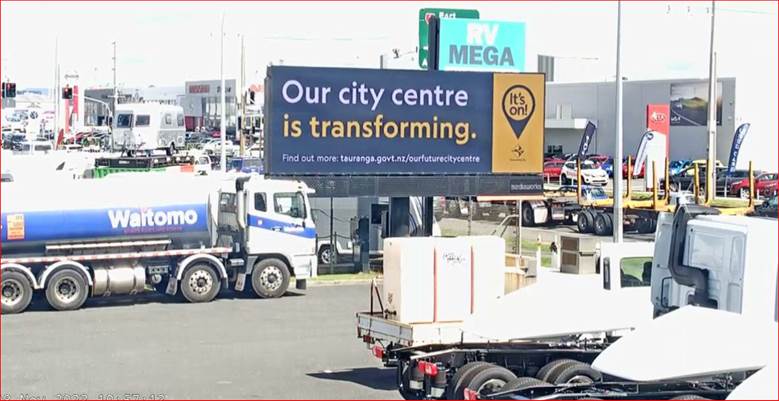
206. With a number of key waterfront projects
now in full swing, our continued focus is to share the story of transformation
and share progress with the community as it happens, so they can visualise how
the area will come to life over the coming year. This has included stories
related to the ‘living seawall’ (click for the media release, with artist impression below), construction
of the boardwalk, and the Beacon Wharf upgrade, with more to come.
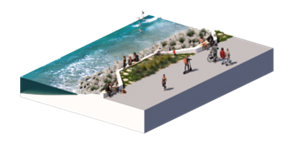
207. A key project in development is the
collection of data to track the impact that the city centre transformation is
having in a variety of ways. This involves measuring aspects like
spend/transactions, foot traffic, parking, transport modes, building consents
and environmental impacts.
208. The ‘Summer in our city
centre’ initiative has kicked off for another year, offering a series of
free, family-friendly events to encourage people to visit the area. The events
page on the My Tauranga website is pictured below. To raise
awareness and encourage people to join in the fun, a marketing and
communications campaign is being rolled-out, which includes billboard, radio,
print, bus back, digital ads, posters and social promotion.
Events
on offer include free outdoor cinema nights, sunrise pilates, lunchtime yoga,
live music, markets, family fun and more. The annual ‘Tauranga Moana
Bomb Comp’ is also back by popular demand and will take place at the main
wharf on the waterfront on Saturday, 16 December.
Events
held so far have been well attended by the community.
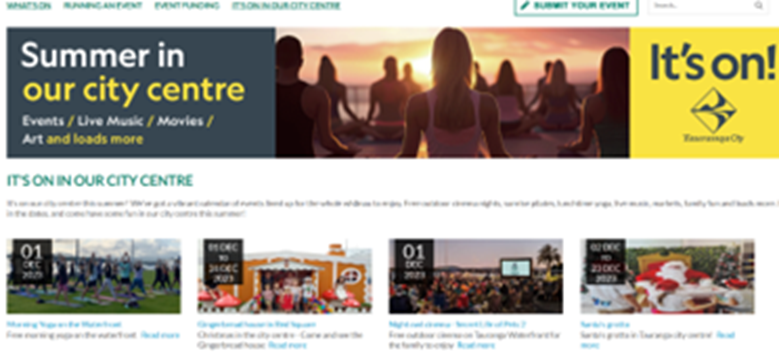
209. Proactive face-to-face engagement with
impacted local businesses continues, with the main topics discussed including
the upgrades to Elizabeth Street/Tunks Reserve, upgrades at Masonic Park,
closure of The Strand carpark, and what disruption to expect during
pre-construction works at Te Manawataki o Te Papa between now and the end of
the year. An ‘It’s On’ brochure was also distributed to
stakeholders to share with customers. A ‘City Partners’ stakeholder
event was held on 27 November to provide some of our key stakeholders with a
broad update on the work taking place in the city centre.
Attachments
1. Key
Events - December to March - A15335124 ⇩ 
|
Ordinary
Council meeting Agenda
|
11
December 2023
|
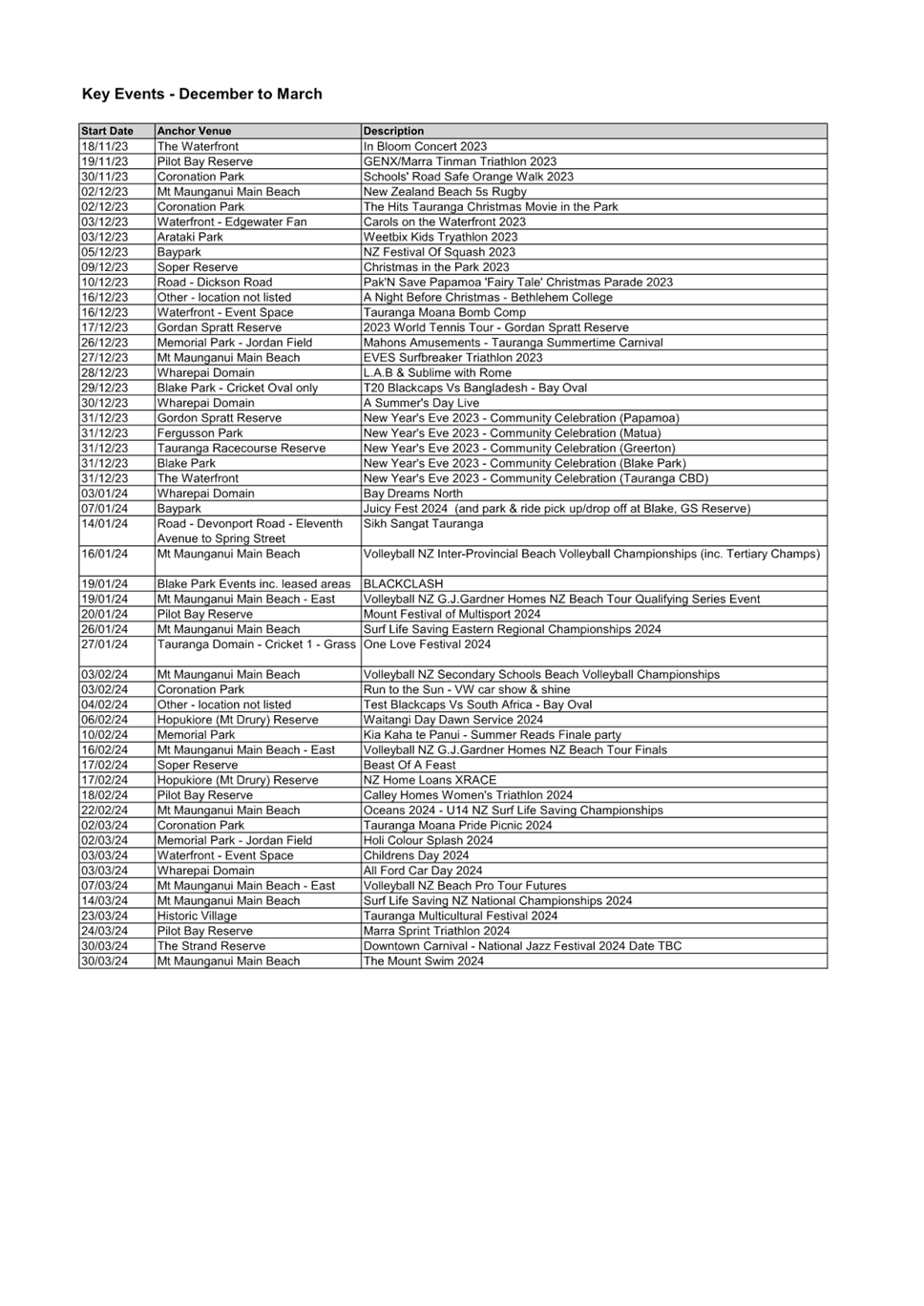
|
Ordinary
Council meeting Agenda
|
11
December 2023
|
11.10 Te
Manawataki o Te Papa Ltd - Letter of Expectation for 2024-25
File
Number: A15362085
Author: Sanjana
France, CCO Specialist
Authoriser: Gareth
Wallis, General Manager: City Development & Partnerships
Purpose of the Report
1. The purpose of this report is
to confirm the Letter of Expectation for 2024-25 from Tauranga City Council to
one of its council-controlled organisations, Te Manawataki o Te Papa Limited.
|
Recommendations
That the Council:
(a) Receives the report "Te
Manawataki o Te Papa Ltd - Letter of Expectation for 2024-25".
(b) Approves
the Letter of Expectation from Tauranga City Council to Te
Manawataki o Te Papa Ltd (Attachment 1).
|
Executive Summary
2. A Letter of
Expectation for Tauranga City Council’s (TCC) newest council-controlled
organisation, Te Manawataki o Te Papa Limited (TMOTPL)
is attached for Council’s approval.
3. Letters of
Expectation for three council-controlled organisations, Bay Venues Limited,
Tauranga Art Gallery Trust and Tourism Bay of Plenty, were approved previously
by Council on 3 November 2023.
4. These letters
provide guidance to the council-controlled organisations on what Council
expects to see in their Statements of Intent for 2024-25 to 2026-27.
Background
Legislative
requirements for council-controlled organisations
5. Part
5 of the Local Government Act 2002 sets out the statutory regime for council-controlled
organisations. The key components are:
· appointment
of directors/trustees;
· consideration
of the draft statement of intent and providing comment;
· regularly
monitoring council-controlled organisation’s performance; and
· including
the council-controlled organisation’s objectives and performance in the
council’s long-term plan, annual plan, and annual report.
6. Under the Local
Government Act legislative framework, Council has minimal opportunity for input
into a council-controlled organisation’s planning for the following year,
until the draft Statement of Intent has been completed and submitted to
Council, at which point Council has two months to respond.
7. Several councils
take a more proactive approach, working collaboratively with their council-controlled
organisations and providing them with clear guidance at the early stages of the
annual planning process. This helps ensure that the council-controlled
organisation’s objectives and strategies are aligned with the councils,
and is particularly important when council-controlled organisations deliver
significant services on its behalf.
8.
9. Since 2014, TCC has
worked proactively with its council-controlled organisations to set clear
expectations and to develop expectation documents, in particular, the
over-arching Enduring Statement of Expectations and the annual Letter of
Expectations. The Letter of Expectations outlines key areas of focus for the council-controlled
organisations for the following year, usually linked to strategic priorities
for the city.
10. This process has been focused
for those substantive council-controlled organisations that TCC has significant
control over i.e., Bay Venues, TAGT, TBOP (joint shareholder with Western Bay
of Plenty District Council), and TMOTPL. An Office of the Auditor General
Report in 2015 cited this process as an exemplar of best practice when dealing
with and managing council-controlled organisations.
Letter
of Expectations for 2024-2025
11. The Letter of
Expectations for TMOTPL has been socialised with the Commission and the
council-controlled organisation and is provided as an attachment to this
report.
12. The Review of Strategic and Operational
Alignment of TCC with its council-controlled organisations (Pedersen, February
2020) recommended that:
“Pending the development of new strategies, and to the extent
that is possible, annual letters of expectation of the council-controlled
organisations specify desired outcomes rather than outputs or tasks.”
13. Given that a new elected council is planned to take office in
late-July 2024, Council wishes to provide them and our council-controlled
organisations with clear intentions and pathways which deliver on priority
community outcomes. In the Commission’s remaining months at Council, they
have a mandate to focus on delivery and finishing
projects that have started, which will be reflected in the Long-term Plan 2024-34. Therefore, this year’s Letters of Expectation link to the six key priorities for the
next ten years and beyond, which continue to reflect what we have heard through
community consultation processes.
14. In consideration of the
upcoming local government elections in July 2024, the timeframes have been
brought forward for the Statements of Intent 2024-25 to 2026-27. Council has
requested the drafts are provided by 19 January 2024 and the final versions by
30 April 2024, rather than the standard legislative timeframes of 1 March and
30 June respectively.
15. This Letter of Expectations
also links to the Our
Direction framework and Council’s community outcomes, which are relevant to the areas of service that the
council-controlled organisations deliver on behalf of council.
16. TMOTPL’s
sub-programmes and critical governance role in overseeing the delivery of civic
precinct development projects is discussed in the Letter of Expectation, and
their key partnership position is further encouraged.
17. One of six strategic priorities
for Council is to drive delivery of the City Centre Masterplan –Te
Manawataki o Te Papa, the broader City Centre Action and Investment Plan, and
the Te Papa Peninsula Spatial Plan to revitalise and reactivate the heart of
the city. Te Manawataki o Te Papa seeks to establish Tauranga’s city
centre as the commercial, civic and cultural heart of the Western Bay of Plenty
sub region. This Letter of Expectations highlights TMOTPL’s important
role and their core projects which are central to delivering this transformation.
18. This
year’s Letter of Expectations encourages accountability and transparency
in decision-making, increased diversity and accessibility, efficient use of
public funds, tangata whenua partnerships, and managing the balance between
social, economic, cultural and environmental wellbeing of our communities.
19. Council
expects that the strategic priorities contained in this Letter of Expectations
will be reflected by the TMOTPL Board in their Statement of Intent. These
should be supported by a realistic number of performance indicator measures
where appropriate, which should help tell the story of the ongoing value back
to Council and the community.
Strategic / Statutory Context
20. While not a legislative
requirement under the Local Government Act (2002), when combined with the
Enduring Statement of Expectations, the Letter of Expectation is a key document
through which Council provides clear guidance to its council-controlled organisations.
21. The
Letters of Expectation help ensure that the council-controlled
organisation’s objectives and strategies are aligned with
Council’s, by providing key areas of focus that Council expects to see
reflected in the council-controlled organisations’ Statements of
Intent.
Options Analysis
Option 1: Approve the Letters of Expectation – RECOMMENDED
22. Council approves the Letter of Expectations
for TMOTPL.
|
Advantages
|
Disadvantages
|
|
· Council-controlled
organisations are part of the TCC group and are expected to operate in ways
which contribute to the success of the group as a whole.
· The
community outcomes that are delivered by services provided from the
council-controlled organisations assist Council to achieve the community
outcomes and four wellbeings prioritised through the Long-term Plan.
|
· Nil
|
Option 2: Do not approve the Letters of
Expectation – NOT RECOMMENDED
23. Council does not approve the Letters of
Expectation for the council-controlled organisations.
|
Advantages
|
Disadvantages
|
|
· Nil
|
· Council may not be able to achieve its Long-term Plan community
outcomes.
· Lack of strategic direction, leading to a potential negative
impact on Council’s relationship with its TMOTPL.
|
Financial Considerations
24. There are no financial
considerations.
Legal Implications / Risks
25. There are no legal implications
or risks.
Consultation / Engagement
26. Community consultation or
engagement is not required or appropriate for this matter.
Significance
27. The Local Government Act 2002
requires an assessment of the significance of matters, issues, proposals and
decisions in this report against Council’s Significance and Engagement
Policy. Council acknowledges that in some instances a matter, issue,
proposal or decision may have a high degree of importance to individuals,
groups, or agencies affected by the report.
28. In making this assessment,
consideration has been given to the likely impact, and likely consequences for:
(a) the current and future social,
economic, environmental, or cultural well-being of the district or region;
(b) any
persons who are likely to be particularly affected by, or interested in, the
matter; and
(c) the capacity of the local authority to
perform its role, and the financial and other costs of doing so.
29. In accordance with the
considerations above, criteria and thresholds in the policy, it is considered
that the matter is of medium significance.
ENGAGEMENT
30. Taking into consideration the
above assessment, that the matter is of medium significance, officers are of
the opinion that no further engagement is required prior to Council making a
decision.
Click
here to view the TCC
Significance and Engagement Policy
Next Steps
31. Once adopted, the Letters of
Expectation will be incorporated into an official letter to each
council-controlled organisation, signed by the Commission Chair and delivered
to the Chair of each council-controlled organisation by email.
32. The Letters of Expectation are
intended to inform the council-controlled organisations’ draft Statements
of Intent, which are due to Council on the earlier than usual date of 19
January 2024.
33. Council will then provide
feedback on the draft Statements of Intent to the council-controlled
organisations by the earlier than usual date of 1 March 2024. The final
Statements of Intent must be adopted by the council-controlled organisation
boards and submitted to Council by 30 April 2024. This date will enable the
Commission to approve the Statements of Intent before the end of their term.
Attachments
1. DRAFT
for approval - TMOTPL Letter of Expectations 2024-25 (A15221360) - A15371255 ⇩ 
|
Ordinary
Council meeting Agenda
|
11
December 2023
|
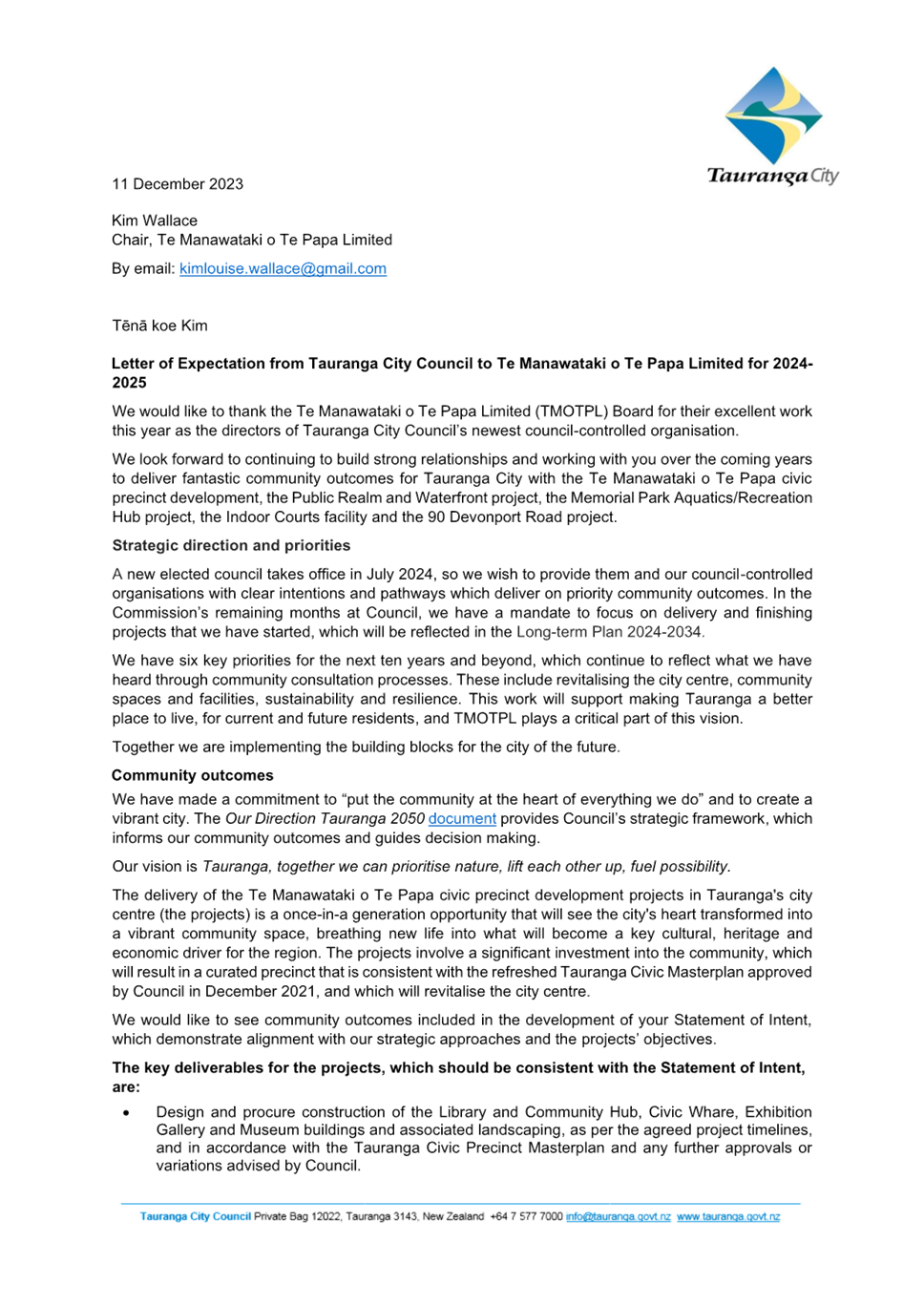

|
Ordinary
Council meeting Agenda
|
11
December 2023
|
11.11 Meetings
Schedule 2024
File
Number: A15294640
Author: Coral
Hair, Manager: Democracy and Governance Services
Authoriser: Christine
Jones, General Manager: Strategy, Growth & Governance
Purpose of the Report
1. This report recommends the adoption of a meetings schedule for the
first six months of 2024 until the Commission’s term of office concludes
after the 20 July 2024 election.
|
Recommendations
That the Council:
(a) Receives the report
"Meetings Schedule 2024".
(b) Adopts
Attachment 1 as the meetings schedule for the period January to July 2024.
|
Background
2. The Council may adopt a
schedule of meetings to cover any future period the Council considers
appropriate. It is recommended that the Council adopts a meetings schedule for
the period January to July 2024 as included in Attachment 1.
3. The schedule sets out a
three-weekly Council meeting cycle, with the Strategy, Finance and Risk
Committee meetings to be held six-weekly and as required. The other two
committees and advisory groups are held every two or three months.
4. Dates for joint committee
meetings are co-ordinated with the Bay of Plenty Regional Council, the Western
Bay of Plenty District Council and other councils in the Bay of Plenty. The
joint committee dates go beyond July 2024.
5. Dates
for hearings and deliberations on the Long-Term Plan 2024-34 have been included
in the meetings schedule.
|
Date
|
LTP Related Meeting
|
|
12-14 February 2024
|
Council – Hearing of
submissions
|
|
4-5 March 2024 d
|
Council – deliberations on
submissions
|
|
22 April 2024
|
Council - Adopt Long-Term Plan 2024-34
|
6. The
Local Government New Zealand Conference, Zone 2 and Metro meeting dates are
included in the schedule.
Strategic / Statutory Context
7. Clause
19(6) of Schedule 7 of the Local Government Act 2002 provides for the Council
to adopt a meeting schedule to cover any future period.
Options Analysis
Option 1 – Adopt the meetings
schedule for 2024 (preferred option)
8. The Council has the option of
adopting a meetings schedule for the period January-July 2024.
9. The incoming council will
adopt their governance structure and meetings schedule for the second half of
2024 when they take office following the elections on 20 July 2024.
10. This option enables the Commissioners,
external appointees, staff, media and the public to know when meetings are
scheduled for the term of the Commission.
11. While the Council has previously adopted
a year’s meetings schedule, the six-month period is required in these
circumstances. For these reasons this option is preferred.
Option
2 – Adopt a meetings schedule for a different time period
12. The Council has the option of adopting a
meetings schedule for a different time period; for example, 12 months.
13. This option would still provide for
certainty; however, the Commission cannot bind the incoming Council who will
adopting a meetings schedule when they come into office that reflects the
governance structure they adopt. Joint committee meetings will have been
set for the full year and these will be incorporated into the meetings schedule
for the second half of the year. For these reasons this option is not
preferred.
Financial Considerations
14. There are no
financial considerations to adopting a meetings schedule.
Legal Implications / Risks
15. The
legislation provides for the adoption of a schedule of meetings.
Significance
16. The Local Government Act 2002
requires an assessment of the significance of matters, issues, proposals and
decisions in this report against Council’s Significance and Engagement
Policy. Council acknowledges that in some instances a matter, issue,
proposal or decision may have a high degree of importance to individuals,
groups, or agencies affected by the report.
17. In making this assessment,
consideration has been given to the likely impact, and likely consequences for:
(a) the current
and future social, economic, environmental, or cultural well-being of the
district or region
(b) any persons who are likely to be
particularly affected by, or interested in, the decision.
(c) the capacity of the local authority to
perform its role, and the financial and other costs of doing so.
18. In accordance with the
considerations above, criteria and thresholds in the policy, it is considered
that the decision is of low significance.
ENGAGEMENT
19. Taking into consideration the
above assessment, that the decision is of low significance, officers are of the
opinion that no further engagement is required prior to Council making a
decision.
Next Steps
20. Meetings schedule to be available on the
Council’s website.
21. Calendar requests sent out.
Attachments
1. 2024
Planner - January - July Meeting Schedule - A15371032 ⇩ 
|
Ordinary
Council meeting Agenda
|
11
December 2023
|
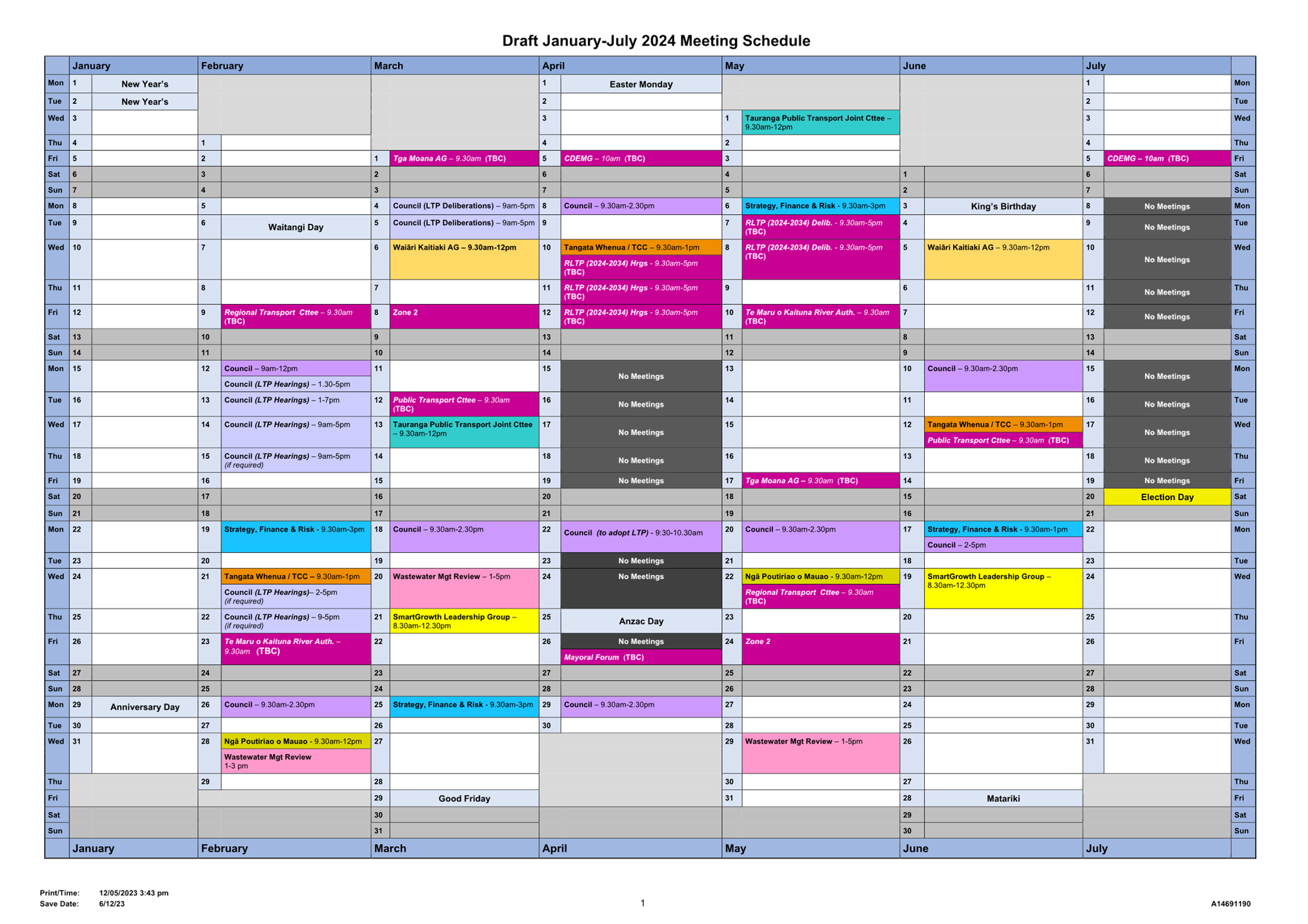
|
Ordinary
Council meeting Agenda
|
11
December 2023
|
11.12 Overview
Report - Memorial Park Recreation Hub Programme
File
Number: A15307703
Author: Mike
Naude, Director of Civic Developments
Authoriser: Marty
Grenfell, Chief Executive
Purpose of the Report
1. The purpose of this report is to
provide an overview of the suite of reports included on this agenda related to
the Memorial Park Recreation Hub Programme. This includes providing the
history, strategic context and information that is pertinent to all of the
reports, as well as an overview of how each report fits within the wider
programme of works. This report presents three options for the delivery of the
Memorial Park Recreation Hub, based on the findings of the individual reports.
Having considered all reports in the suite, this report provides
recommendations for the suite of decisions that will deliver the programme
budget.
|
Recommendations
That the Council:
a) Receives the report "Overview Report
- Memorial Park Recreation Hub Programme"; and
·
Either:
b) Approves option B as outlined in this
report, at a total programme cost of $150.85M, to include:
§ An
aquatics centre with leisure, toddler, programme, bombing pools, splash pad,
eight indoor lanes and two outdoor lanes (option 2) at a cost of $119.85M.
§ Indoor
courts at an alternative city-centre location with 4 courts at a cost of
$25M.
§ Upgrades
to the Memorial Park to enhance parking, access, recreation facilities for
young people and spaces for community gatherings at a cost of $6M.
·
Or:
c) Approves option C as outlined in this
report, at a total programme cost of $140.8M, to include:
§ An
aquatics centre with leisure, toddler, programme, bombing pools, splash pad,
two indoor lanes, eight outdoor lanes, and three hydro slides (option 3) at a
cost of $107.4M.
§ Indoor
courts at an alternative city-centre location with 4 courts at a cost of
$25M.
§ Upgrades
to the Memorial Park to enhance parking, access, recreation facilities for
young people and spaces for community gatherings at a cost of $6M.
d) Note that funding is available within the
current Long-term Plan 2021-31 budgets to accommodate option b or c of this
report; and
e) Note that any adjustments to future
funding requirements for active reserves will be addressed through the Executive
Report to the Long-term Plan 2024-34 deliberations.
|
BACkGROUND
2. Memorial
Park is a large recreational park in Tauranga’s central Te Papa Peninsula
and home to Memorial Pool, Queen Elizabeth Youth Centre/Memorial Hall
(referenced as QEYC) and a range of recreational amenities. Memorial Pool
is an outdoor pool built in 1958 which is coming to the end of its useful
life. QEYC is a well-used multi-court facility built in 1965 which is
coming to the end of its useful life. Both the pool and hall are managed by Bay
Venues Limited on behalf of the Council.
A
history of decisions to redevelop the Memorial Pool and Memorial Hall
3. A 2017
needs assessment undertaken on Memorial Pool (alongside Otumoetai Pool) found
there is a clear case for change, not only driven by the age, condition, use
and financial costs, but also recognising the modern requirements of an aquatic
facility to be fit for purpose and meet the needs of a diverse and growing
population. The needs assessment recommended undertaking a feasibility
study for a multi-purpose recreation and leisure facility in Tauranga
central/west catchment.
4. Budget was
included in Council’s Long-Term Plan (LTP) 2018-28 for Bay Venues to
redevelop Memorial Pool at a budget of $30M from 2022 to 2023.
5. In 2018,
Tauranga City Council and Bay Venues Ltd agreed to undertake a feasibility
study on a new multi-purpose aquatics/recreation hub in the CBD. In 2019,
Bay Venues Ltd commissioned Visitor Solutions, HDT Architecture and Boffa
Miskell to undertake a community facilities needs analysis and feasibility
study for a CBD recreation and leisure hub located on Memorial Park. This
feasibility study was completed early in 2020 and was due to be presented to
Tauranga City Council in March 2020 but was cancelled due to the March 2020
COVID-19 lockdown.
6. The
feasibility study identified significant demand for increased aquatic provision
in Tauranga, particularly indoor and leisure water. A key conclusion for the
feasibility study was Tauranga’s aquatic network has insufficient leisure
provision for the majority of aquatic users. This conclusion was based on the
2019 needs analysis which concluded that there is significant need to provide
more aquatic leisure in the network to cater for the largest group of aquatic
users and reduce pressure on Baywave.
7. The
feasibility study was based around a large-scale $95 million development
proposal which included indoor/outdoor aquatic facilities, indoor courts,
fitness centre, mini-golf and a spa/wellness centre.
8. Due to
Tauranga City Council’s financial constraints and large capital works
programme, Tauranga City Council and Bay Venues Ltd reviewed the CBD Recreation
and Leisure Hub feasibility study in late 2020.The revised feasibility study
and business case informed the development of budgets for the 2021-31 LTP.
9. The
Council’s Community Facilities Investment Plan 2021 identified the
Memorial Park Recreation Hub (replacement of Memorial Pool) and redevelopment
of the Memorial Hall (including provision of additional courts as part of the
Memorial Park Recreation Hub) as a priority for the 2021-31 LTP.
10. The Council consulted
with the community on the redevelopment of the Memorial Park pool ($49M) and
the redevelopment of the Memorial Park indoor sports facility ($54M) through
the LTP. The Council’s final 2021-31 LTP included projects to redevelop
the Memorial Park pool and indoor sports facility ($52M for the Aquatics Centre
and $48M for the indoor sports facility).
11. The Council has
developed a number of Action and Investment Plans over the last year which have
included the Memorial Park, Aquatic Centre and Recreation Hub as priority
actions.
12. The Council is
currently consulting on the draft LTP 2024-34. The draft LTP budgets include
the Memorial Park Aquatics, Recreation Hub and Park enhancements at a total
budget of $129.6M to be completed by the end of 2028.
13. A project team was
set up in June 2023 to deliver concept plans for the delivery of a new Memorial
Park Recreation Hub and a Memorial Park Spatial Plan. The initial scope of the
recreation hub included a new aquatic facility and indoor sports facility as
provided for in the 2021 LTP.
The
case for investment in the park, pool and indoor courts
14. The 2019/20
Feasibility Study recommended a redeveloped Memorial Pool should provide for
core functions of aquatic play and leisure (both indoor and outdoor), learn to
swim, therapy, fitness and some aspects of aquatic sport. Retaining outdoor
provision was identified as important to the aquatic network to support leisure
provision. The need for Indoor Courts was identified as part of the Recreation
Hub, with a strong need for more indoor courts across the city, to cater for
current demand and future population growth.
15. The feasibility study
identified a clear case for investment of aquatic and indoor court facilities
at Memorial Park:
|
Gap in aquatic leisure
|
There is a significant
gap in the provision of aquatic leisure to provide for the greatest proportion
of aquatic users. This should preferably be indoor all-year round,
supplemented by an outdoor leisure pool to replace the outdoor pools at
Memorial Pool.
|
|
Aging assets at the end
of useful life
|
Memorial Pool is over
70 years old and Memorial Hall is 65 years old. Both are at the end of their
useful life. Redevelopment is more economic compared to ongoing repair.
QEYC also has condition
issues with roofing, cladding and ventilation issues which need to be
addressed to secure the ongoing provision.
The current playground
is at the end of its useful life
|
|
Indoor court capacity
|
QEYC/Memorial Hall is a
well utilised indoor court facility which is vital to the network and cannot
be lost. In addition, Tauranga needs more indoor courts to cater for current
and future demand. Retaining the existing provision and any opportunity
to increase capacity should be considered.
|
|
Increased aquatic
provision
|
Tauranga needs more
indoor aquatic provision to cater for current and future demand.
Increasing aquatic capacity will relieve heavy pressure on neighbouring
Baywave and Greerton facilities, particularly if centrally located in
Tauranga’s CBD. Development of Memorial Pool as a citywide
facility is identified as the most important aquatic action in the 2019 Needs
Analysis.
|
|
Learn to swim and
hydrotherapy
|
Learn to swim and
hydrotherapy are important aquatic markets particularly recognising
Tauranga’s younger and older populations. These programmes also provide
opportunities for revenue generation.
|
|
Revenue generation
|
Opportunities to
improve the financial performance of community facilities should be
considered such as fitness centre or commercial leisure eg hydro slides.
|
|
Increased need for
recreational and social outdoor space
|
The Memorial Park will
become an even more highly valued space for casual recreation, social
gathering, and “being outside” as surrounding development is
intensified with less private outdoor space. The current visual quality does
not truly reflect the status of the park as a high-profile reserve or
reinforce the park’s historic purpose as a community focused gathering
place.
|
·
Governance Council Controlled
Organisation
16. The Council has
created a separate entity to govern the Te Manawataki o Te Papa project
delivery, Te Manawataki o Te Papa Limited (CCO). the Memorial Park Recreation
Hub programme is also governed by the CCO. In addition, the programme is
informed by the Civic Development Assurance Group. Early discussion has
included the establishment of a Steering Group, Design and Technical Reference
Groups to guide the project through the preliminary design stage. Actual
operational delivery is by way of resources either employed by or contracted to
Council. Council is the principal to all project development contracts with
suppliers and the employer of the project management team.
17. The Te Manawataki o
Te Papa Board have reviewed the suite of reports relating to this project. The
Board Chairperson will speak at the 11 December Council meeting to present the
views of the Board on the matters contained within the report. It is expected
that the Board Chairperson will table a short written paper on behalf of the
Board.
Overall Programme Options
18. The Memorial Park
Recreation Hub is a programme to redevelop the Memorial Hall, Memorial Pool and
Memorial Park to provide modern, fit for purpose recreation and sports
facilities to meet the needs of the Tauranga community, as part of the broader
network of facilities.
19. The project scope
envisaged a combined multi-sport and aquatic centre within Memorial Park.
However, initial scoping works identified that the cost of $175M was well
outside the project budget of $122M (excluding $8M Memorial Park upgrades).
20. Alternative options
have been investigated to deliver the Memorial Park Hub programme outcomes for
the community, but within the LTP budget.
21. The programme team
has looked to develop more affordable options for the aquatics facility, with a
focus on prioritising the greatest need in the city’s aquatic network. In
accordance with the needs analysis the priority for increased aquatic
facilities is in the recreational/leisure use, which currently represents approximately
20% of the network offering, and based on national benchmarks would be expected
to represent 60-70% of the network.
22. The programme team
has also considered alternative locations for both components of the programme;
the aquatic centre and the multi-sports centre (indoor courts). A high-level
analysis of alternative locations for the aquatic centre identified that
Memorial Park was still the preferred location for the aquatic centre. A viable
alternative venue for the indoor courts has been identified.
23. The individual
reports included on the agenda alongside this overview report outline various
options for Council to deliver on the programme, including the provision of
indoor courts at a different location from the aquatic centre.
24. A range of options
are outlined on the following page for Council consideration:
·
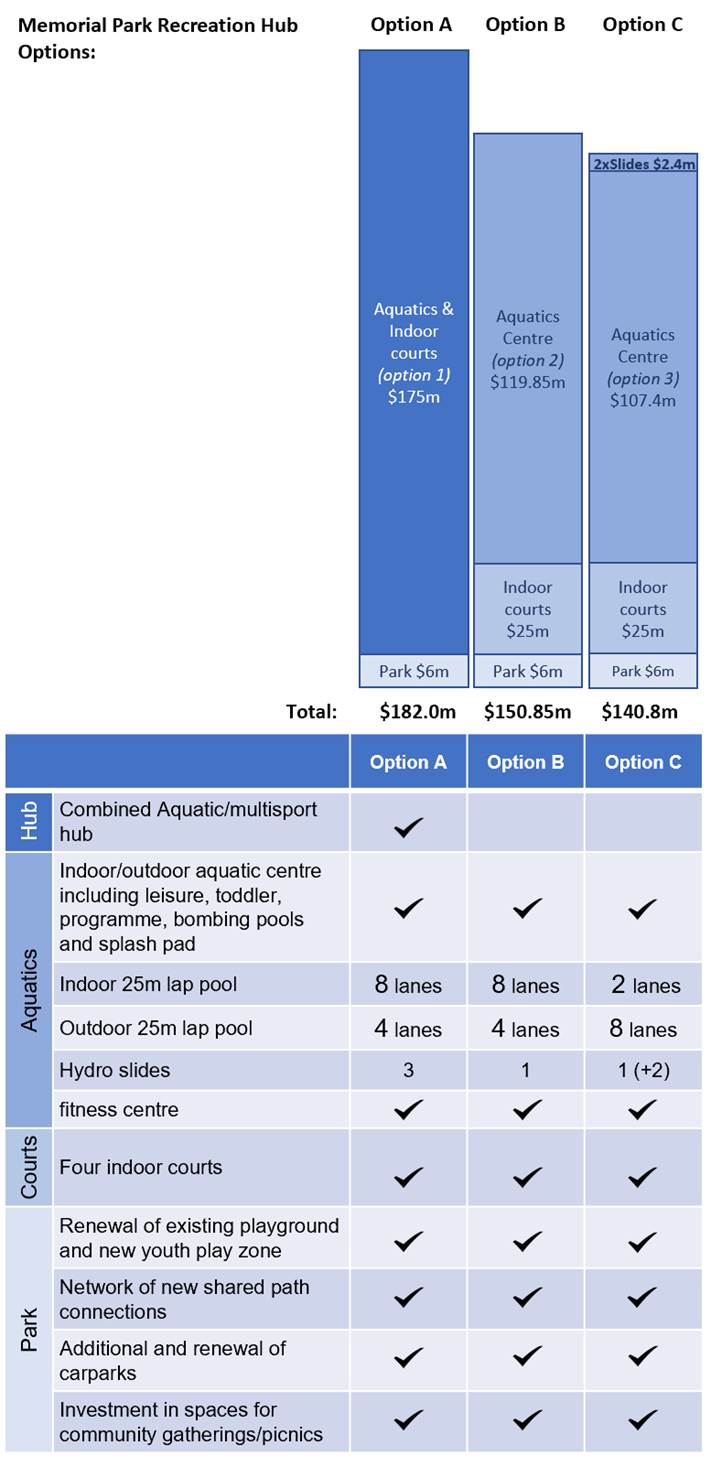
RELATED REPORTS ON COUNCIL
AGENDA 11 DECEMBER 2023
25. Based on the options
outlined above, there are a number of reports on this 11 December 2023 Council
agenda. These reports consider a range of matters which are directly, or
indirectly related to the Memorial Park Recreation Hub Programme.
26. Below is a summary of
the reports and the matters which they address:
|
Report Title
|
Purpose
|
|
Memorial Park
Recreation Hub – Aquatics Options Report
|
This report presents
the revised Memorial Park Recreation Hub concept design for approval. It
outlines three options for the Council to consider for the development of a
Memorial Park Recreation Hub, including retaining a Recreation Hub facility
in one venue that incorporates both aquatic and indoor court facilities, or
achieving the same level of services over two sites.
|
|
Approval of Memorial
Park Site Development Plan
|
This report presents
the Memorial Park Site Development Plan, including seeking confirmation to
progress the external landscaping upgrades proposed as part of the wider
Memorial Park to complement and facilitate the Aquatic Centre project.
|
|
Strategic Property
Purchase for Memorial Park Recreation Hub Project
|
Due to the nature of
this report it is being considered in public excluded. However, the purpose
of this report is to ensure the most cost-effective delivery of the Programme
objectives, specifically related to indoor court provision. This report
provides for the purchase of an alternative site for provision of indoor
court facilities.
|
|
Concept Design for
indoor courts
|
Due to the nature of
this report it is being considered in public excluded. However, the purpose
of this report is to ensure the most cost-effective delivery of the Programme
objectives, specifically related to indoor court provision. This report
considers the possible design of indoor court facilities at an alternative
location.
|
|
Procurement
Strategy
|
Due to the nature of
this report it is being considered in public excluded. The purpose of this
report is to ensure the most cost-effective delivery of the Programme
objectives by presenting options for the procurement of the Memorial Park
Recreation Hub Programme.
|
Strategic / Statutory Context
27. Council adopted a new
vision for Tauranga City Council in June 2022, and also endorsed it as a shared
Vision for Tauranga. The vision is based on three key themes clearly expressed
by our communities as being important for a future Tauranga – environment,
community and inclusivity, and vibrancy. These three themes form the basis of
the vision statement:
Tauranga, together we can
Prioritise nature
Tauranga is a city where… we celebrate, protect and
enhance our natural environment, integrating it into the city for all to enjoy
Lift each other up
Tauranga is a city where… we foster and grow our
communities, celebrate our differences, and lift up those who are vulnerable
Fuel possibility
Tauranga is a city where… we foster creativity and
innovation, celebrate our arts and culture, and empower our changemakers to
create a vibrant city into the future
With everyone playing their part, together we
can create the change our city needs.
Kei a tātou te pae tawhiti
The future is all of ours.
Because, Tauranga, together we can.
28. In August 2023, the
Council adopted the ‘Our Public Places Strategy’ with the ambition
of:
Together
we can have public places to play, relax, be inspired, and connect with people
and nature.
29. In August 2023, the
Council also adopted a Play, Active Recreation, and Sport Action and Investment
Plan, 2023-33 (AIP).
30. This AIP focuses on
the Our Public Places Strategic Plan objective of: Increasing participation by
providing easily accessible opportunities for organised and informal play, active
recreation, and sport for people of all ages, backgrounds, and abilities.
31. The AIP identified 5
actions related to the Memorial Park Recreation Hub:
|
Action No.
|
Actions and programmes of work
|
Proposed timeframes
|
Indicative cost[4]
|
Who
|
Priority
|
|
25.
|
Redevelopment of
Memorial Hall (QEYC) and provision of additional court as part of Memorial
Park Recreation Hub
|
Short Term
|
$$$$ LTP 2023- 2025
|
TCC, Bay Venues Ltd,
User Groups
|
Priority action
|
|
33.
|
Replacement of Memorial
Pool with Memorial Park Recreation Hub (indoor and outdoor pools).
|
Short Term
|
$$$$ LTP 2026- 2028
|
TCC
|
Priority action
|
|
7.
|
Memorial Park - reserve
development to consider interface of the park with the Memorial Park
Recreation Hub, including playground redevelopment and consideration of other
play and active recreation opportunities (including potential junior bike
skills path, skate park and hard courts)
|
Medium Term
|
$$$ LTP 2026- 2027
|
TCC
|
Priority action
|
|
38.
|
Replace destination
playground at Memorial Park when due for renewal through site master
planning. Refer Memorial Park Master Planning Action
|
Medium Term
|
$$$ LTP 2026- 2027
(cost is full reserve master plan)
|
TCC
|
Priority action
|
|
30.
|
Find alternative space
for displaced users from 3 courts while Memorial Hall is redevelopment and
Mount Sports Centre (e.g. school gyms, vacant industrial building, outdoor
courts)
|
Immediate – Short
Term
|
Part of wider project
budgets
|
TCC, Bay Venues, other
potential host sites
|
|
32. The Memorial Park
upgrade also aligns with Council’s Reserves and Open Space Action and
Investment Plan, which includes aspirations to increase participation by
providing easily accessible opportunities for organised and informal play for
people of all ages, backgrounds and abilities; and emphasise the green
environment, passive space and amenity functions of our reserves, as well as
the traditional play space.
Financial Considerations
33. The total programme
budget of $129.6M is included in the draft Long-Term Plan 2024-34. In addition,
the Long-term Plan includes budgets for various active reserves.
34. Option B outlined in
this report has a total programme cost of $150.85M. Option C outlined in this
report has a total programme cost of $140.8M
35. Both options outlined
in this report can be accommodated within existing Long-Term Plan 2021-31
budgets, and any additional adjustments required to the active reserves budget
in the 2024-34 Long-term Plan will be addressed through the Executive Report to
the Long-term Plan deliberations.
Legal Implications / Risks
36. The Council has been
undertaking work to redevelop the Memorial Hall and Pool for over five years,
and a decision to not proceed with this programme would have reputational risk.
37. The current
facilities are also reaching the end of their life and continuing to use the
facilities without redevelopment would still require substantial upgrades and
increasing maintenance costs.
38. The specific project
risks, including potential for cost escalation, are included within the individual
reports.
39. Relevant legal
considerations are addressed within each of the individual reports.
Consultation / Engagement
40. The Council has
undertaken previous engagement with the community to understand community
support for this project through the Long-Term Plans 2018-28 and 2021-31.
41. The projects have
garnered support from the community, including requests by users specifically
for more facilities, both to cater for increased numbers and a broader variety
of recreational activities.
42. Specific targeted
stakeholder and mana whenua engagement has occurred as part of the development
of each of the proposals and is ongoing. More detail is included in the
individual reports where relevant.
Significance
43. The Local Government
Act 2002 requires an assessment of the significance of matters, issues,
proposals and decisions in this report against Council’s Significance and
Engagement Policy. Council acknowledges that in some instances a matter, issue,
proposal or decision may have a high degree of importance to individuals,
groups, or agencies affected by the report.
44. In making this
assessment, consideration has been given to the likely impact, and likely
consequences for:
(a) the current
and future social, economic, environmental, or cultural well-being of the
district or region;
(b) any persons who are likely to be particularly
affected by, or interested in, the decision; and
(c) the capacity of the
local authority to perform its role, and the financial and other costs of doing
so.
45. In accordance with
the criteria and thresholds in the policy, the decision to build an Aquatic
Centre and indoor courts is a significant investment. However, the Council has
already made the decision to develop the Memorial Park Recreation Hub through
the LTP 2021-31. The proposals being considered through this suite of reports
has a strong and logical flow from the previous Council decision, but with some
notable variations to how the project is delivered. Therefore, in accordance
with the criteria and thresholds in the policy, it is considered that the
issues addressed in this suite of reports are of medium significance.
46. The individual
reports include a separate assessment of significance where relevant.
·
Attachments
Nil
|
Ordinary
Council meeting Agenda
|
11
December 2023
|
11.13 Memorial Park Recreation Hub - Aquatics Options Report
File
Number: A15201283
Author: Kelvin
Eden, Capital Programme Manager: Major Community Amenity
Mike Naude, Director
of Civic Developments
Authoriser: Marty
Grenfell, Chief Executive
Purpose of the Report
1. To present the
revised Memorial Park Recreation Hub concept designs for approval including
project costs and options regarding the final scope for delivery.
|
Recommendations
That the Council:
(a) Receives the report
"Memorial Park Recreation Hub - Aquatics Options Report".
(b) Approves aquatic centre
Option 2 of the attached Memorial Park Recreation Hub & Spatial Plan
document at a total cost of $119.85M to progress to preliminary design
including a revised costs estimate;
or
(c) Approves aquatic centre
Option 3 of the attached Memorial Park Recreation Hub & Spatial Plan
document at a total cost of $107.4M, plus two additional hydro slides at a
cost of $2.4M, to progress to preliminary design including a revised costs
estimate.
(d) Seeks a further report on
completion of the preliminary designs and cost estimates that will include an
update on findings from preconstruction investigations.
|
Executive Summary
2. Following
geotechnical reporting and seismic analysis of existing structures the Memorial
Park Recreation Hub project has been revised to comprise a new aquatic centre
on Memorial Park and an indoor court facility at an alternative location.
3. The attached
Memorial Park Recreation Hub & Spatial Plan document outlines the concept
designs and costings for the project options with analysis against the critical
success factors identified for the project.
4. Two options are
presented for an aquatic centre on Memorial Park with indoor court provision to
be provided at an alternative location.
5. The principal
difference between aquatic centre options 2 and 3 is the location of the
primary 25m lane pool within or outside the building. It is noted that Memorial
Pool to be demolished is the only outdoor lane swimming pool within the TCC
network.
6. Option 2 at $119.85M
has a larger building floor area with the 8 lane, 25m lane swimming pool inside
and a smaller 4 lane 25m outdoor lido pool. This will offer greater pool
capacity and options to structured aquatic activities at the site and within
the city network.
7. Option 3 at $107.4M
will provide an 8-lane outdoor pool and a 2 lane indoor 25m pool.
8. Option 3 includes
the addition of two extra hydro slides bringing the total to three hydro
slides. This comes at an estimated cost of $2.4M incorporated into option 3.
The business case analysis has identified a significant uplift in visits and
revenue from three slides at an additional 11,000-12,000 visits per year. This
will provide an enhanced range of visitor experiences and flow into increased café
and retail use.
9. Following concept
approval, the project team will progress to preliminary design and consenting.
This is expected to shift to developed design in mid-2024.
Background
10. The background to the Memorial
Park facilities, the case for change and history of decisions to redevelop the
Memorial Pool and Queen Elizabeth Youth Centre/Memorial Hall (referenced as
QEYC) are outlined in the Overview Report – Memorial Park Recreation Hub
Programme on this agenda.
11. The attached Memorial Park Recreation
Hub & Spatial Plan document outlines the project development, engagement
and options developed to meet the revised project scope. This will be
summarised in the section below.
concept Design & Cost
Document
12. Option 1 from the Memorial Park
Recreation Hub & Spatial Plan document provides for a 10,936m²
recreational hub including an indoor/outdoor aquatic centre, fitness centre and
four indoor courts. At an estimated cost of $175M this option sits well outside
the total project budget of $122M (excluding $8M for park upgrades). Site soil
conditions are a significant factor in this cost with the need for substantial
piled foundations identified through geotechnical reporting.
13. Through a re-examination of the
brief, the project team sought to substantially reduce the floor area through
the removal of the indoor courts and associated components. The provision of
indoor courts is being evaluated at an alternative location where a more viable
financial case can be found.
14. From a number of concepts, two
options have been progressed and are outlined in the attached document and
summarised below. Careful consideration has been taken to ensure these options
align well with the critical success factors developed within the Memorial Park
Recreation Hub Feasibility Study.
15. The needs analysis within the
Feasibility Study identified four significant conclusions on the type of
aquatic provision in Tauranga’s network being:
(a) There is a significant need to
provide more aquatic leisure in the network.
(b) Increase provision of
structured water space is required.
(c) More provision of programmable
pools, learn to swim and hydrotherapy are required.
(d) It is important to maintain
some outdoor aquatic provision within the citywide network.
16. Both options have similar sized
fitness centre (620-650m²), however Option 3 would more easily allow a
future extension.
17. Both options allow for the
warmer water (Programmes Pool, Learn to Swim Pool and shallow Leisure Pools) to
be located inside the building. The key difference in pool provision is the
location of the 25m lane pool being outside in option 3 where this pool is
inside in Option 2 with an additional 4-lane lido pool outside.
18. The projected year 1 visitor
admissions for the three options are detailed in the table below. Option 1
includes a significant sum for indoor court users and spectators. Under Options
2 and 3 these users will utilise an alternate option being considered for
indoor court provision.
|
1
|
2
Option 1
|
3
Option 2
|
4
Option 3
|
|
5
Pool Admissions
|
6
209,772
|
7
206,585
|
8
194,859
|
|
9
Hydro slide
tickets (not extra visits)
|
10
32,064 (3
slides)
|
11
21,962 (1 slide)
|
12
20,737 (1 slide)
|
|
13
Fitness Centre
|
14
148,750
|
15
73,625
|
16
80,750
|
|
17
Indoor Courts
|
18
280,176
|
19
-
|
20
-
|
|
21
Spectators
|
22
58,625
|
23
29,556
|
24
25,114
|
|
25
Total
|
26
697,323
|
27
309,765
|
28
300,724
|
19. Both options include an outdoor
splashpad, bombing pool, cafe and one hydro slide. Following the development of
these options the project team has recommended the addition of two hydro slides
at an estimated cost of $2.4M to option 3. The attached document outlines the
case for a substantial increase in visitation and revenue with this addition.
20. A key advantage of the Memorial
Park site is the availability of geothermal energy. The concept designs include
geothermal bore source heating and consideration of a potential 250kW solar PV
array targeting 10% on-site renewable energy generation. By comparison,
an air source heat pump option for the same facility is forecast to increase
energy use by 168%.
21. A sustainability framework has
been developed by Beca for the project. The design analysis has identified that
the concept designs may align with a 5 Star Greenstar rating with the inclusion
of bore heading and a solar array. The project team have identified this a key
consideration through the further design process. Further sustainability
measures are detailed in the attached document to be considered through the
design stages.
Options Analysis
Option 2
22.
|
Advantages
|
Disadvantages
|
|
· This option will provide a larger/deeper indoor pool
capacity with a similar pool offering to Option 3 all inside with the
addition of an outside lido pool.
· A larger indoor lane pool will provide more certain
year-round and all-weather use, enabling a greater capacity for structured
aquatic activities within the City.
· The larger pool provision provides more capacity in the
citywide provision and could supersede the Otumoetai Pool, saving significant
operating costs and need for future upgrade.
|
· At a cost of $119.85M, this option is more expensive than
option 3.
· Outdoor lane provision will be reduced from the current
Memorial Pool.
· The larger building area and café provision limits
the connection of the facility to the wider reserve within the identified
constraints.
|
Option 3 –
Recommended Option
23.
|
Advantages
|
Disadvantages
|
|
· At a cost of $109.8M (including two additional hydro
slides) this option is cheaper that option 2.
· The outdoor lane pool will increase the public outdoor
lane pool capacity within the City.
· The aquatic centre will achieve a greater connection to
the wider reserve with an outdoor focus and more central and visible
café available to facility and park users.
· The building design allows greater flexibility to expand
the fitness centre in the future.
|
· The predominantly outdoor lane swimming will reduce the
use seasonally and within certain weather.
· The outdoor focus may be a deterrent to some structured
aquatic activities such as water polo, underwater hockey and synchronised
swimming.
· The option will provide a lower capacity for structured
aquatic use with only two indoor 25m lanes.
|
Strategic / Statutory Context
24. Memorial Park is a high-profile
reserve under the Tauranga Reserves Management Plan 2019, classified as
Recreation Reserve under the Reserves Act 1977 and zoned Active Open Space
under the Tauranga City Plan.
25. Previous decision making has
outlined the condition of the facilities on the park and case for change within
our growing population. The provision of an enhanced aquatic and indoor court
facility within the central city has subsequently been included in the Play,
Active Recreation & Sport Action & Investment Plan 2023, the Community
Facilities Investment Plan 2021 and proposed 2024-34 Long Term Plan.
26. The options of this report seek
to achieve the outcomes sought in Council’s strategic framework through a
new aquatic facility on Memorial Park and provision of an indoor court facility
on a more suitable and financially viable location.
Financial Considerations
27. The design process has sought
to provide a facility that meets the design brief as informed by the strategic
planning and analysis done to date. The challenging ground conditions on
Memorial Park have required a revised approach to provide the necessary indoor
court and aquatic provision.
28. The financial impact of the
options presented within this report are listed below:
|
Budgets
|
Option 2
|
Option 3 (including 2 additional
hydro slides)
|
|
Proposed Budget
|
$119.85M
|
$109.8M
|
29. Option 3 is the most
financially viable option when considered as a standalone project. However,
when considered in the context of the city aquatic network, option 2 may enable
the retirement of Otumoetai Pool, removing the maintenance and upgrade costs of
a pool nearing the end of its useful life.
Legal Implications / Risks
30. The design team have analysed
the project risks in the attached document.
31. Key risks relate to the early
stage of the development, the poor ground conditions, funding and geothermal
capacity.
32. The project team has assessed
these risks and incorporated them into the design programme and cost
projections.
33. Preconstruction investigations,
including geotechnical report and geothermal bores, will provide greater
insight into risks and will be reported back to Council alongside preliminary
design.
Consultation / Engagement
34. Mana whenua have been engaged
as project design partners through a number of hui. The design team are
developing a cultural narrative framework alongside the spatial planning team
and mana whenua. The framework will develop a shared understanding of the
cultural design drivers underpinning both projects based on the Tauranga Moana
Design Principles.
35. Initial engagement has been
undertaken with reserve lease holders, user groups, and key aquatics and indoor
sport stakeholders. A user group forum will be established with Bay Venues
Limited leading the communication with these stakeholders. This forum will
inform design development and management of the reserve and users during
construction.
Significance
36. The Local Government Act 2002
requires an assessment of the significance of matters, issues, proposals and
decisions in this report against Council’s Significance and Engagement
Policy. Council acknowledges that in some instances a matter, issue,
proposal or decision may have a high degree of importance to individuals,
groups, or agencies affected by the report.
37. In making this assessment,
consideration has been given to the likely impact, and likely consequences for:
(a) the current
and future social, economic, environmental, or cultural well-being of the
district or region
(b) any persons who are likely to be
particularly affected by, or interested in, the decision.
(c) the capacity of the local authority to
perform its role, and the financial and other costs of doing so.
38. In accordance with the
considerations above, criteria and thresholds in the policy, it is considered
that the decision is of medium significance.
Next Steps
39. The attached document contains
a development programme summary.
40. The project team will progress
to preliminary design and consenting for the preferred option. This is expected
to shift to developed design in mid-2024.
41. Procurement of enabling,
demolition and pre-purchase works will be progressed.
42. The second stage of approval
will involve preliminary design and findings from preconstruction works
reported back to Council. This will provide greater certainty regarding project
risks.
Attachments
1. Memorial
Park Recreation Hub & Spatial Plan - A15349179 ⇩ 
|
Ordinary
Council meeting Agenda
|
11
December 2023
|
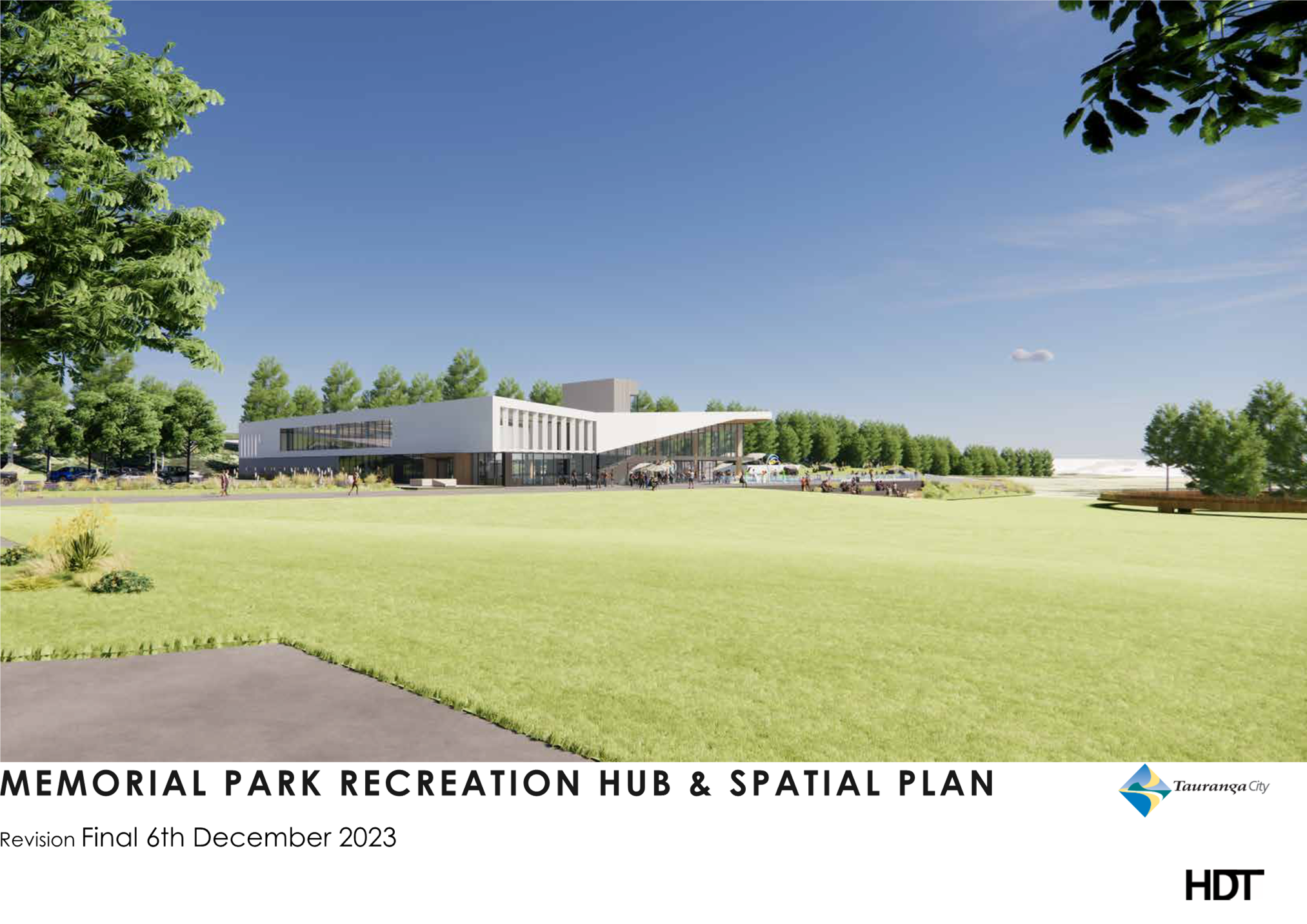
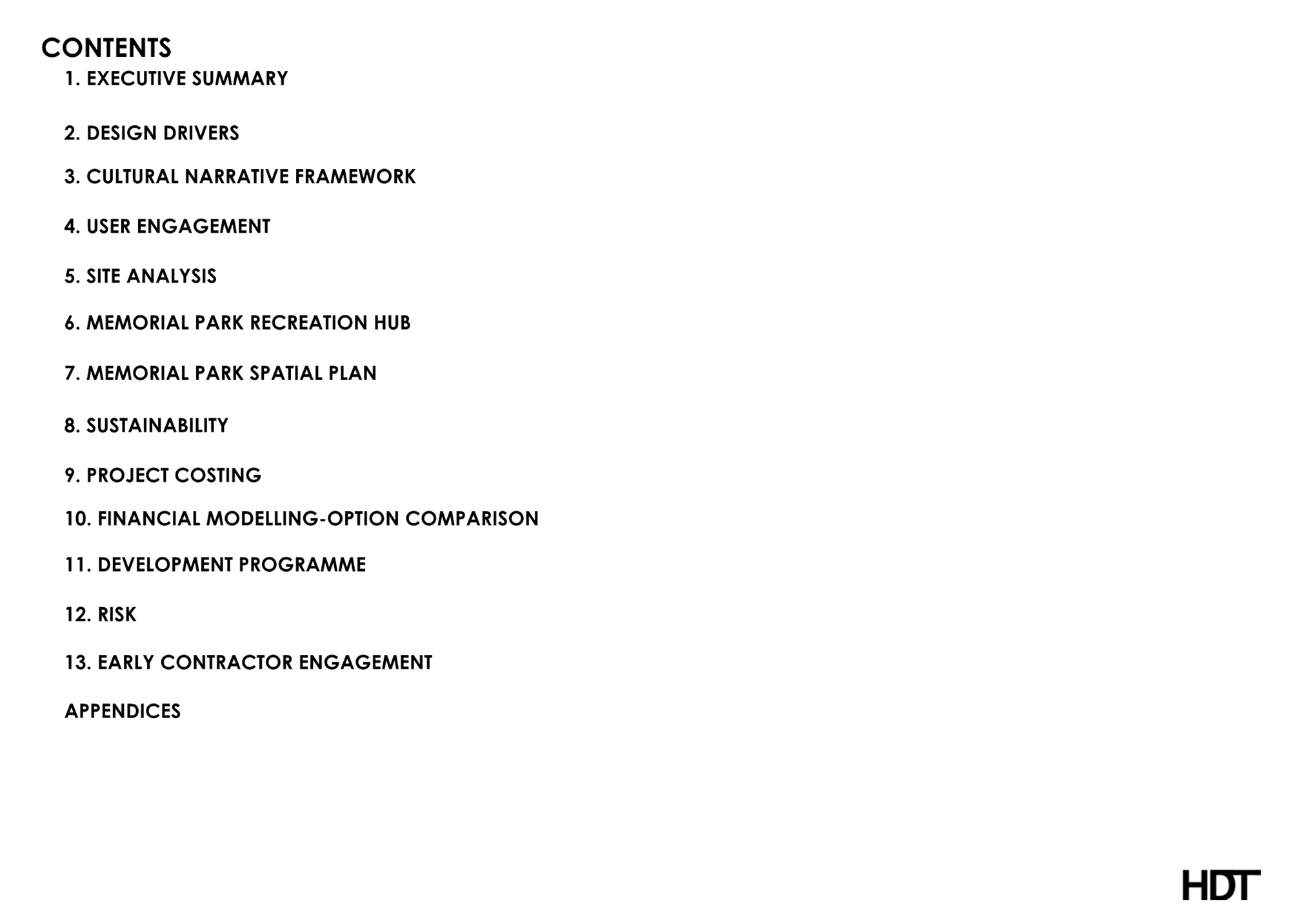
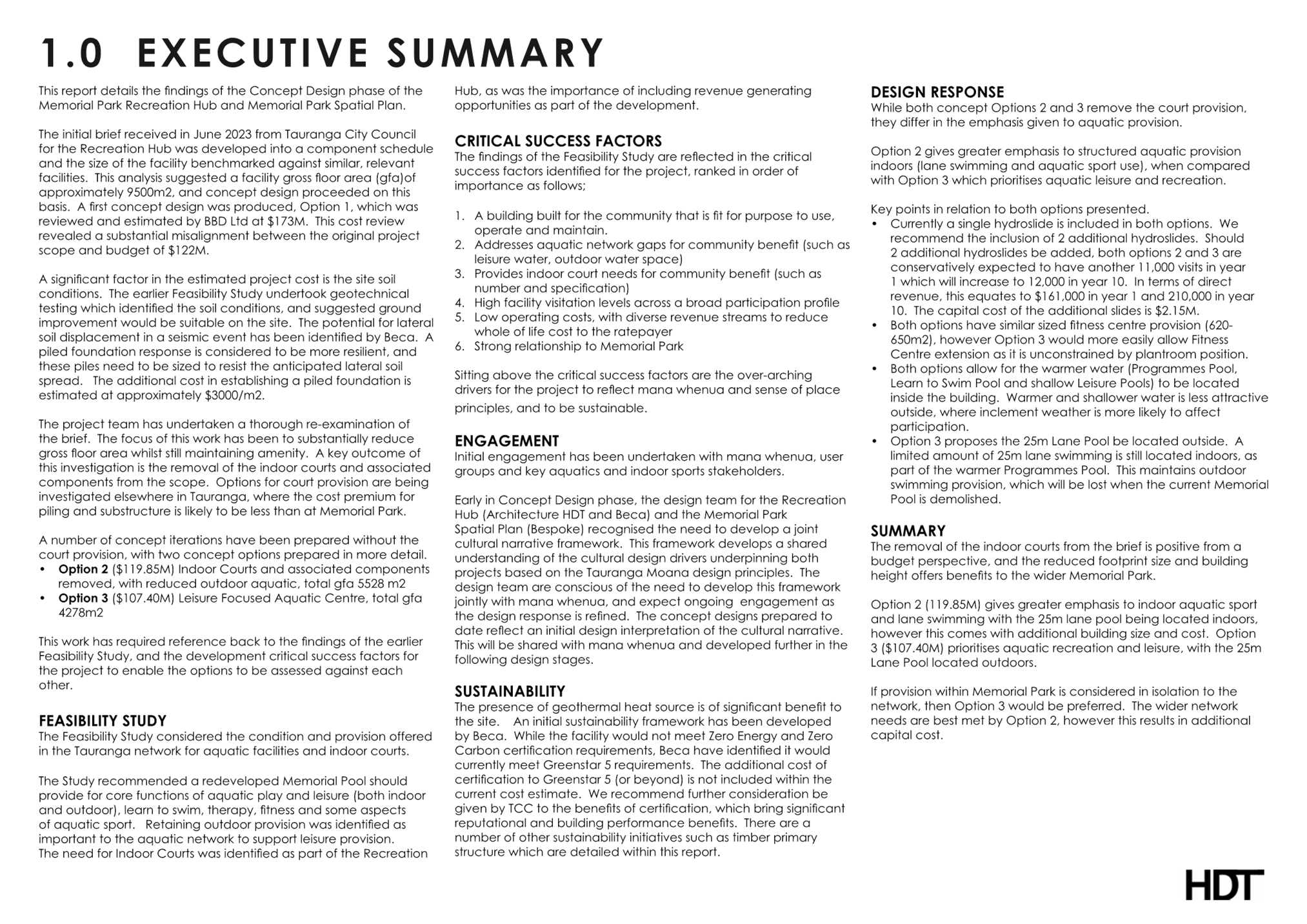
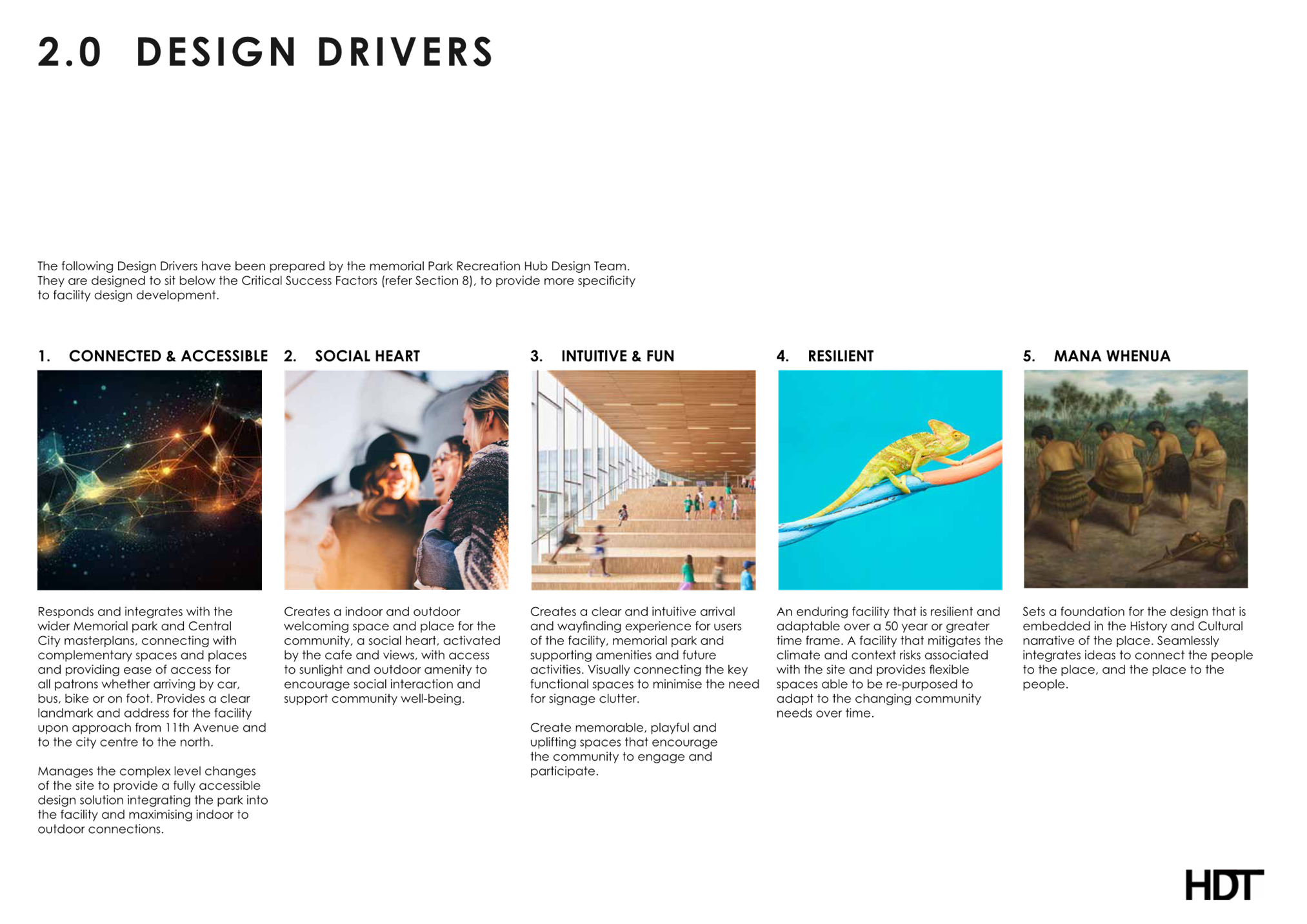
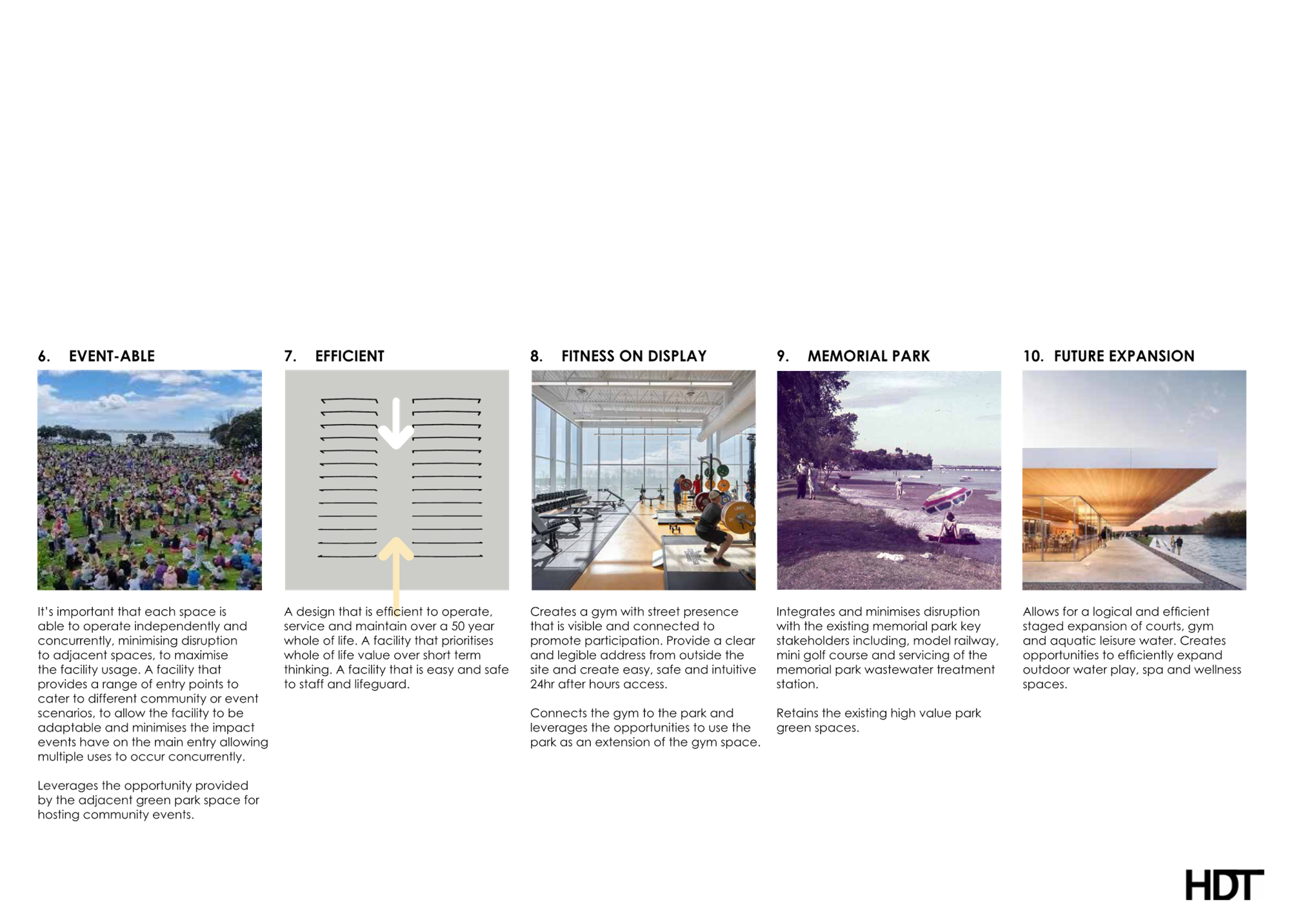
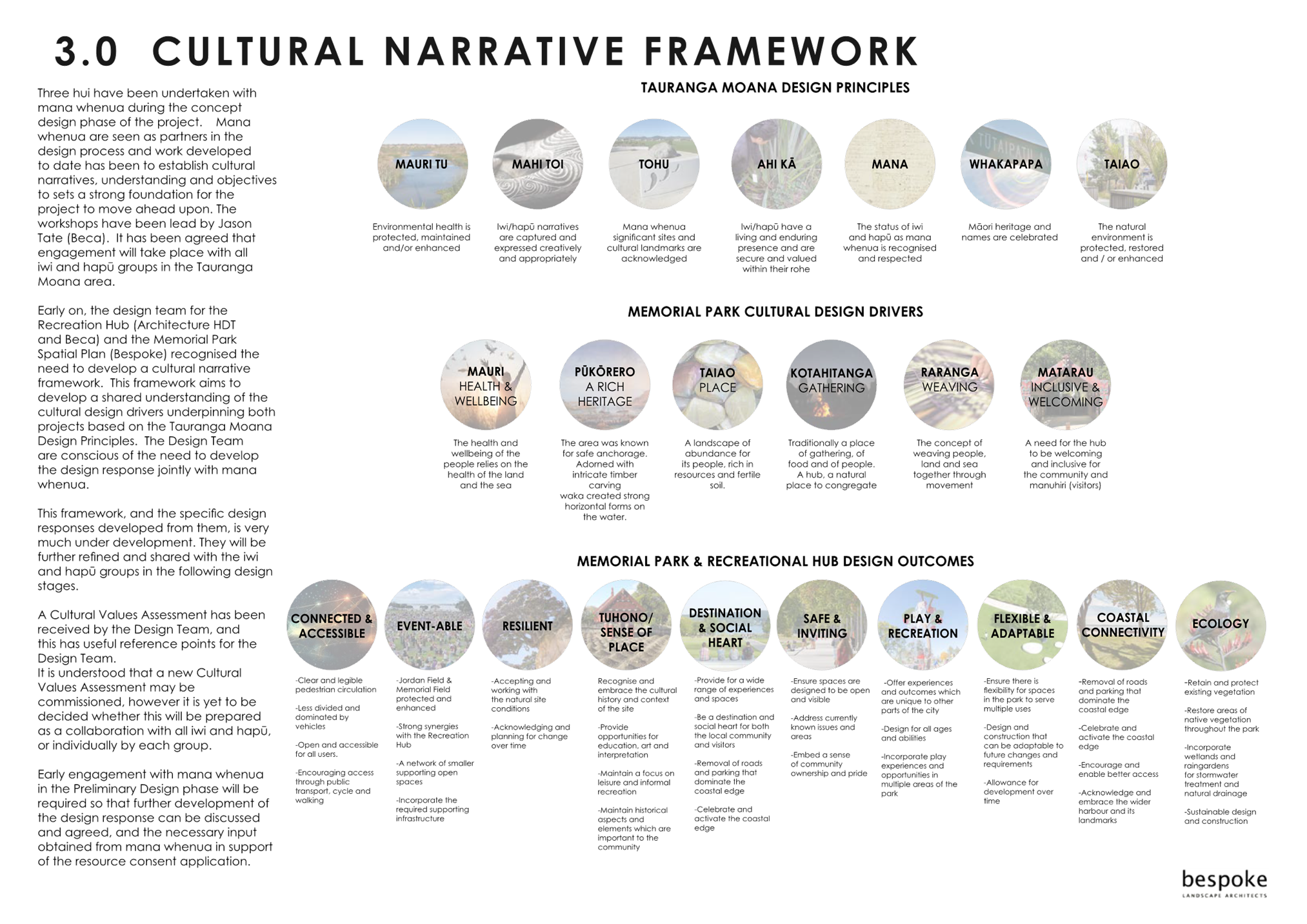
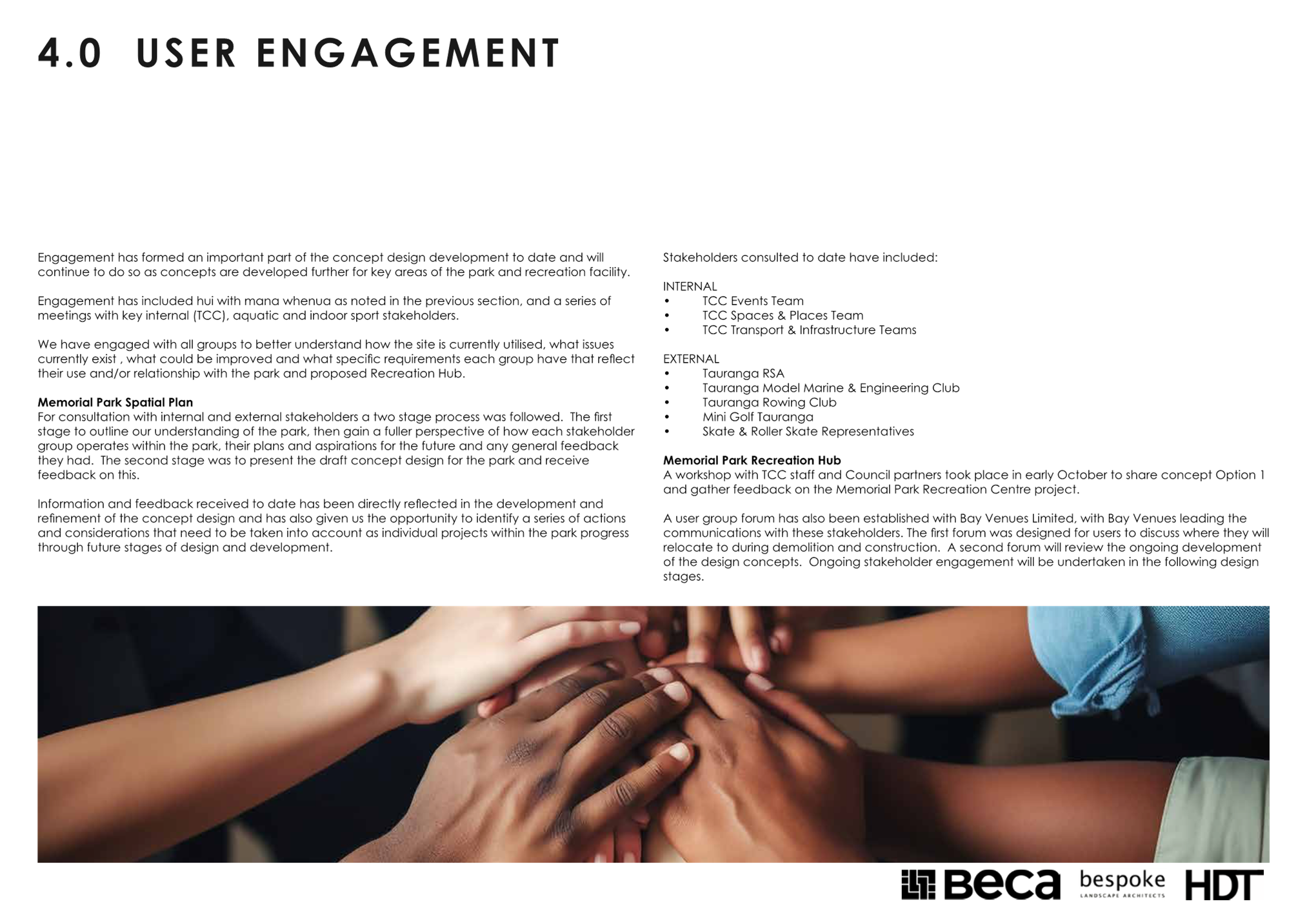
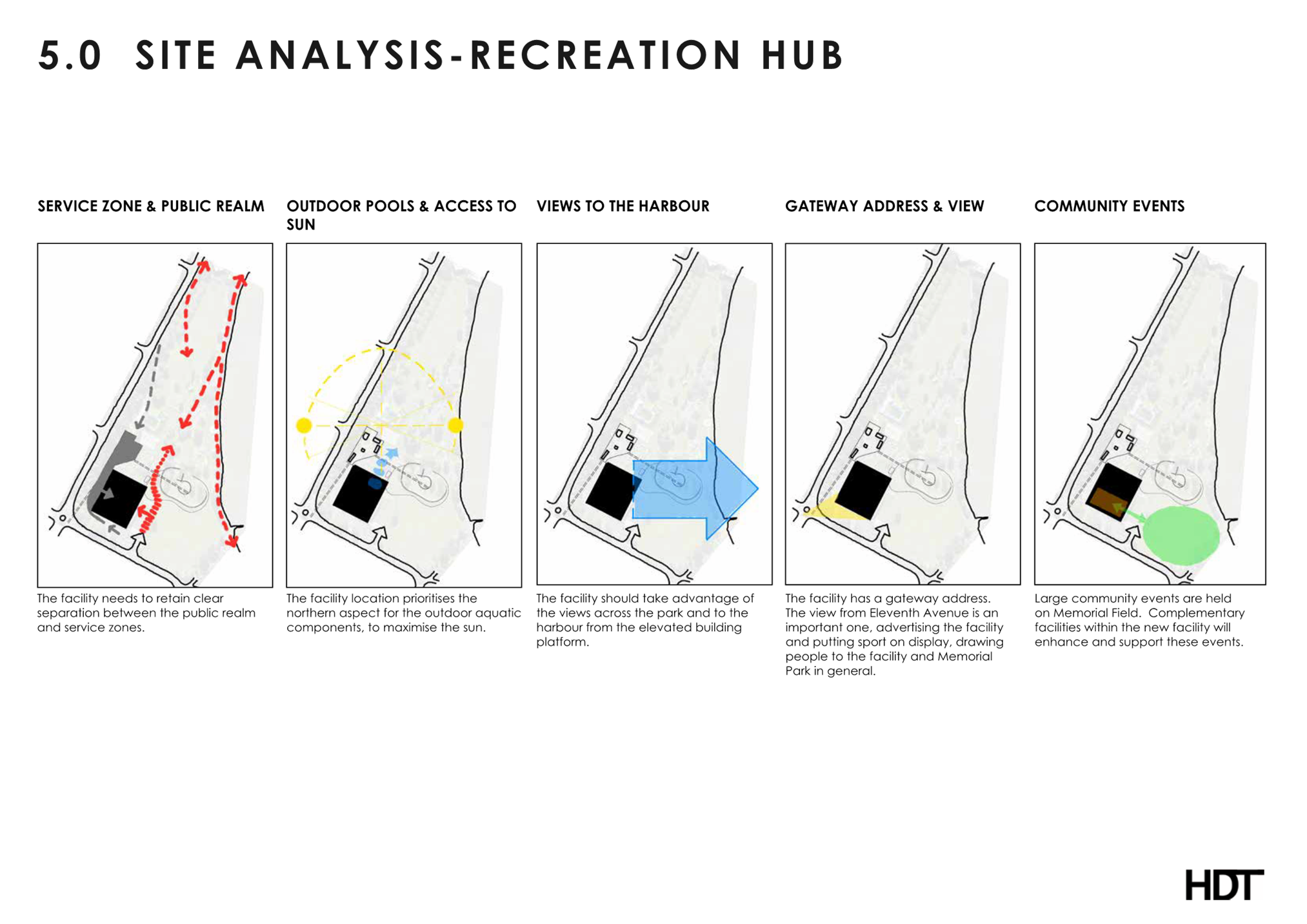
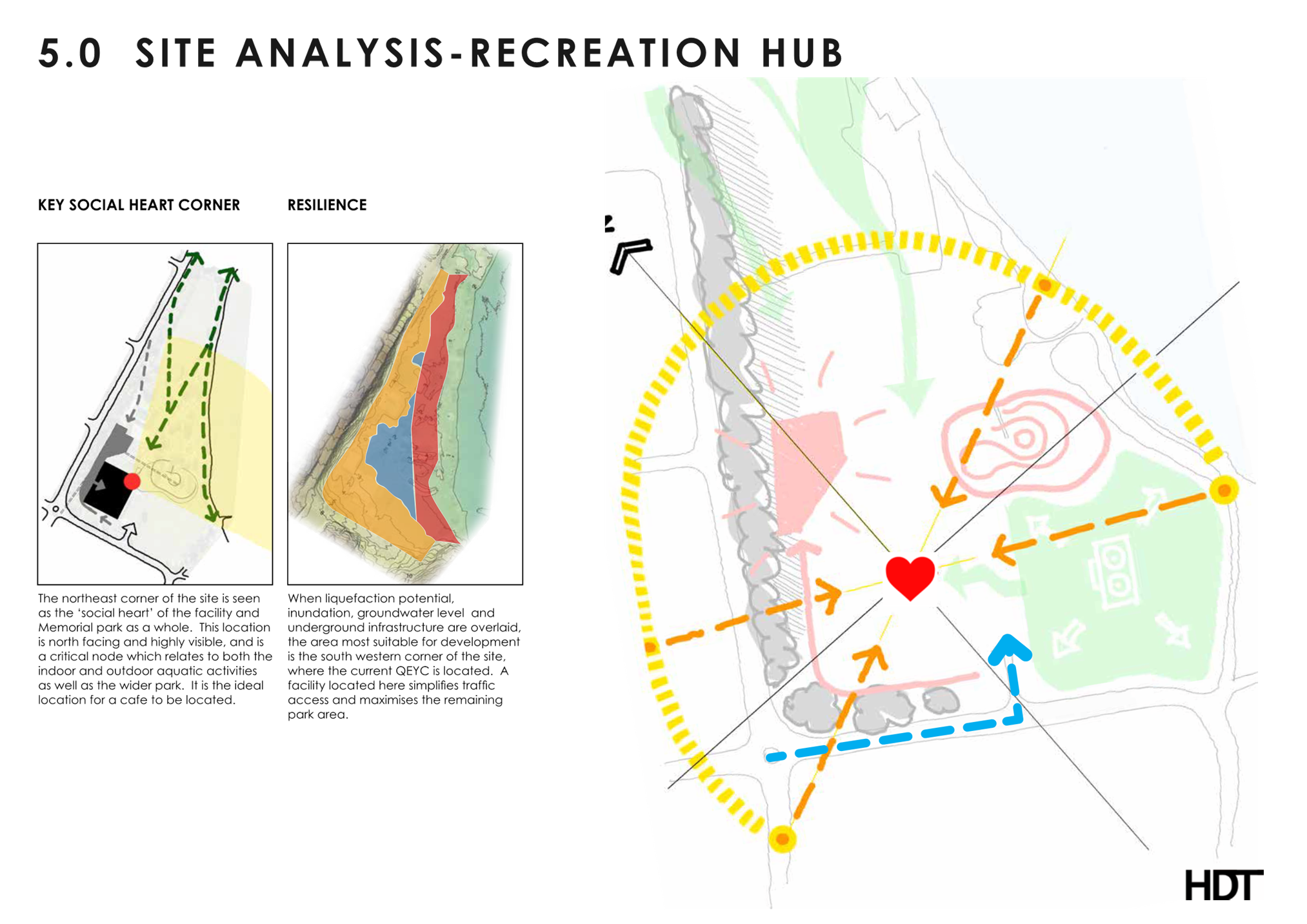
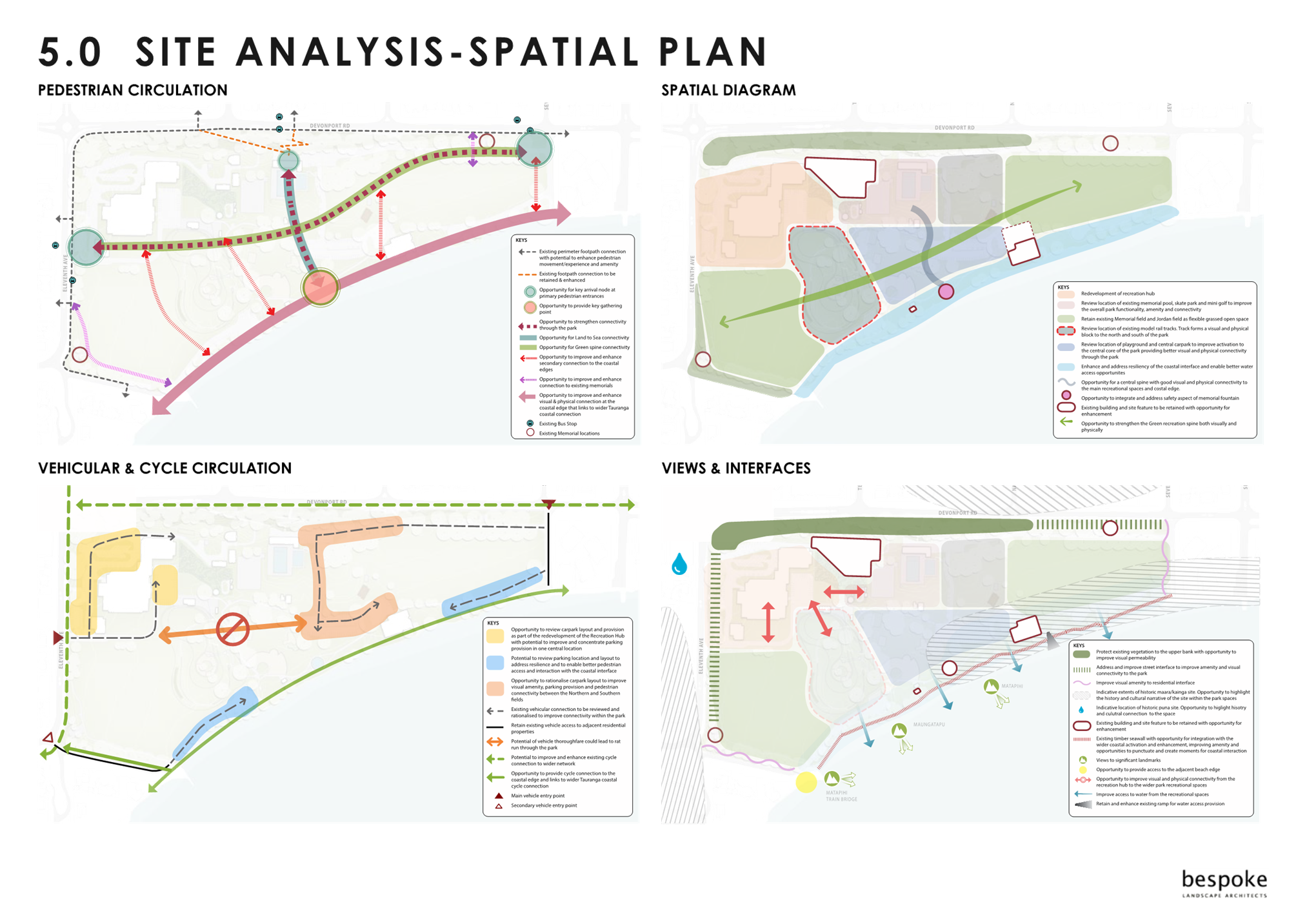
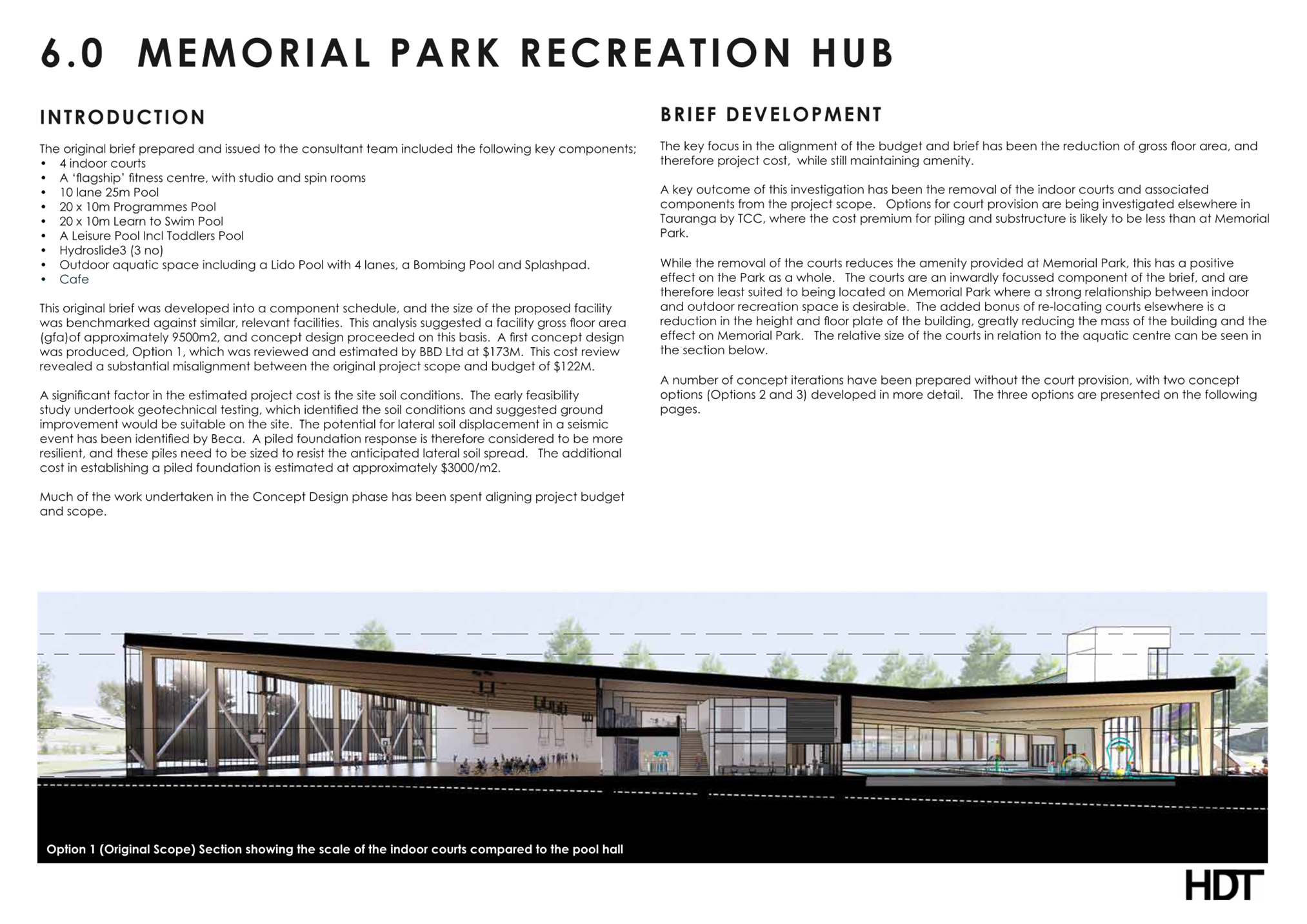
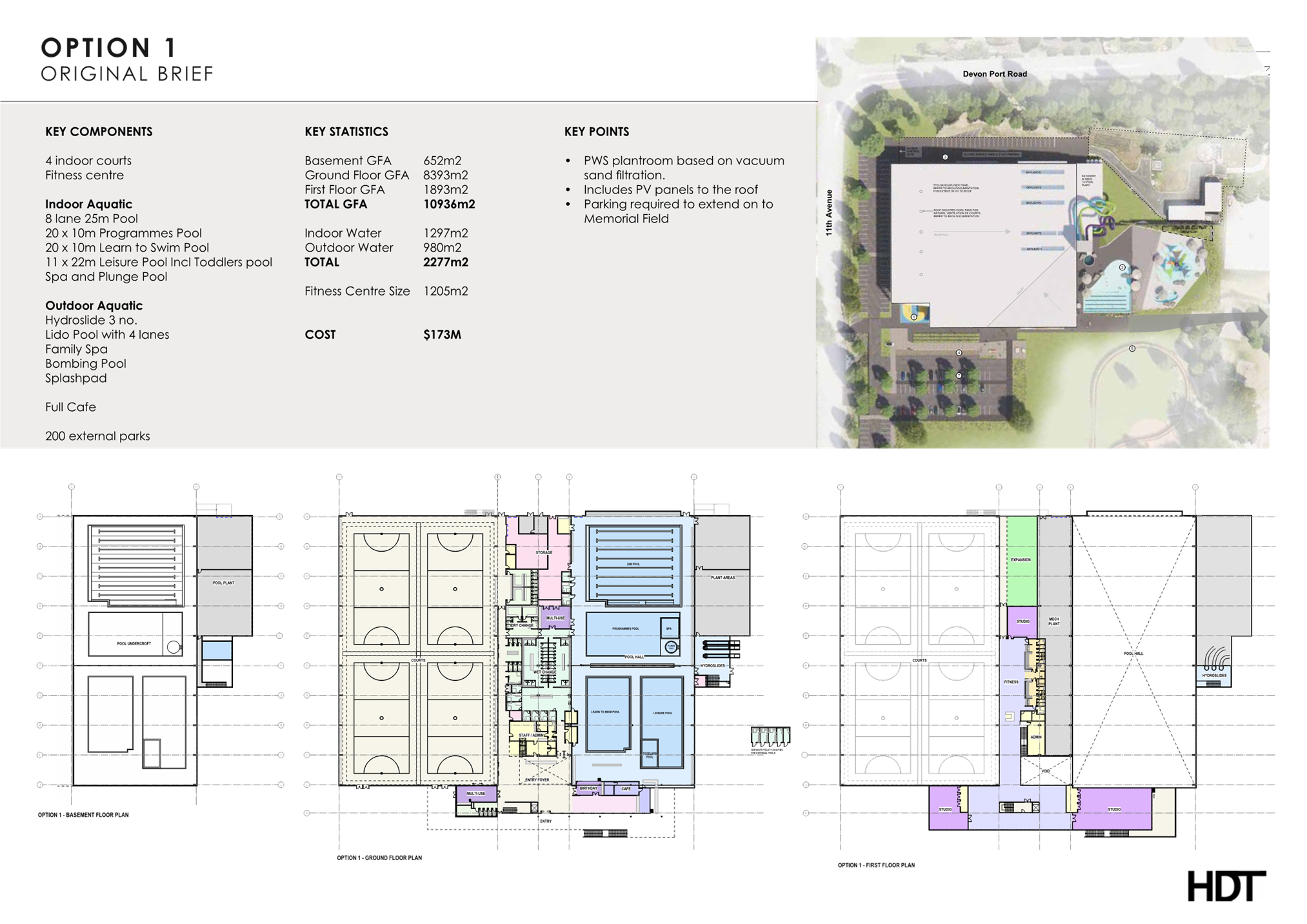
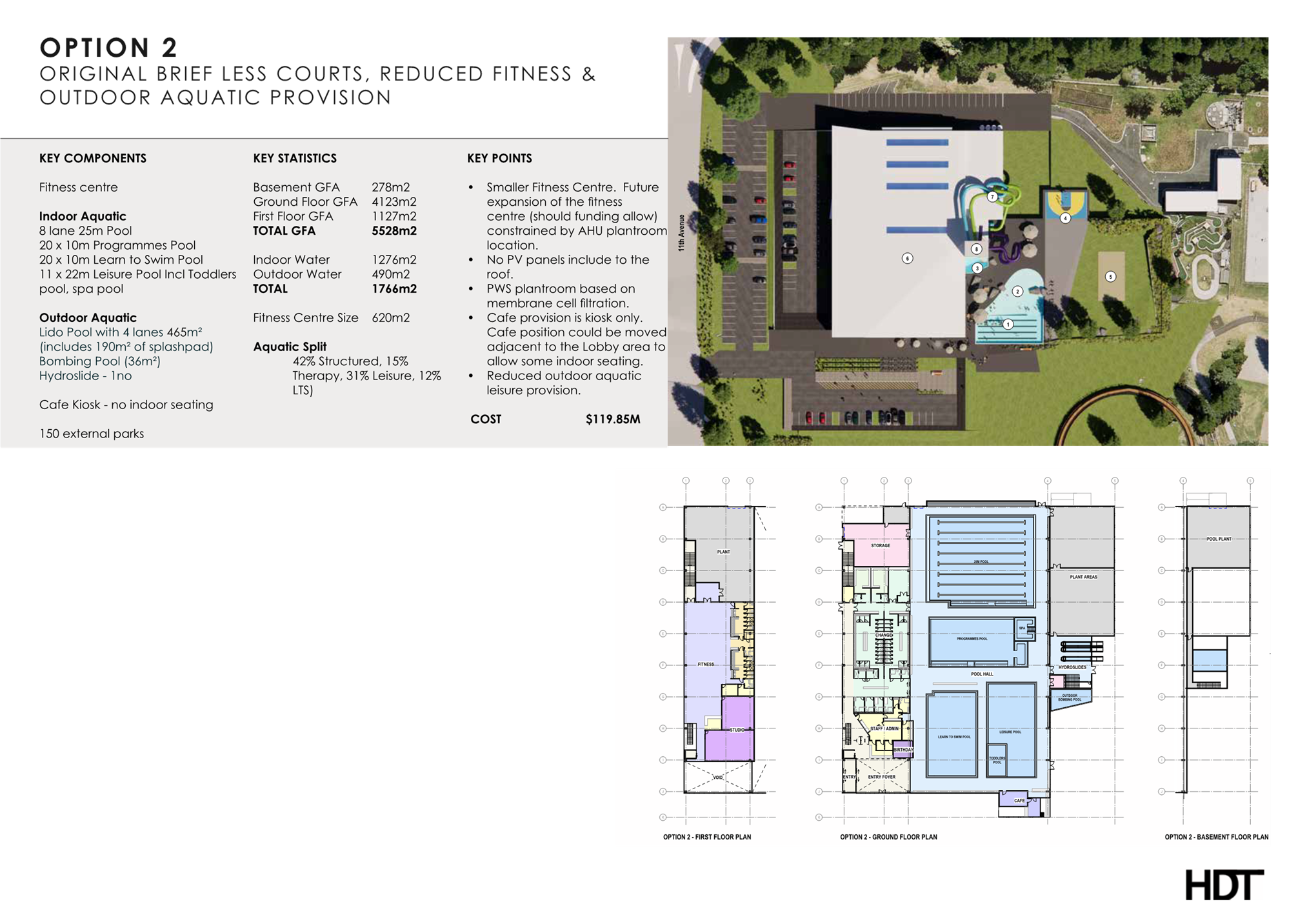
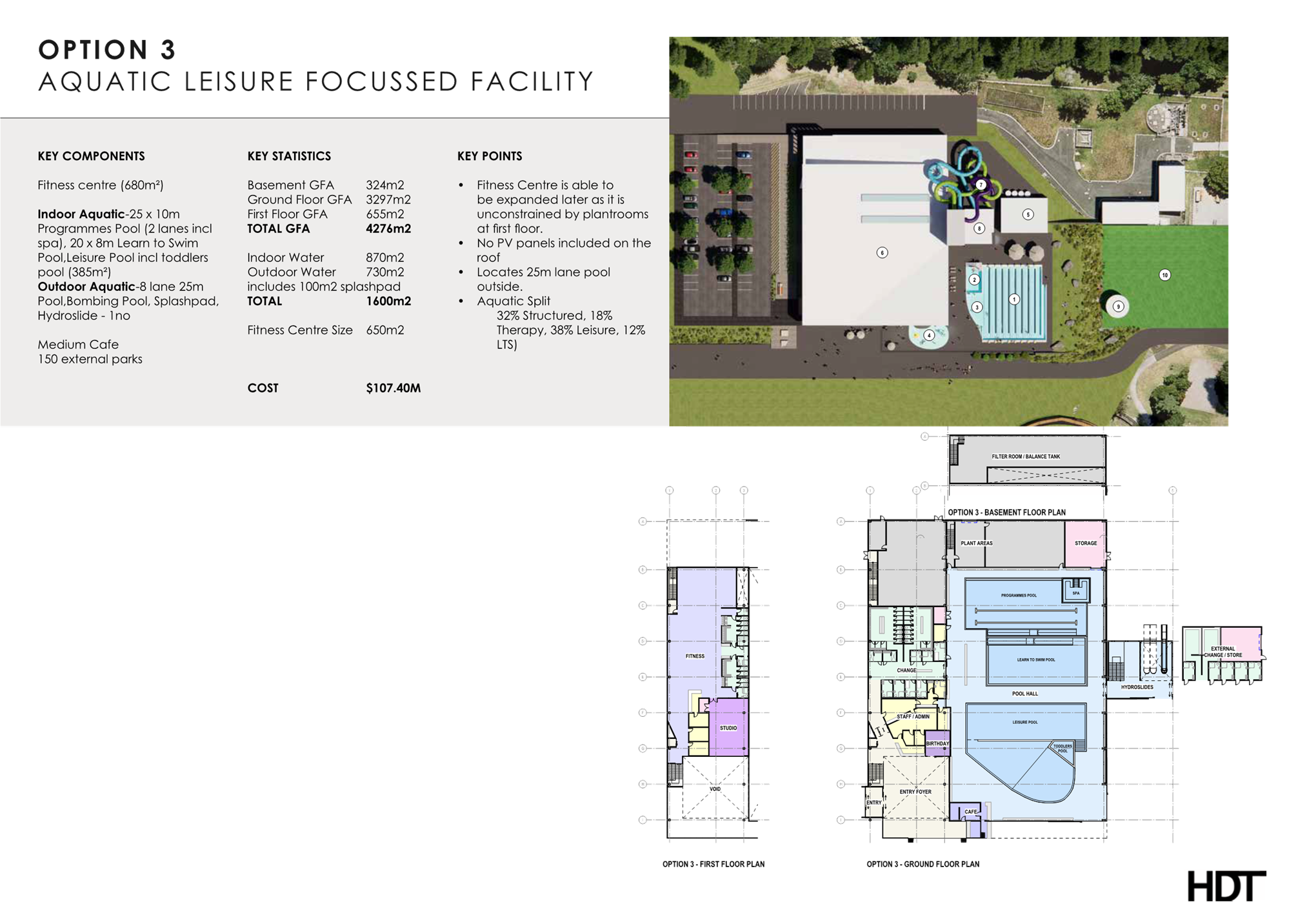
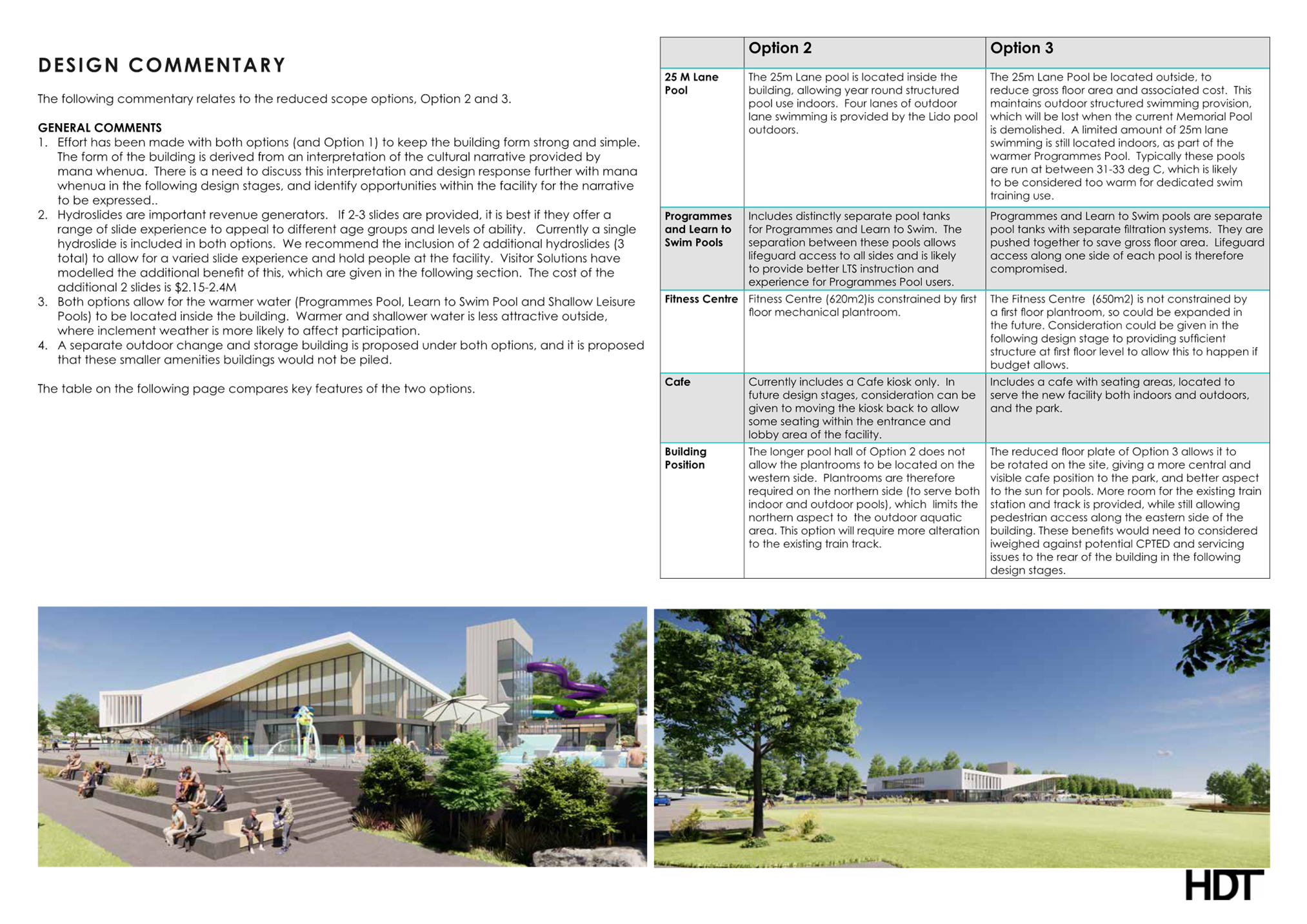
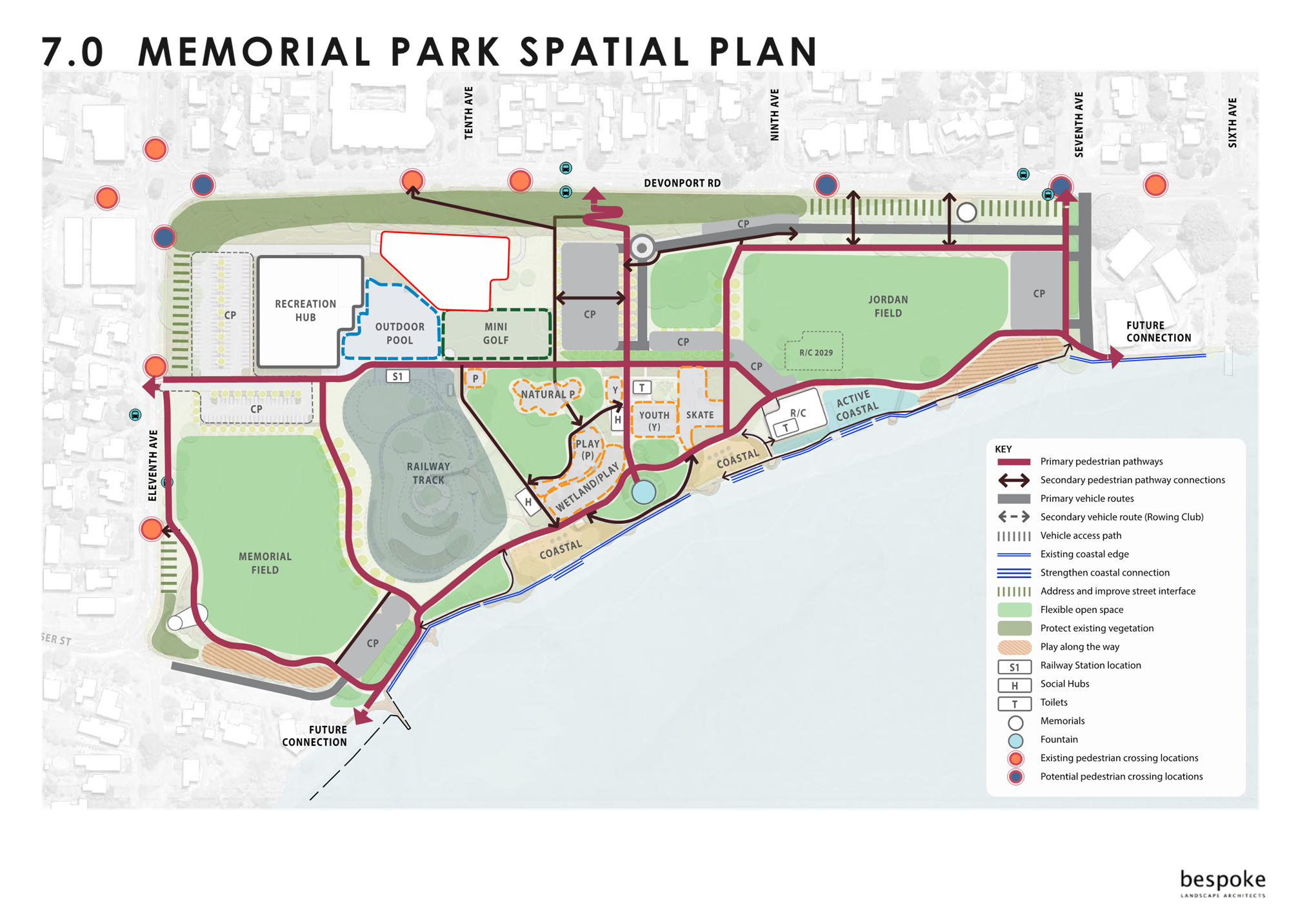

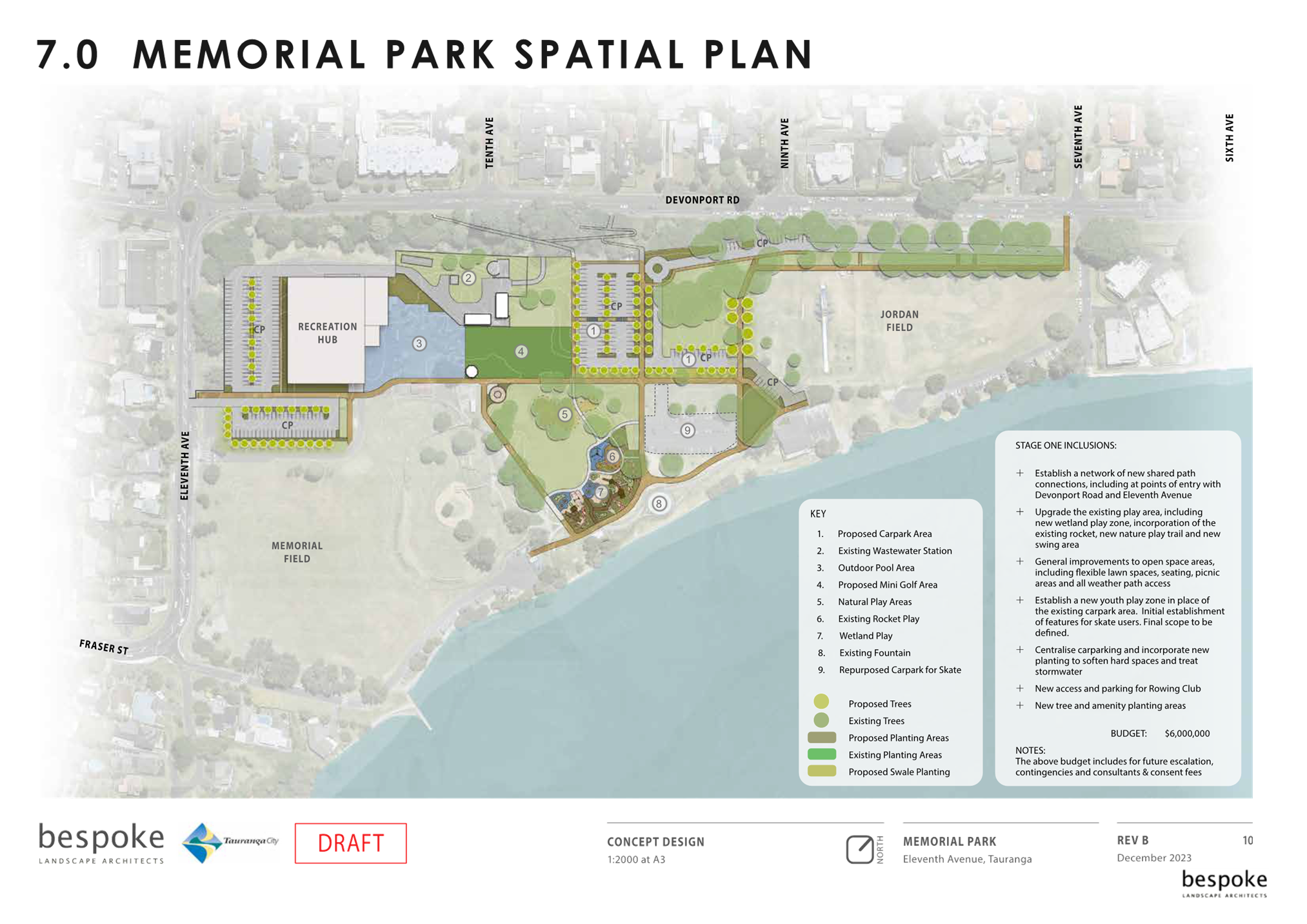
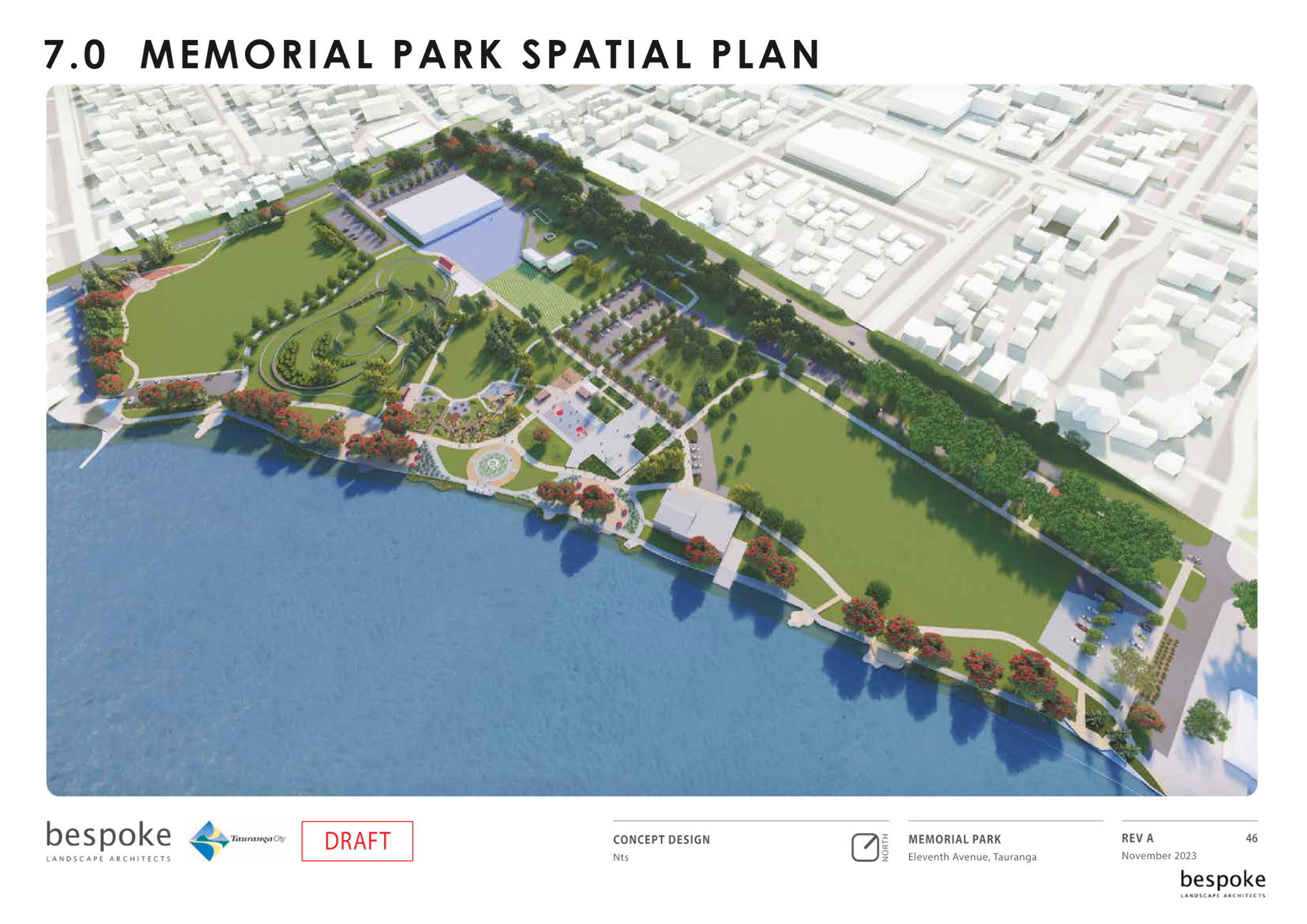
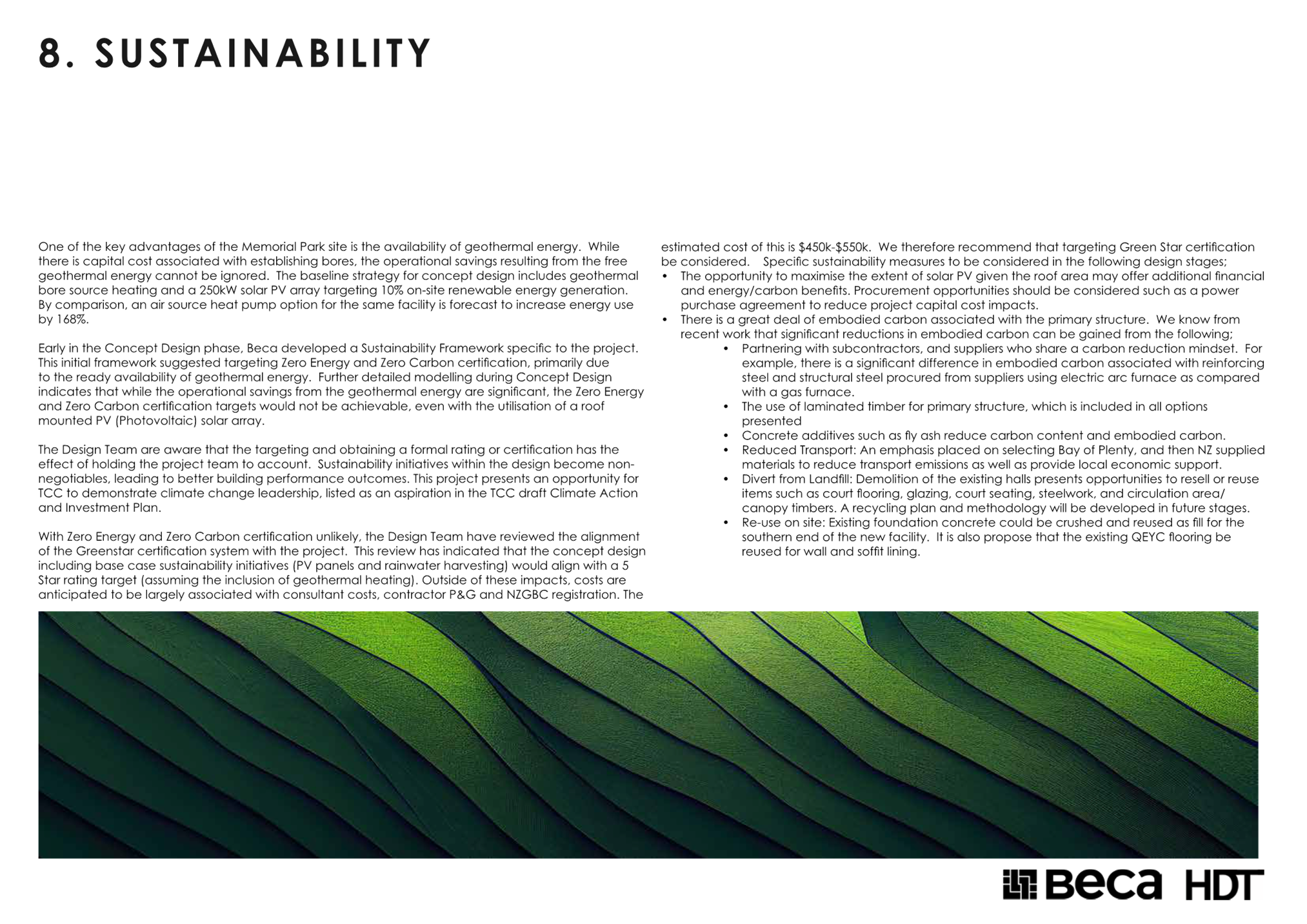
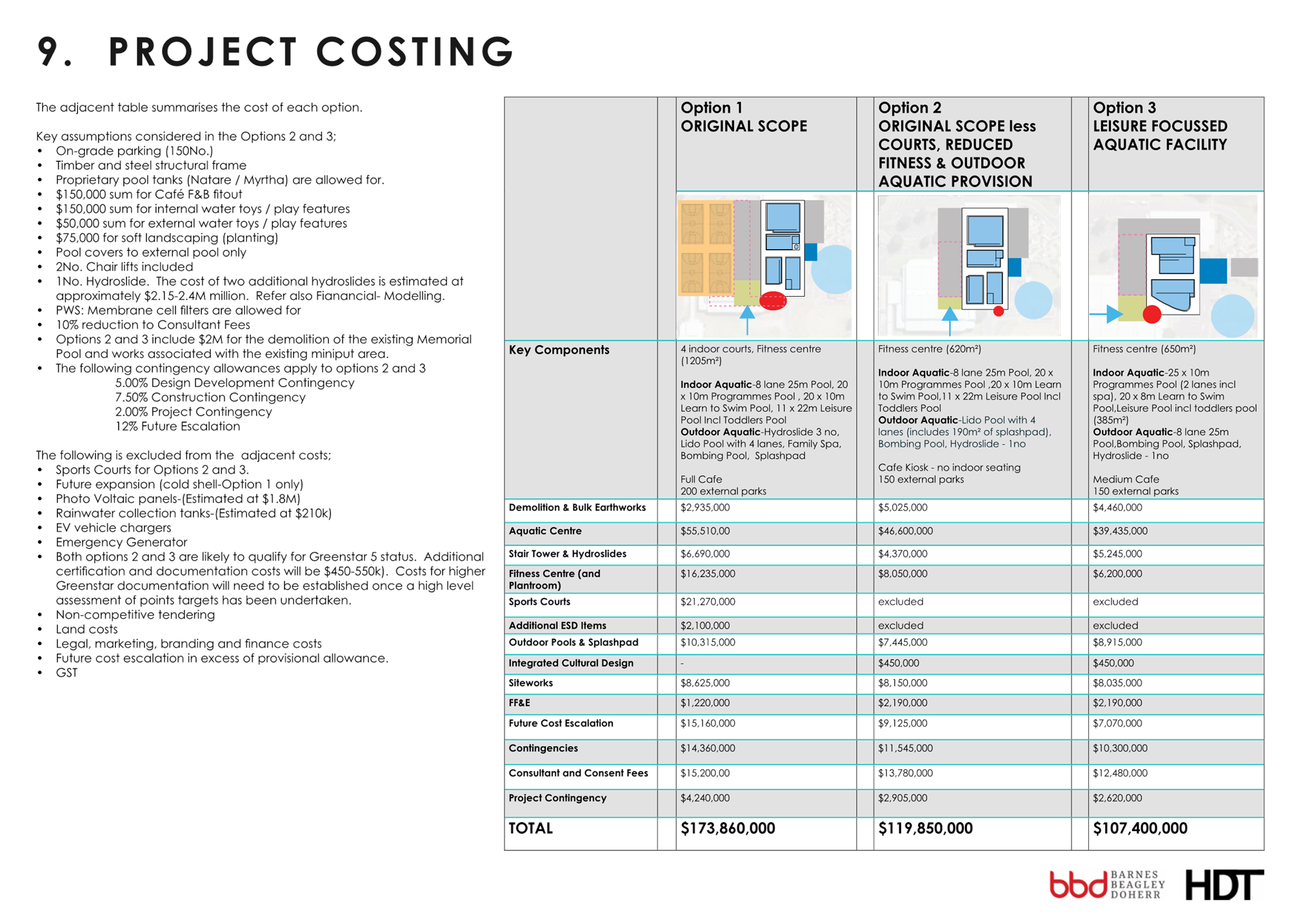

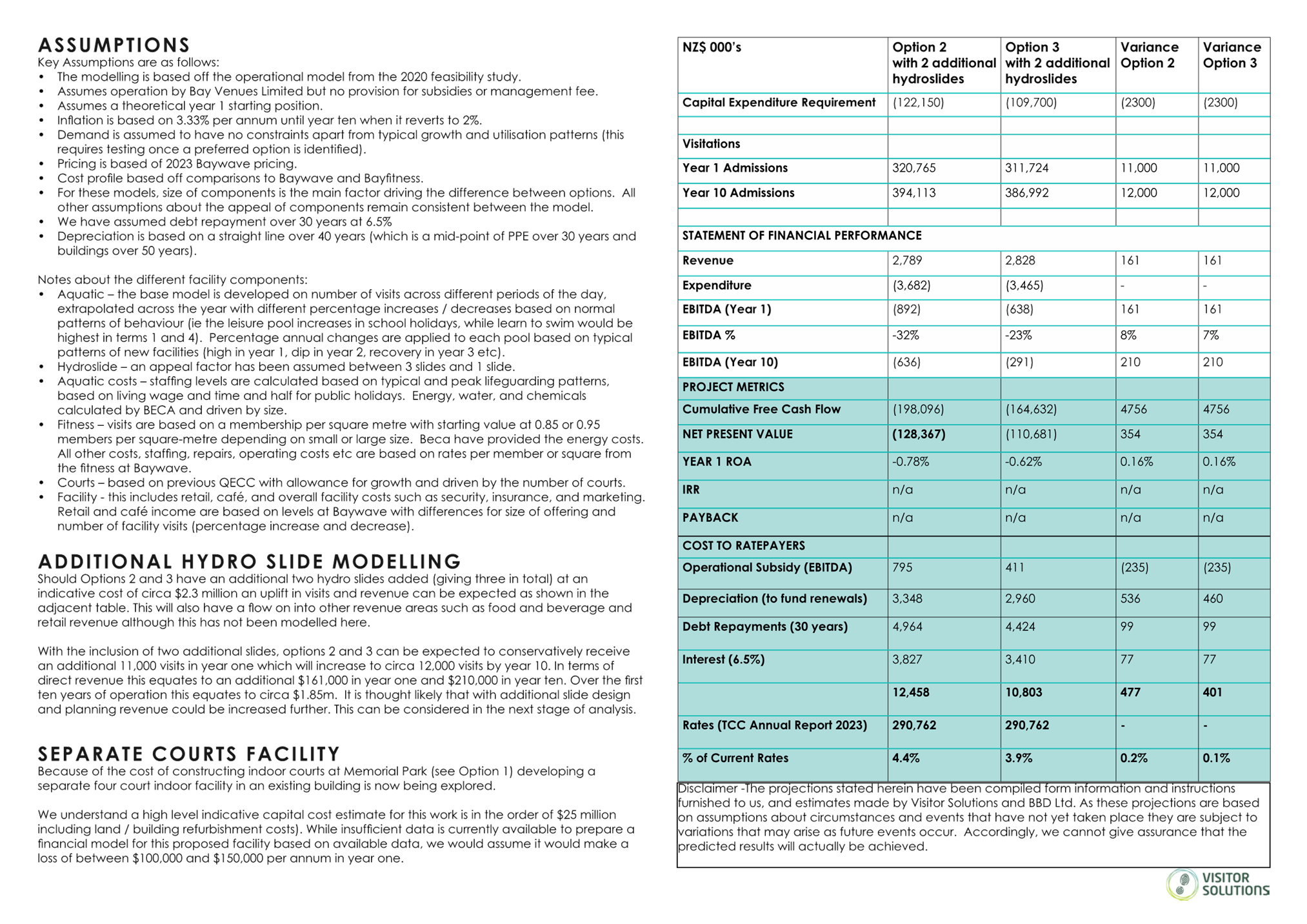
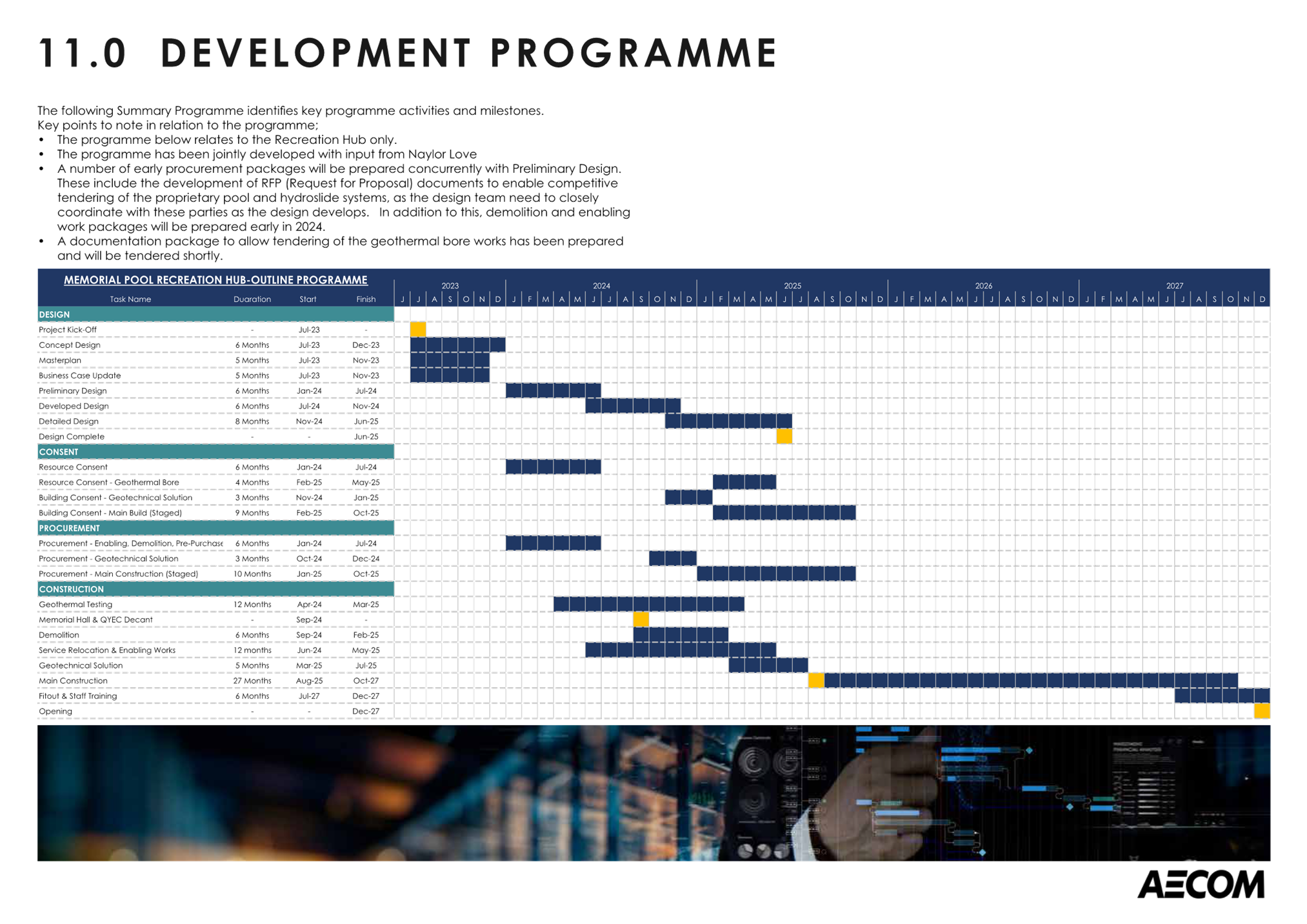
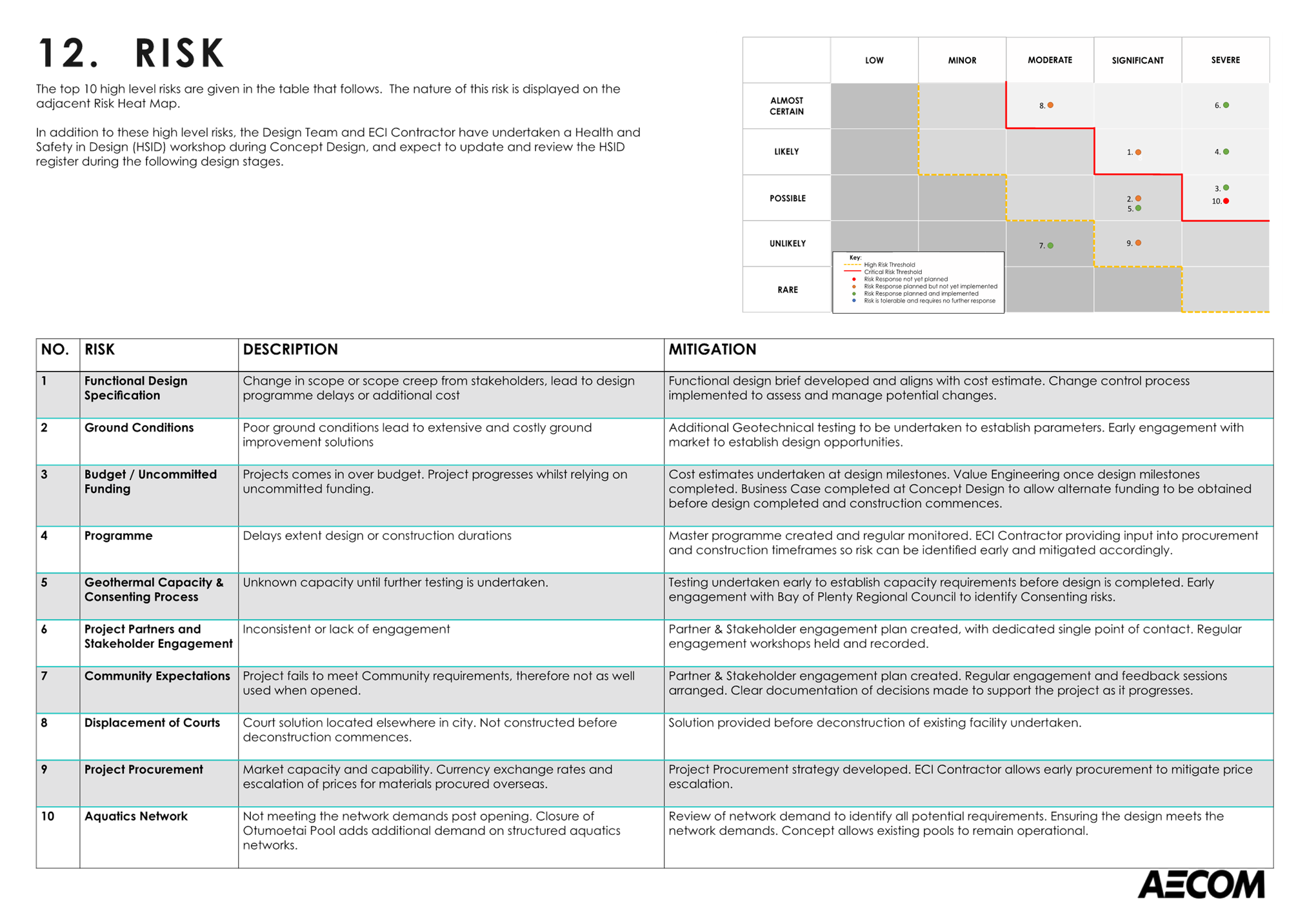
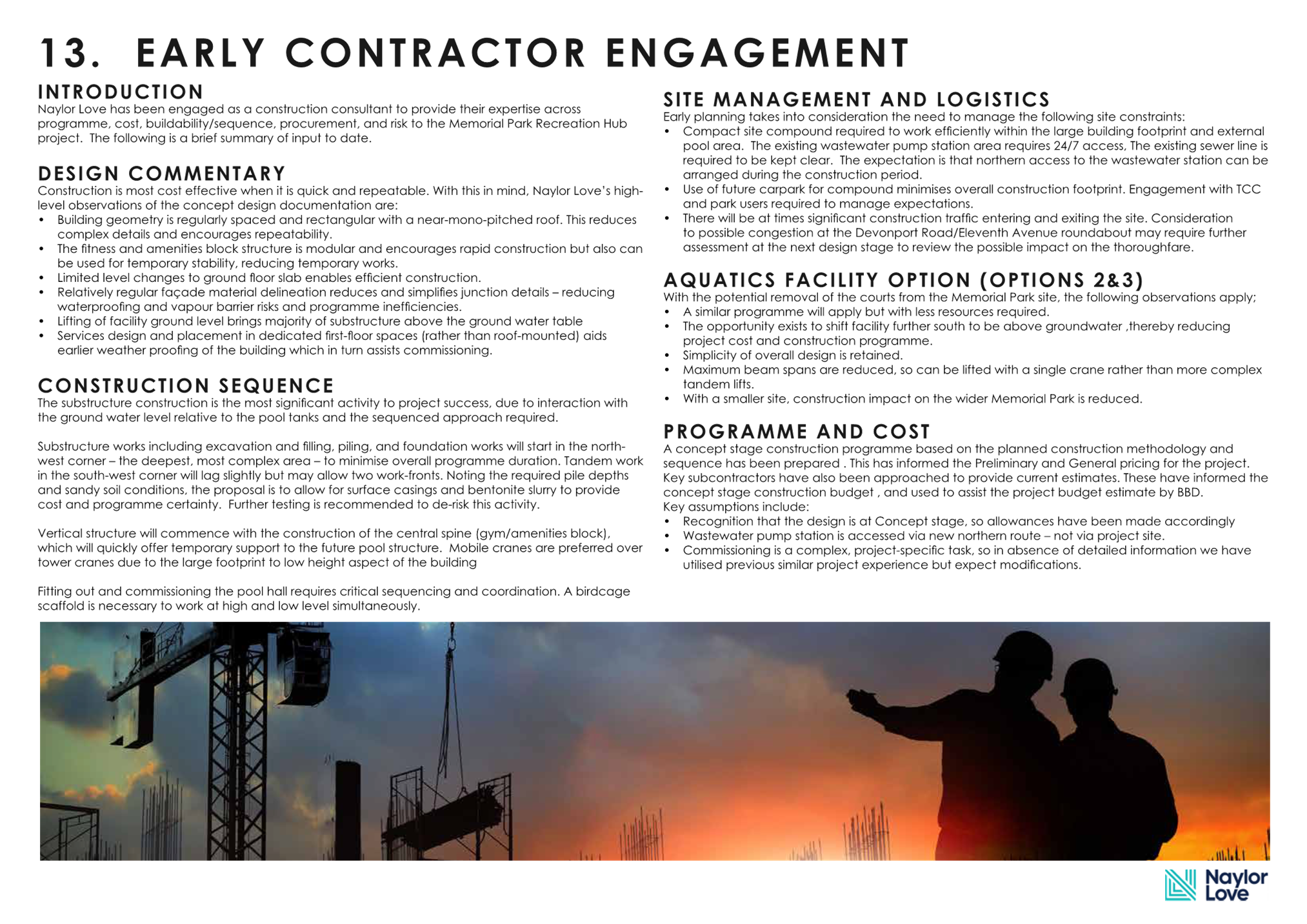
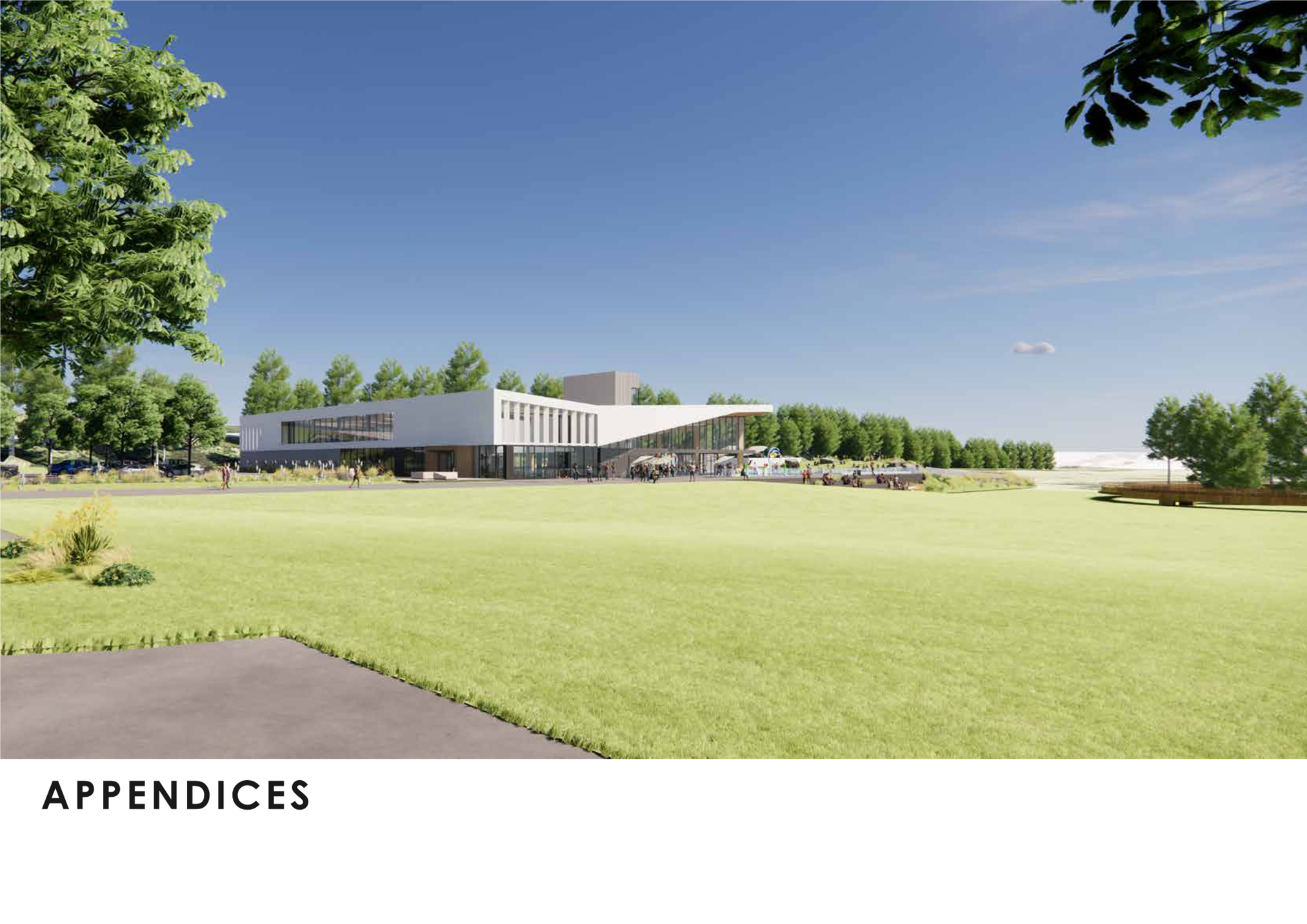
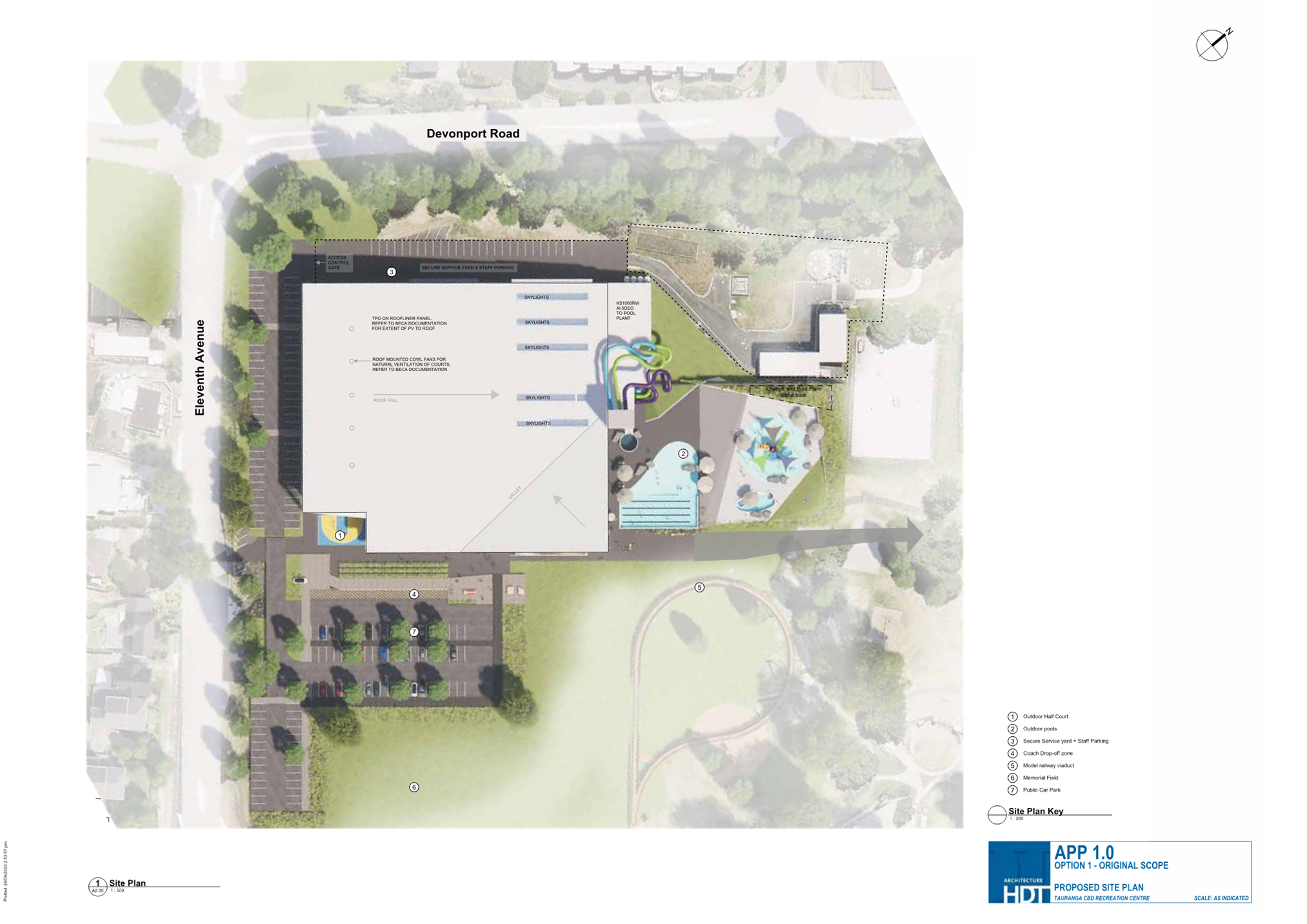
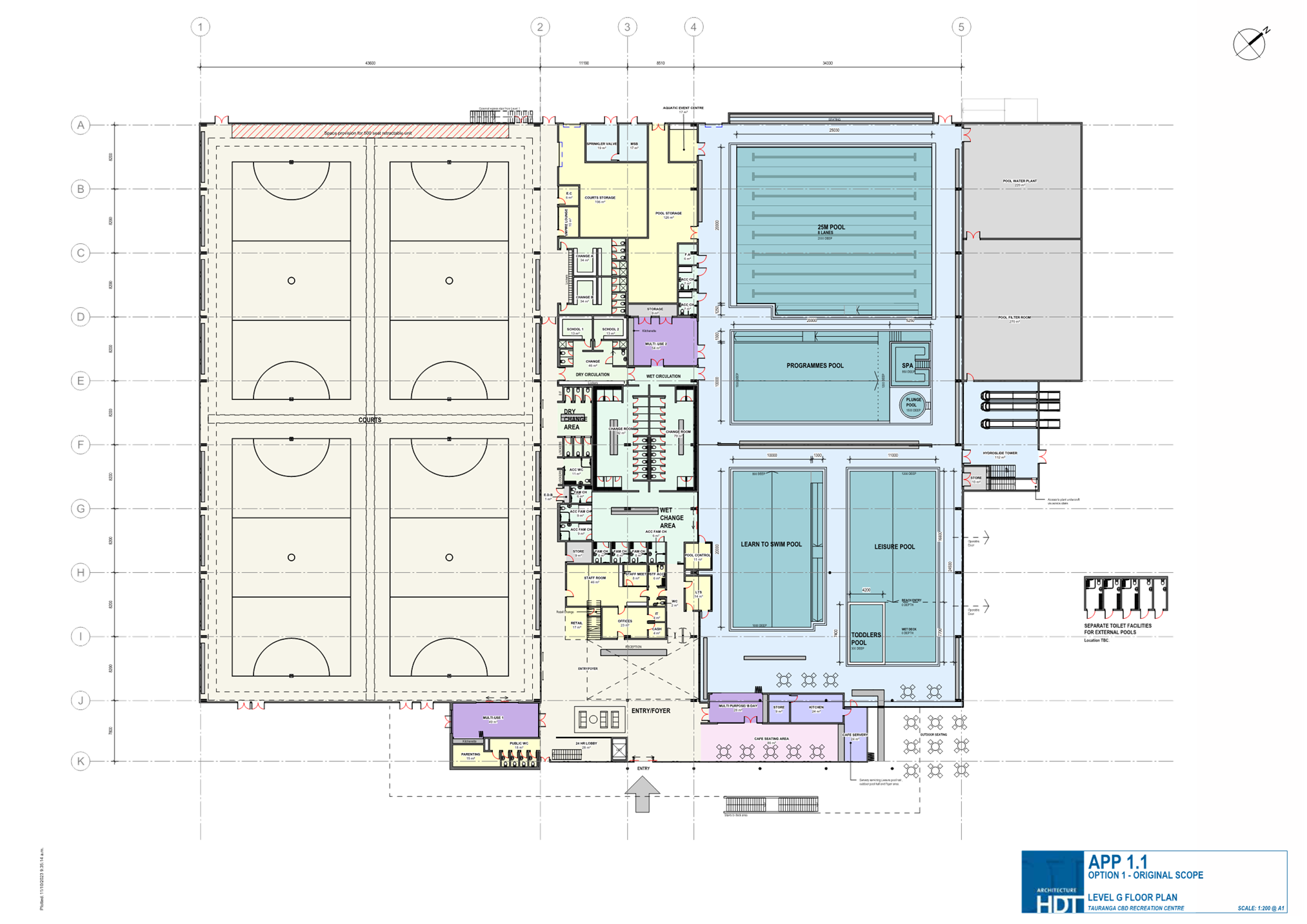
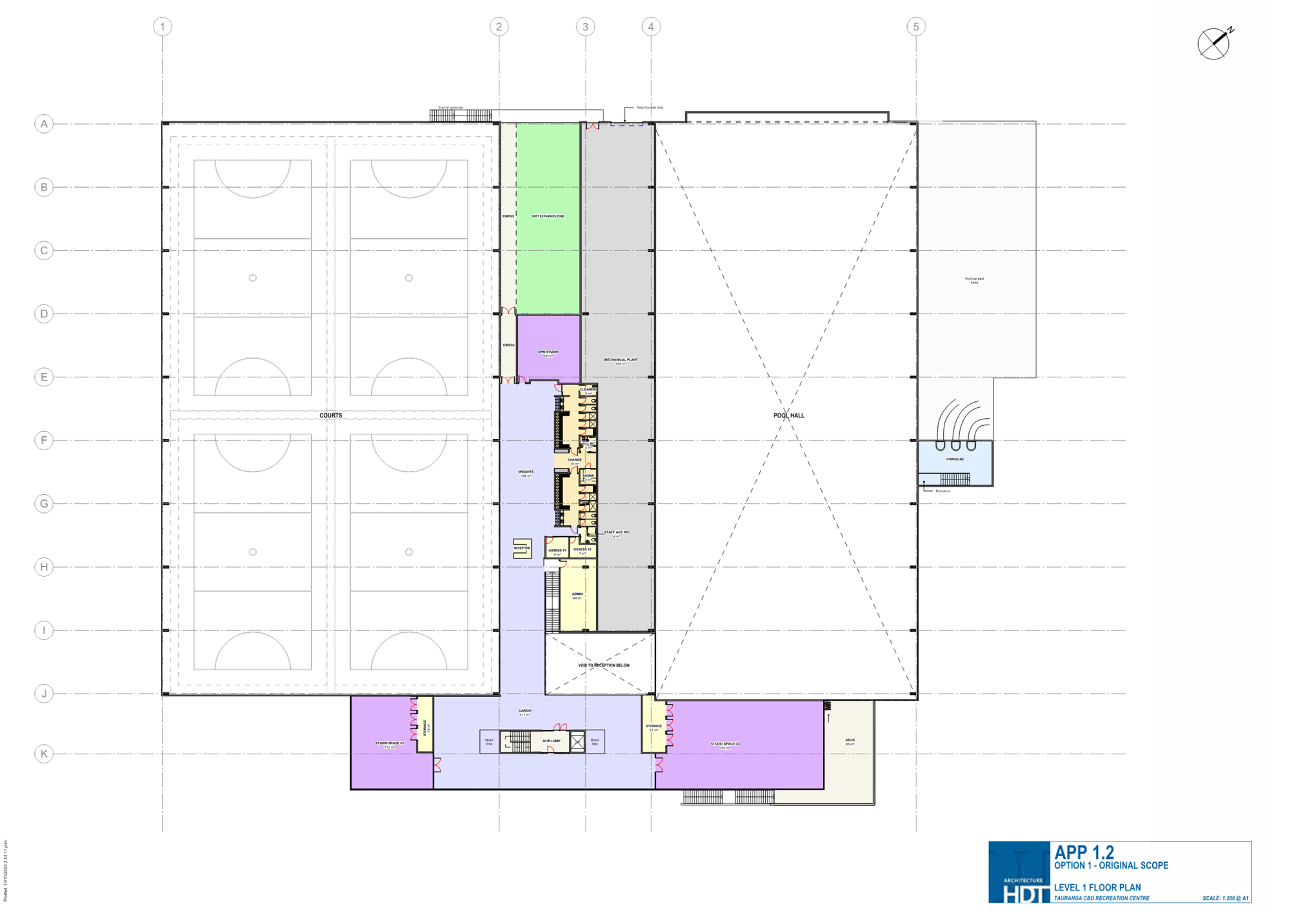
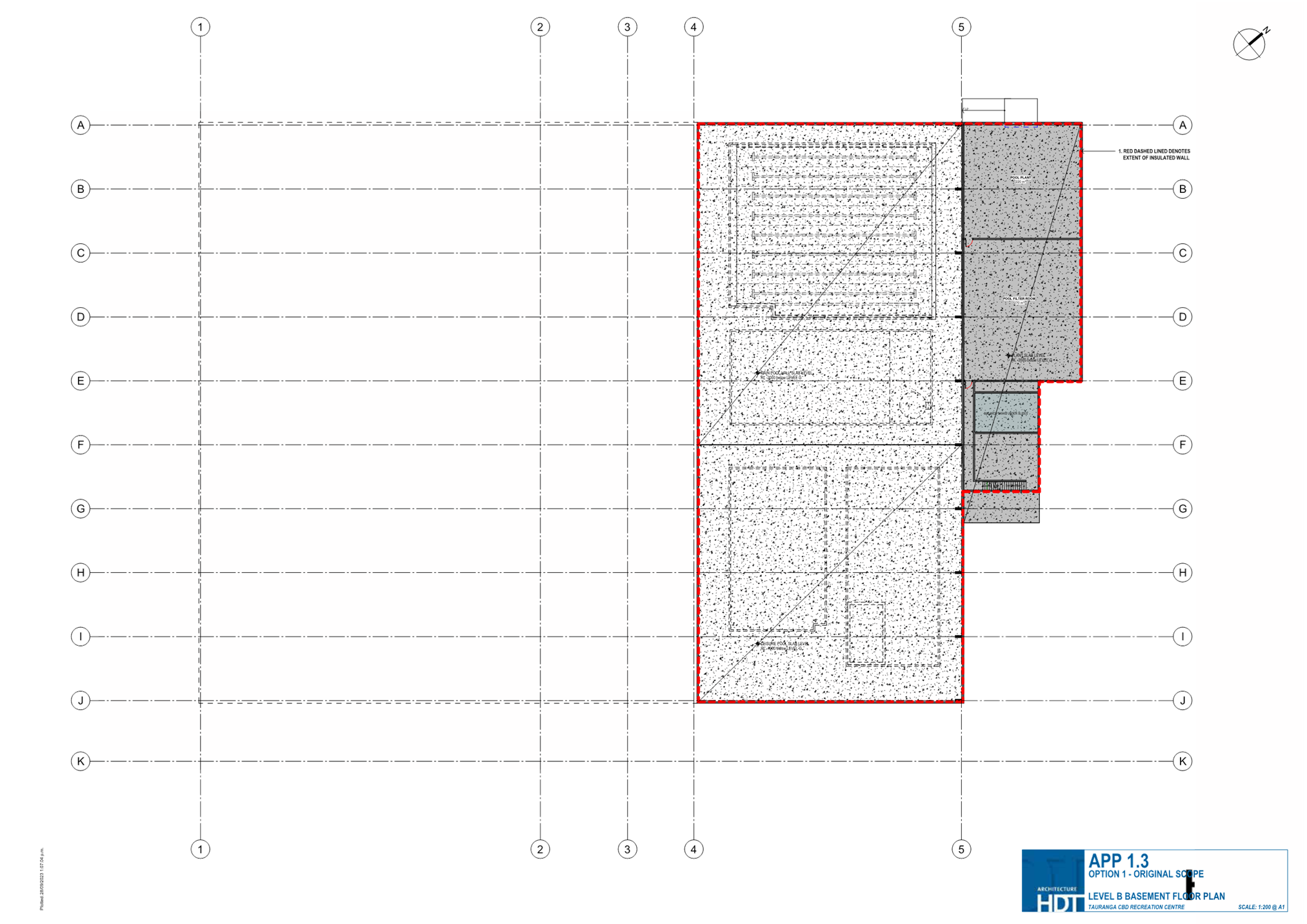
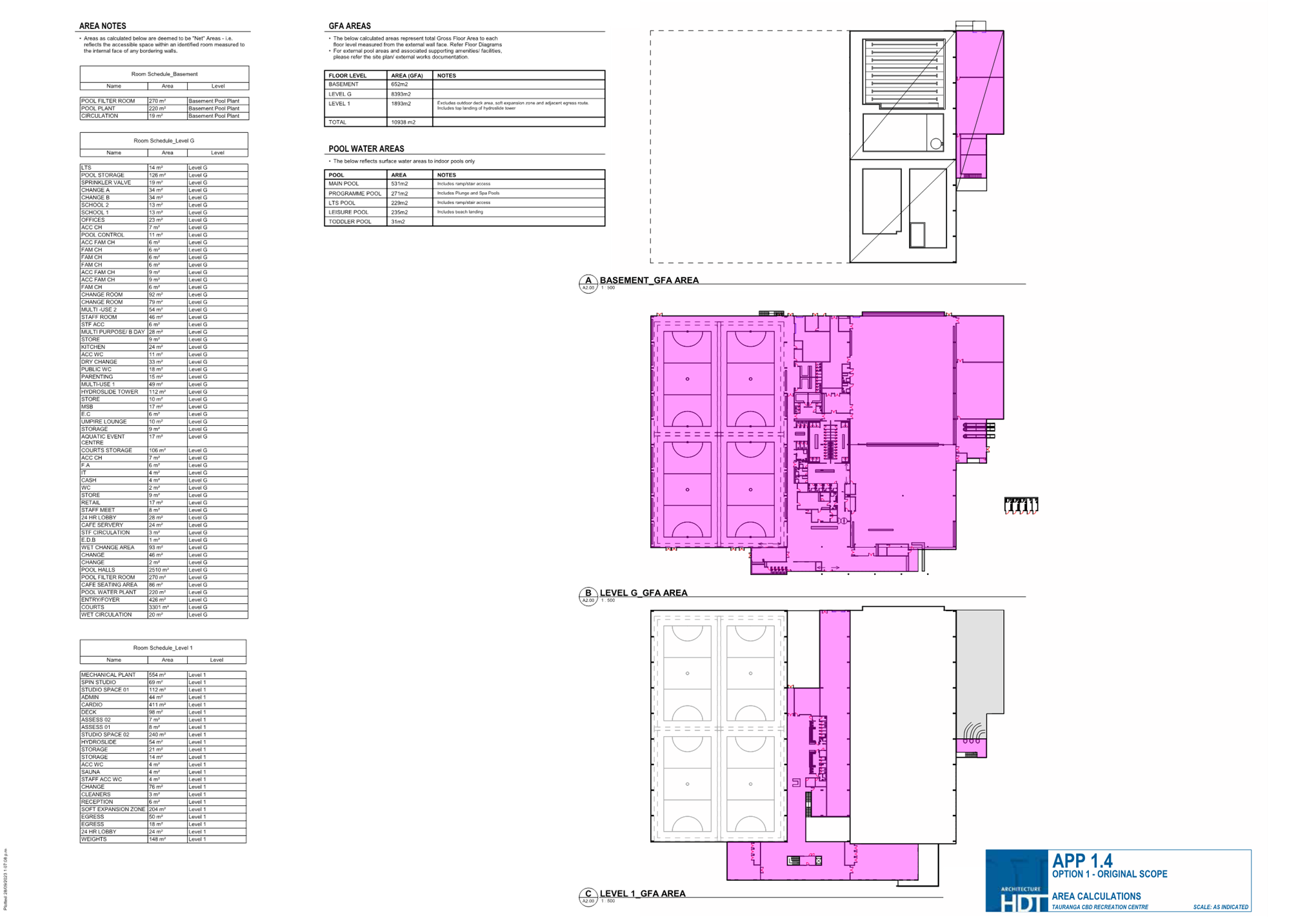
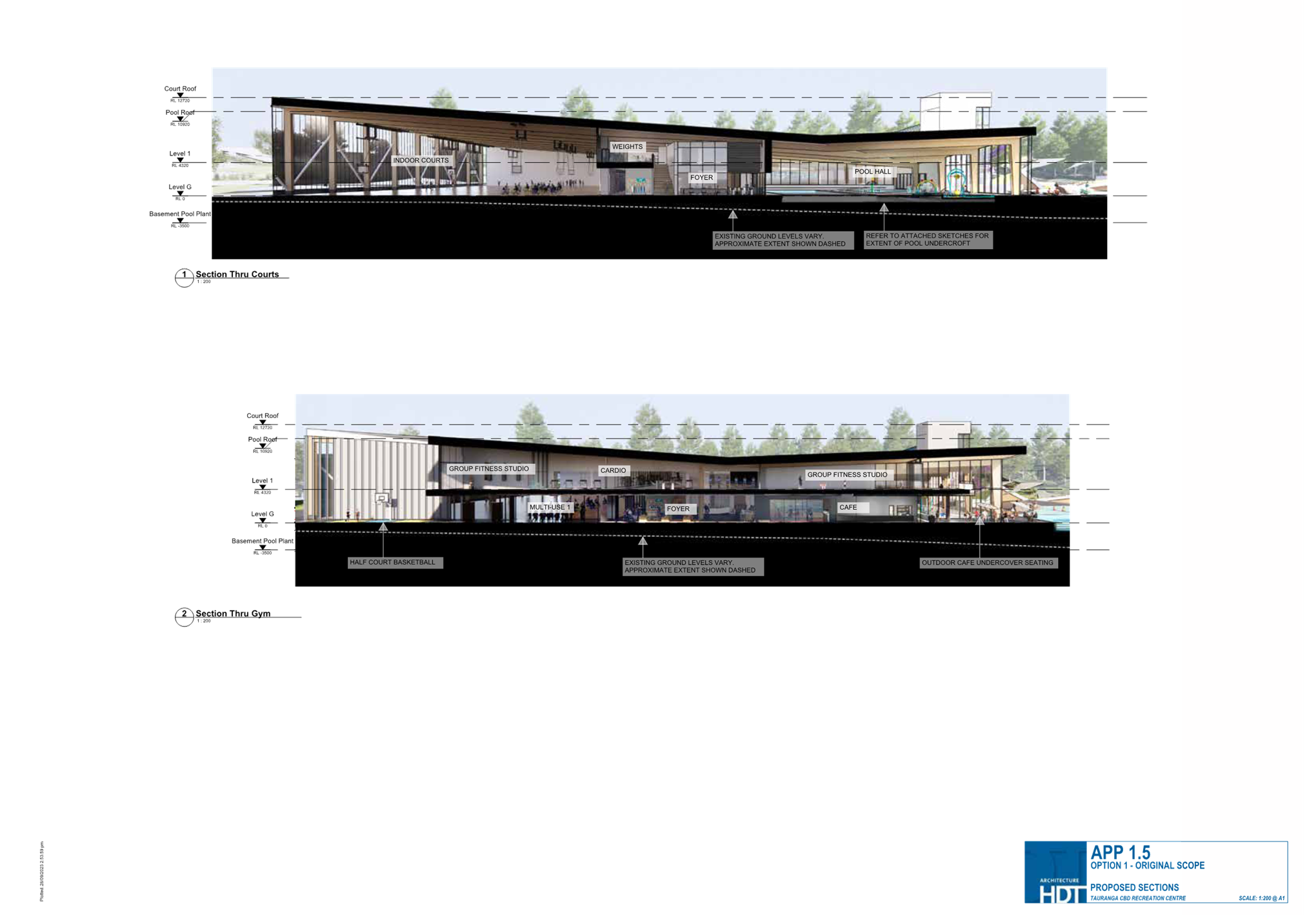
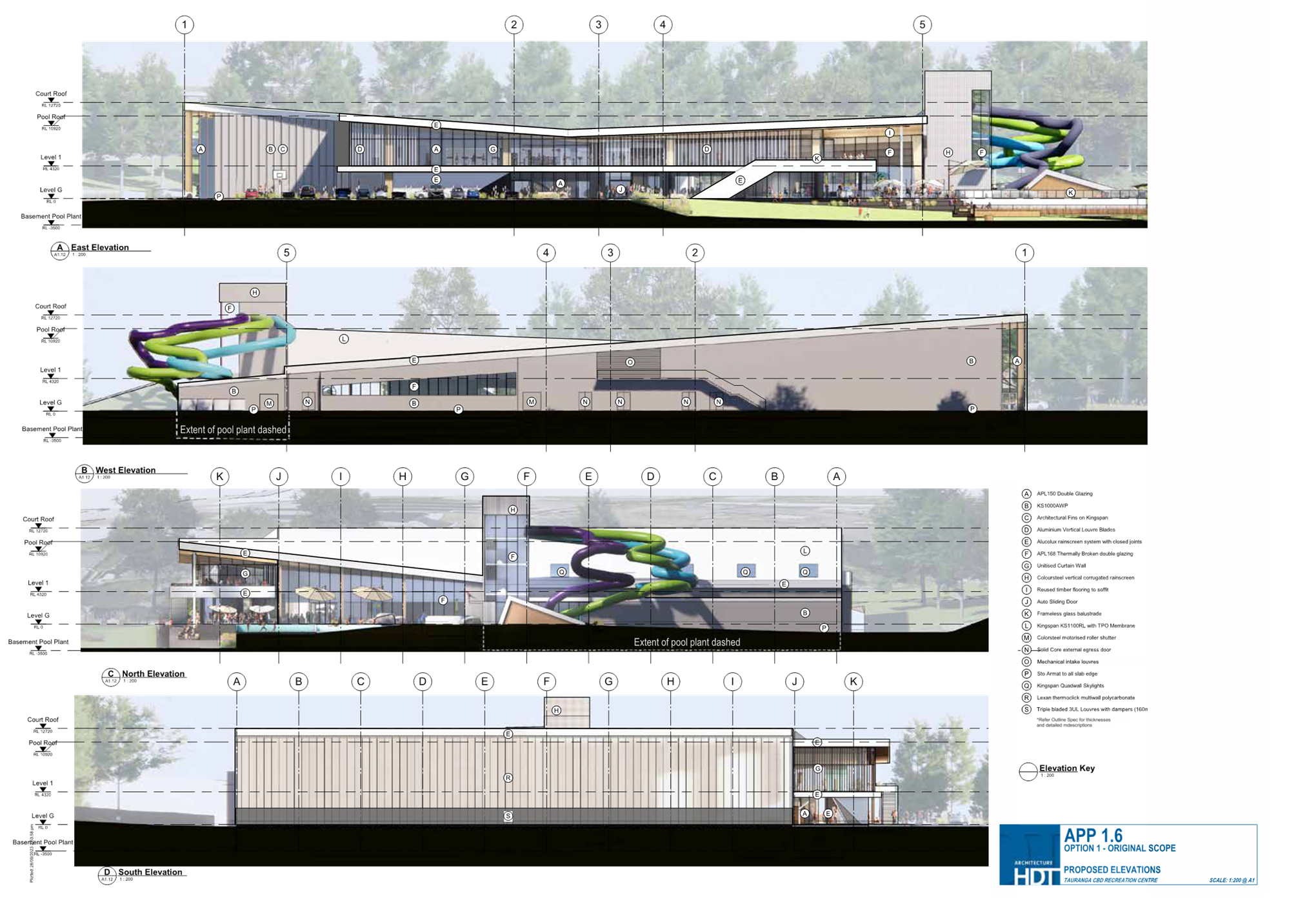
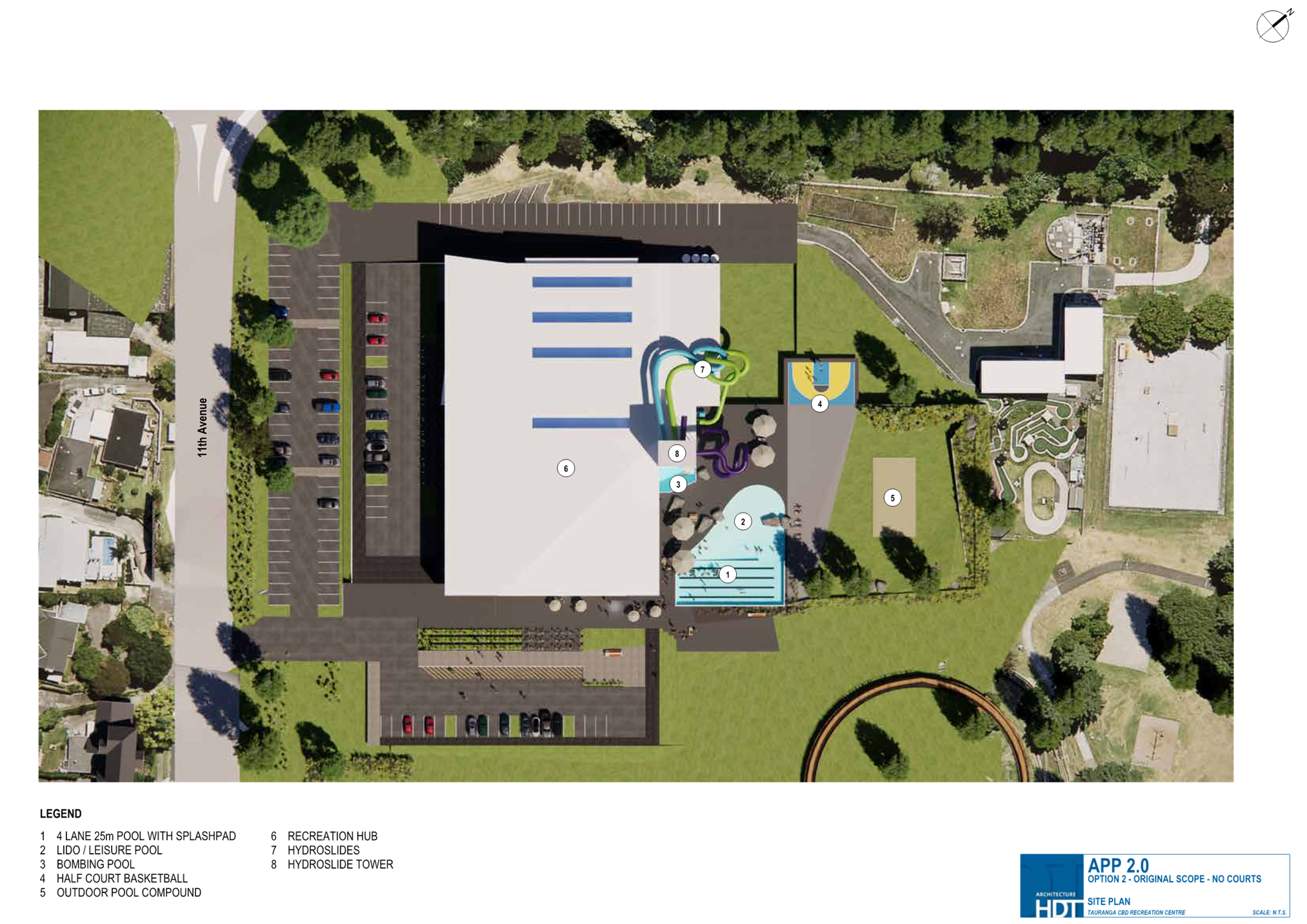
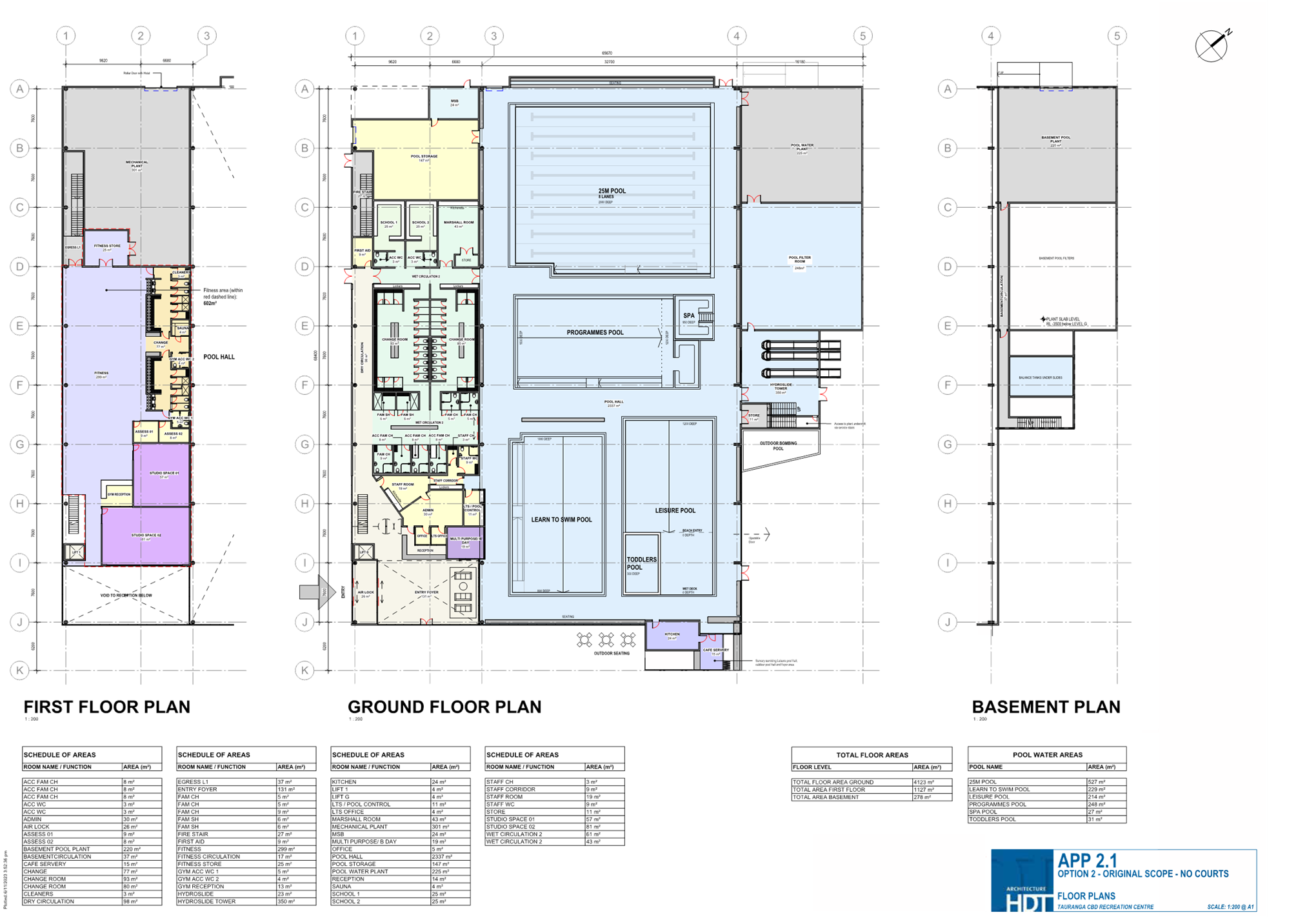
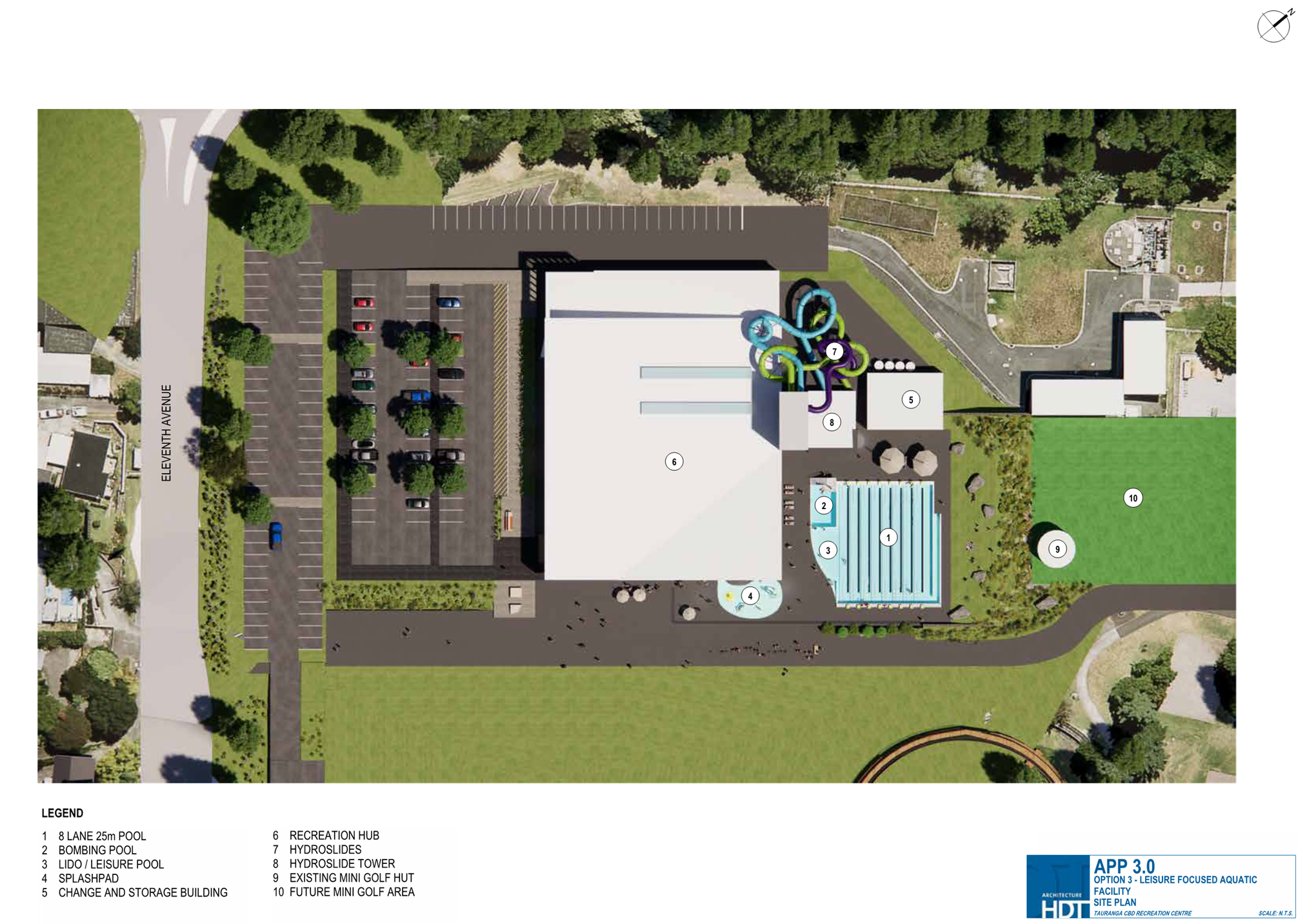


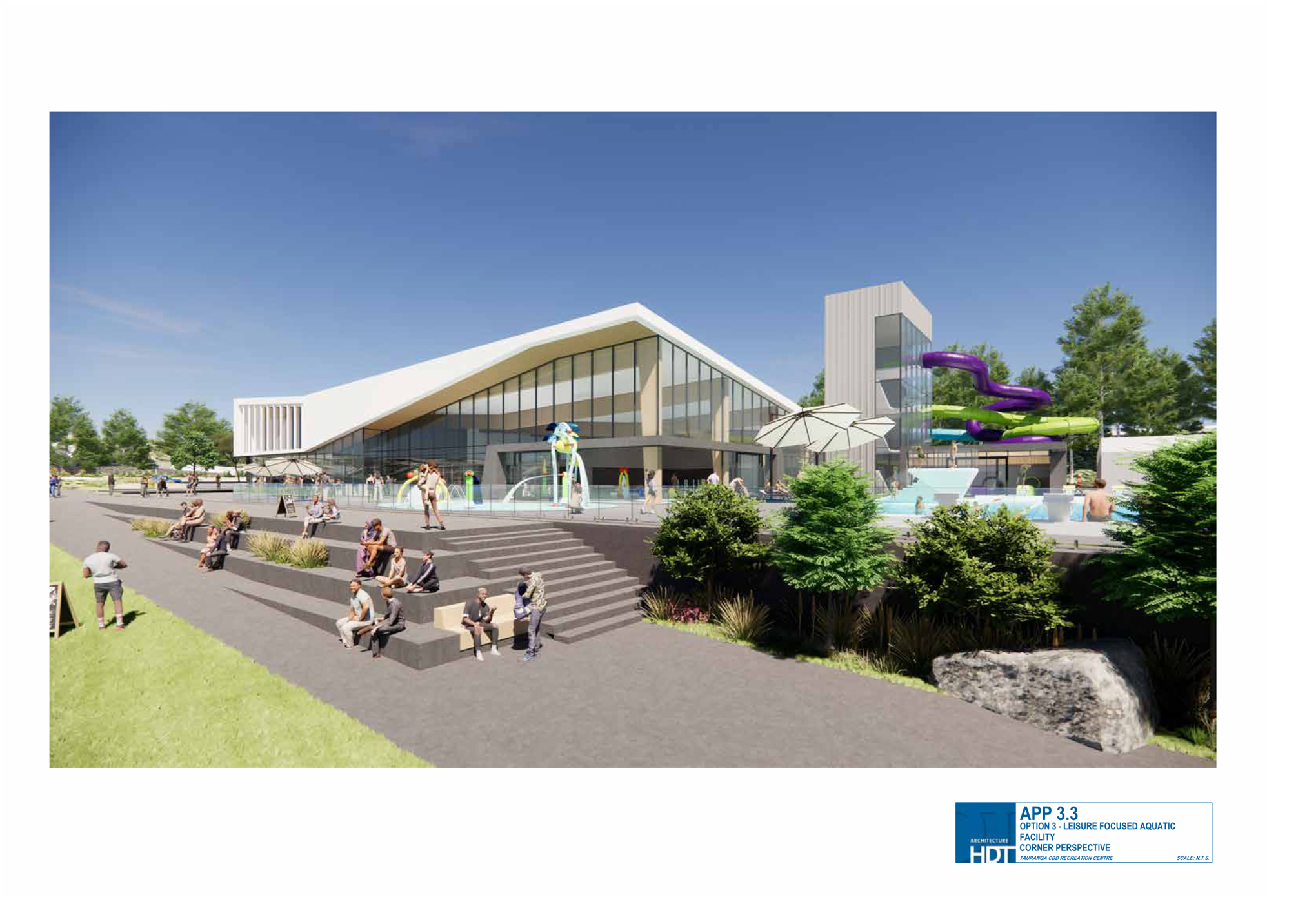
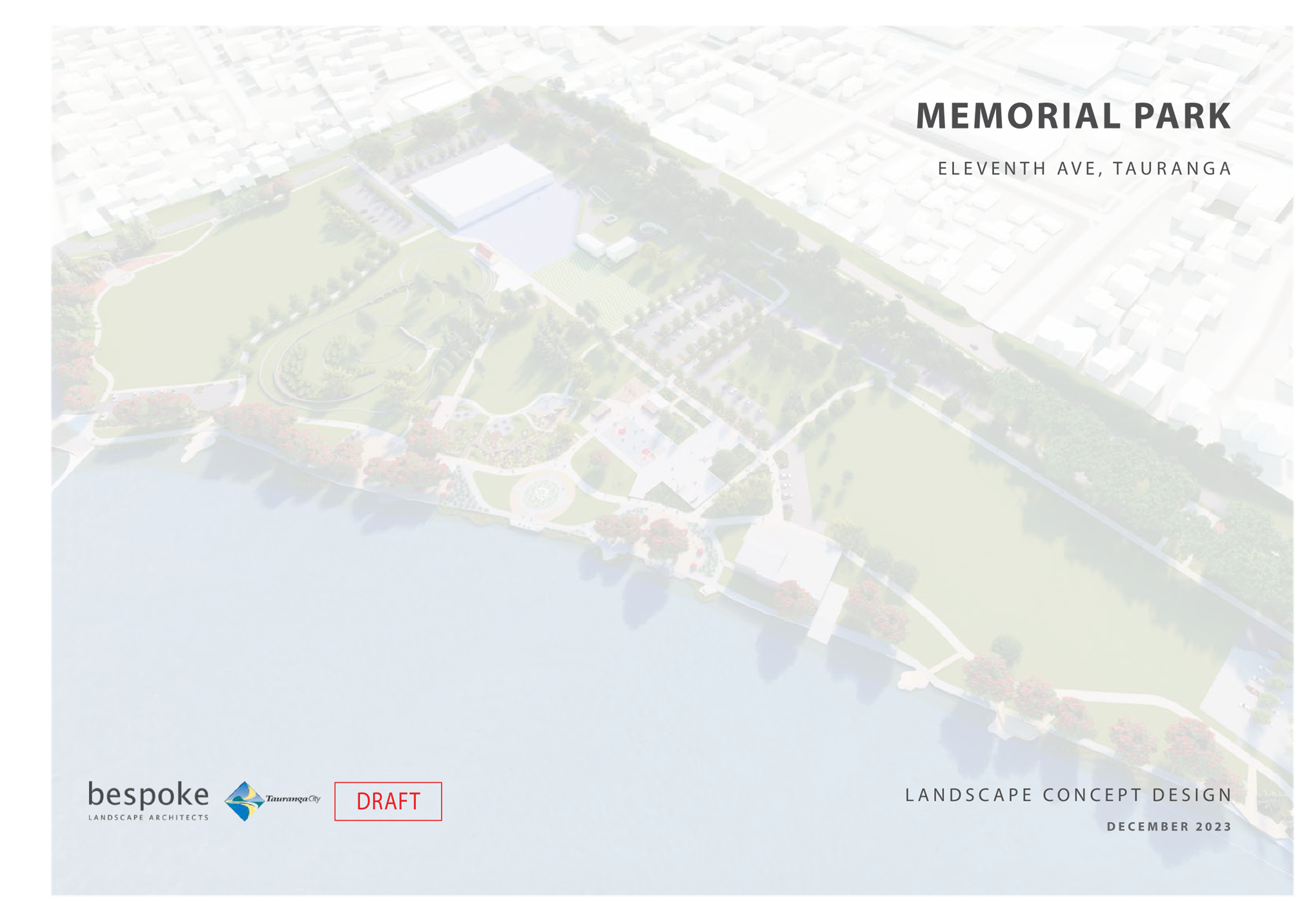
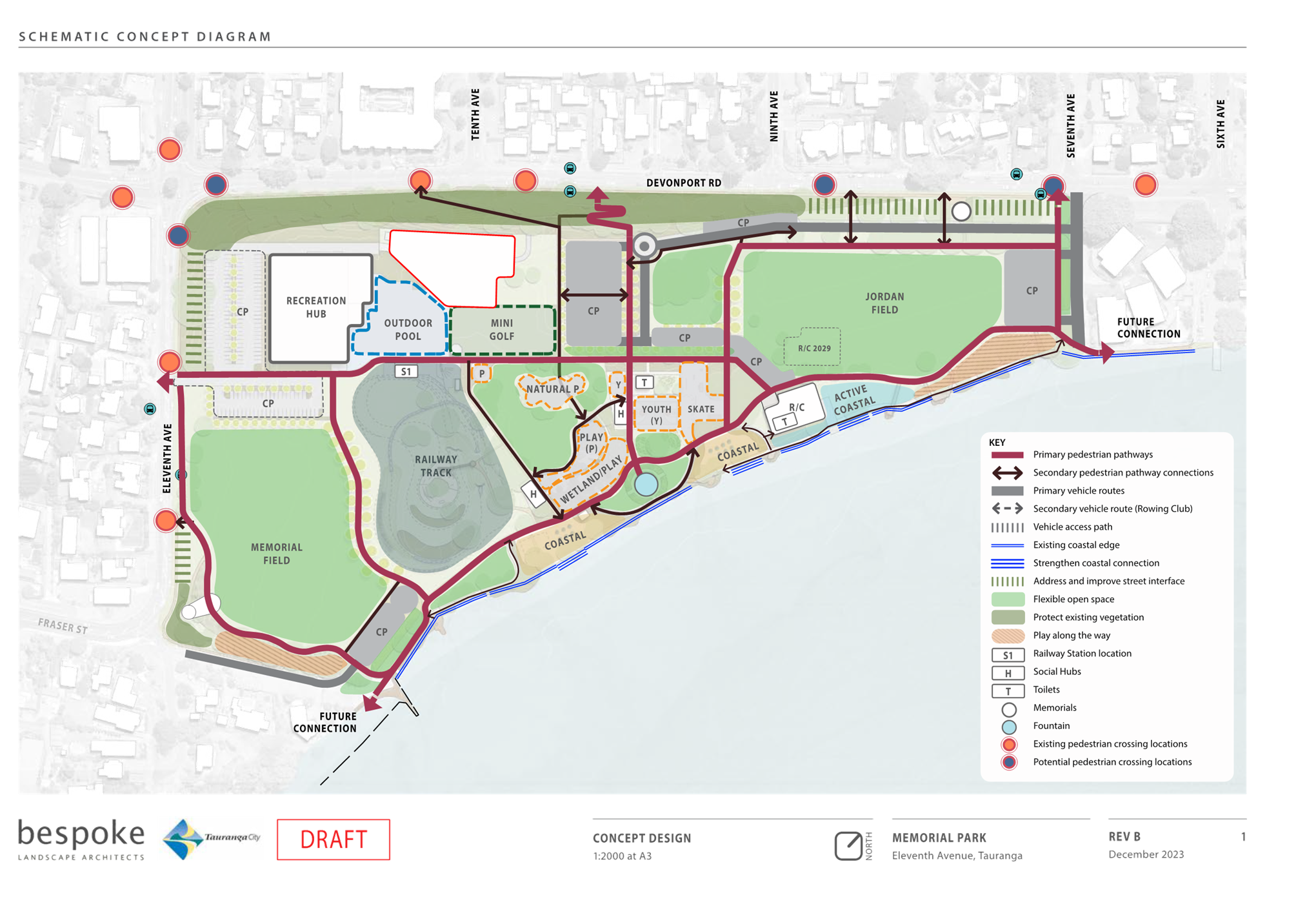
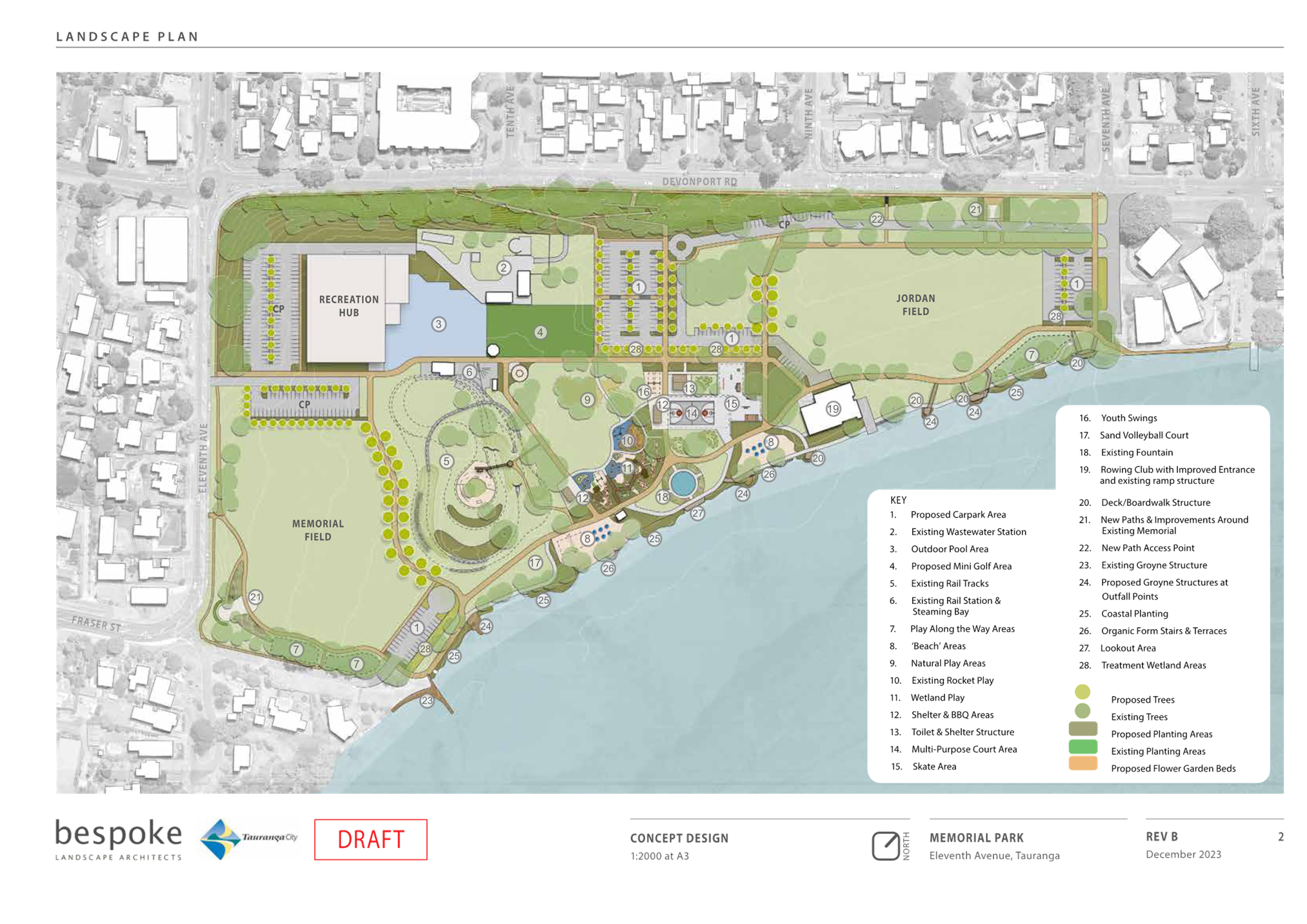
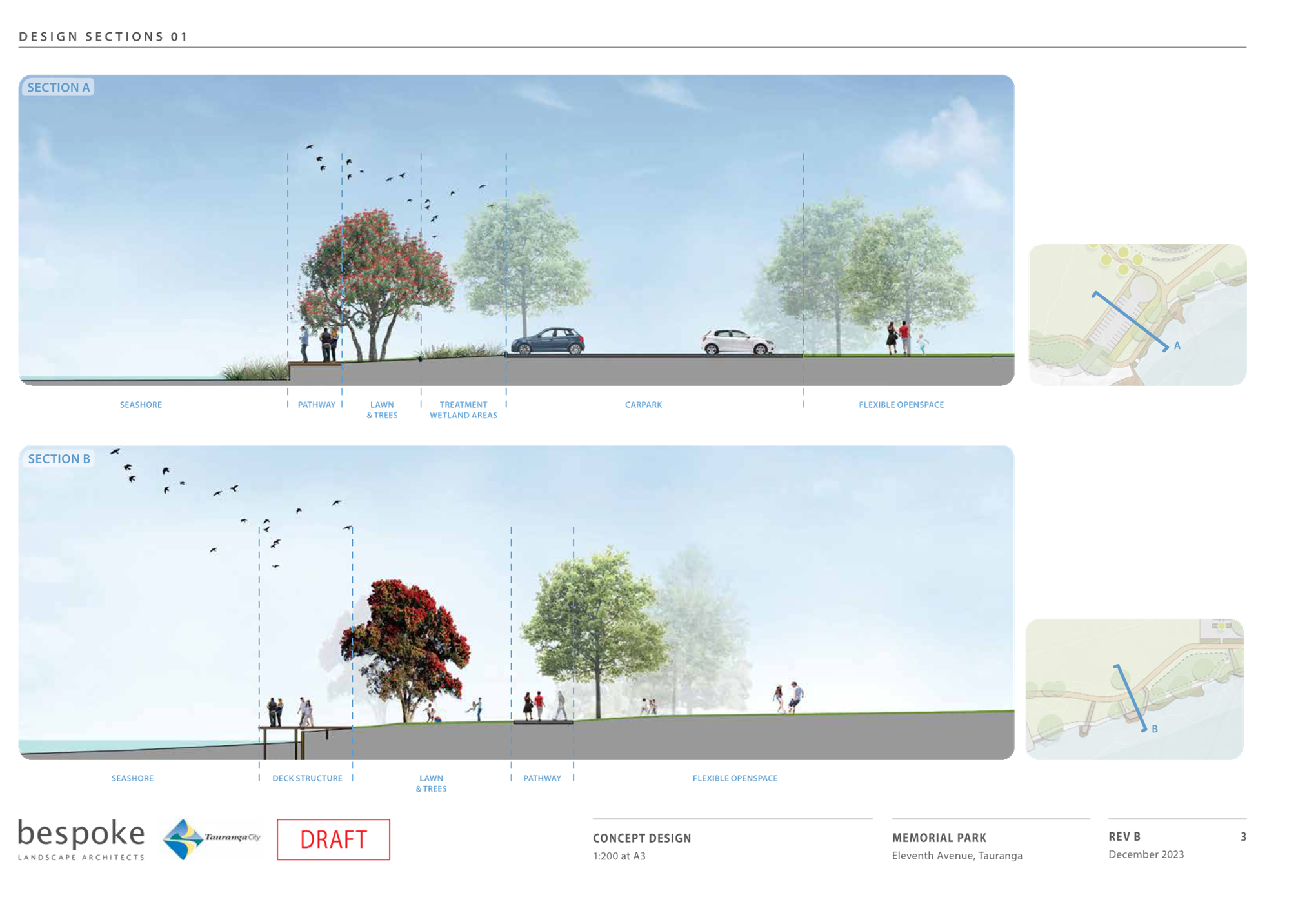

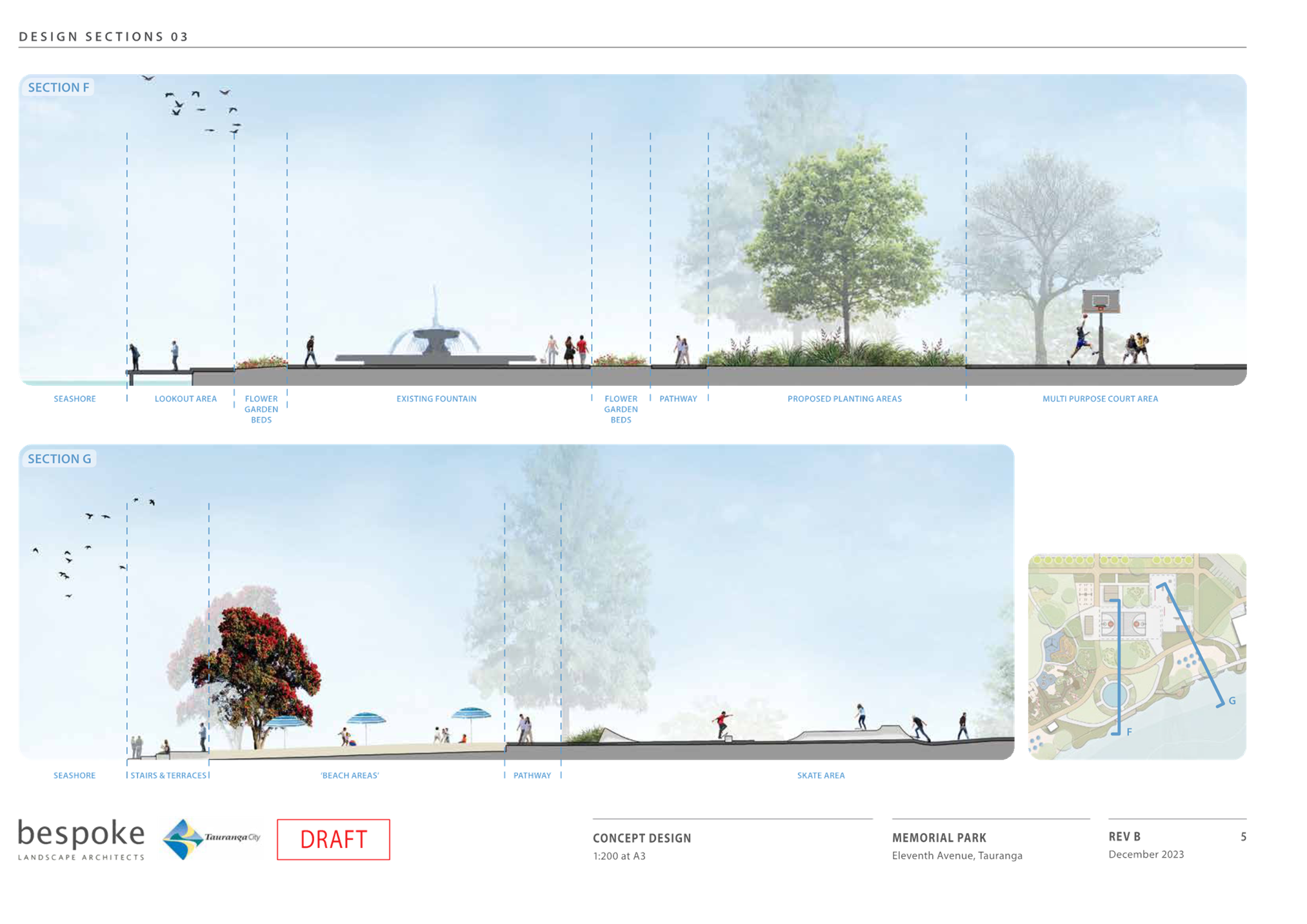
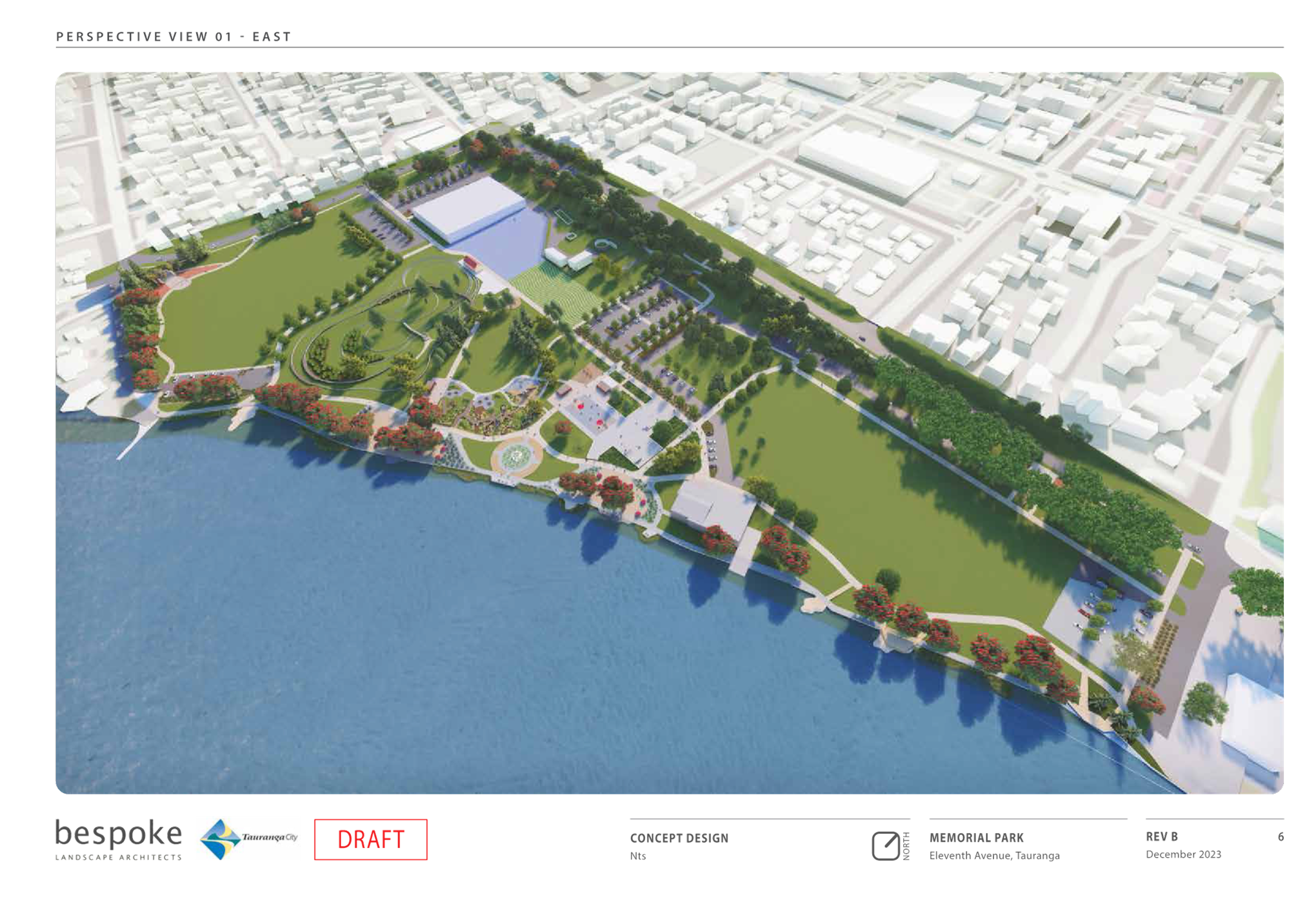
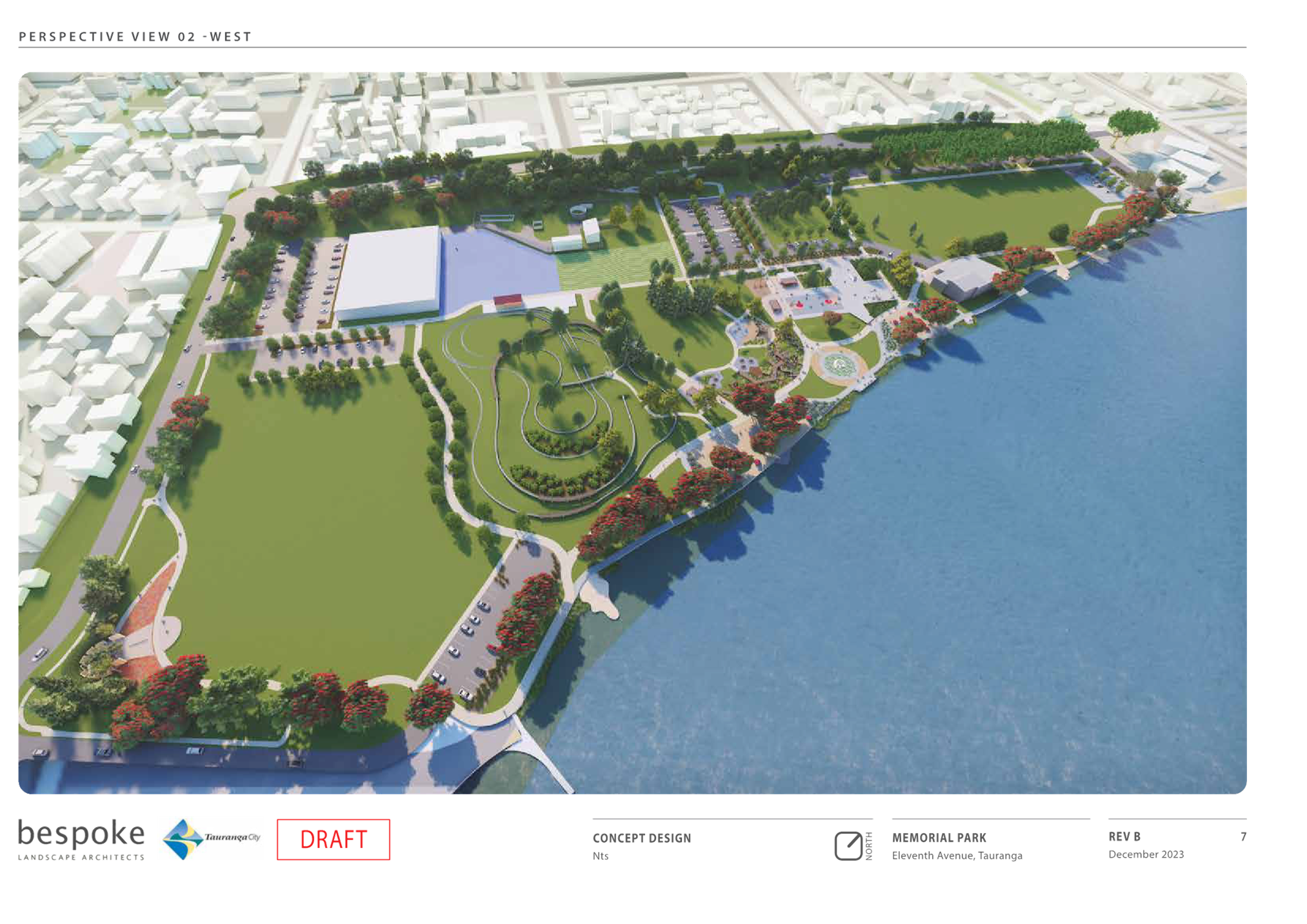
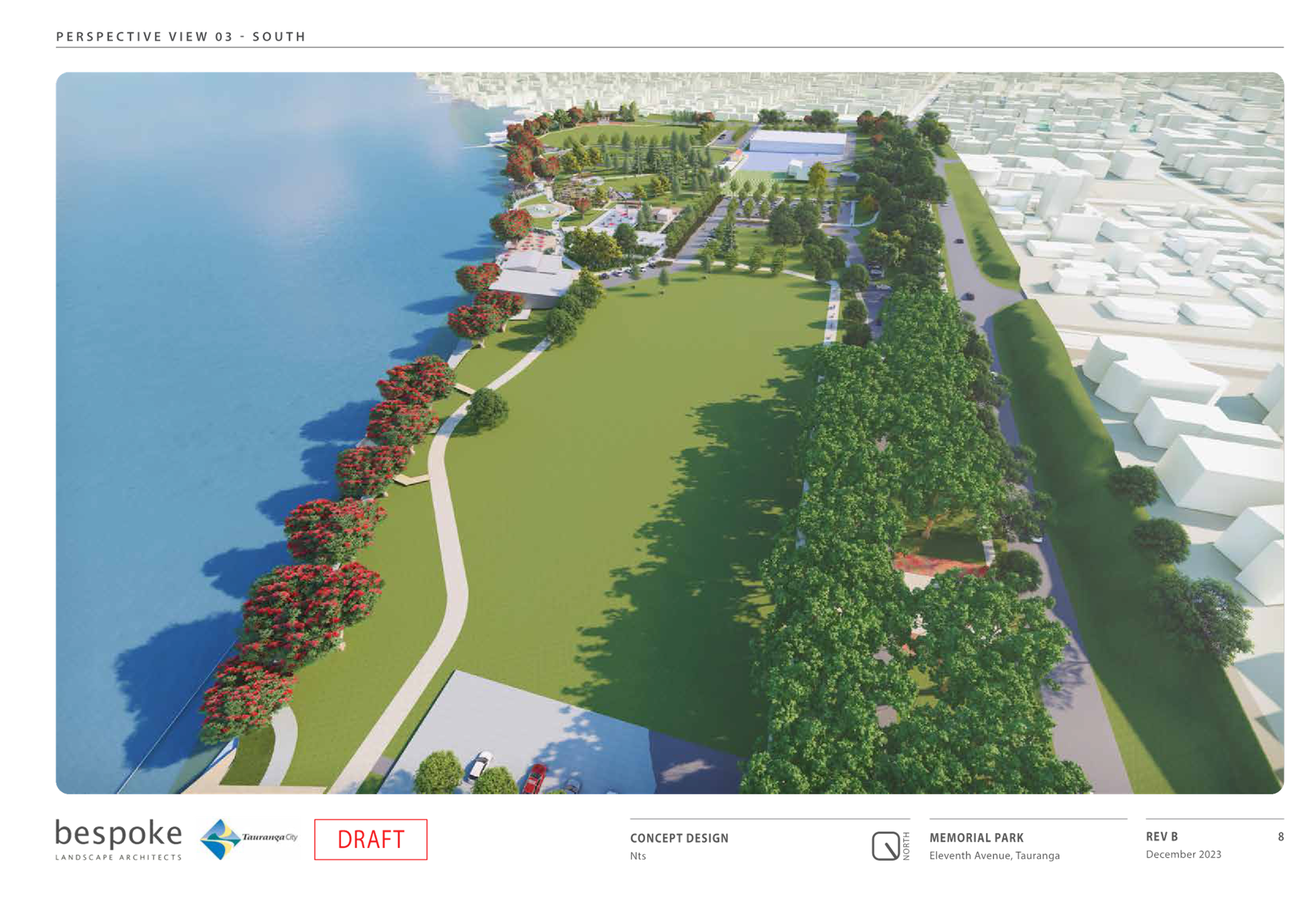
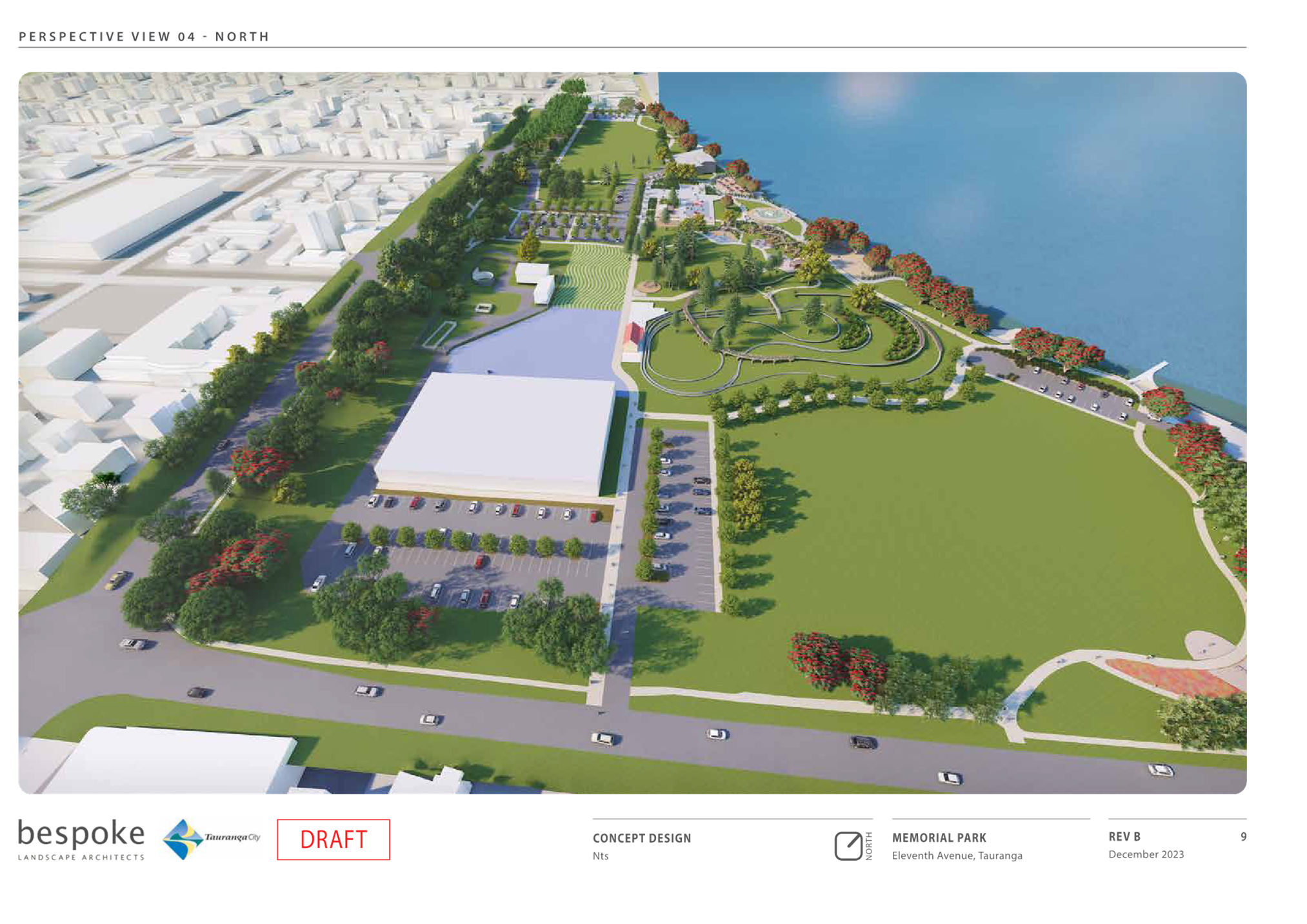
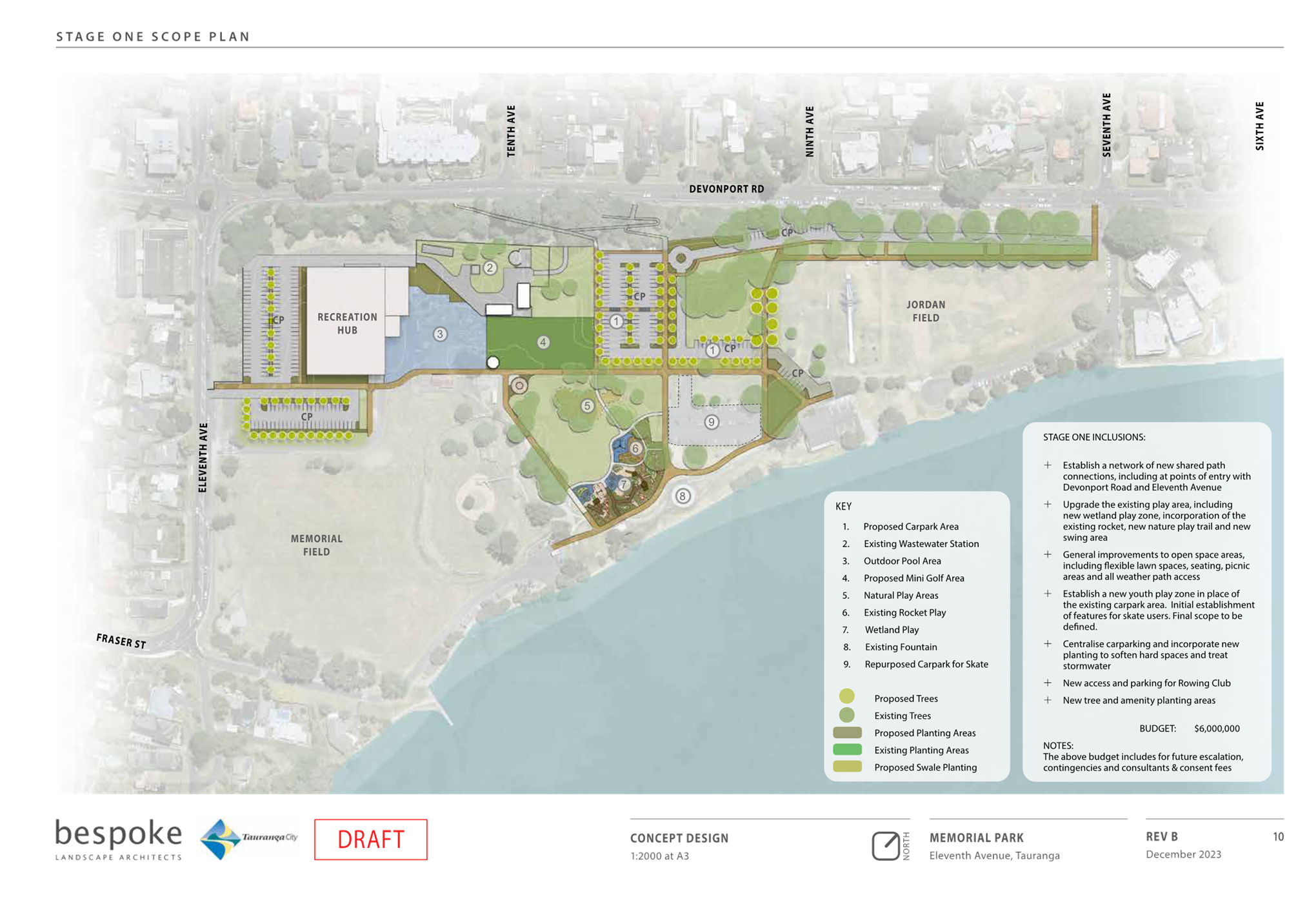
|
Ordinary
Council meeting Agenda
|
11
December 2023
|
11.14 Approval
of Memorial Park Site Development Plan
File
Number: A15338615
Author: Alison
Law, Manager: Spaces & Places
Amanda Davies,
Manager: Spaces and Places Project Outcomes
Authoriser: Barbara
Dempsey, General Manager: Community Services
Purpose of the Report
1. To present the Memorial
Park Spatial Plan and implementation as part of the Memorial Park Aquatic
Centre Programme.
|
Recommendations
That the Council:
(a) Receives the report
"Approval of Memorial Park Site Development Plan";
(b) Endorses the long-term
spatial plan for Memorial Park; and
(c) Approves upgrades to Memorial
Park at a cost of $6 million, in line with the spatial plan.
|
Executive Summary
2. The redevelopment of
the Queen Elizabeth Youth Centre and the Memorial Park Pool, together with the
need to renew the playground at Memorial Park, provided an opportunity to
develop a long-term Spatial Plan (the Spatial Plan) for the whole park that
will deliver improvements to the reserve in a coordinated and staged manner.
3. This report
recommends Council endorses the Spatial Plan (Attachment 1) and approves
upgrades to Memorial Park in line with the spatial plan and the Memorial Park
Aquatic Centre development, at a cost of $6 million (Attachment 2).
Background
Memorial Park Spatial Plan
4. The Tauranga
Reserves Management Plan (TRMP) categorises Memorial Park as a high profile
reserve that provides for a range of activities, in particular opportunities
for both formal and informal play, social gathering, and access to water.
However, the TRMP notes that the park’s “visual quality does not
truly reflect the status of the park”. The development of a Spatial Plan
is one of the management statements contained in the TRMP.
5. Memorial Park is
classified as a recreation reserve under the Reserves Act 1977 and as noted
above is categorised as a high profile reserve in the TRMP. The TRMP describes
Memorial Park as a “key large recreational open space for Tauranga
residents and visitors”.
6. Implementation of
the Spatial Plan addresses many of the management statements for the park
contained in the TRMP. In particular, the Spatial Plan seeks to improve
connectivity through the park, limit further car parking on Jordan Field, and
“reinforce the park’s historic purpose as a community focused
gathering place”.
7. The Play, Active
Recreation and Sport Action and Investment Plan (Play AIP) identifies Memorial
Park as a destination play space that people would travel to and stay for an
extended period. The Play AIP includes an action to invest in a plan that
considers how the park interfaces with the Memorial Park Aquatic Centre
(Aquatic Centre) and includes opportunities for play beyond just the
redevelopment of the playground.
8. The large open
fields and the park’s proximity to the water make it highly valued by
residents and whānau for informal social gathering. The Spatial Plan
preserves the open space for large gatherings and provides associated
infrastructure such as car parking, barbecues, toilets and seating.
9. The Spatial Plan
provides for a truly high-profile reserve including; improved open space areas
and associated infrastructure; improved options for youth and play; movement
via shared paths through the park; improved access to the water; renewal of the
fountain including pathways and gardens surrounding the fountain and upgrades
to the model railway area through increased planting and pathways. It is
recommended that Council endorse this option as the long-term plan for the
park.
10. The implementation of the
Spatial Plan over time will ensure that improvements to the park are befitting
of its high profile status and provide for a unique play experience.
11. Spaces and Places officers have
worked alongside the project team delivering the concept design for the Aquatic
Centre. The Spatial Plan provides for the Aquatic Centre to be a key element of
Memorial Park and enables quality outcomes to be achieved across the whole park
over the long term.
Implementation
12. The proposed upgrades to
Memorial Park at a cost of $6m, alongside the Aquatic centre development,
includes:
· Network
of new shared path connections, including points of entry with Devonport Road
and Eleventh Avenue
· An
upgrade of the existing play area, including a wetland play zone, new nature
play trail and a new swing area
· Improvements
to open space areas, including lawn spaces, seating, picnic areas and all
weather path access
· New
youth play zone including initial establishment of features for skate users
· Centralised
carparking with planting
· New
tree and amenity planting areas
13. Early concepts for the unique
play experience at Memorial Park suggest additional natural play areas that
acknowledge the area’s previous ecological function and coastal
environment. The intention is this play experience is complementary to the play
experience on the waterfront.
14. Youth play will be catered for.
This is consistent with the aim of the Play AIP to increase opportunities for
rangatahi to engage in play to address the low number of Bay of Plenty
rangatahi engaging in recommended amount of physical activity. (Community
feedback is also supportive of increasing play options for older children).
Financial Considerations
15. The proposed project cost of $6
million was included through the draft budget for the wider Memorial Park
programme included in the draft Long-term Plan 2024-34.
Legal Implications / Risks
16. The renewal of the current
playground is required as it is at the end of its useful life. There is a
potential safety risk if not renewed promptly.
17. The Spatial Plan assumes the
renewal of leases for Tauranga Model Marine and Engineering (the model railway)
and the mini golf facility. The renewal of these leases is subject to further
negotiation and agreement with the lessees. As both leases are foreseen in the
TRMP, there is no requirement for further public consultation on the lease
renewal. There are no other legal implications arising from the recommended options.
Consultation / Engagement
18. The redevelopment of Memorial
Park has been considered and consulted on through several statutory processes
including the aforementioned TRMP and AIPs. Options for the development of the
park and the Spatial Plan have been considered through the wider Memorial Park
project. This has included hui with mana whenua and representatives of key
stakeholders.
19. In particular, mana whenua have
been involved in the development of specific cultural design drivers for
Memorial Park. These include recognition of the area’s historic use as a
place to gather and provide safe anchorage. These design drivers will be
further refined and incorporated into the wider Memorial Park programme as the
design and development progresses.
20. Te Rangapū Mana Whenua o
Tauranga Moana have previously noted the role of Memorial Park in providing a
range of free activities and being large enough for whānau to host gatherings.
21. Informal public feedback has
been supportive of retaining the mini golf and model railway.
Significance
22. The Local Government Act 2002
requires an assessment of the significance of matters, issues, proposals and
decisions I n this report against Council’s Significance and Engagement
Policy. Council acknowledges that in some instances a matter, issue,
proposal or decision may have a high degree of importance to individuals,
groups, or agencies affected by the report.
23. In making this assessment,
consideration has been given to the likely impact, and likely consequences for:
(a) the current
and future social, economic, environmental, or cultural well-being of the
district or region
(b) any persons who are likely to be
particularly affected by, or interested in, the decision.
(c) the capacity of the local authority to
perform its role, and the financial and other costs of doing so.
24. In accordance with the
considerations above, criteria and thresholds in the policy, it is considered
that the decision is of medium significance.
ENGAGEMENT
25. Taking into consideration the
above assessment that the decision is of medium significance, officers are of
the opinion that no further engagement is required prior to Council making a
decision.
26. As we move through to detailed
design and implementation we will continue to engage with mana whenua and
representatives of key stakeholder groups.
Next Steps
27. Subject to approval at this
meeting, staff will progress the development and implementation. The construction
timeline is dependent on the Aquatic Centre development.
Attachments
1. Attachment
1 Memorial Park Spatial Plan - A15369439 ⇩ 
2. Attachment 2
Memorial Park Implementation - A15363507 ⇩ 
|
Ordinary
Council meeting Agenda
|
11
December 2023
|
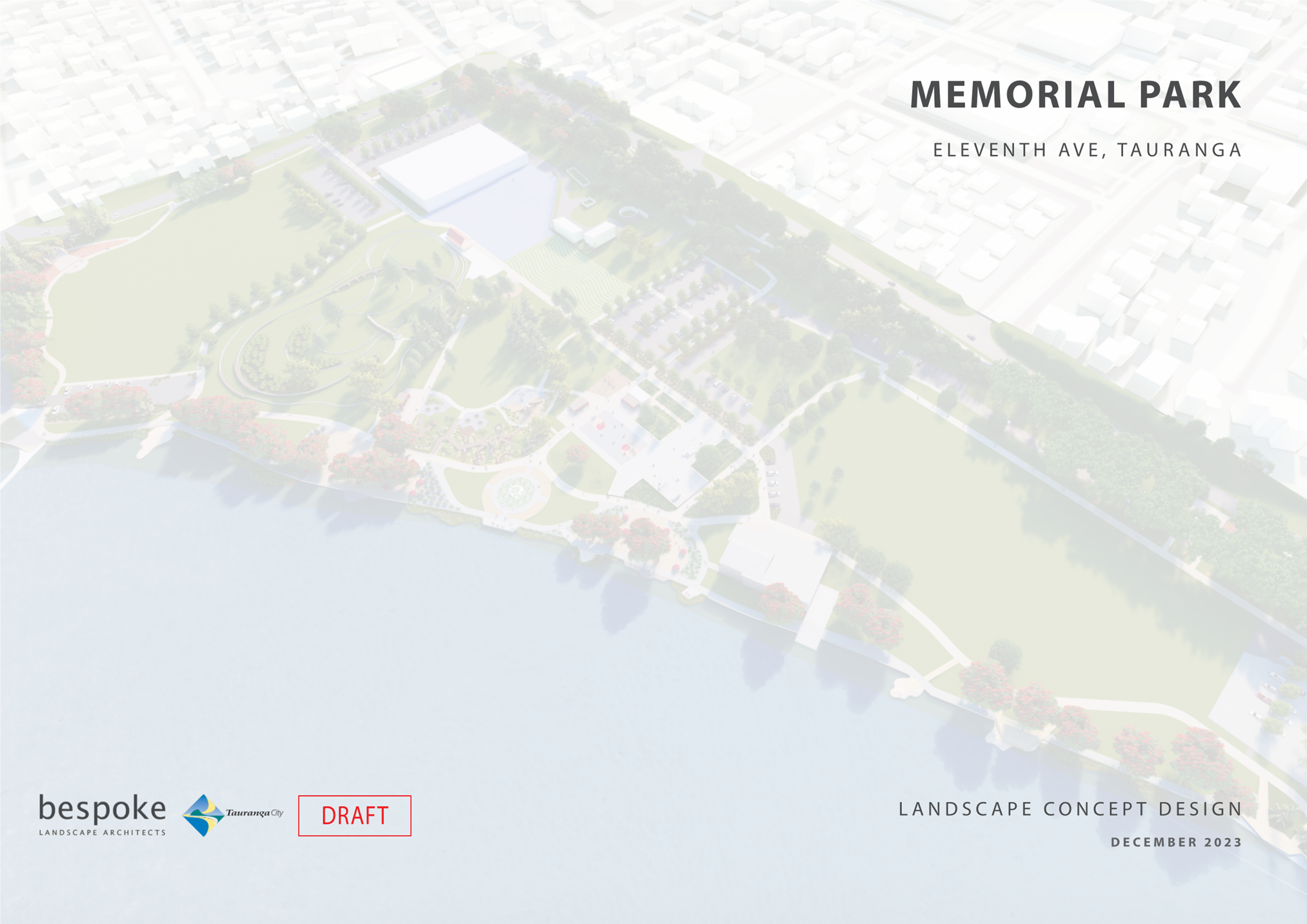

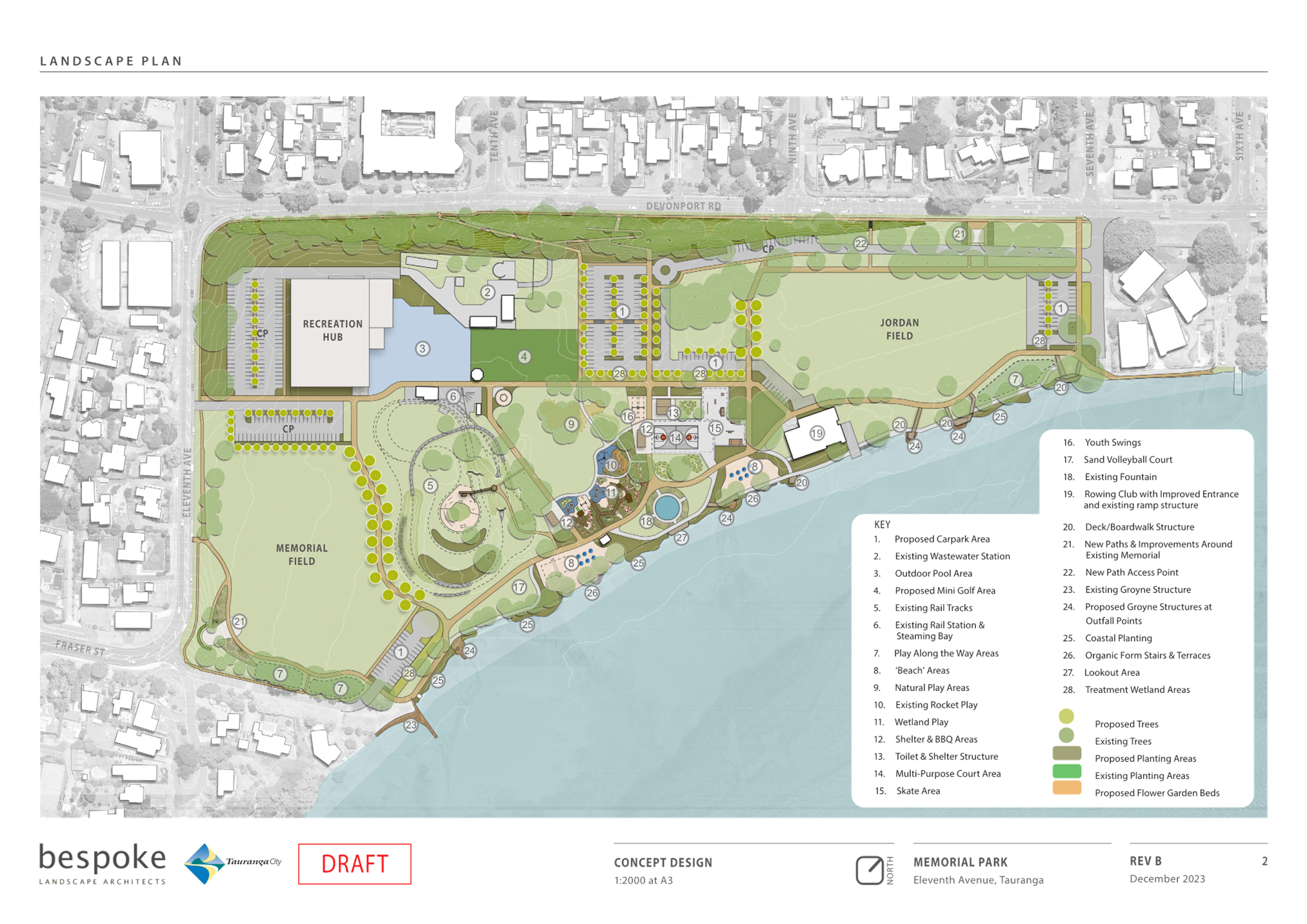
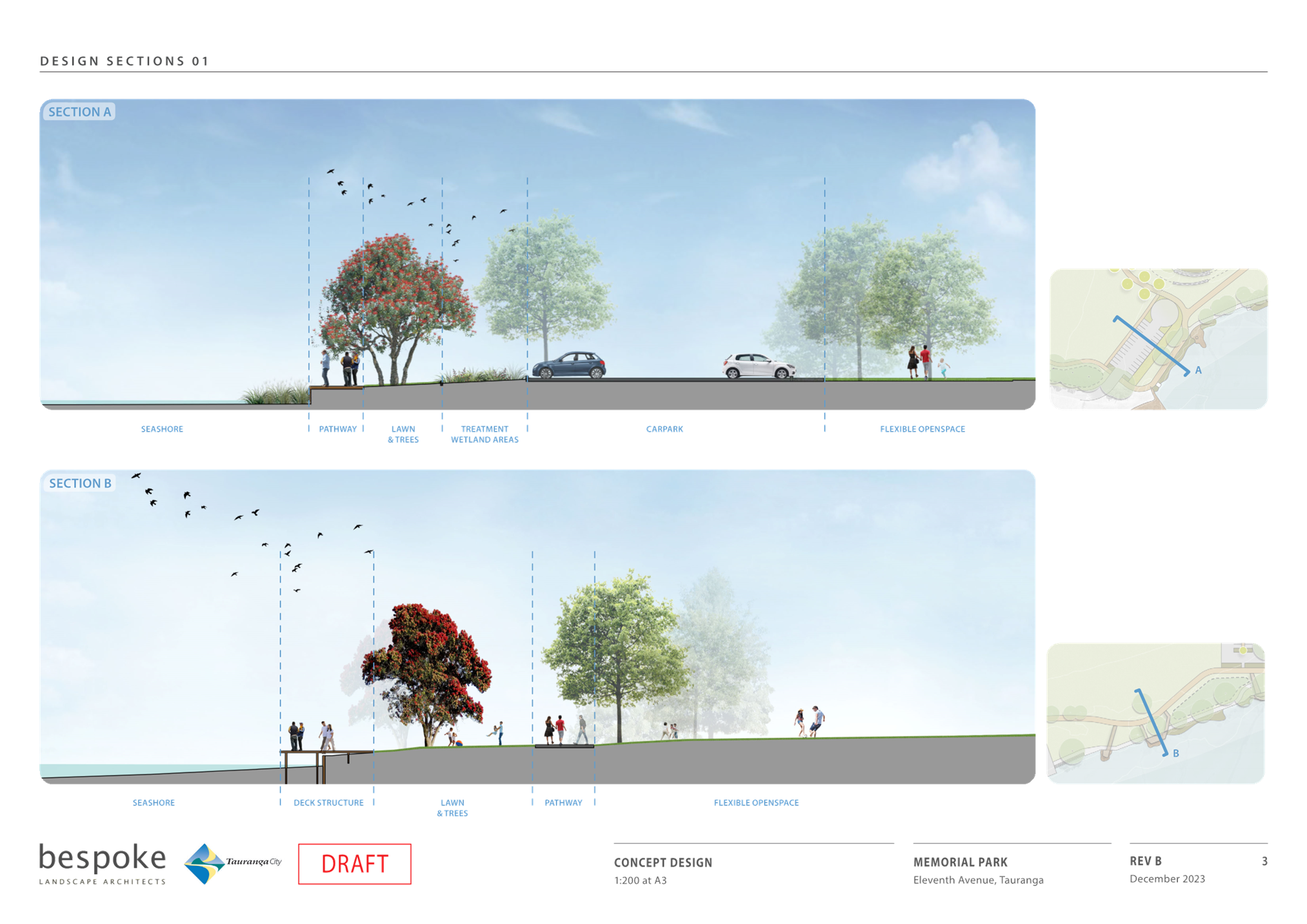
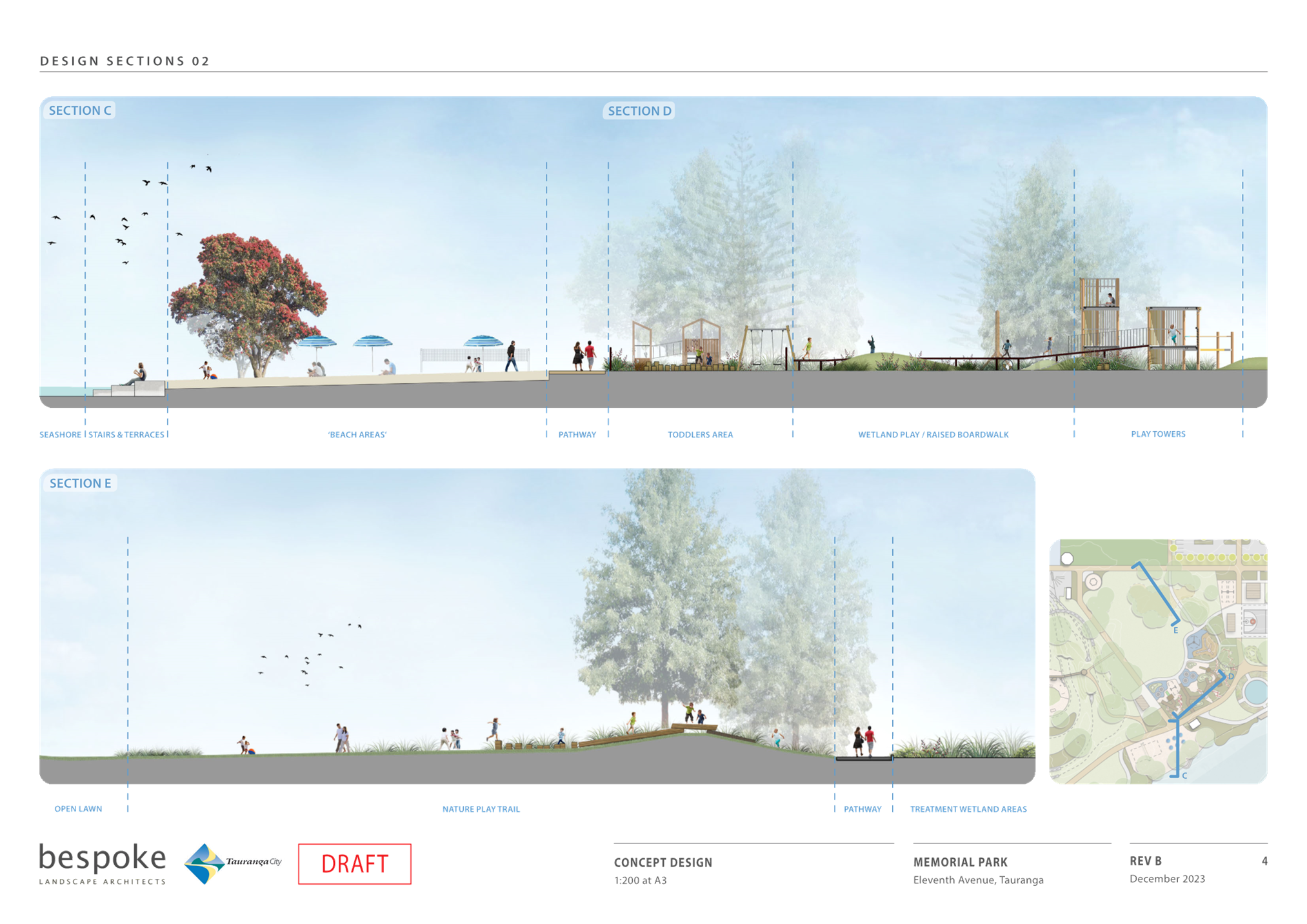
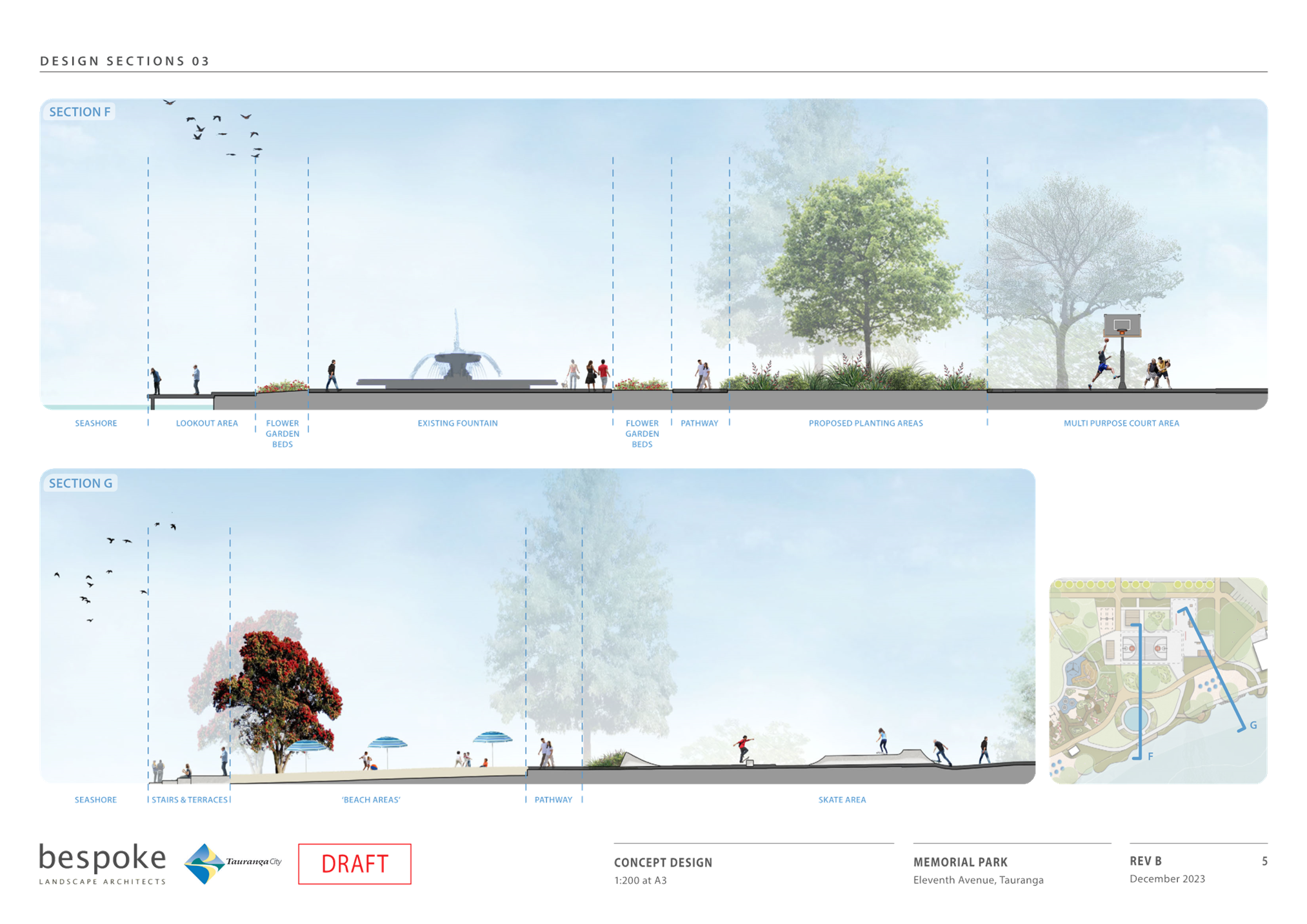
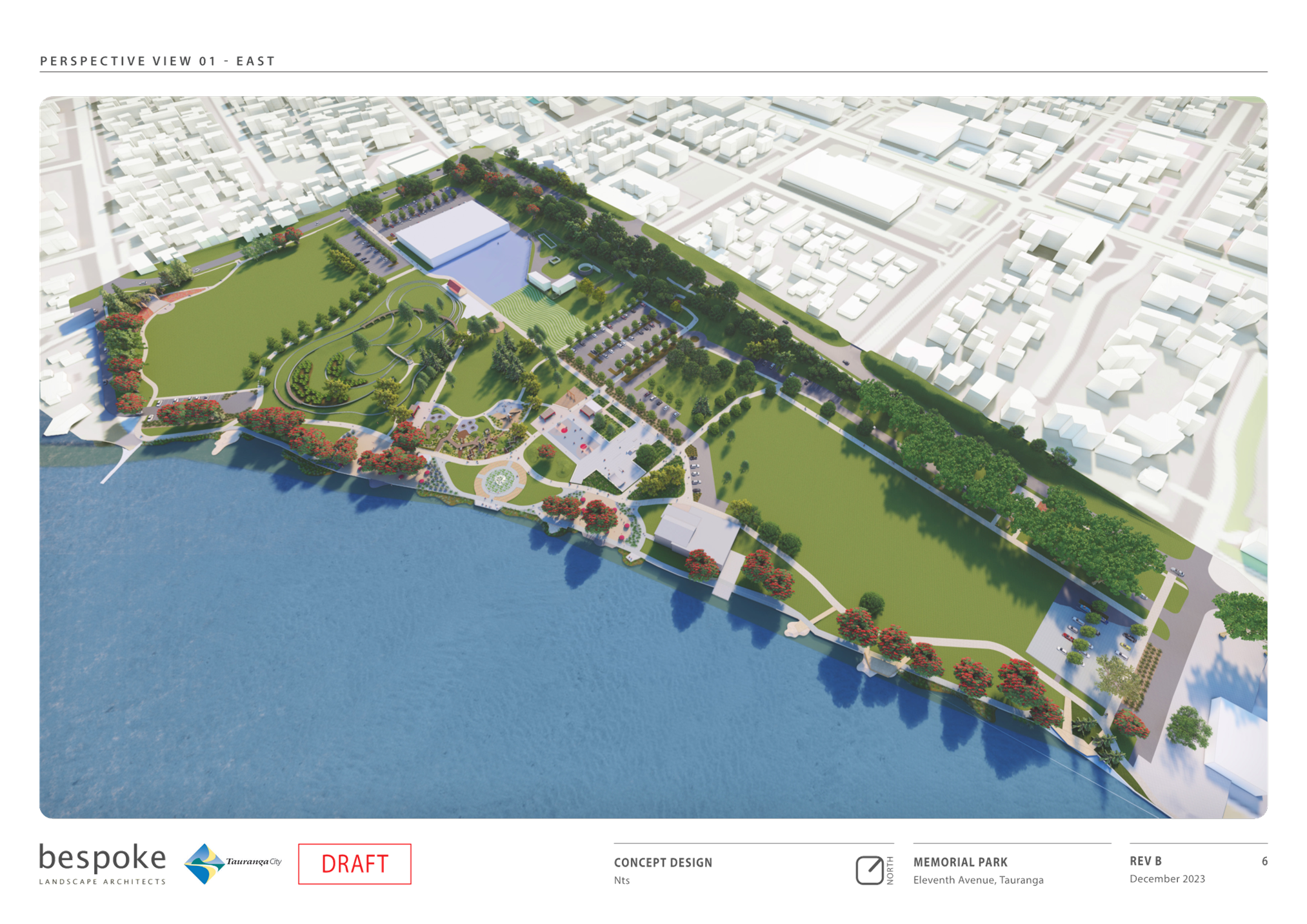

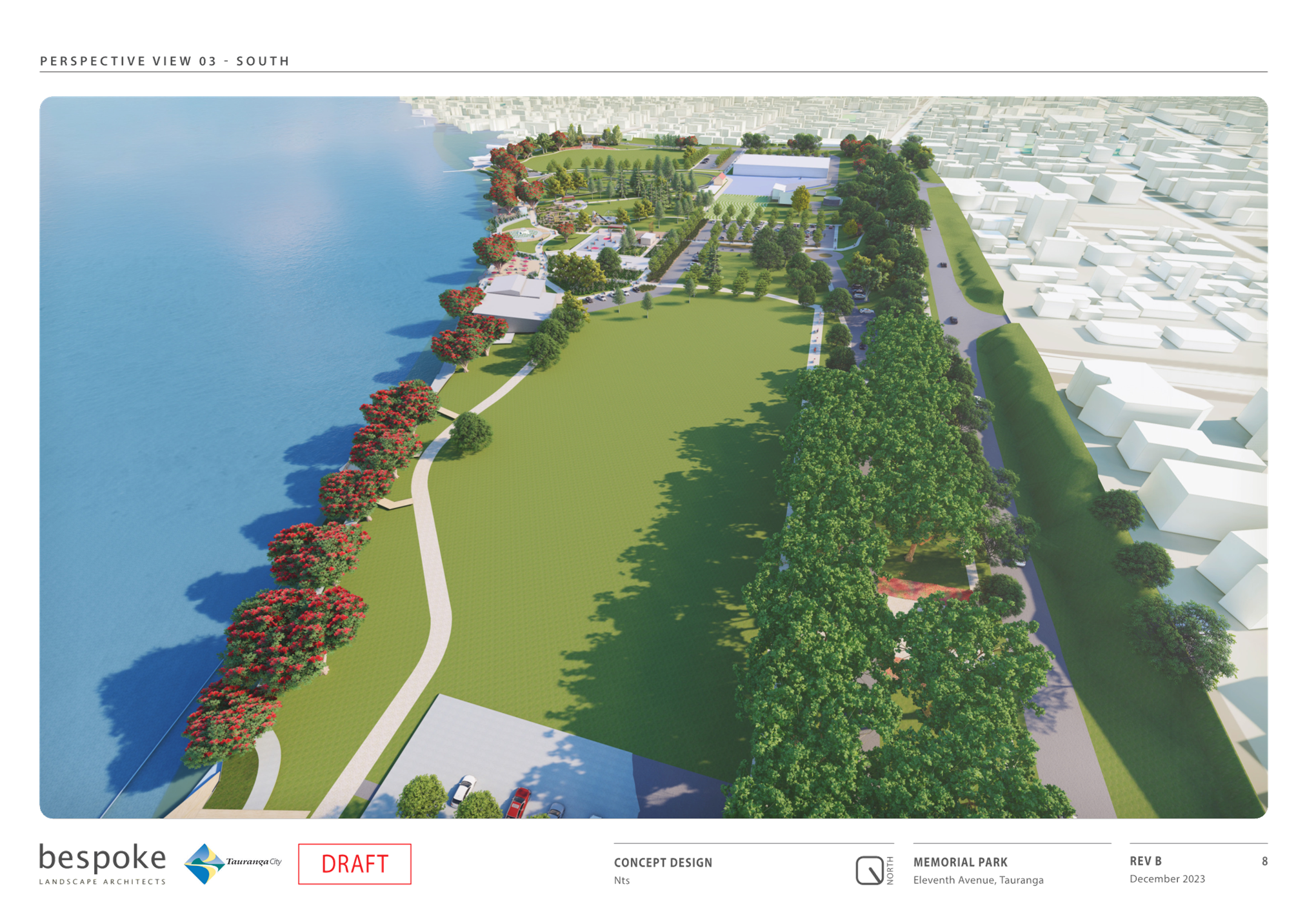
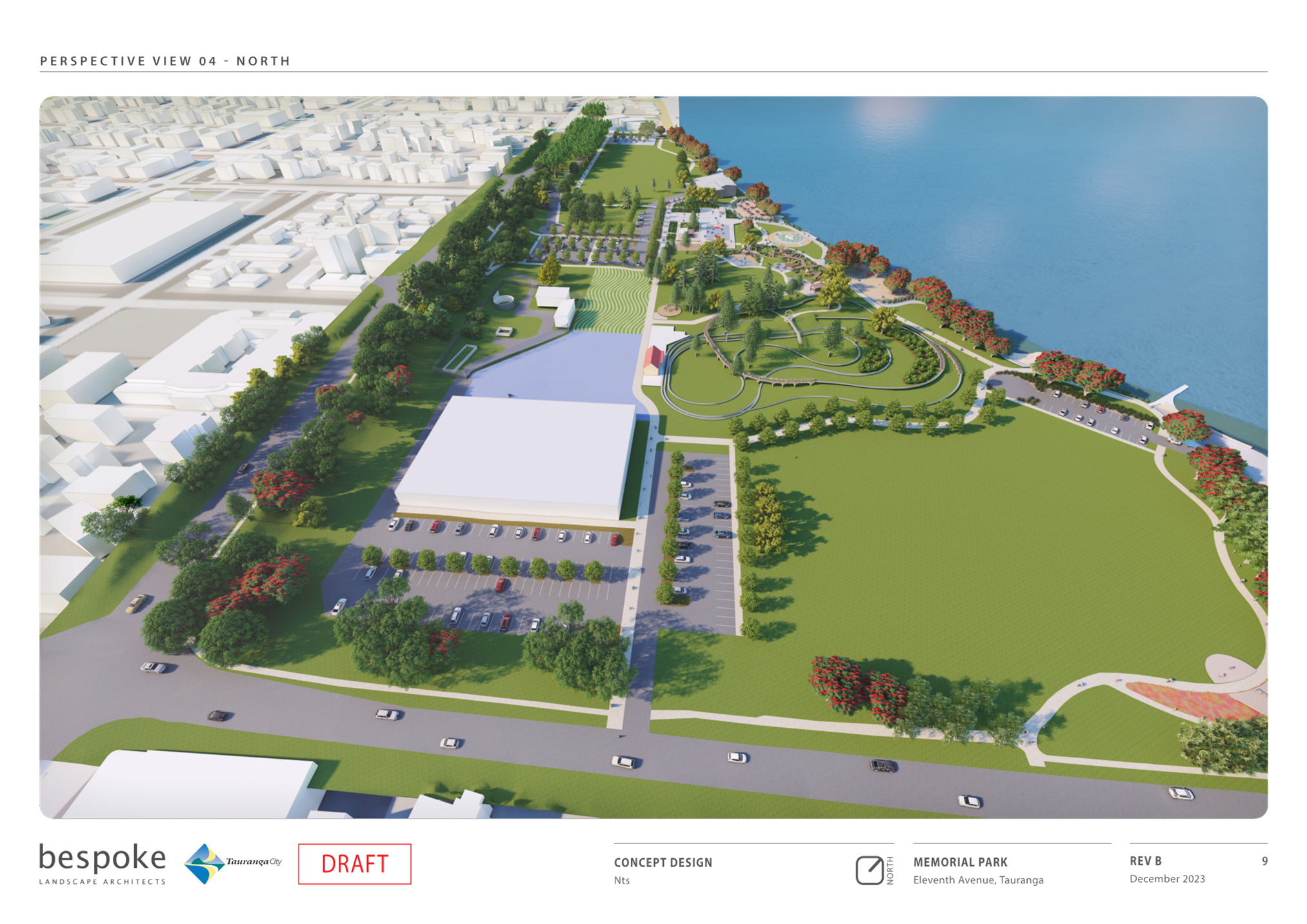
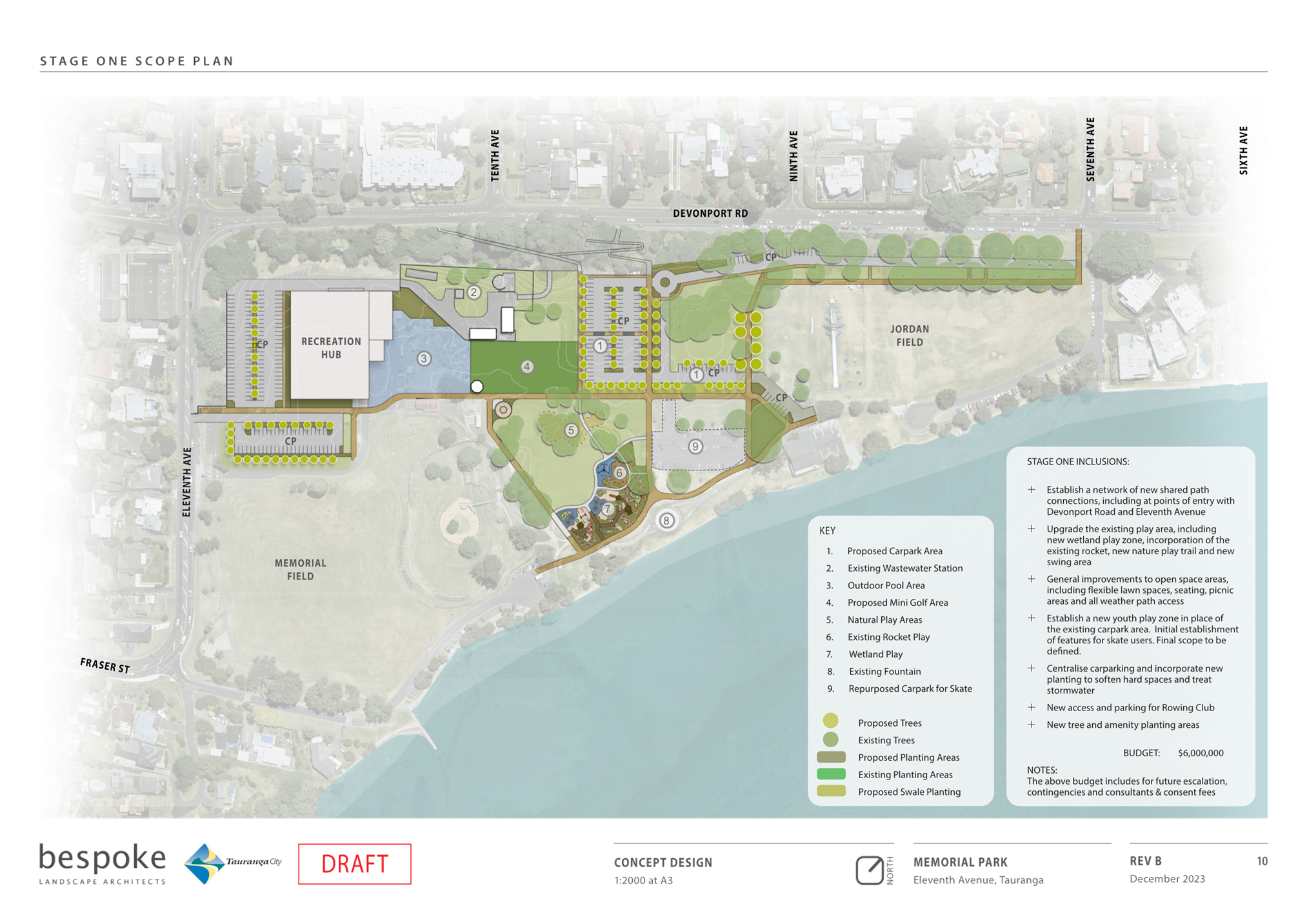
|
Ordinary
Council meeting Agenda
|
11
December 2023
|
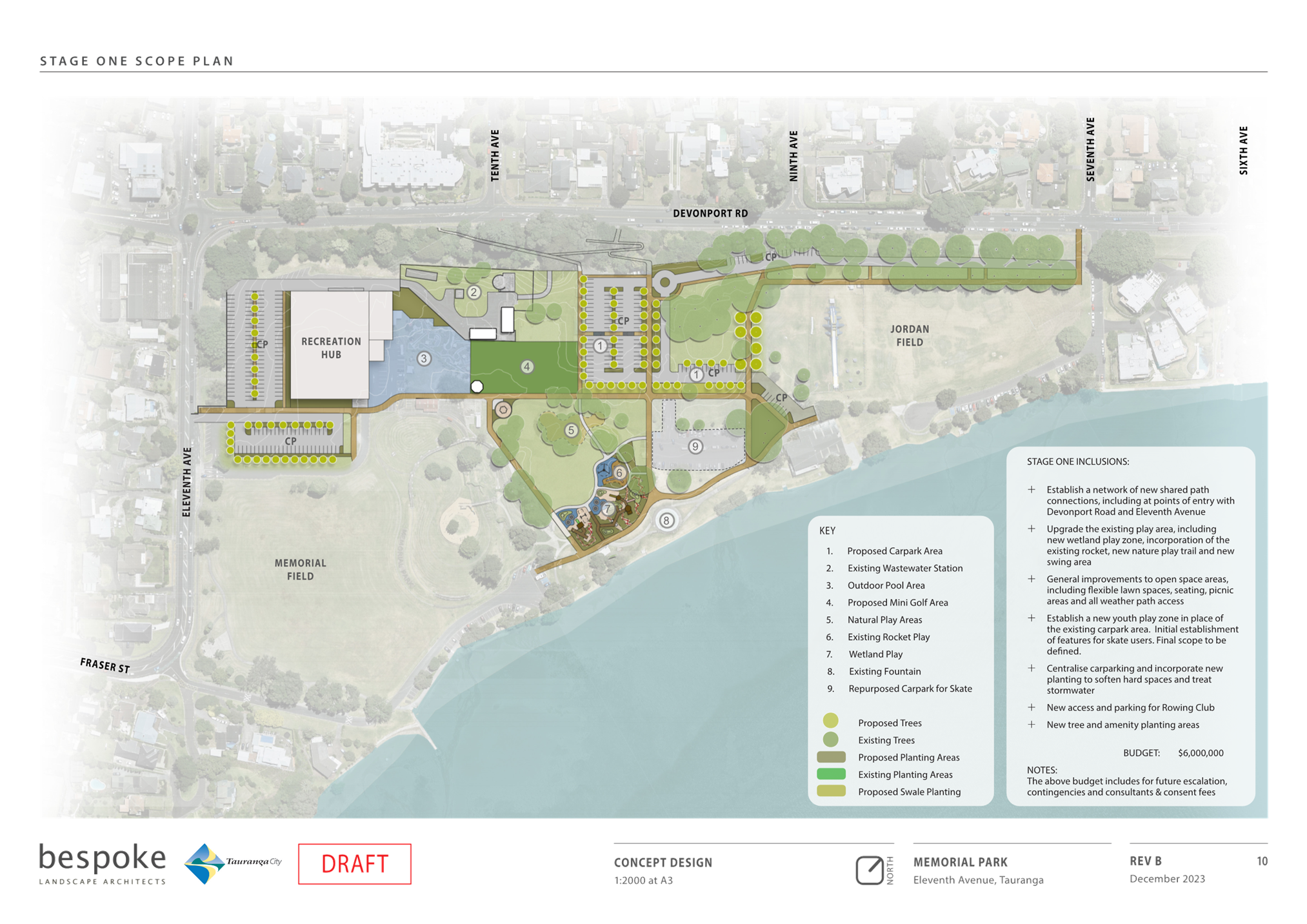
|
Ordinary
Council meeting Agenda
|
11
December 2023
|
13 Public
excluded session
Resolution to exclude
the public
|
Recommendations
That the public be
excluded from the following parts of the proceedings of this meeting.
The general subject
matter of each matter to be considered while the public is excluded, the
reason for passing this resolution in relation to each matter, and the
specific grounds under section 48 of the Local Government Official
Information and Meetings Act 1987 for the passing of this resolution are as
follows:
|
General subject of each matter to be
considered
|
Reason for passing this resolution in
relation to each matter
|
Ground(s) under section 48 for the
passing of this resolution
|
|
13.1 - Strategic Property Purchase for
Memorial Park Recreation Hub Project
|
s7(2)(b)(ii) - The withholding of the information
is necessary to protect information where the making available of the
information would be likely unreasonably to prejudice the commercial
position of the person who supplied or who is the subject of the
information
s7(2)(i) - The withholding of the information is
necessary to enable Council to carry on, without prejudice or disadvantage,
negotiations (including commercial and industrial negotiations)
|
s48(1)(a) - the public conduct of the relevant
part of the proceedings of the meeting would be likely to result in the
disclosure of information for which good reason for withholding would exist
under section 6 or section 7
|
|
13.2 - Public Excluded Minutes of the
Council meeting held on 27 November 2023
|
s7(2)(a) - The withholding of the information is
necessary to protect the privacy of natural persons, including that of
deceased natural persons
s7(2)(b)(ii) - The withholding of the information
is necessary to protect information where the making available of the
information would be likely unreasonably to prejudice the commercial
position of the person who supplied or who is the subject of the
information
s7(2)(c)(i) - The withholding of the information
is necessary to protect information which is subject to an obligation of
confidence or which any person has been or could be compelled to provide
under the authority of any enactment, where the making available of the
information would be likely to prejudice the supply of similar information,
or information from the same source, and it is in the public interest that
such information should continue to be supplied
s7(2)(h) - The withholding of the information is
necessary to enable Council to carry out, without prejudice or
disadvantage, commercial activities
s7(2)(i) - The withholding of the information is
necessary to enable Council to carry on, without prejudice or disadvantage,
negotiations (including commercial and industrial negotiations)
|
s48(1)(a) - the public conduct of the relevant
part of the proceedings of the meeting would be likely to result in the
disclosure of information for which good reason for withholding would exist
under section 6 or section 7
|
|
13.3 - Indoor Court Provision -
Concept Design & Cost Estimate and Exemption to Open Competition
|
s7(2)(i) - The withholding of the information is
necessary to enable Council to carry on, without prejudice or disadvantage,
negotiations (including commercial and industrial negotiations)
|
s48(1)(a) - the public conduct of the relevant
part of the proceedings of the meeting would be likely to result in the
disclosure of information for which good reason for withholding would exist
under section 6 or section 7
|
|
13.4 - Memorial Park Aquatic Centre -
Procurement Strategy
|
s7(2)(b)(ii) - The withholding of the information
is necessary to protect information where the making available of the
information would be likely unreasonably to prejudice the commercial
position of the person who supplied or who is the subject of the
information
s7(2)(g) - The withholding of the information is
necessary to maintain legal professional privilege
s7(2)(h) - The withholding of the information is
necessary to enable Council to carry out, without prejudice or
disadvantage, commercial activities
s7(2)(i) - The withholding of the information is
necessary to enable Council to carry on, without prejudice or disadvantage,
negotiations (including commercial and industrial negotiations)
|
s48(1)(a) - the public conduct of the relevant
part of the proceedings of the meeting would be likely to result in the
disclosure of information for which good reason for withholding would exist
under section 6 or section 7
|
|
13.5 - Tauranga Art Gallery land
purchase and capital project update
|
s7(2)(i) - The withholding of the information is
necessary to enable Council to carry on, without prejudice or disadvantage,
negotiations (including commercial and industrial negotiations)
|
s48(1)(a) - the public conduct of the relevant
part of the proceedings of the meeting would be likely to result in the
disclosure of information for which good reason for withholding would exist
under section 6 or section 7
|
|
13.6 - Progression of Procurement for
Cameron Road Stage 2
|
s7(2)(b)(ii) - The withholding of the information
is necessary to protect information where the making available of the
information would be likely unreasonably to prejudice the commercial
position of the person who supplied or who is the subject of the
information
|
s48(1)(a) - the public conduct of the relevant
part of the proceedings of the meeting would be likely to result in the
disclosure of information for which good reason for withholding would exist
under section 6 or section 7
|
|
13.7 - Transport Major Projects
Governance and Oversight Arrangements
|
s7(2)(a) - The withholding of the information is
necessary to protect the privacy of natural persons, including that of
deceased natural persons
s7(2)(i) - The withholding of the information is
necessary to enable Council to carry on, without prejudice or disadvantage,
negotiations (including commercial and industrial negotiations)
|
s48(1)(a) - the public conduct of the relevant
part of the proceedings of the meeting would be likely to result in the
disclosure of information for which good reason for withholding would exist
under section 6 or section 7
|
|
13.8 - Tauriko West: Strategic
Considerations for Tauriko West Enabling Works Procurement
|
s7(2)(g) - The withholding of the information is
necessary to maintain legal professional privilege
s7(2)(i) - The withholding of the information is
necessary to enable Council to carry on, without prejudice or disadvantage,
negotiations (including commercial and industrial negotiations)
|
s48(1)(a) - the public conduct of the relevant
part of the proceedings of the meeting would be likely to result in the
disclosure of information for which good reason for withholding would exist
under section 6 or section 7
|
|
13.9 - Te Tumu Urban Growth Area
|
s7(2)(b)(ii) - The withholding of the information
is necessary to protect information where the making available of the
information would be likely unreasonably to prejudice the commercial position
of the person who supplied or who is the subject of the information
s7(2)(g) - The withholding of the information is
necessary to maintain legal professional privilege
s7(2)(i) - The withholding of the information is
necessary to enable Council to carry on, without prejudice or disadvantage,
negotiations (including commercial and industrial negotiations)
|
s48(1)(a) - the public conduct of the relevant
part of the proceedings of the meeting would be likely to result in the
disclosure of information for which good reason for withholding would exist
under section 6 or section 7
|
|
13.10 - Sale of Smiths Farm -
Selection of Preferred Purchaser/Developer
|
s7(2)(i) - The withholding of the information is
necessary to enable Council to carry on, without prejudice or disadvantage,
negotiations (including commercial and industrial negotiations)
|
s48(1)(a) - the public conduct of the relevant
part of the proceedings of the meeting would be likely to result in the
disclosure of information for which good reason for withholding would exist
under section 6 or section 7
|
|
13.11 - Exemption from Open
Competition - New Inlet Works Mechanical Plant Procurement
|
s7(2)(h) - The withholding of the information is
necessary to enable Council to carry out, without prejudice or
disadvantage, commercial activities
|
s48(1)(a) - the public conduct of the relevant
part of the proceedings of the meeting would be likely to result in the
disclosure of information for which good reason for withholding would exist
under section 6 or section 7
|
|
13.12 - Exemption to Open Competition
- Prefabricated Public Convenience Block
|
s7(2)(h) - The withholding of the information is
necessary to enable Council to carry out, without prejudice or
disadvantage, commercial activities
s7(2)(i) - The withholding of the information is
necessary to enable Council to carry on, without prejudice or disadvantage,
negotiations (including commercial and industrial negotiations)
s7(2)(j) - The withholding of the information is
necessary to prevent the disclosure or use of official information for
improper gain or improper advantage
|
s48(1)(a) - the public conduct of the relevant
part of the proceedings of the meeting would be likely to result in the
disclosure of information for which good reason for withholding would exist
under section 6 or section 7
|
|
13.13 - Direct Appointment under
Exemption - Biofilter Replacement
|
s7(2)(h) - The withholding of the information is
necessary to enable Council to carry out, without prejudice or
disadvantage, commercial activities
|
s48(1)(a) - the public conduct of the relevant
part of the proceedings of the meeting would be likely to result in the
disclosure of information for which good reason for withholding would exist
under section 6 or section 7
|
|
13.14 - Waterfront Projects Funding -
Request for Budget Adjustments
|
s7(2)(h) - The withholding of the information is
necessary to enable Council to carry out, without prejudice or
disadvantage, commercial activities
|
s48(1)(a) - the public conduct of the relevant
part of the proceedings of the meeting would be likely to result in the
disclosure of information for which good reason for withholding would exist
under section 6 or section 7
|
|
13.15 - Te Manawataki o Te Papa
Infrastructure Funding and Financing Levy
|
s7(2)(h) - The withholding of the information is
necessary to enable Council to carry out, without prejudice or
disadvantage, commercial activities
s7(2)(i) - The withholding of the information is
necessary to enable Council to carry on, without prejudice or disadvantage,
negotiations (including commercial and industrial negotiations)
|
s48(1)(a) - the public conduct of the relevant
part of the proceedings of the meeting would be likely to result in the
disclosure of information for which good reason for withholding would exist
under section 6 or section 7
|
|
|
Ordinary
Council meeting Agenda
|
11
December 2023
|
14 Closing
karakia



































































































































































































































































